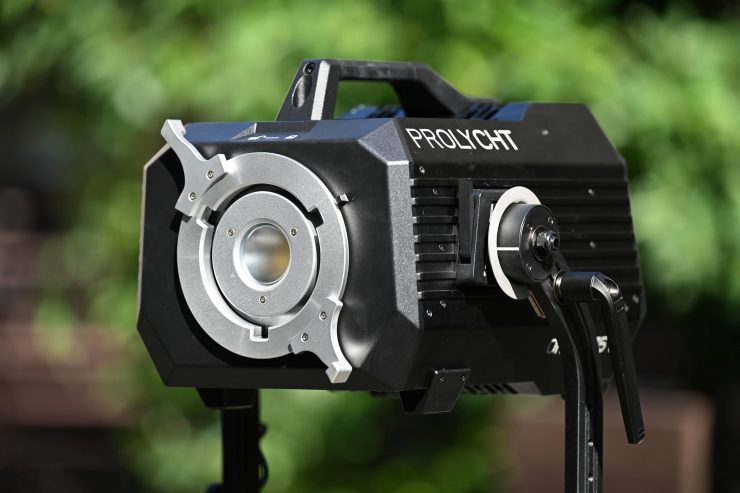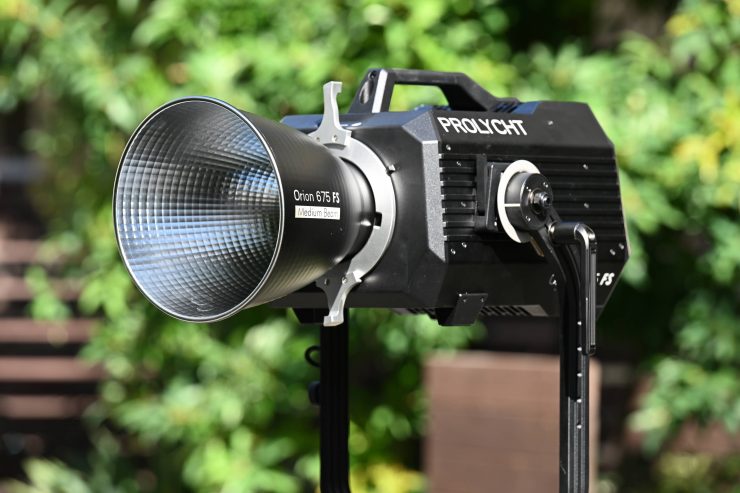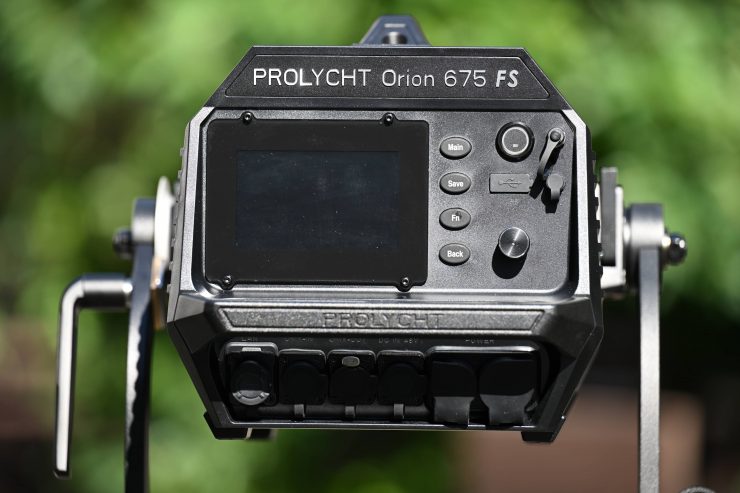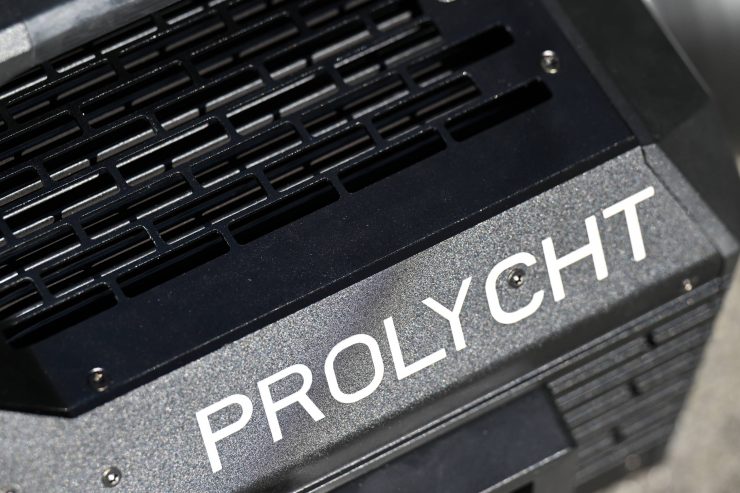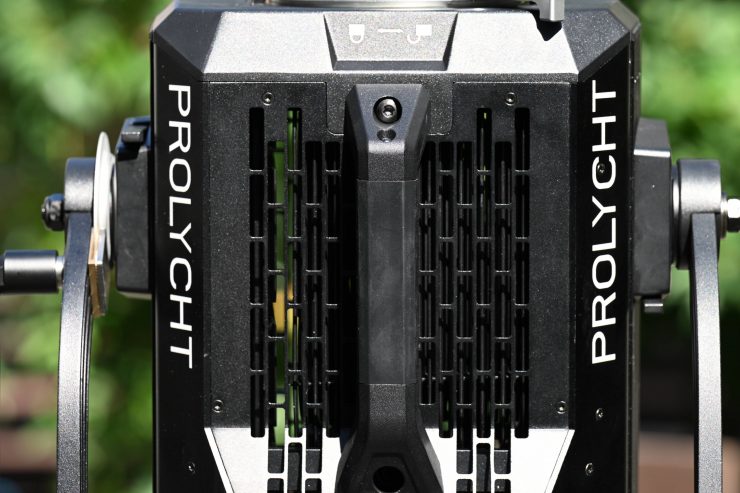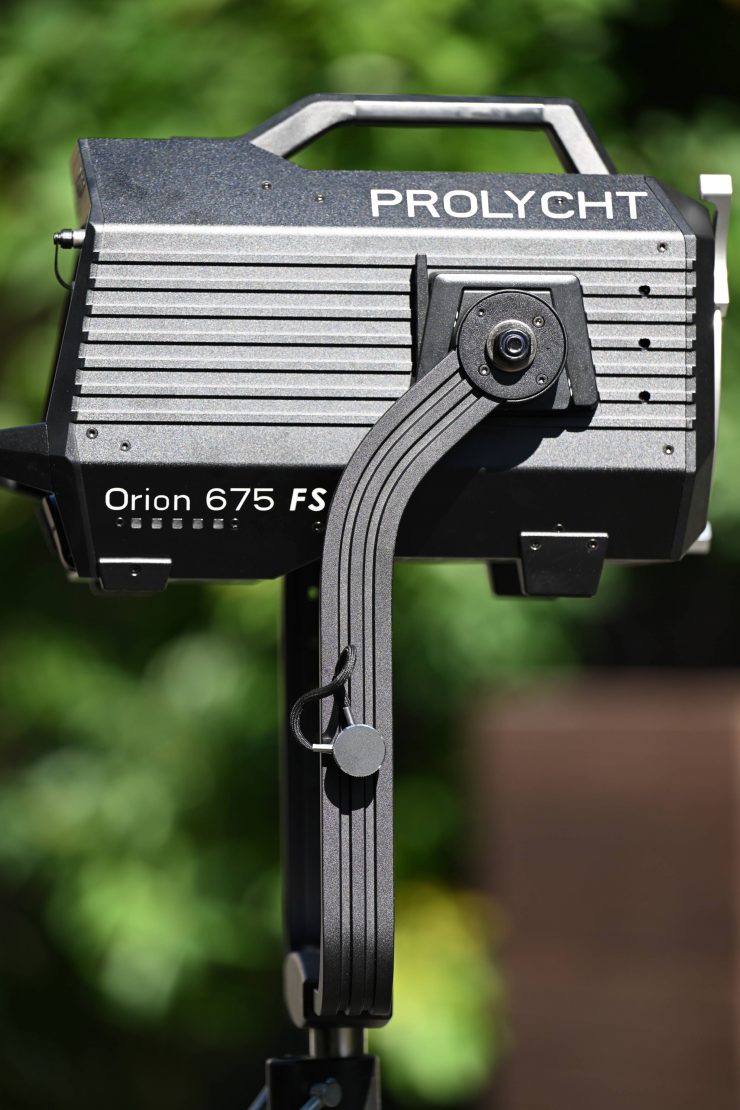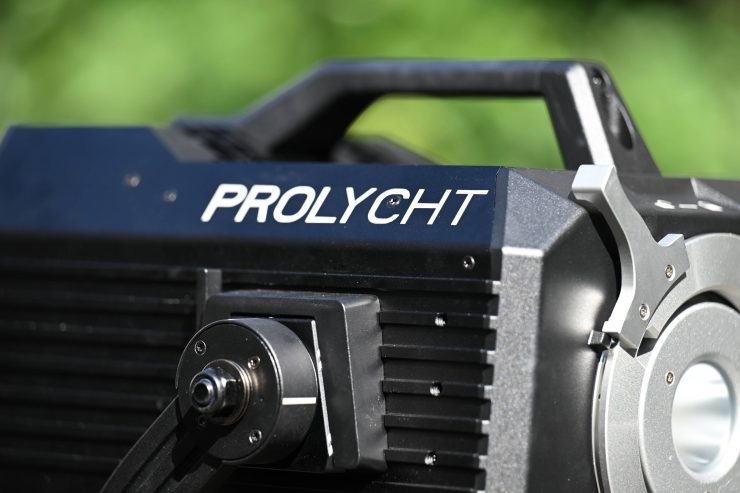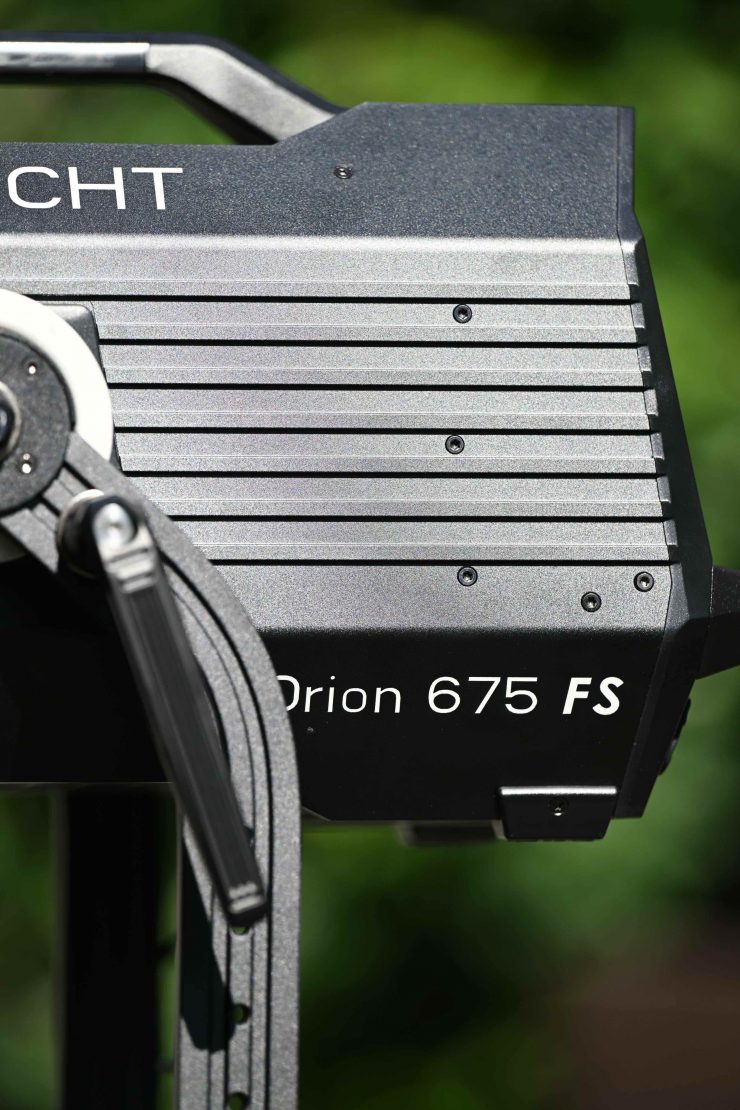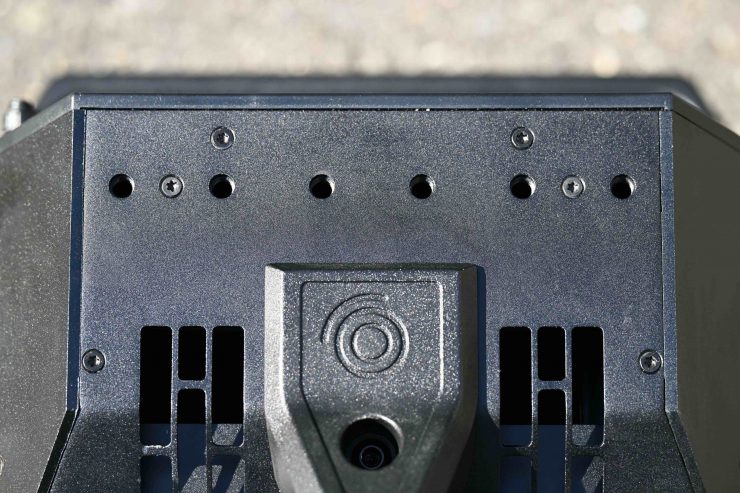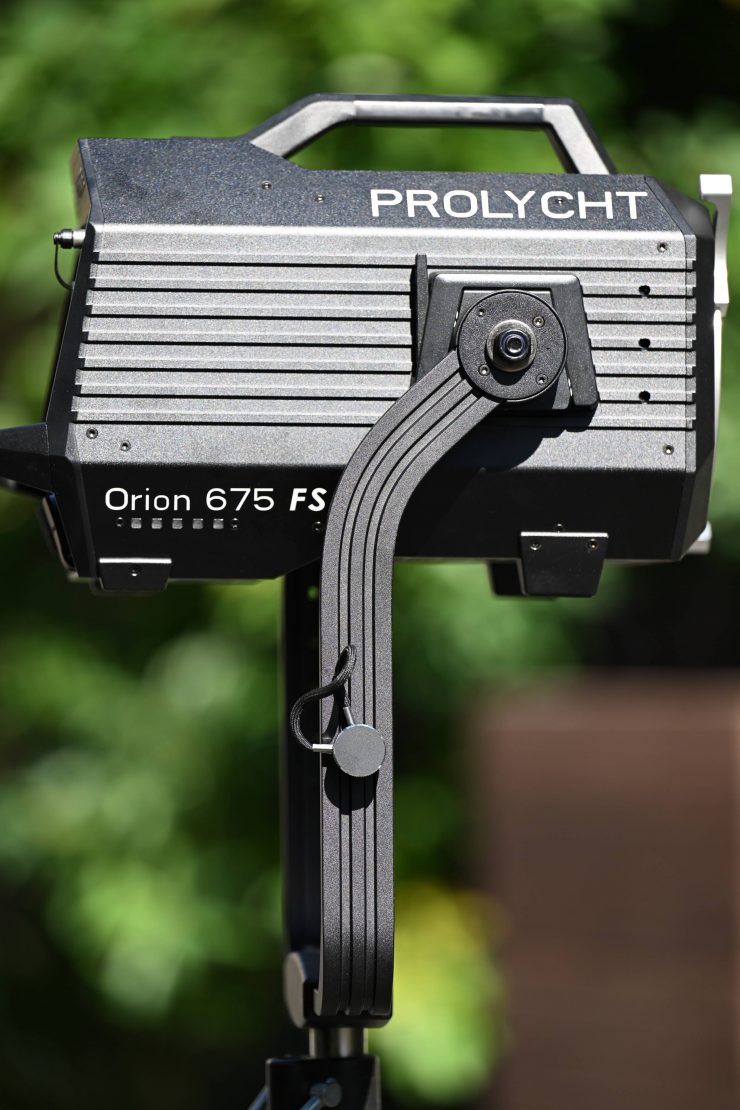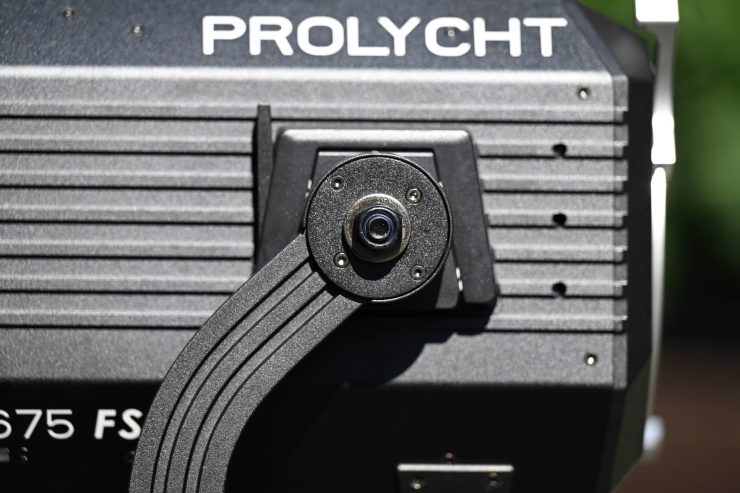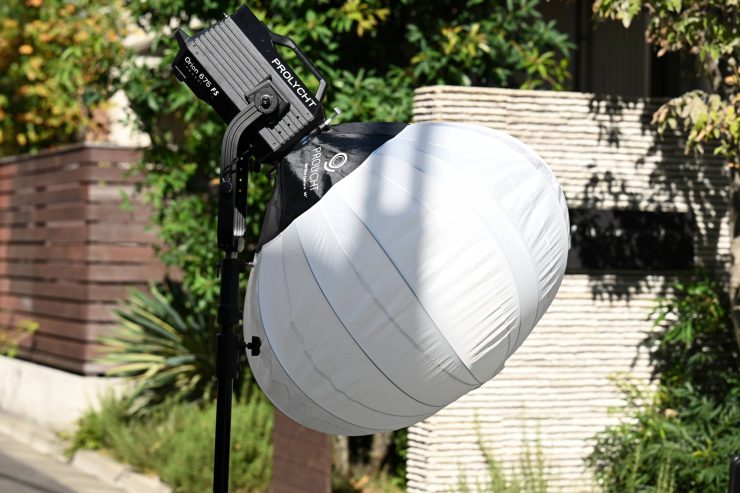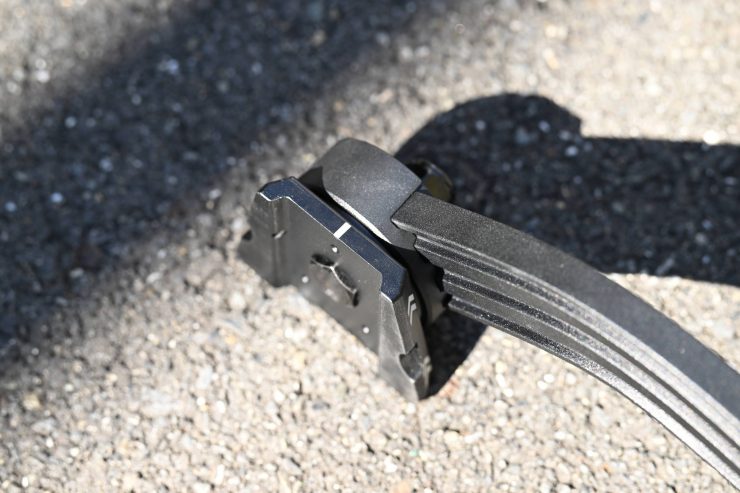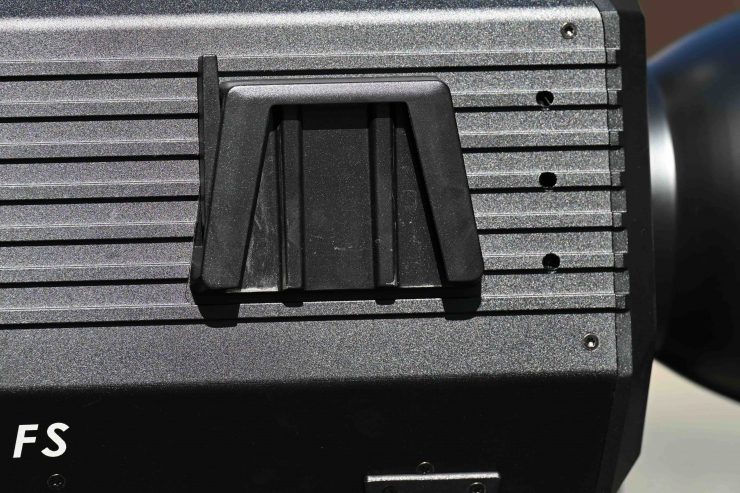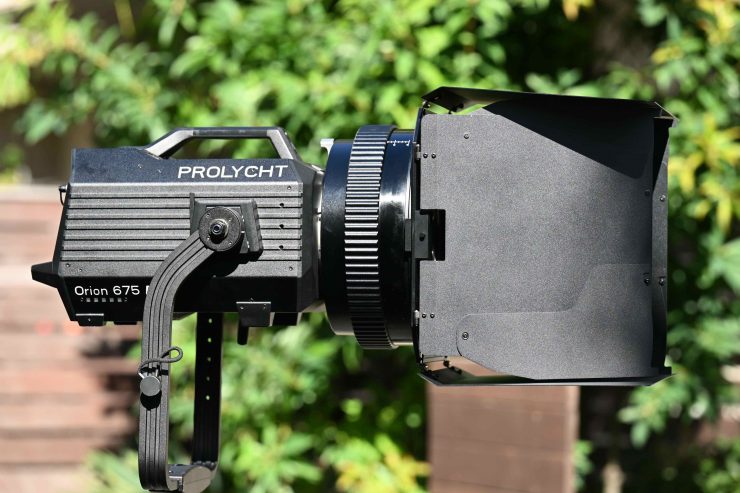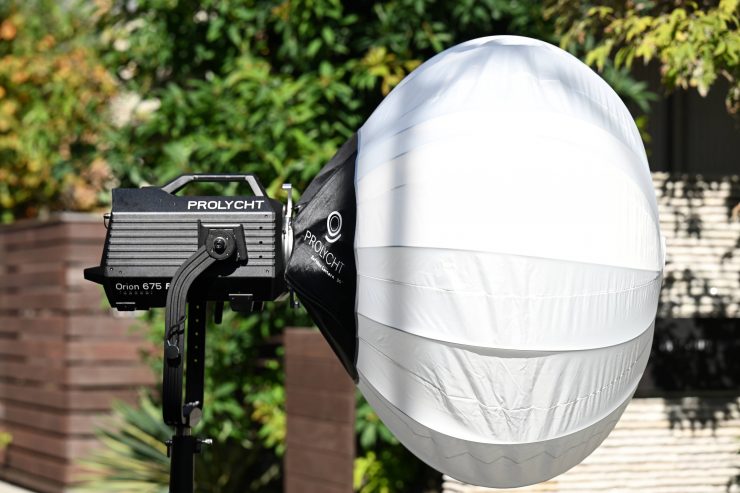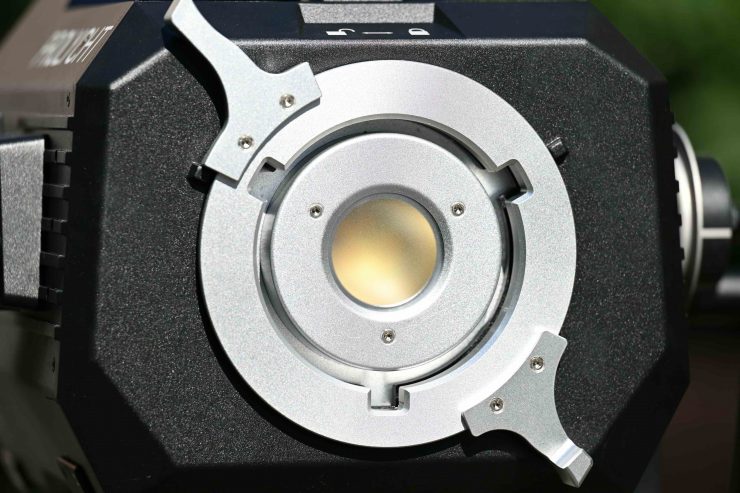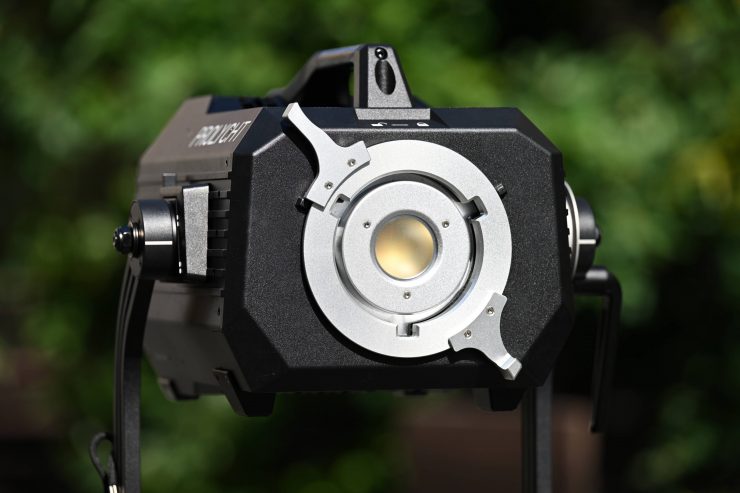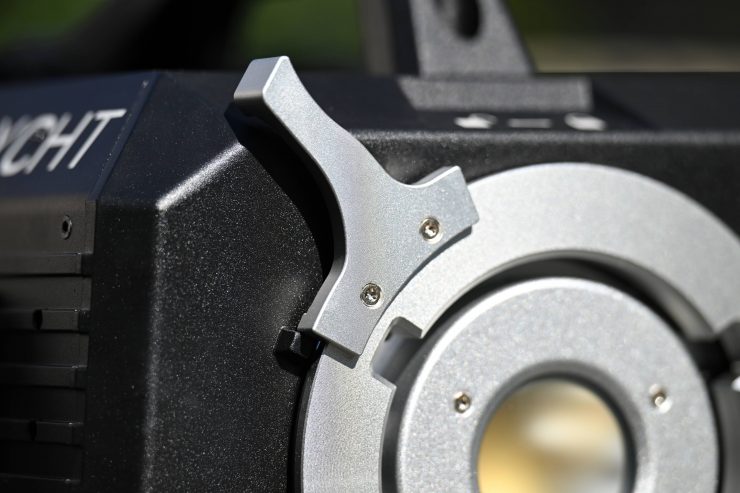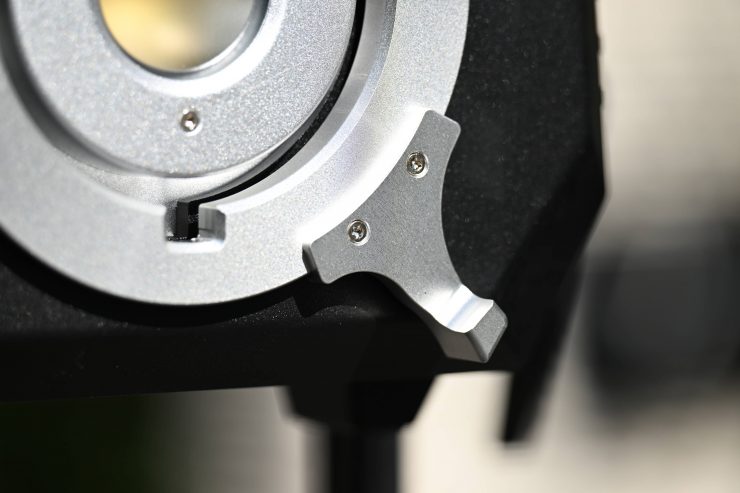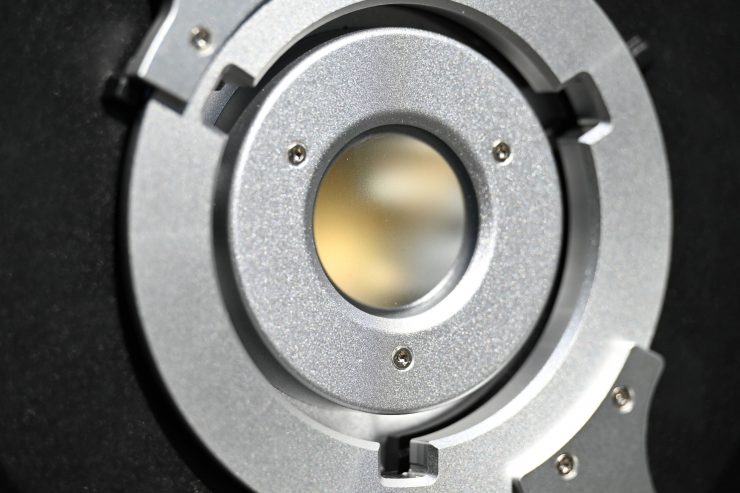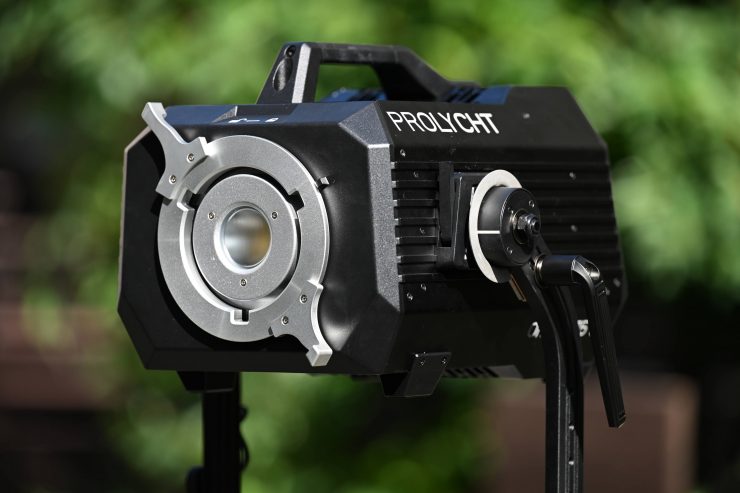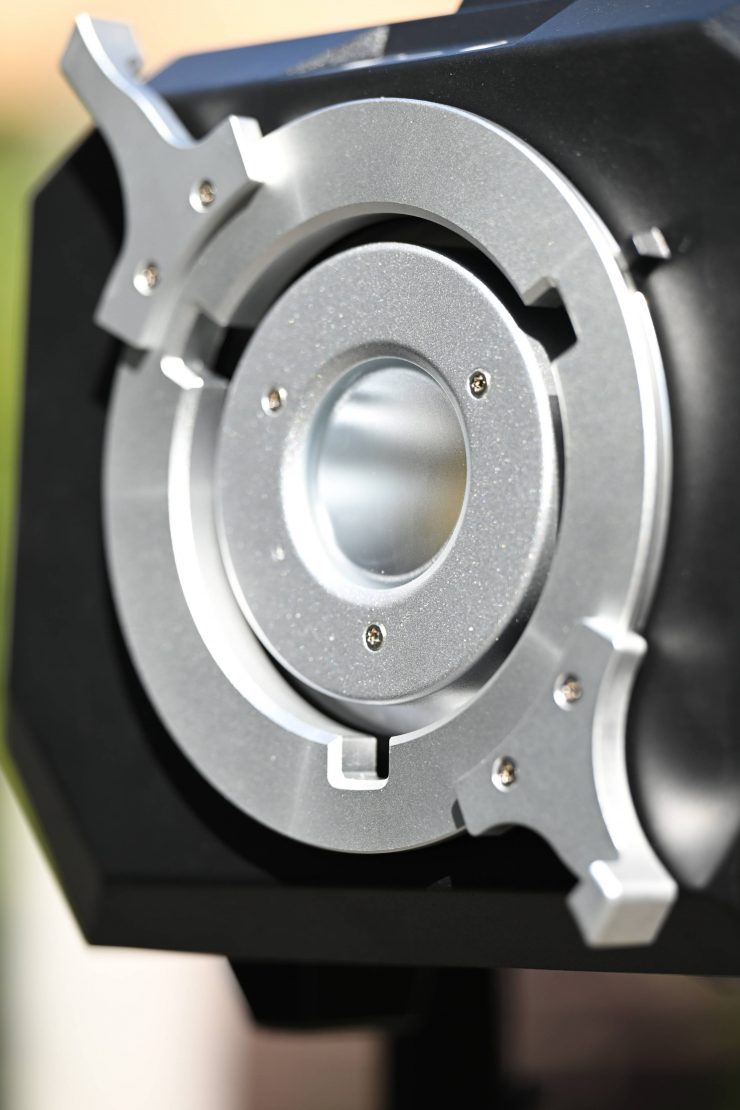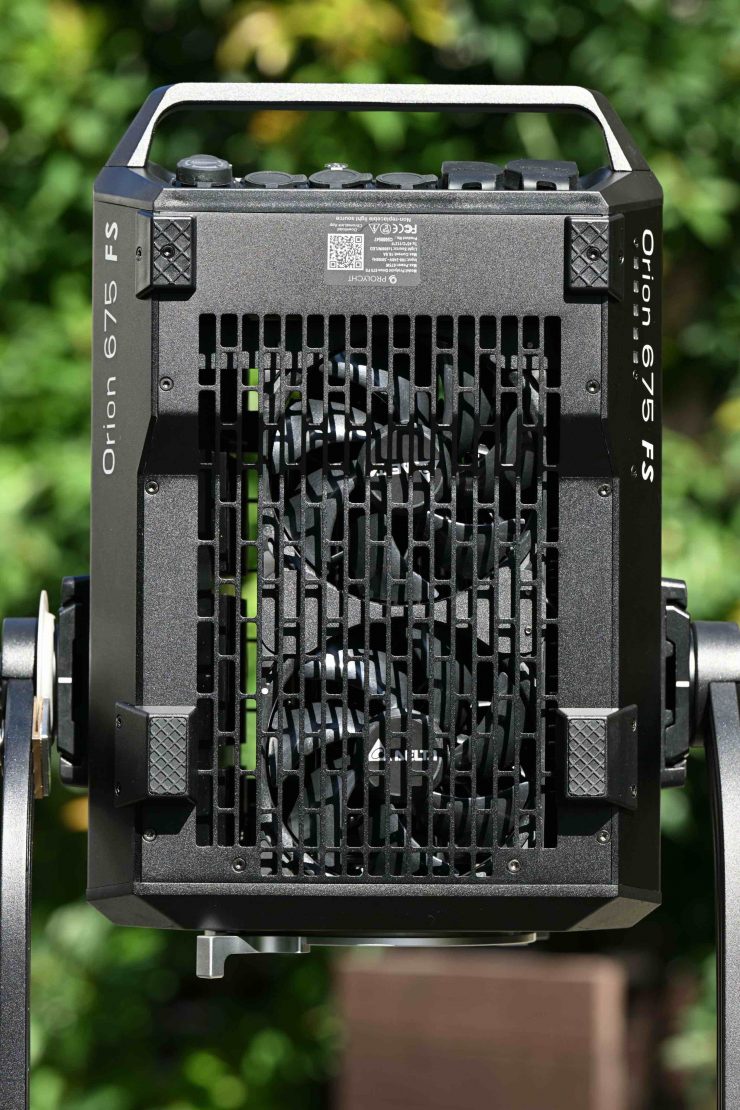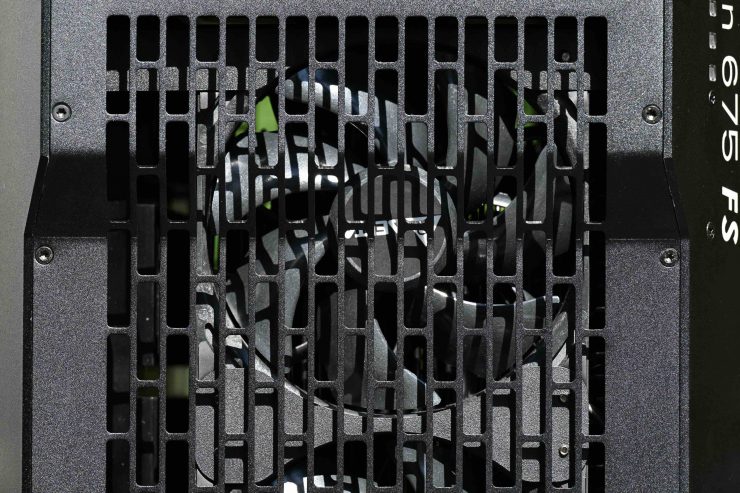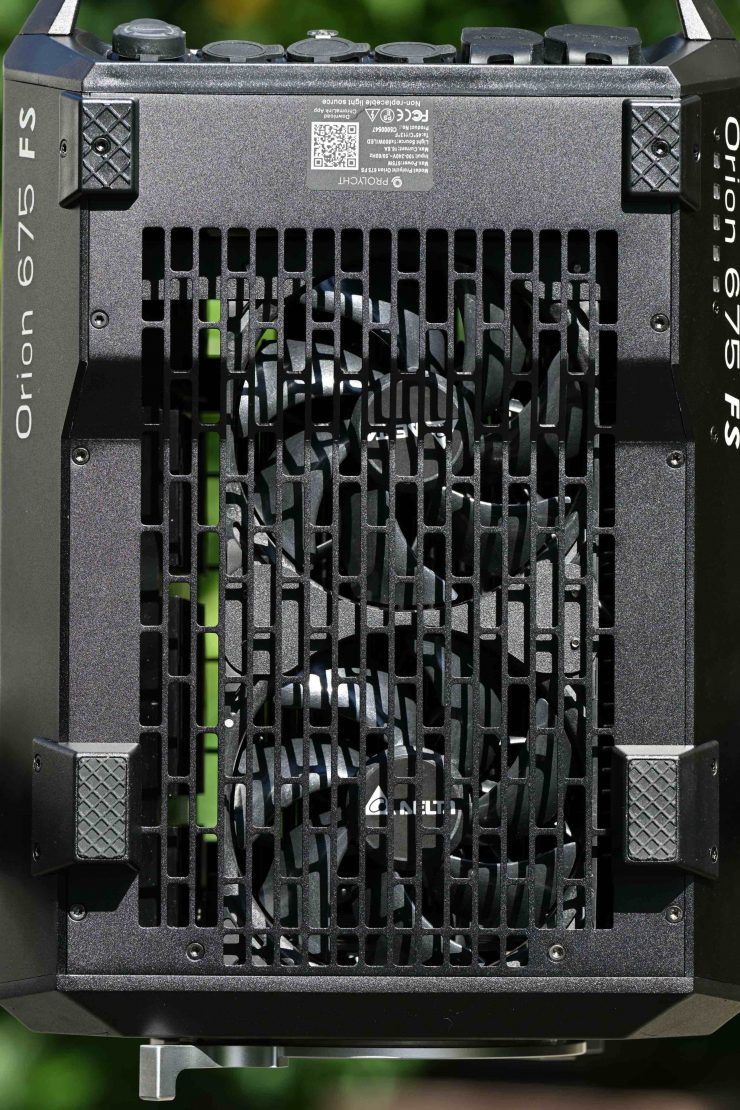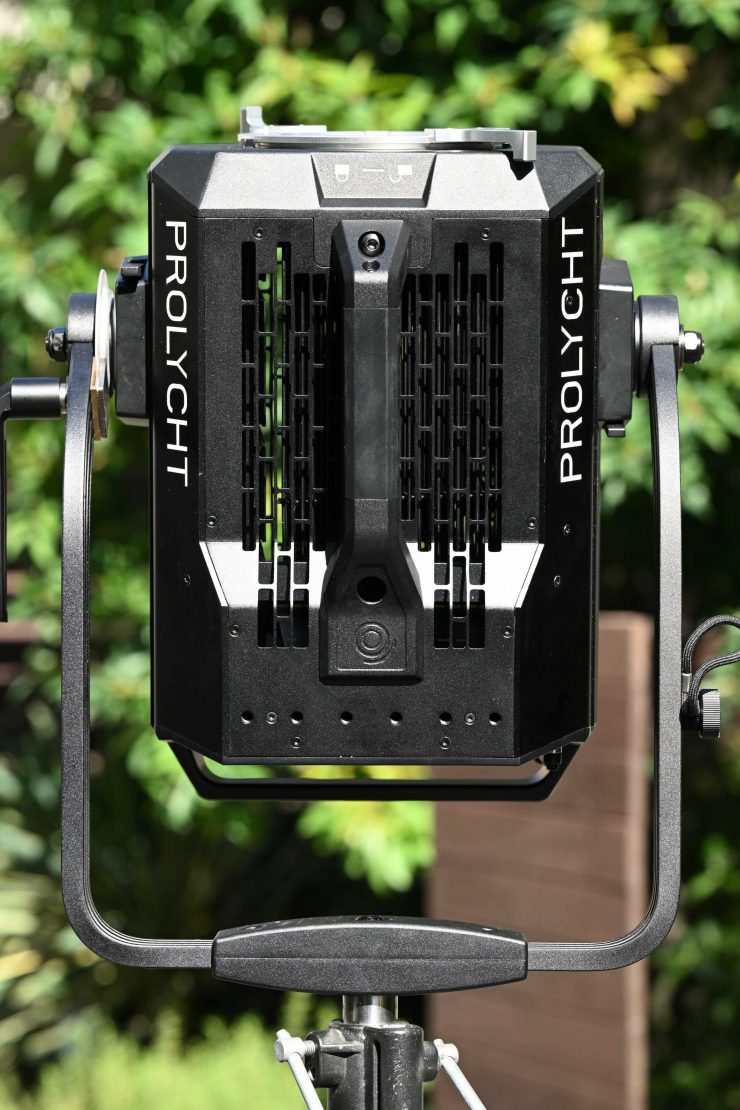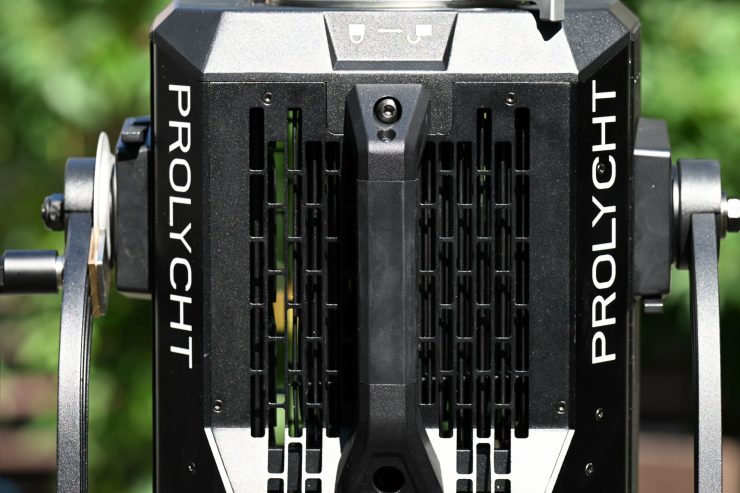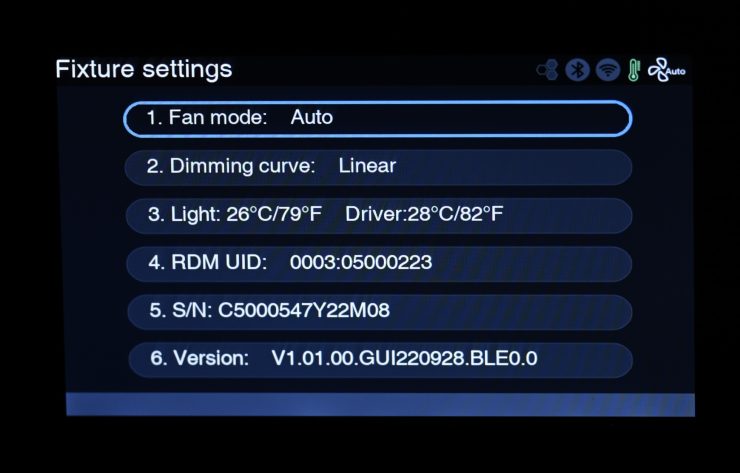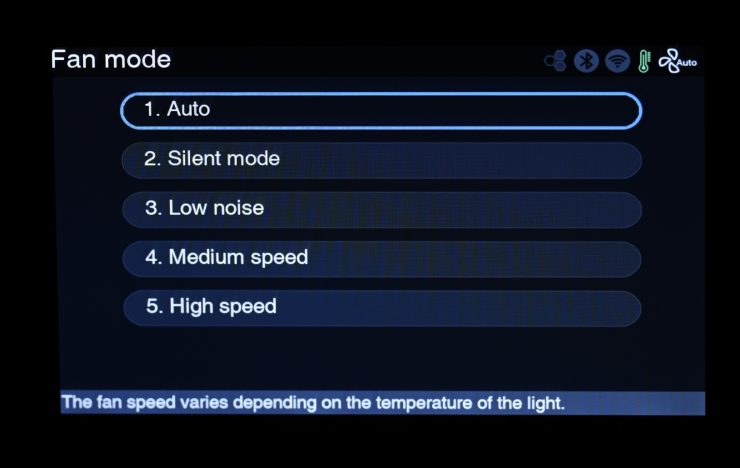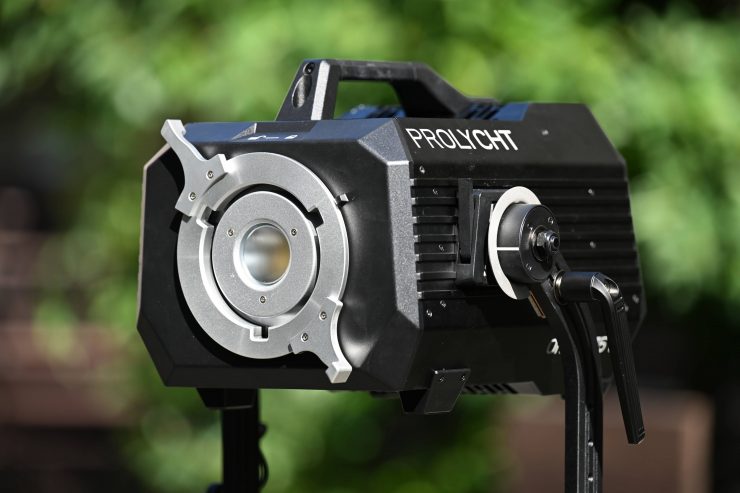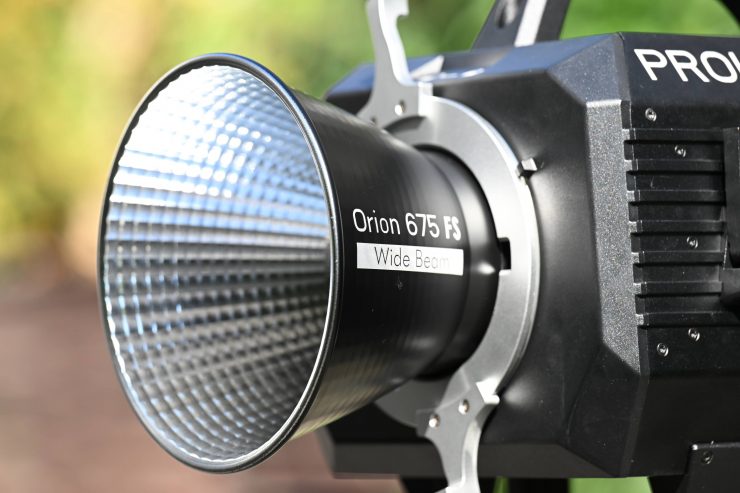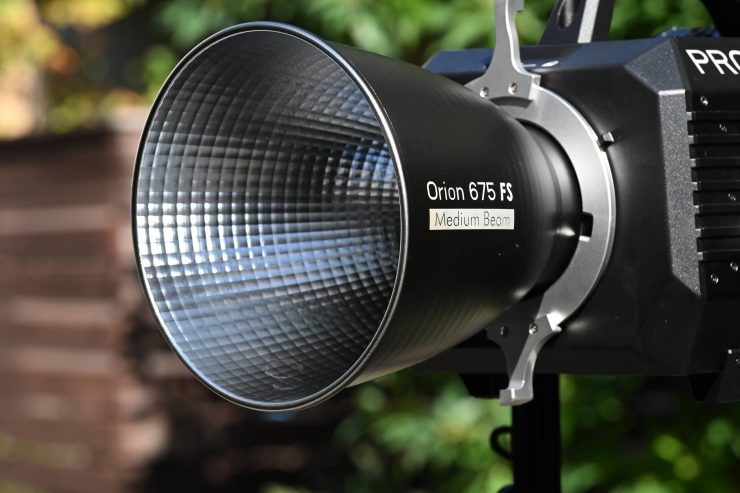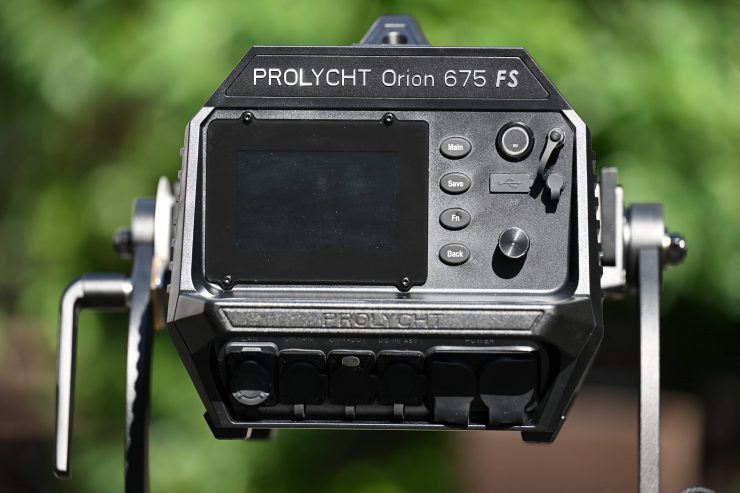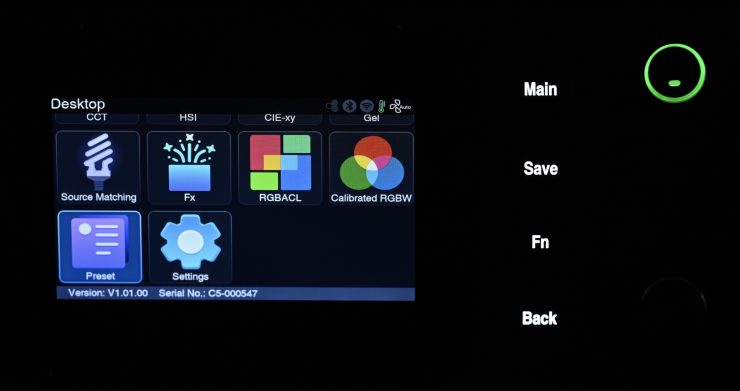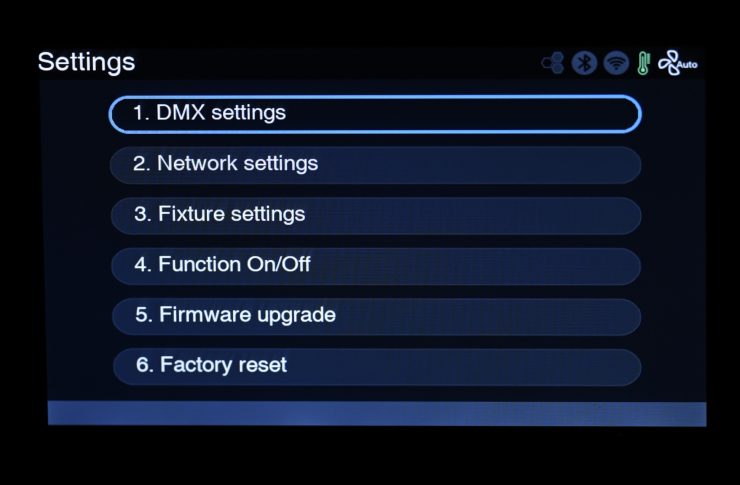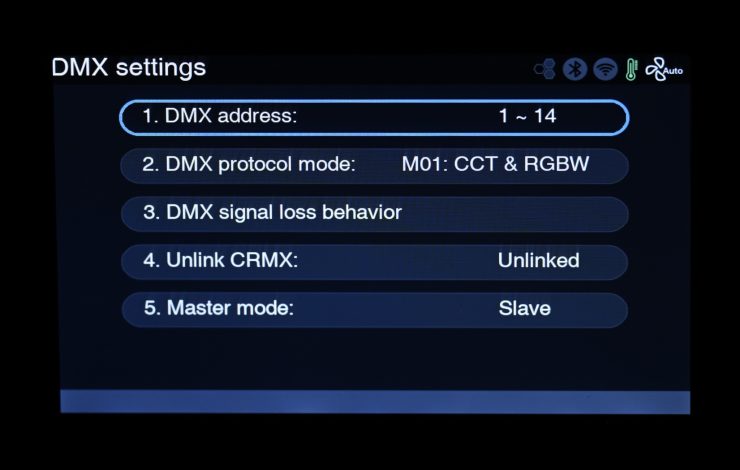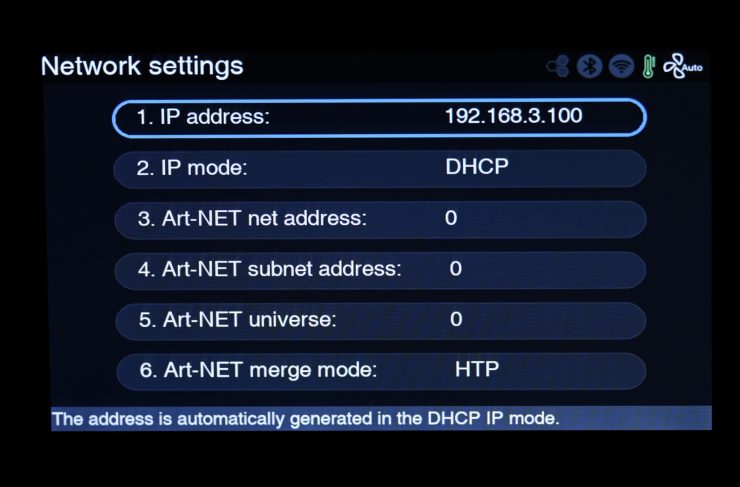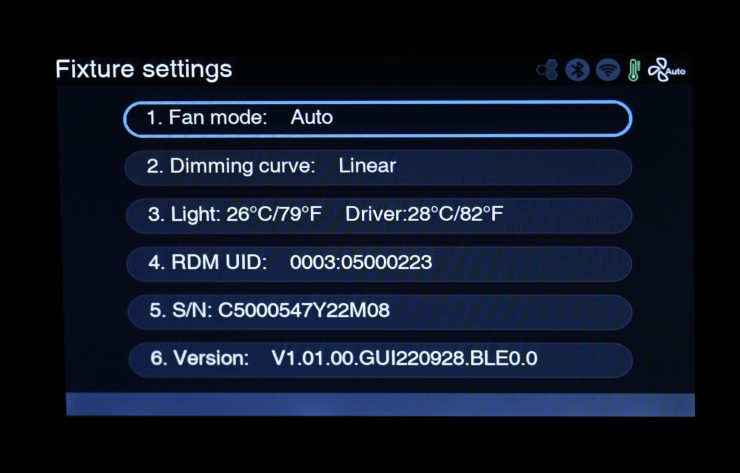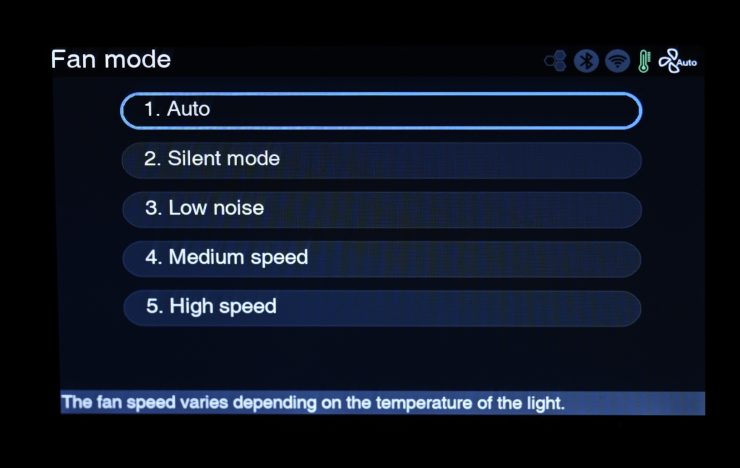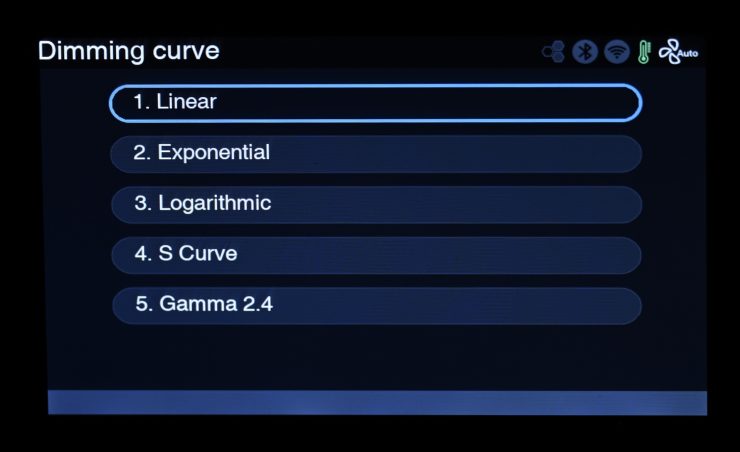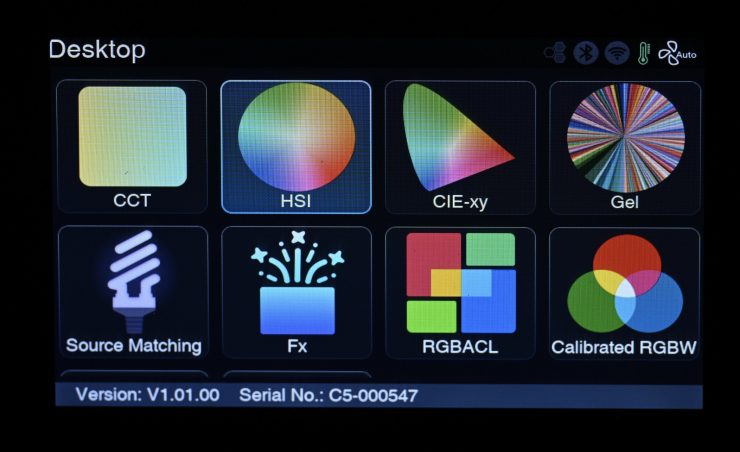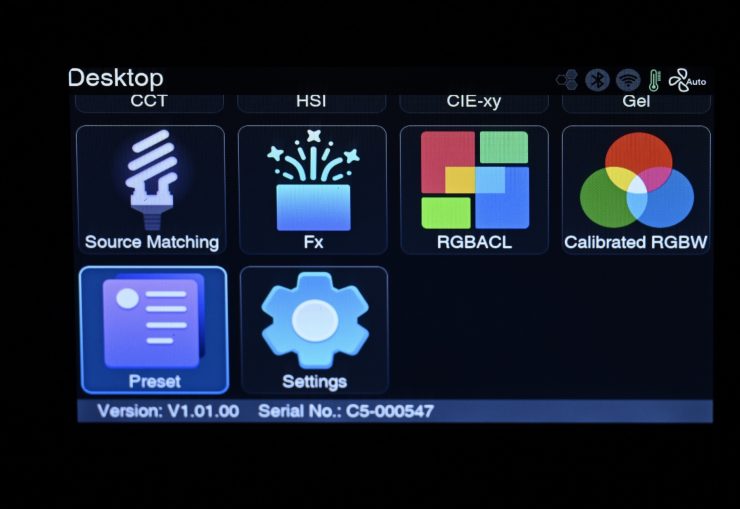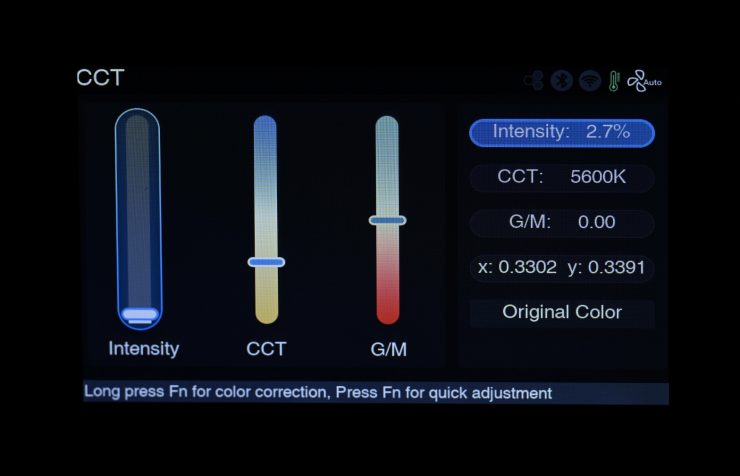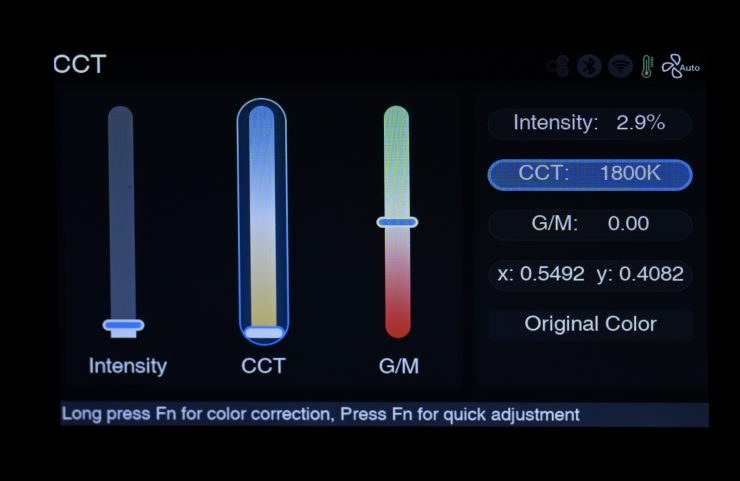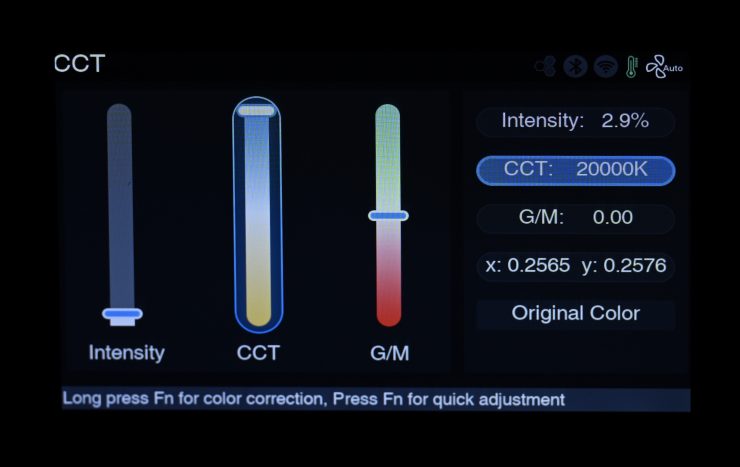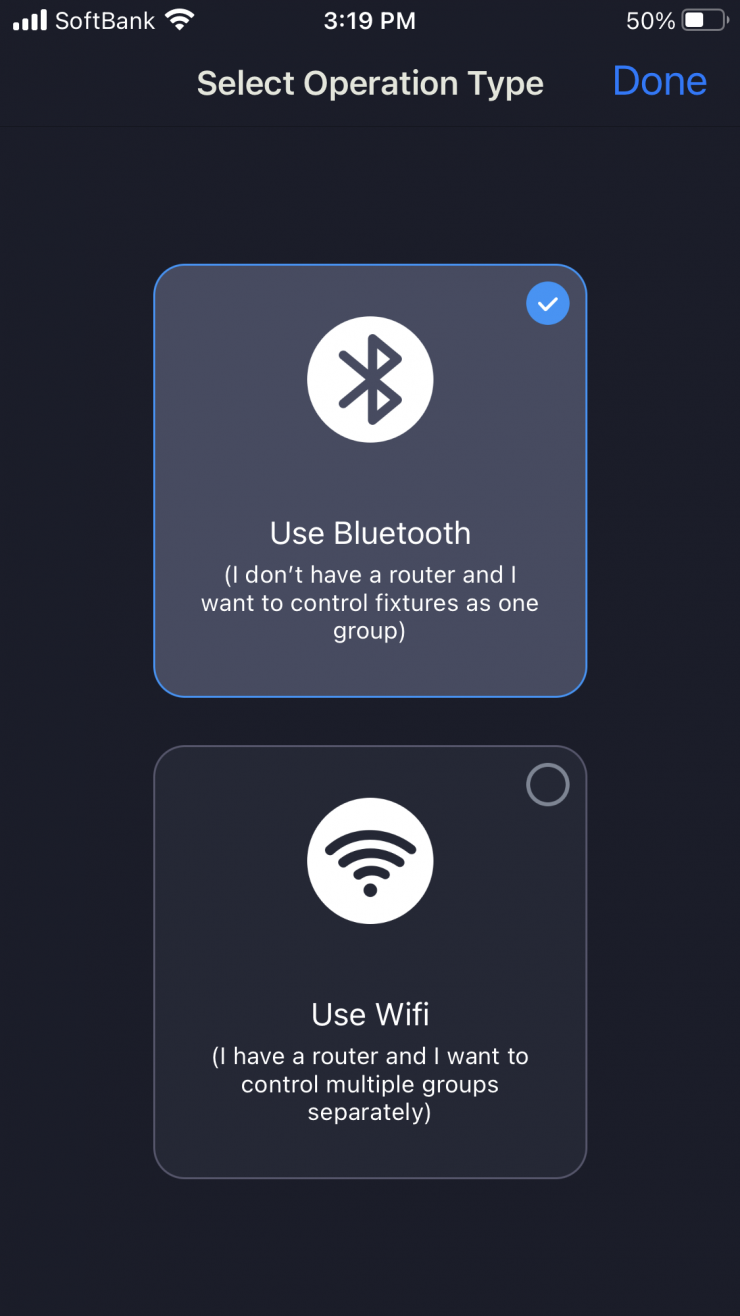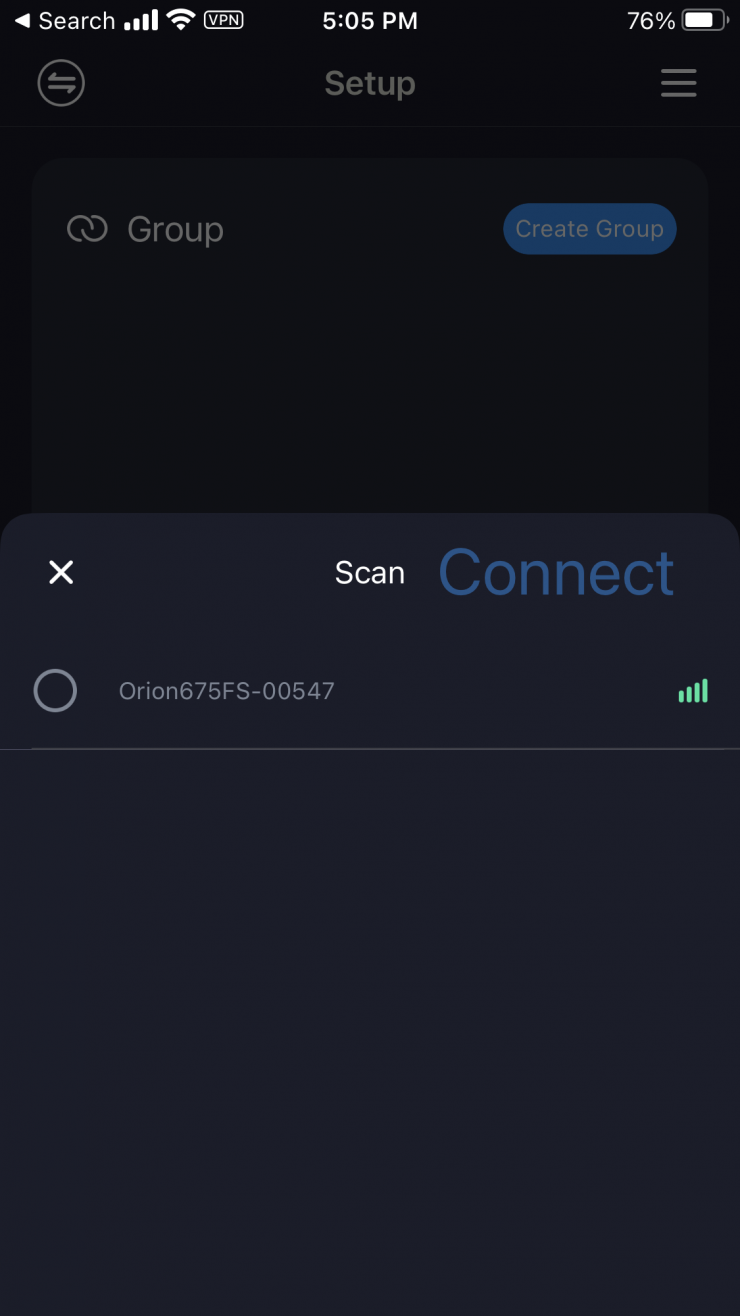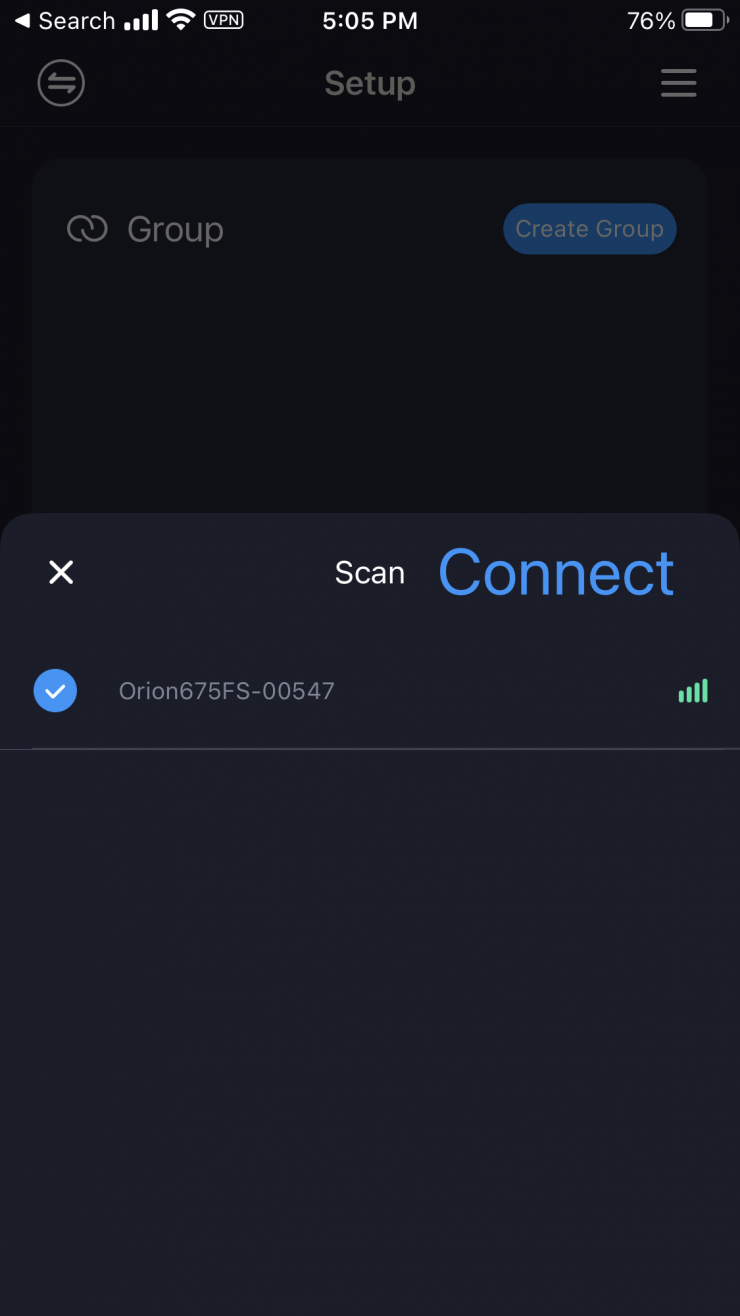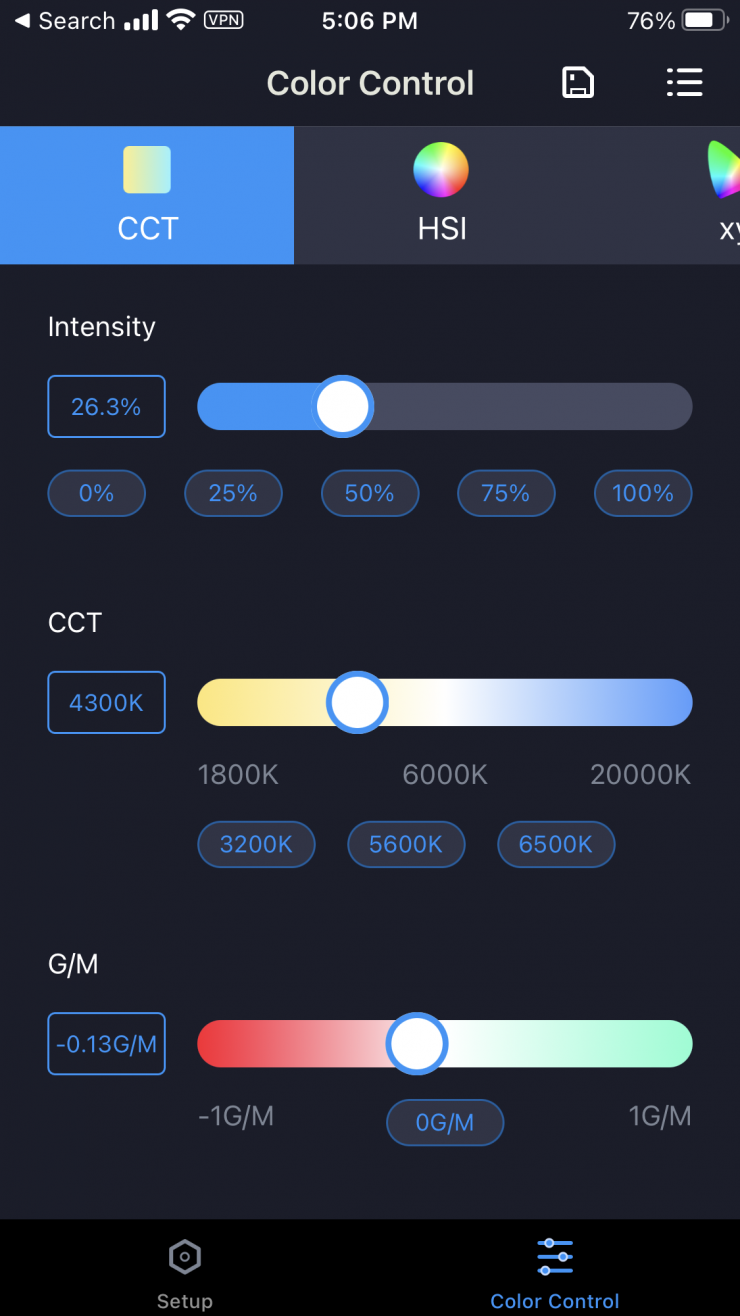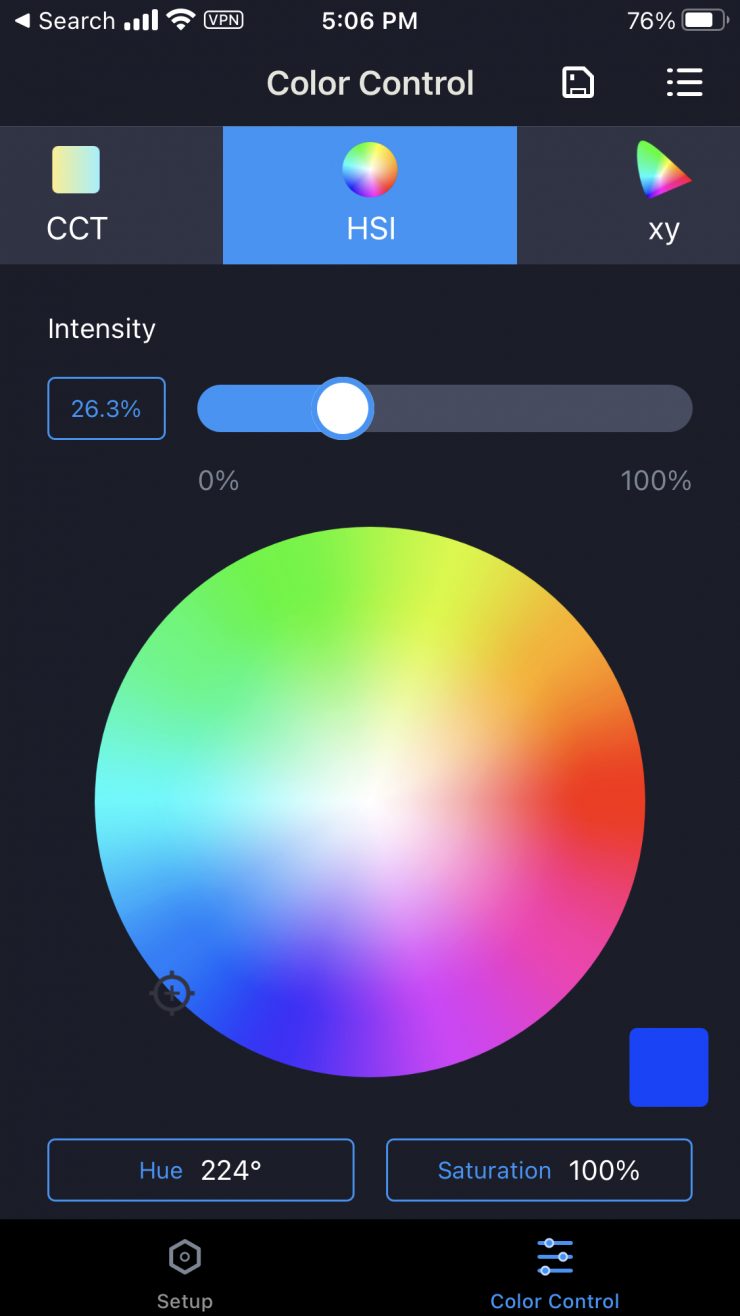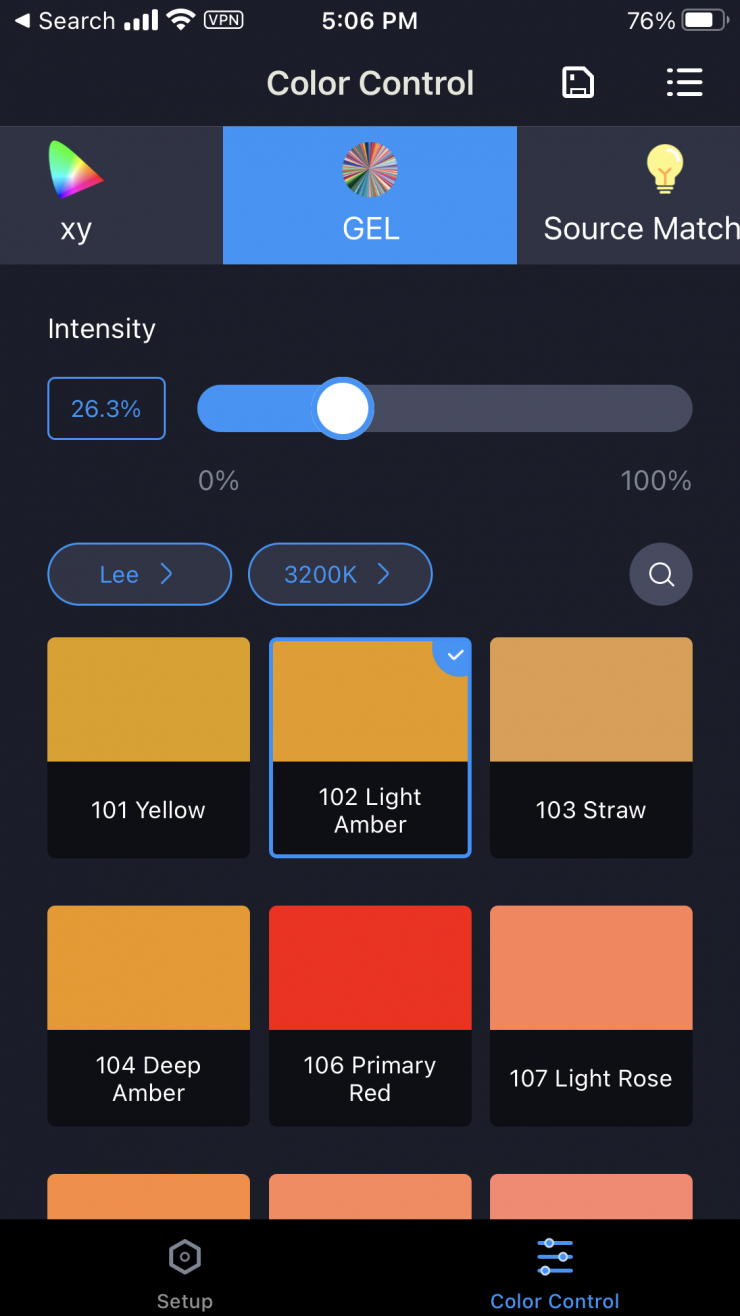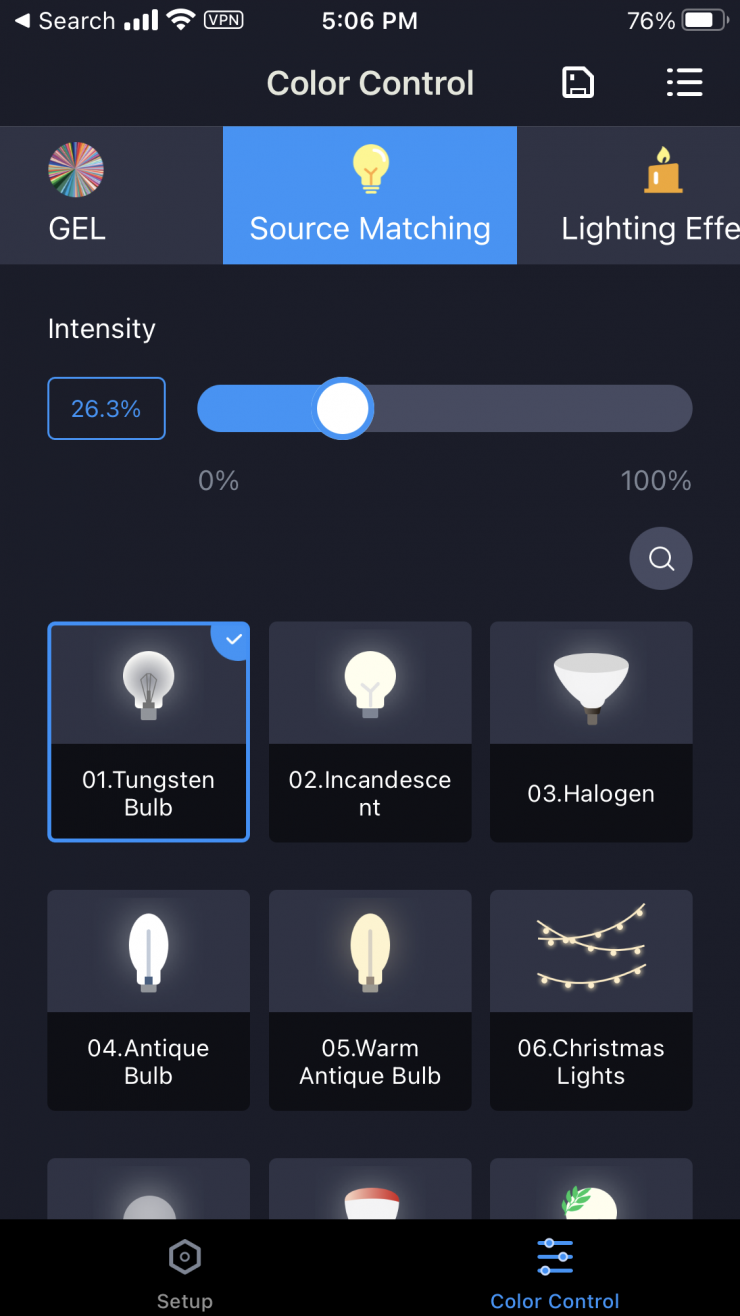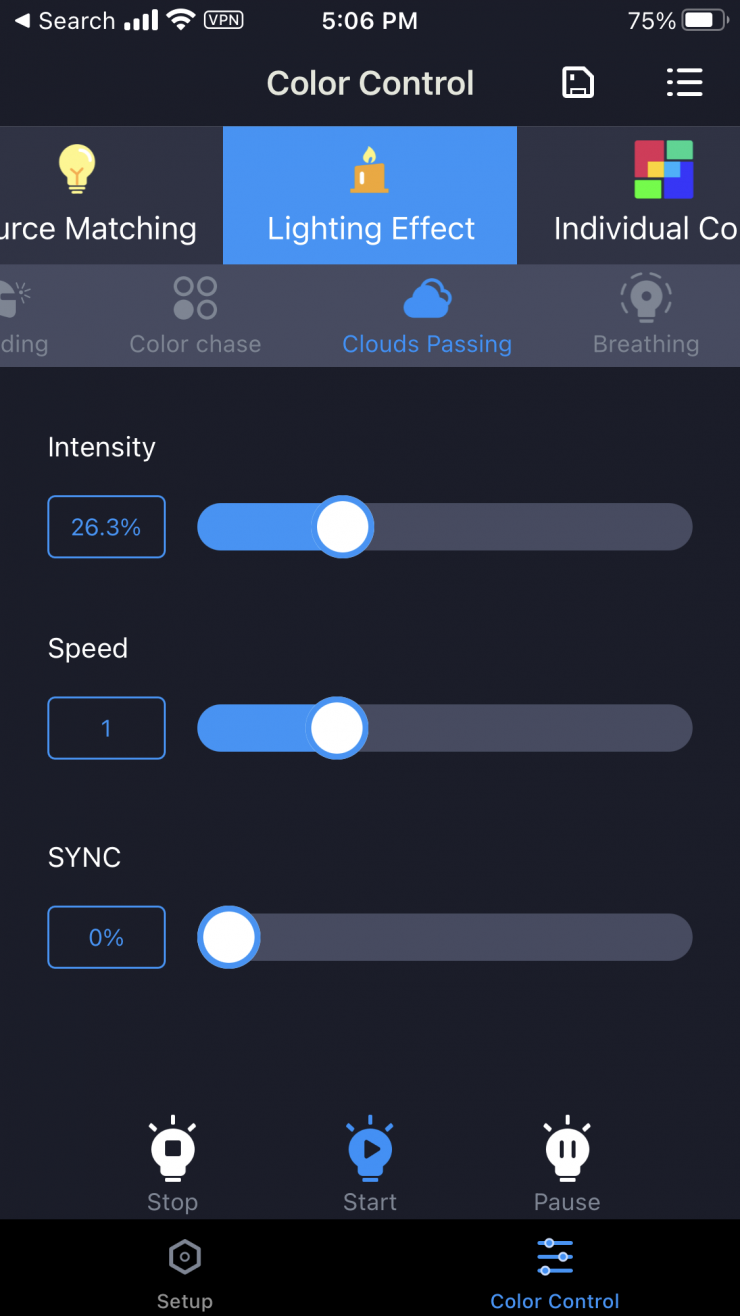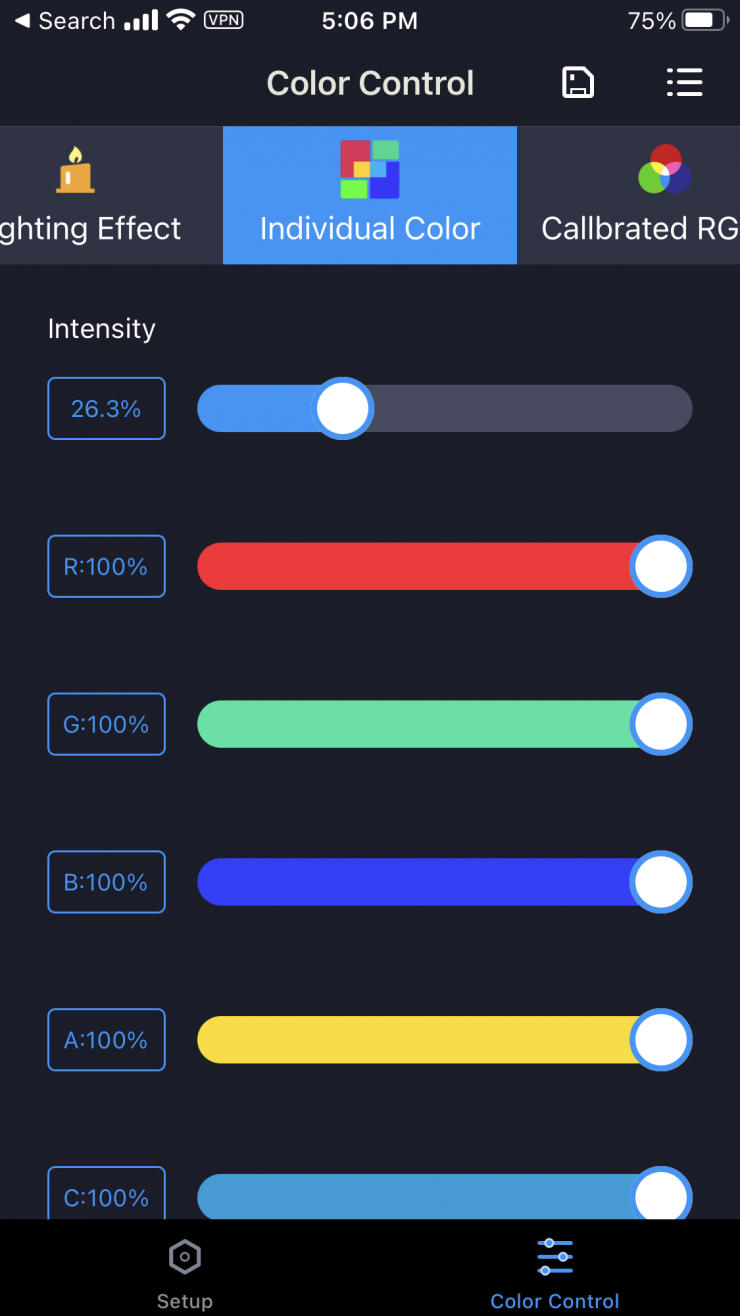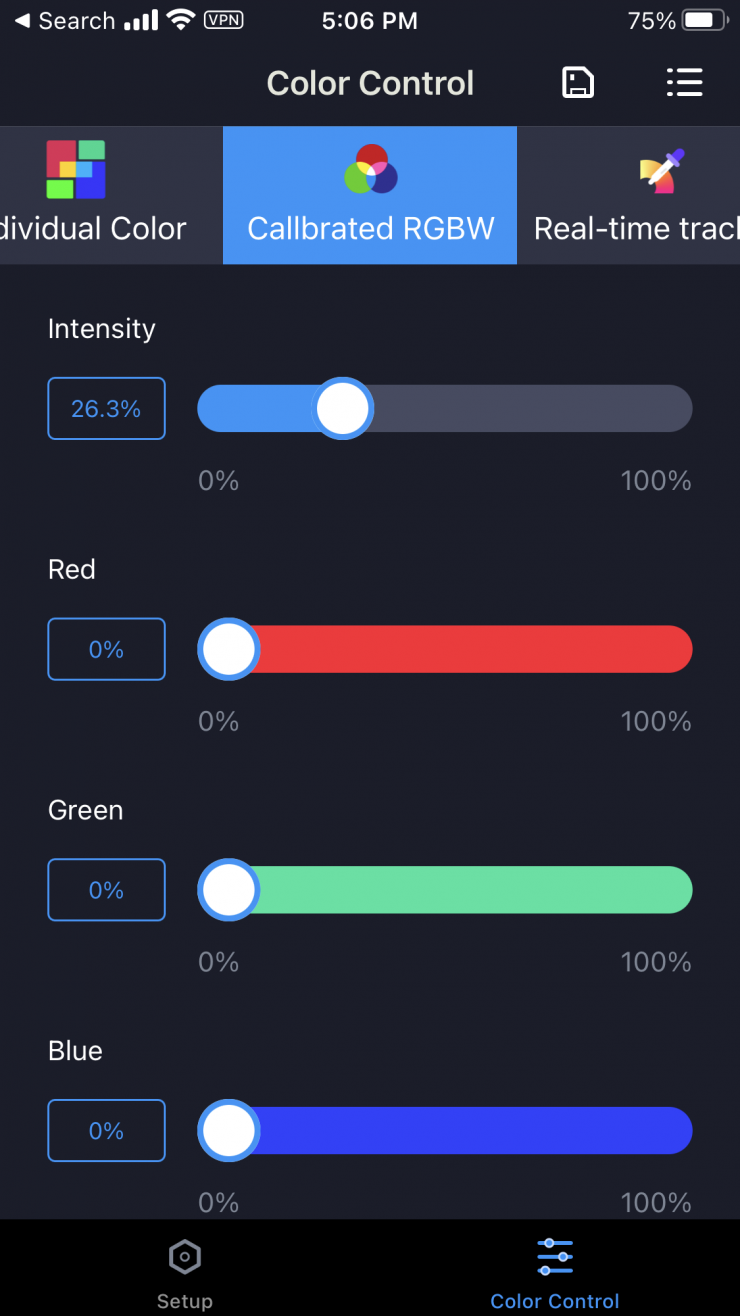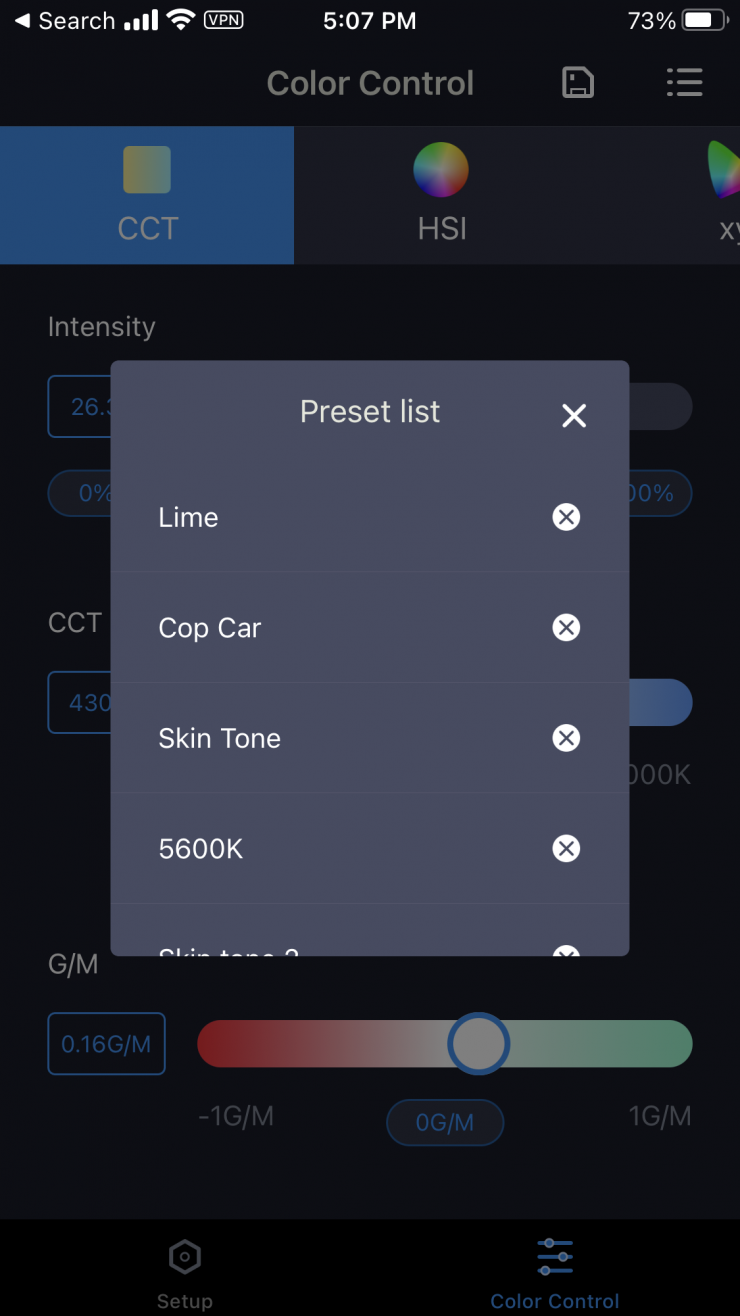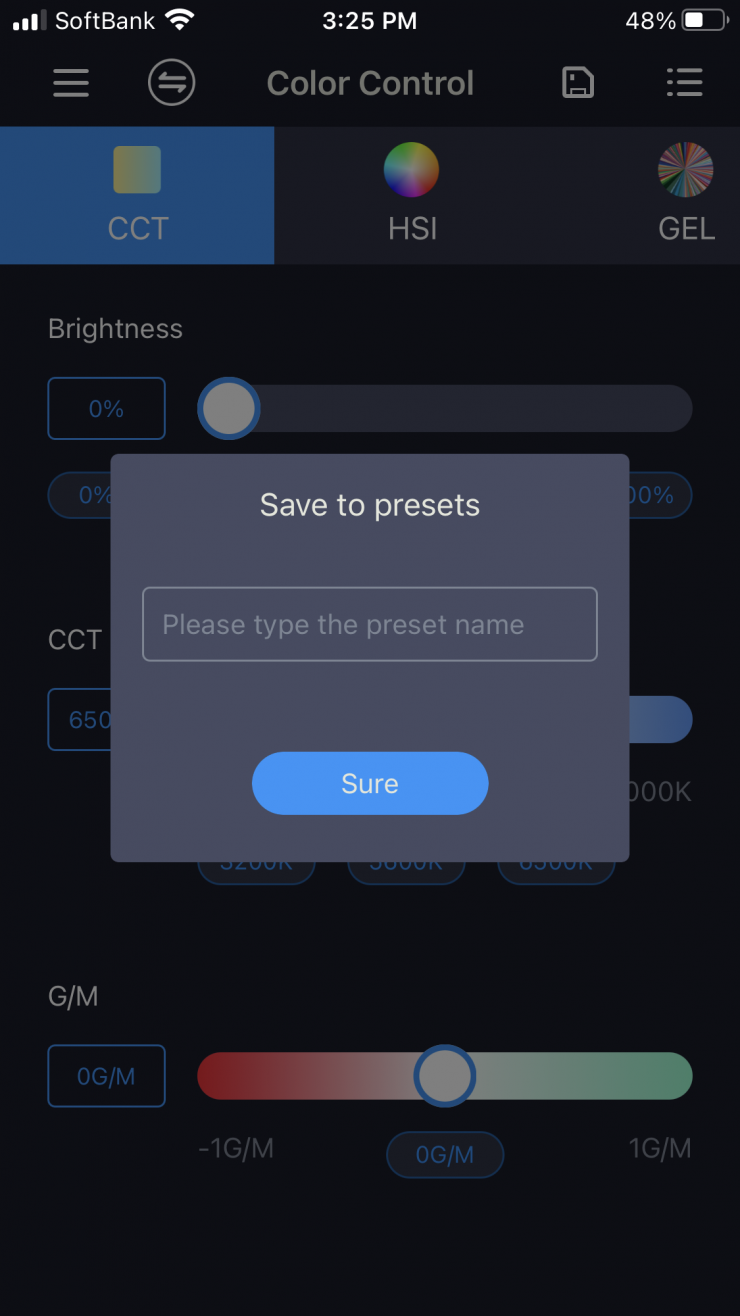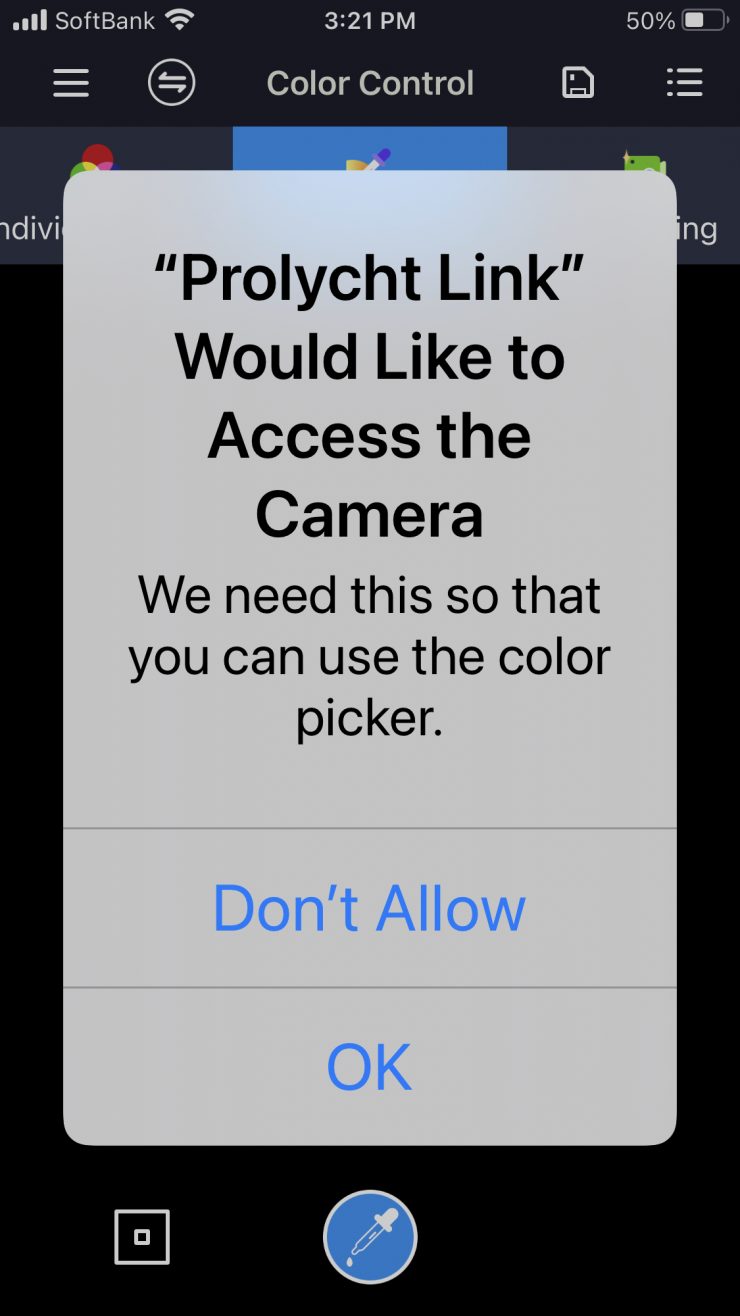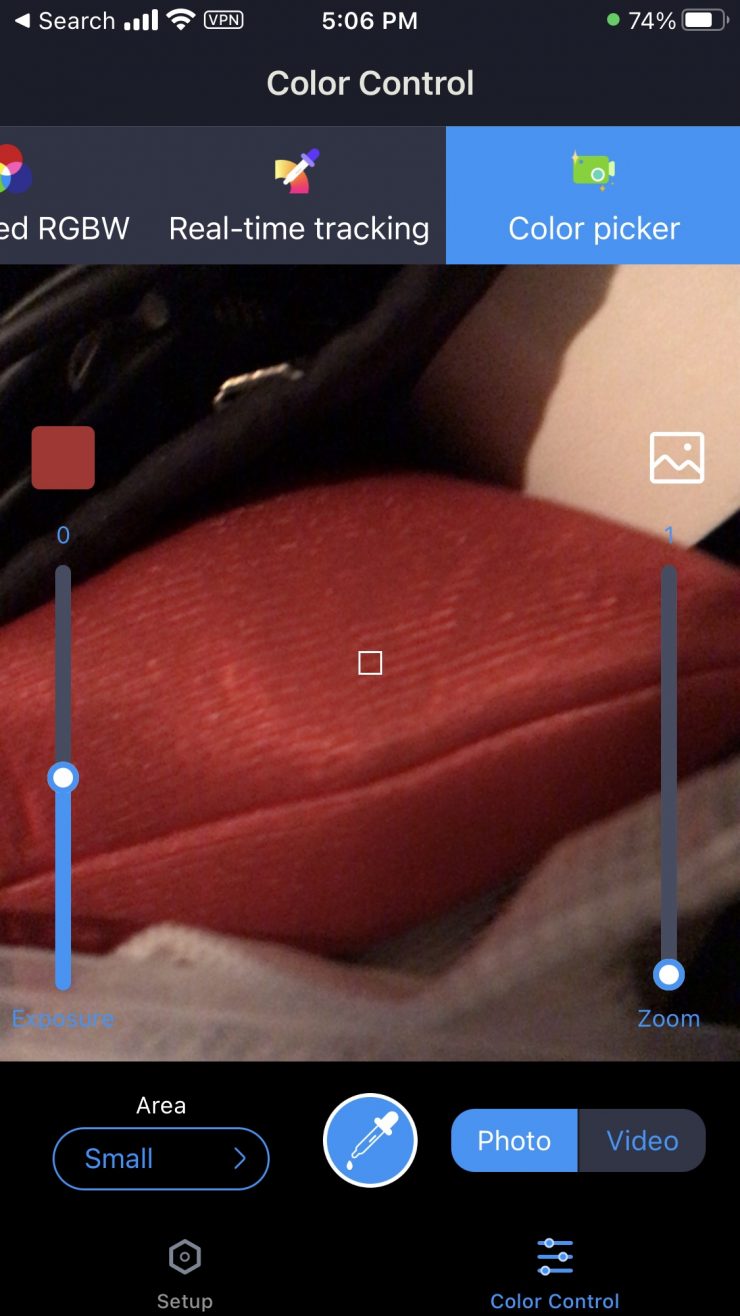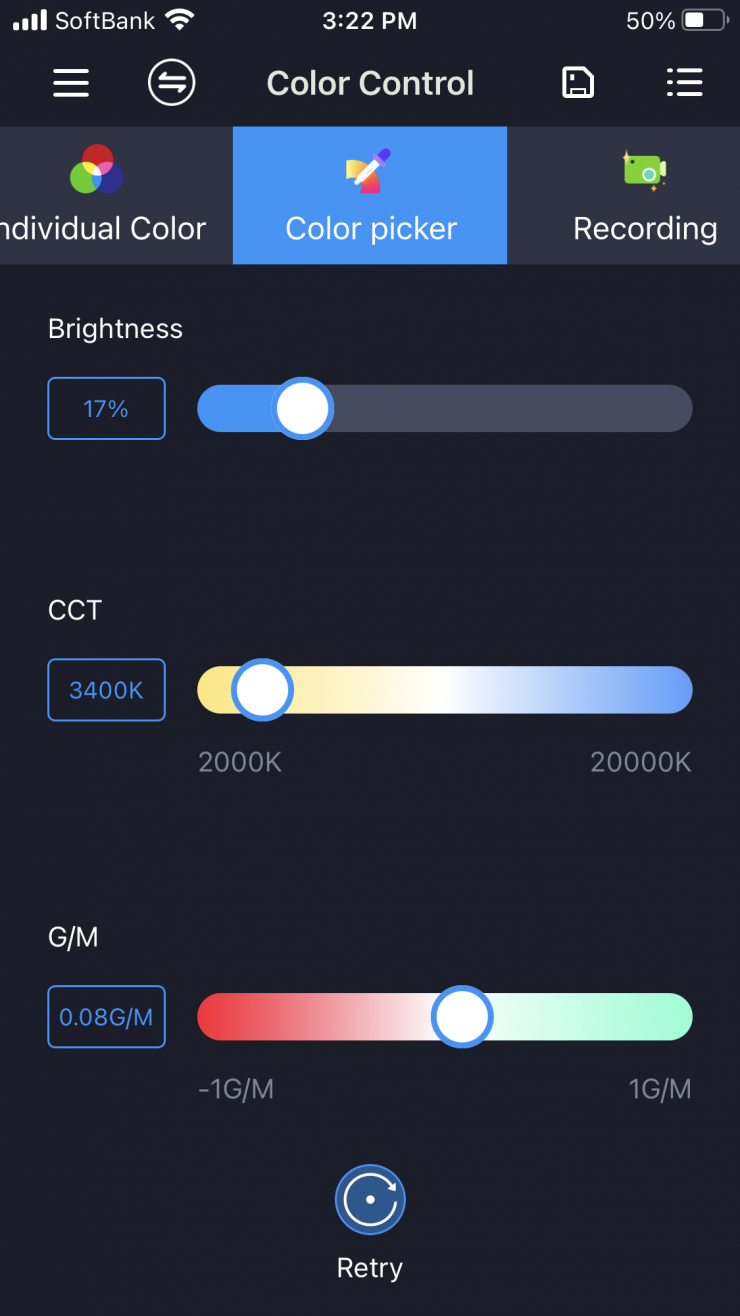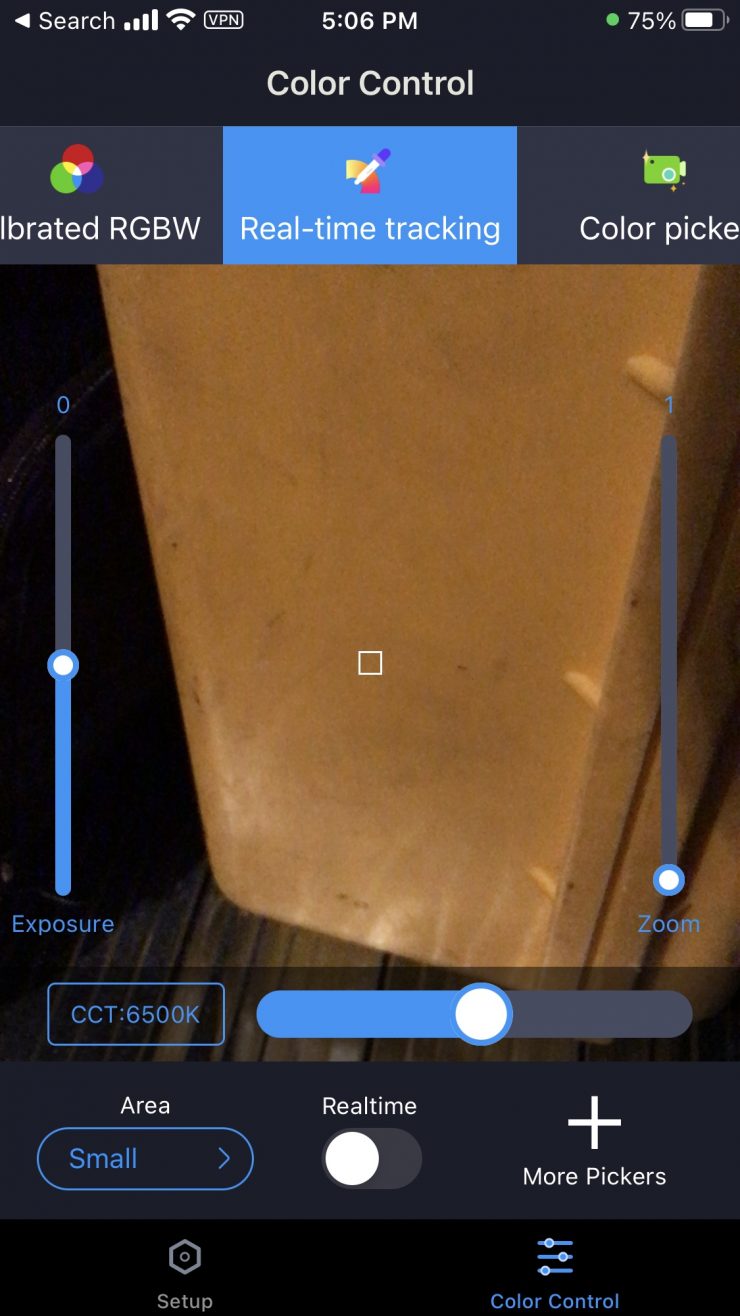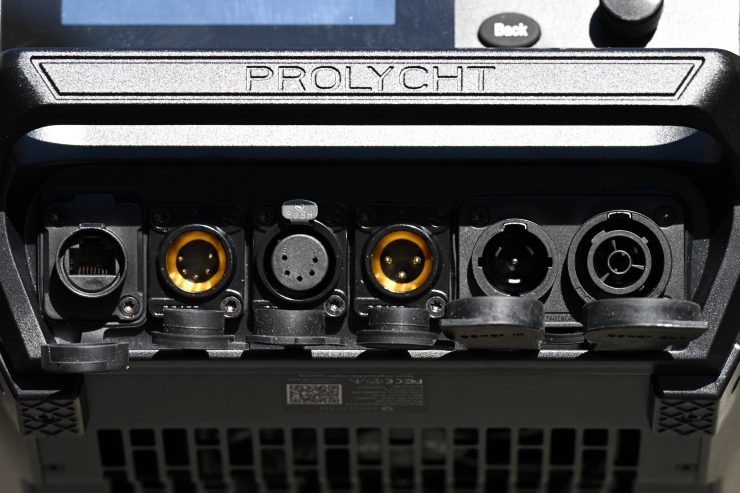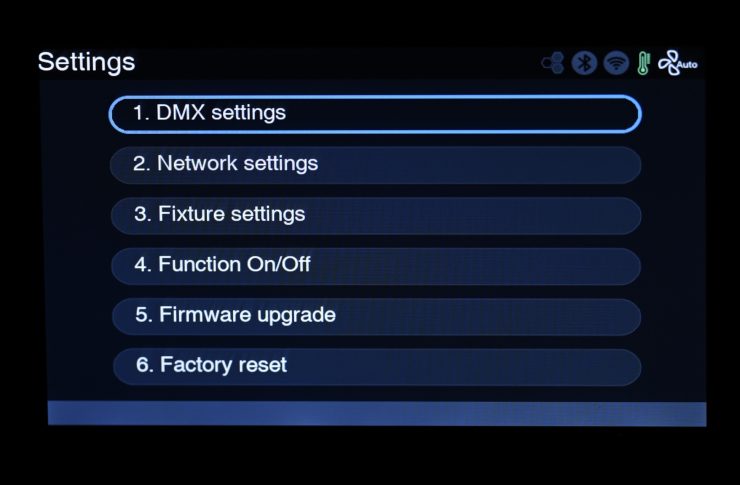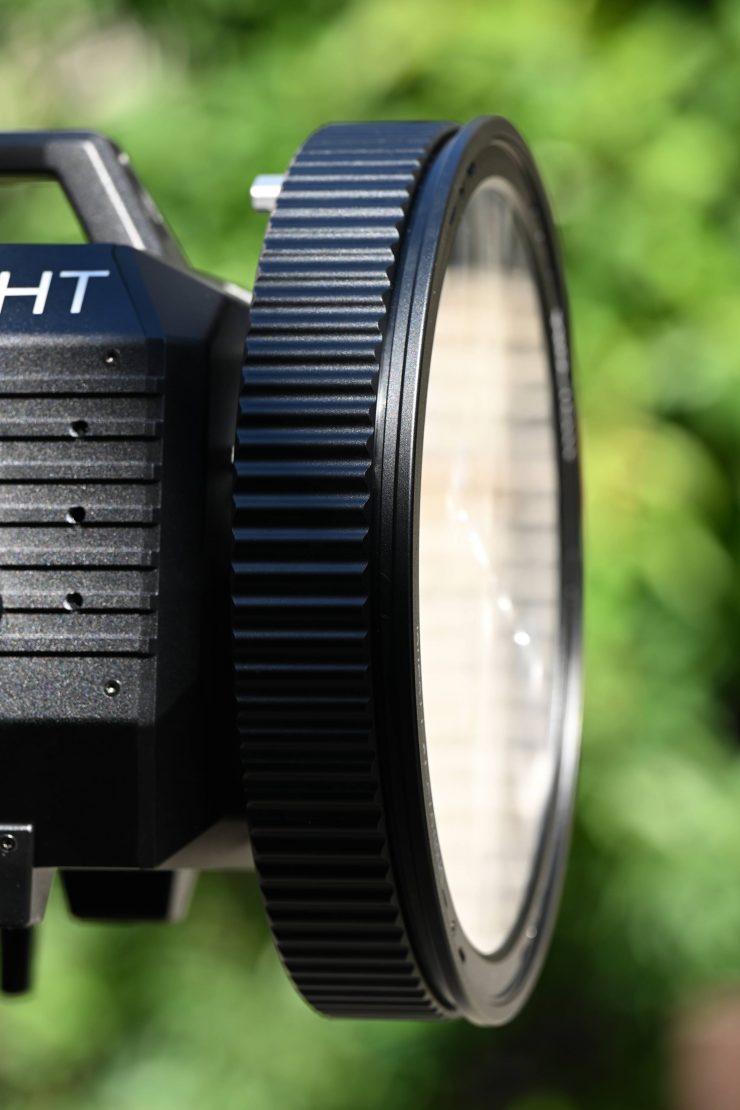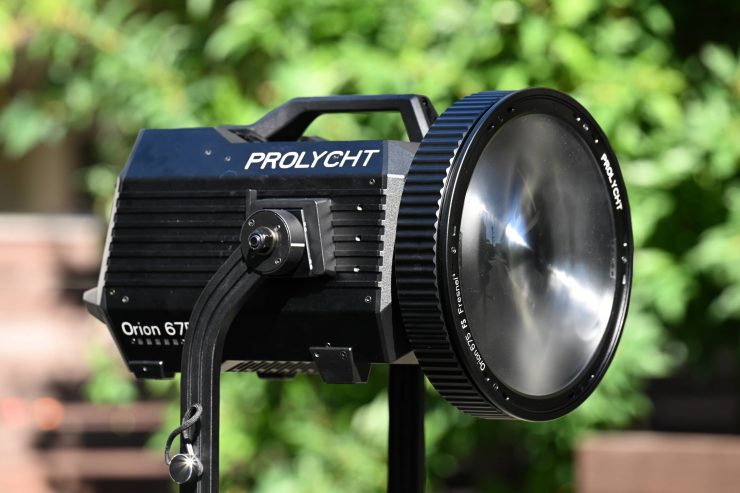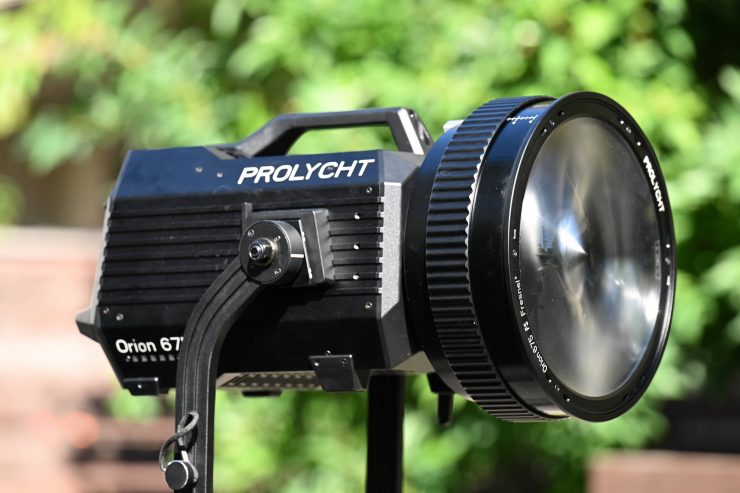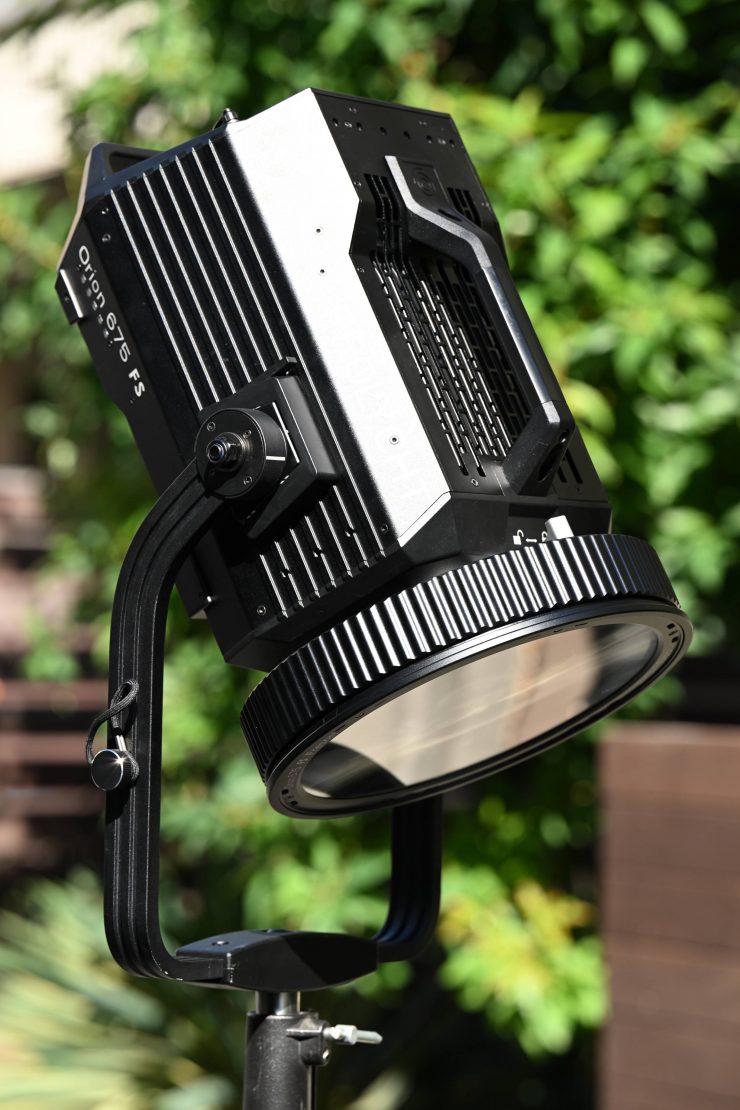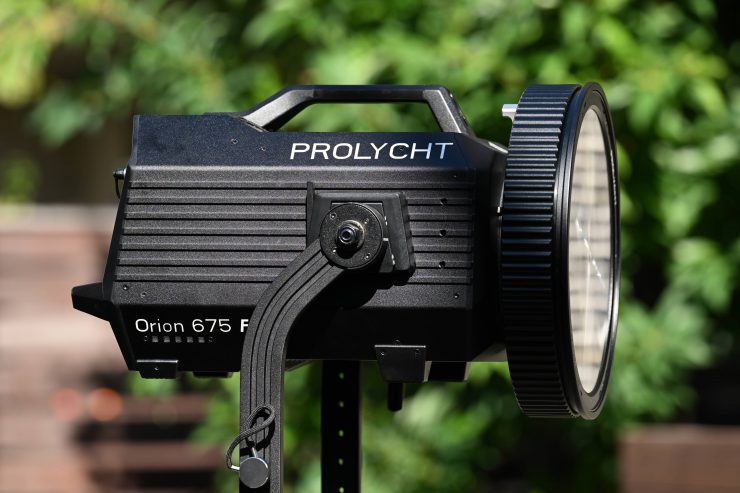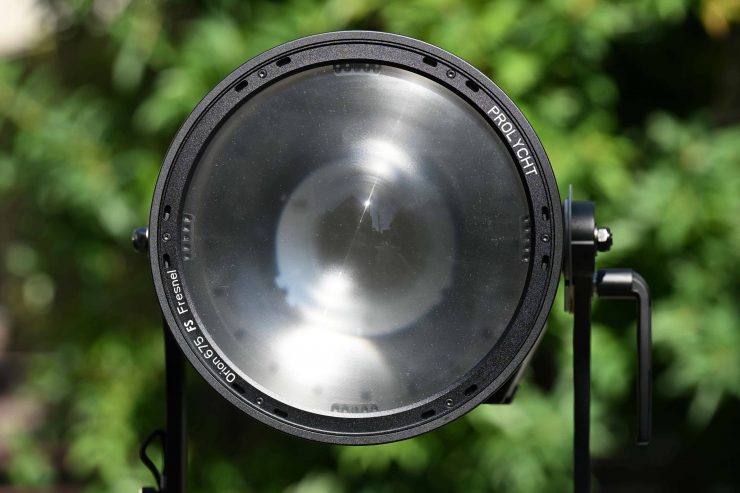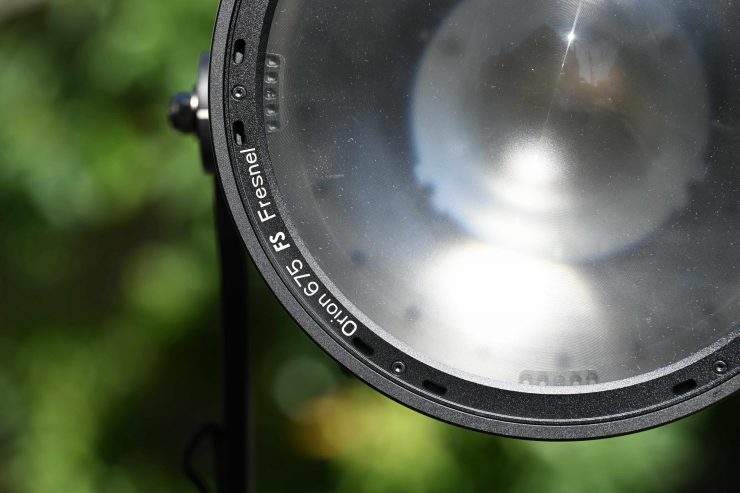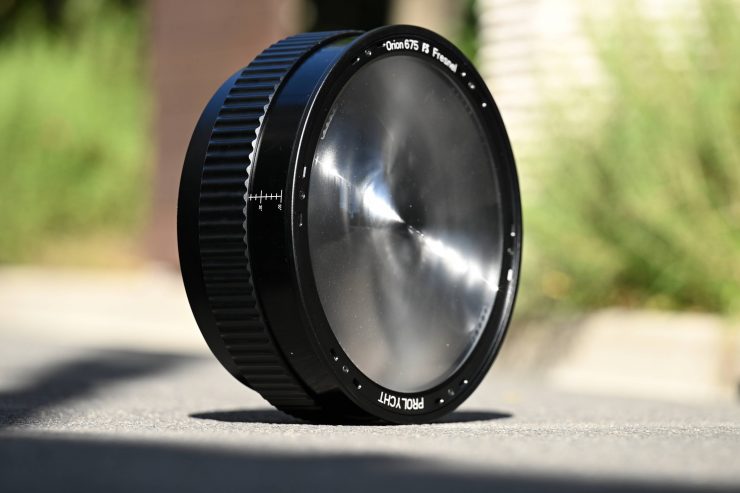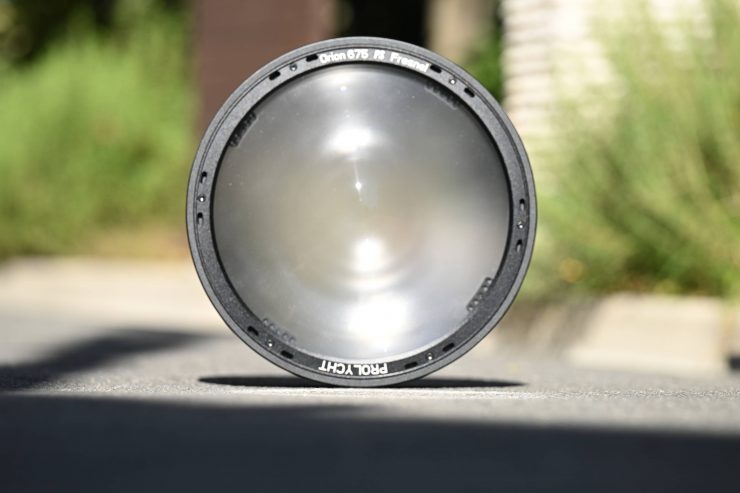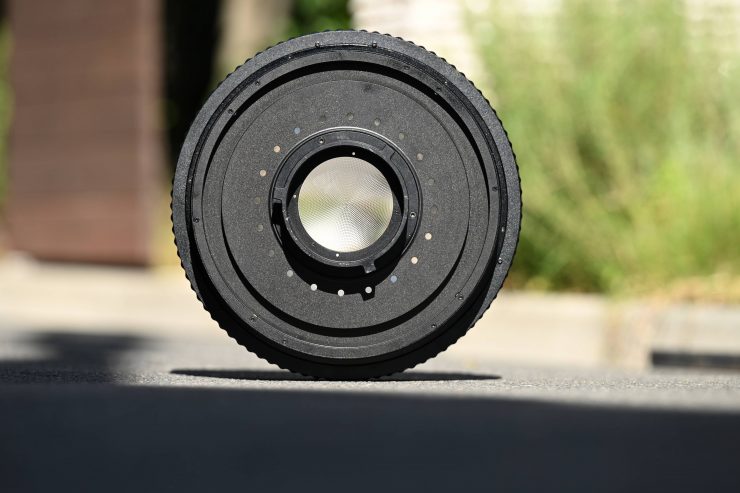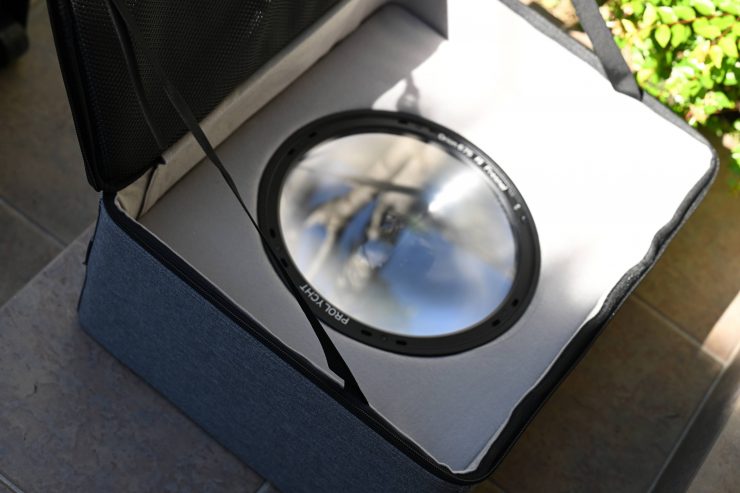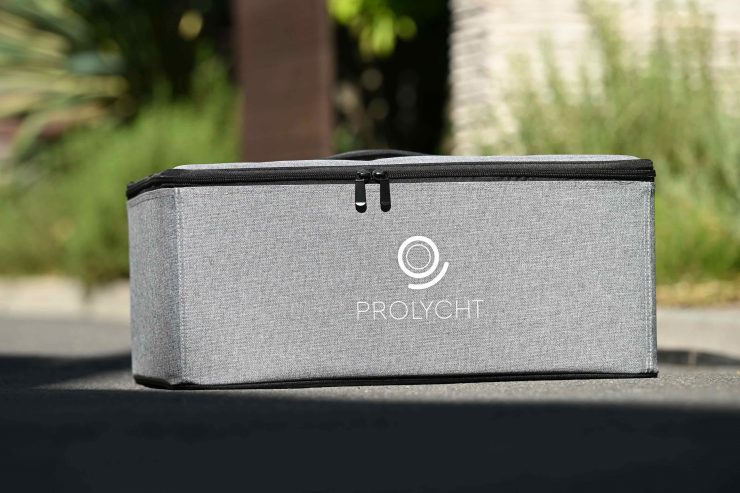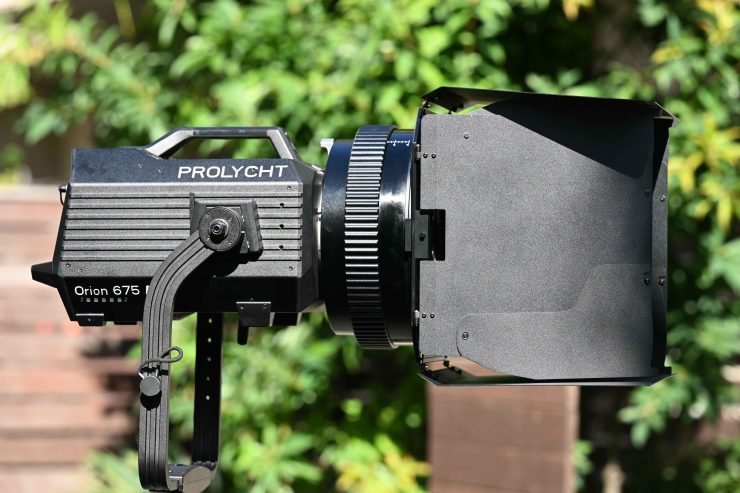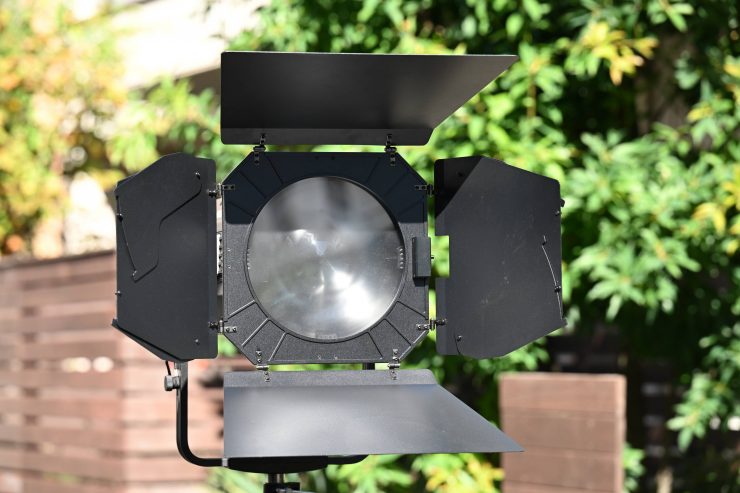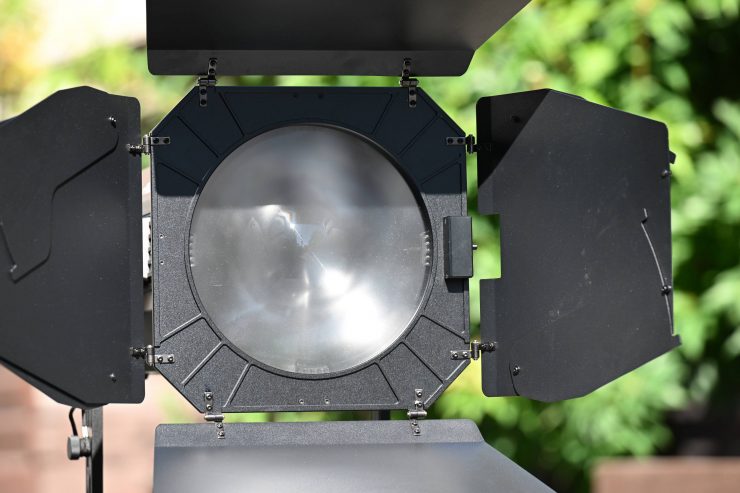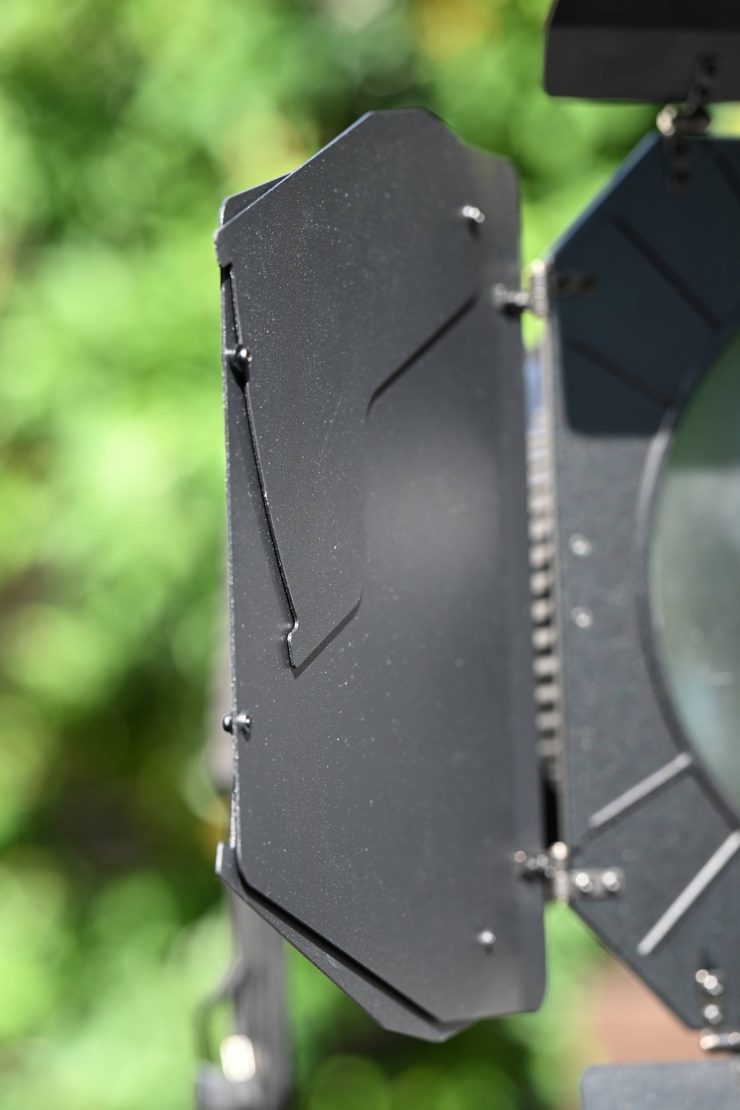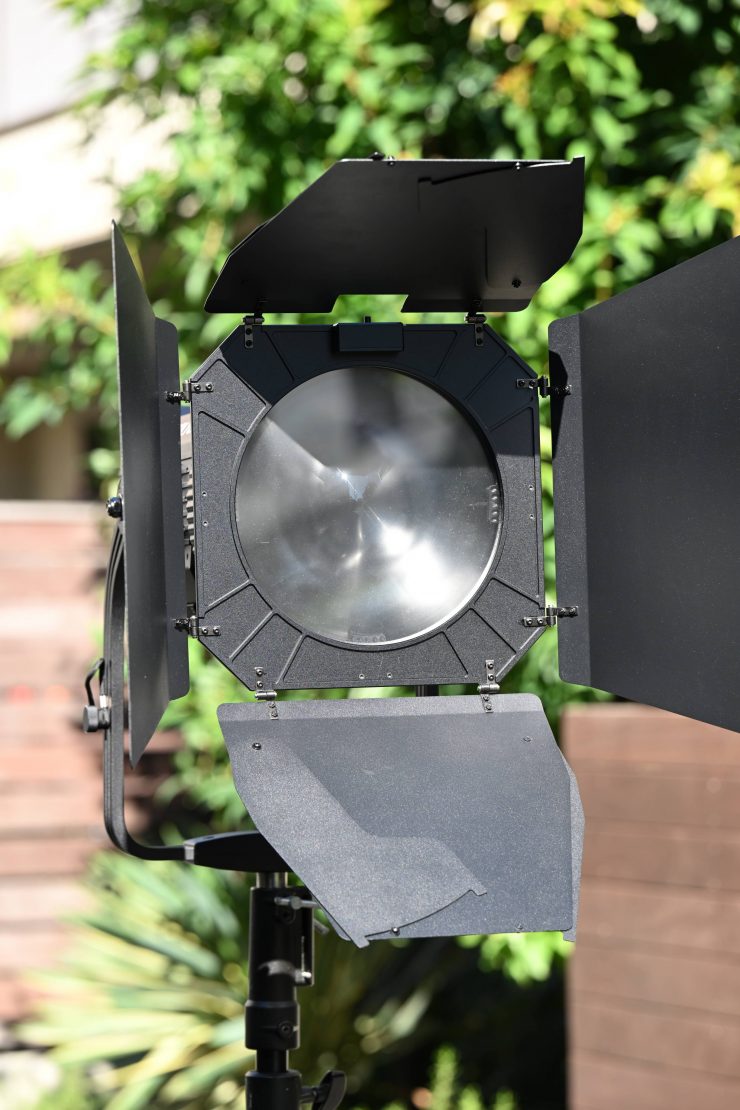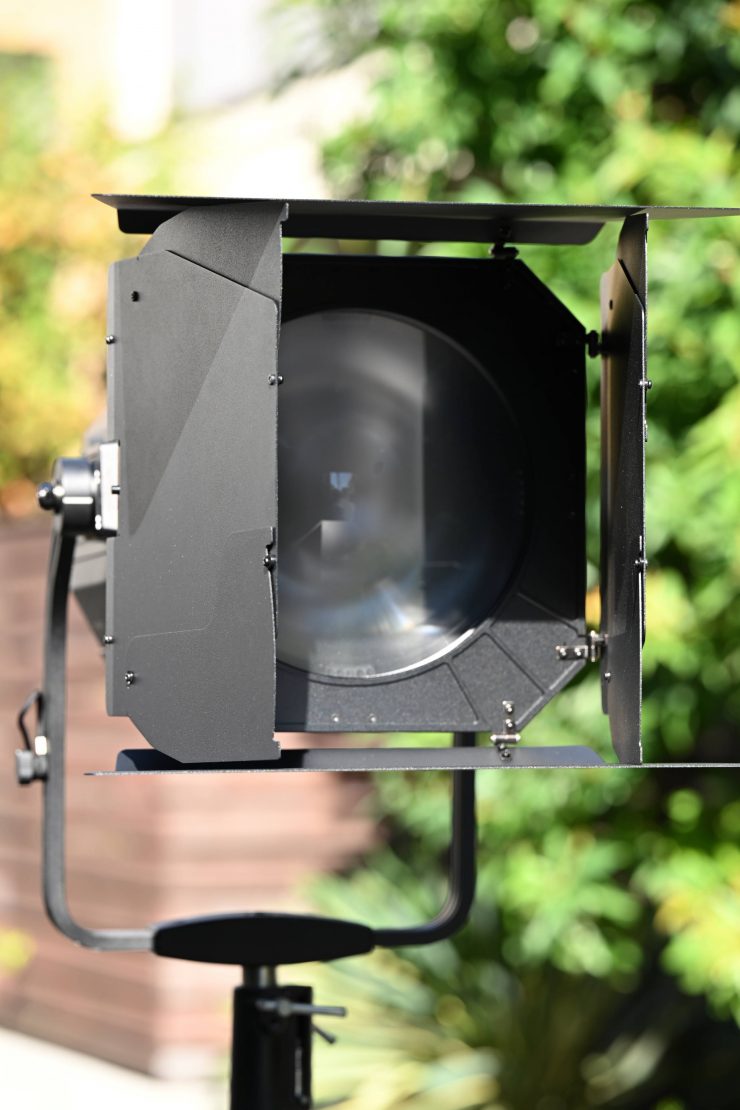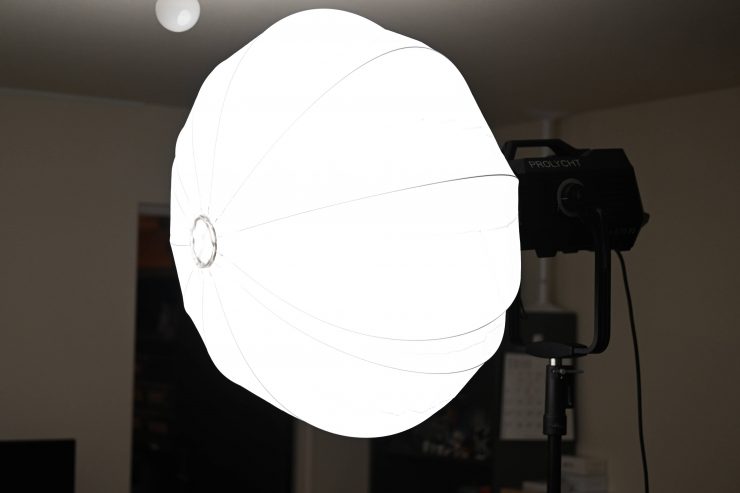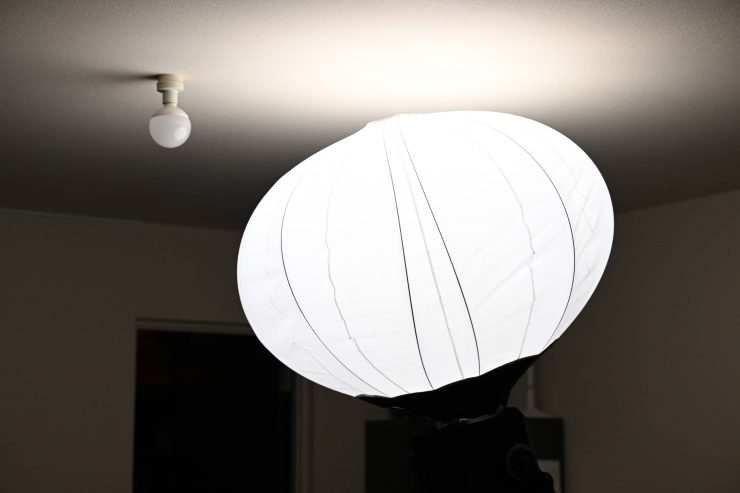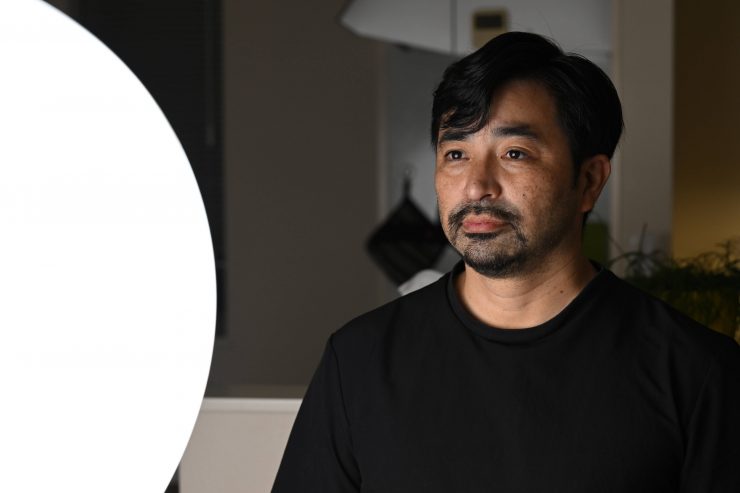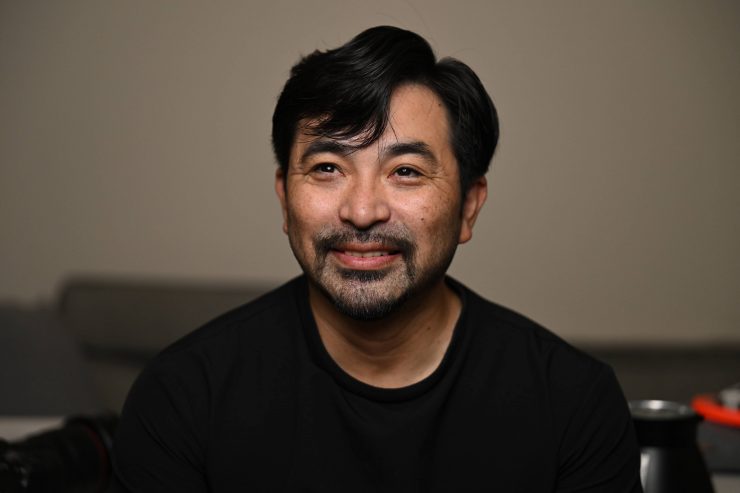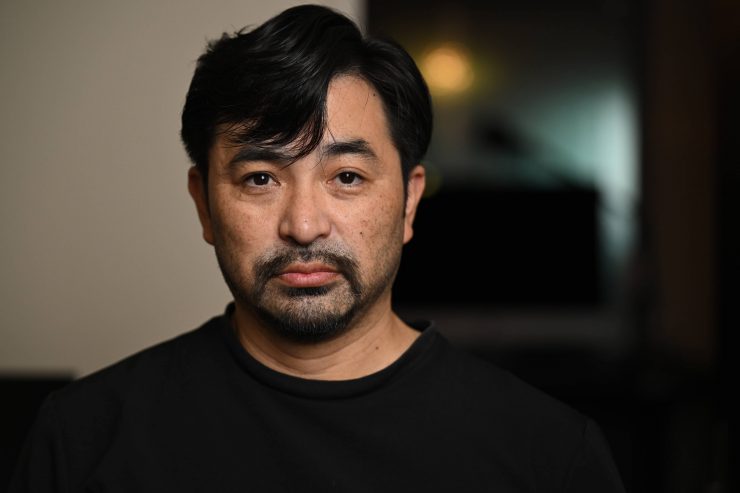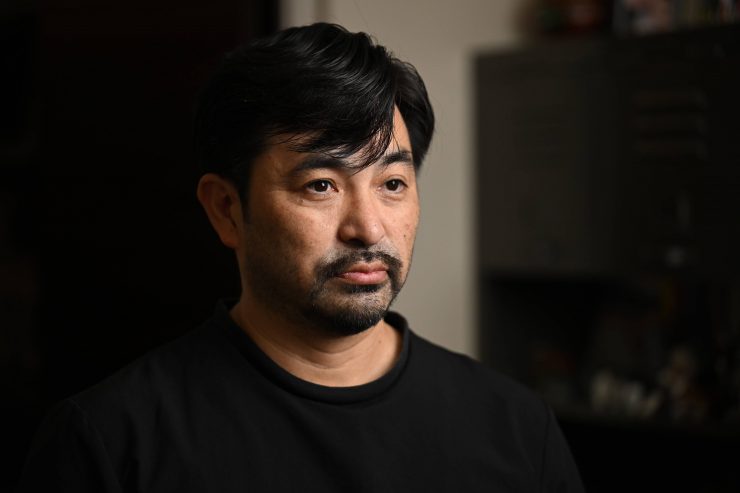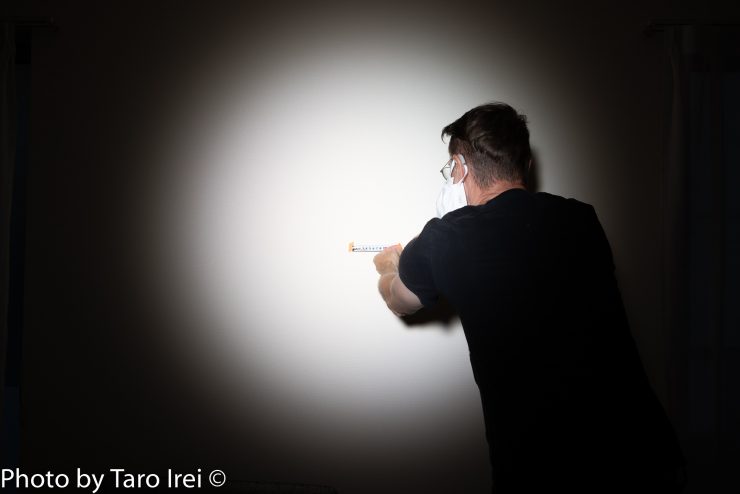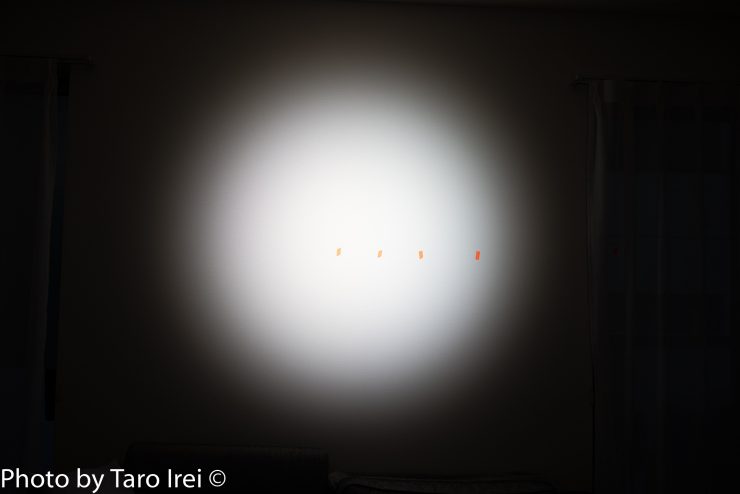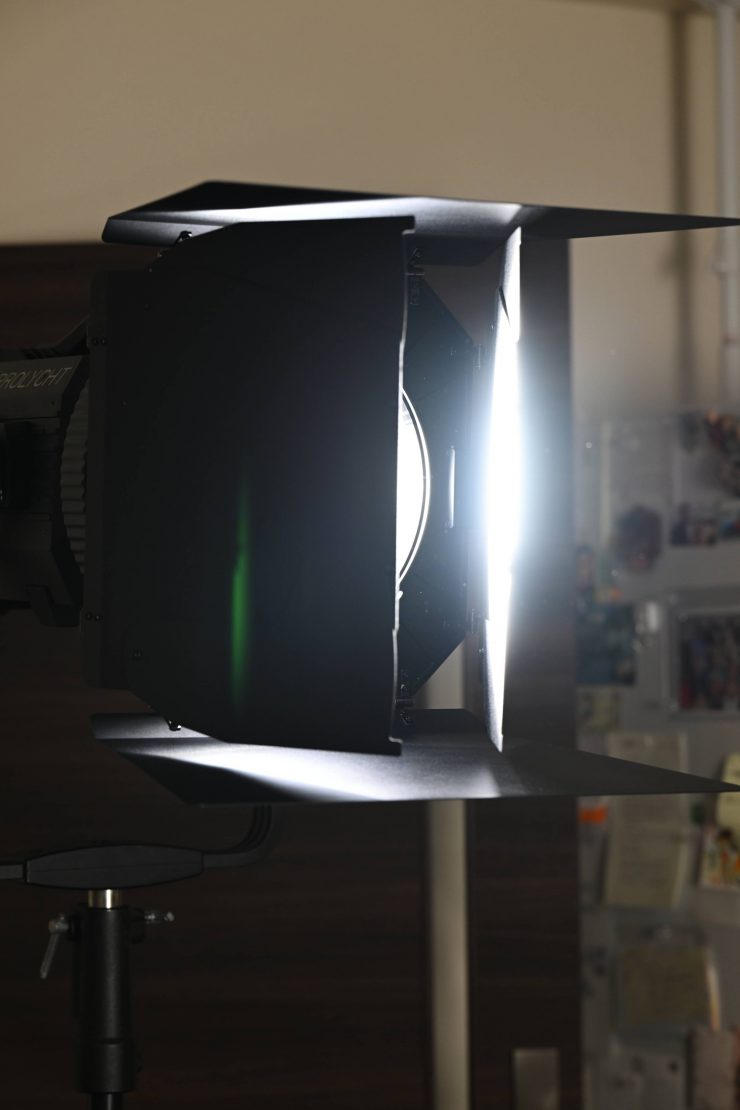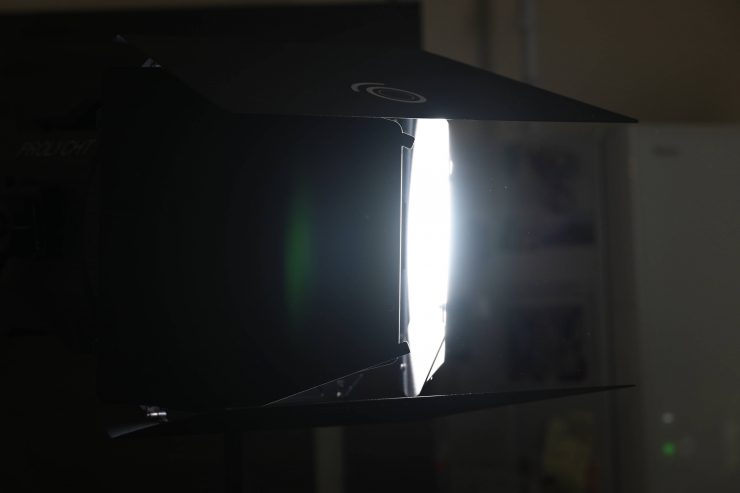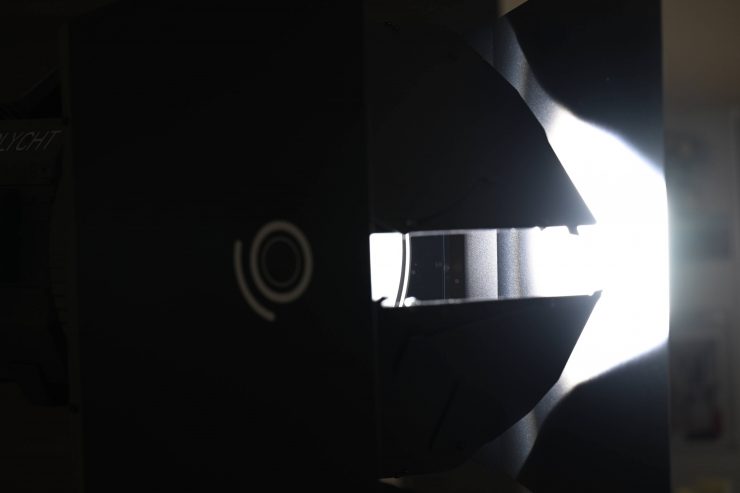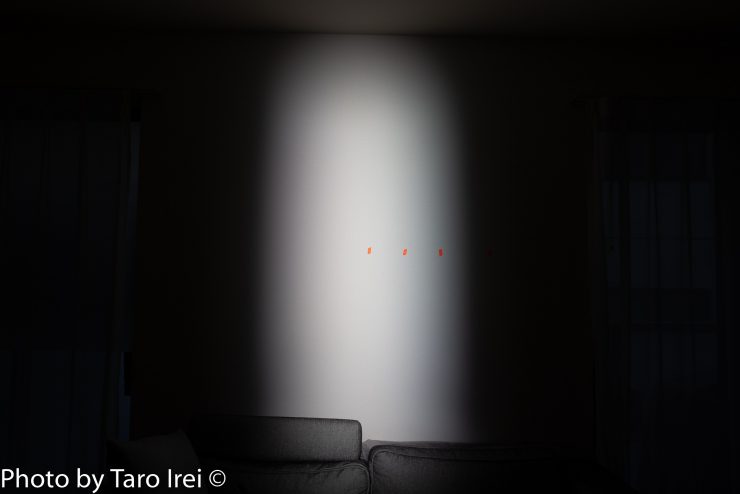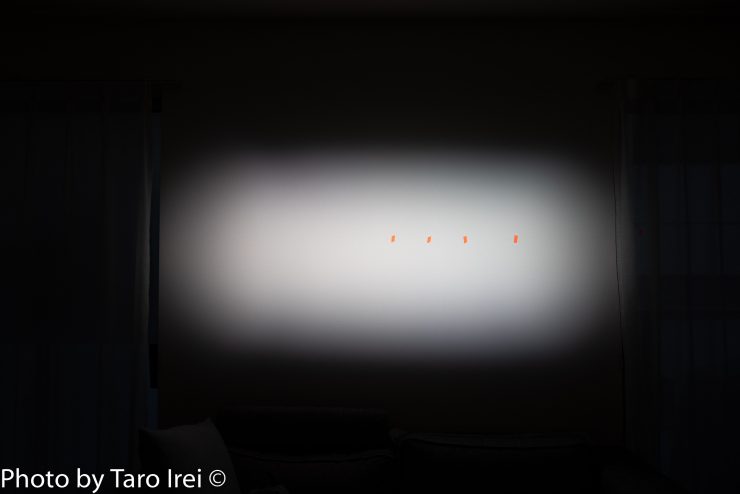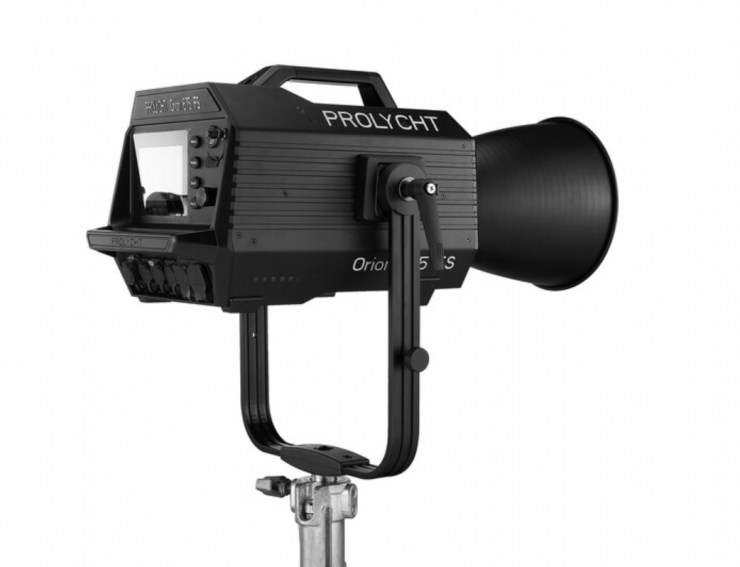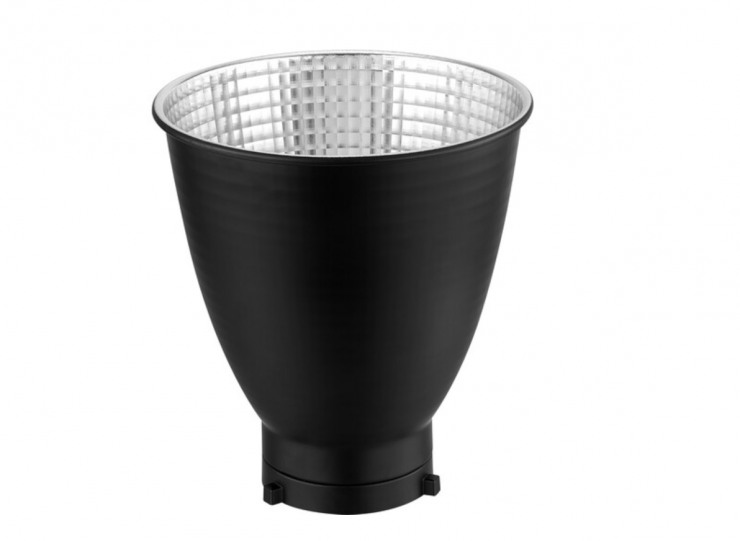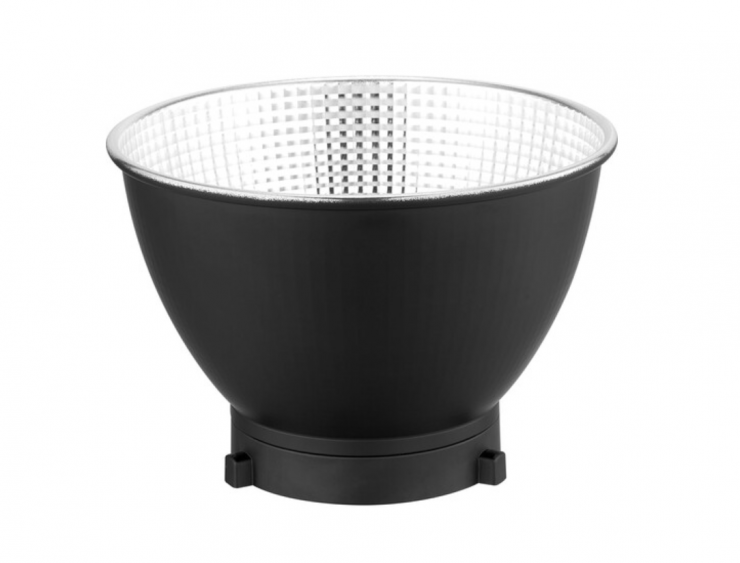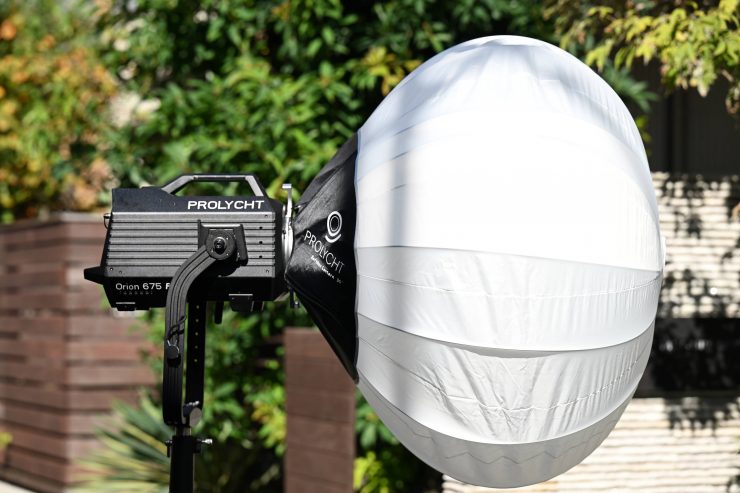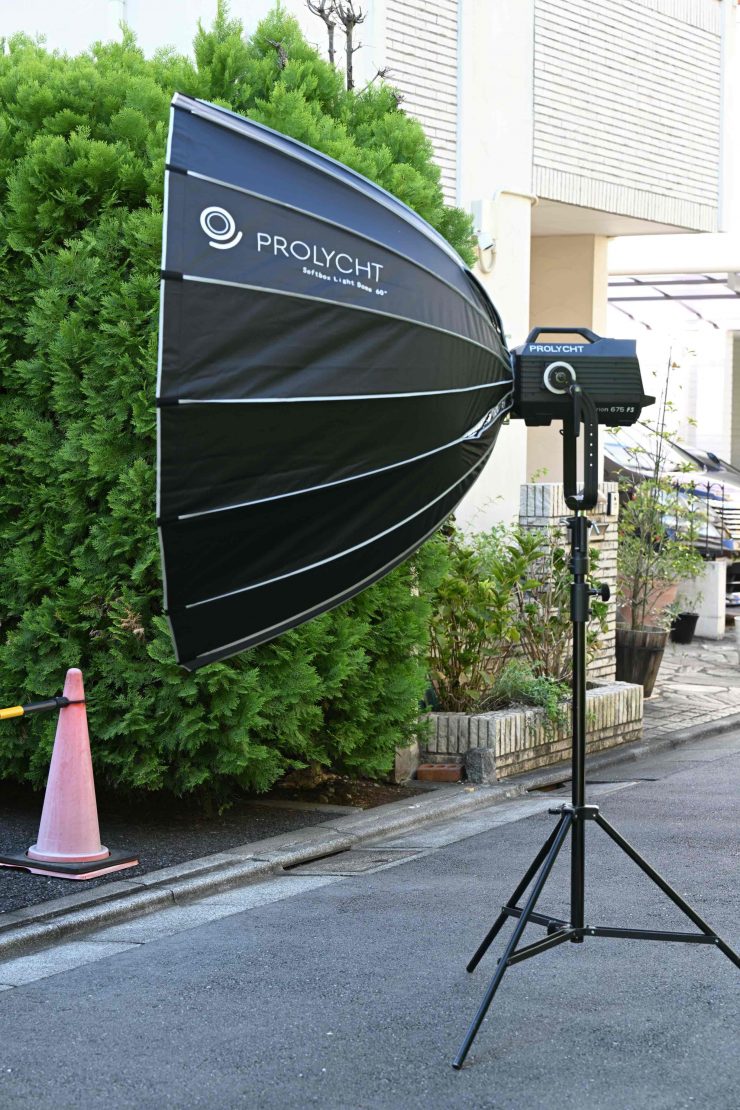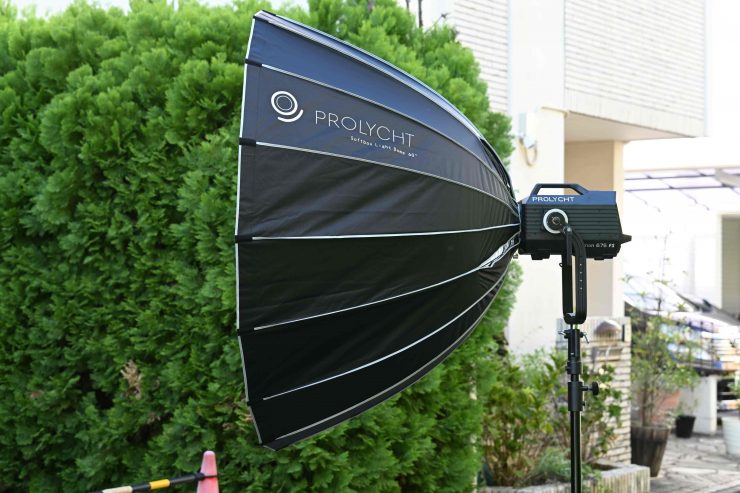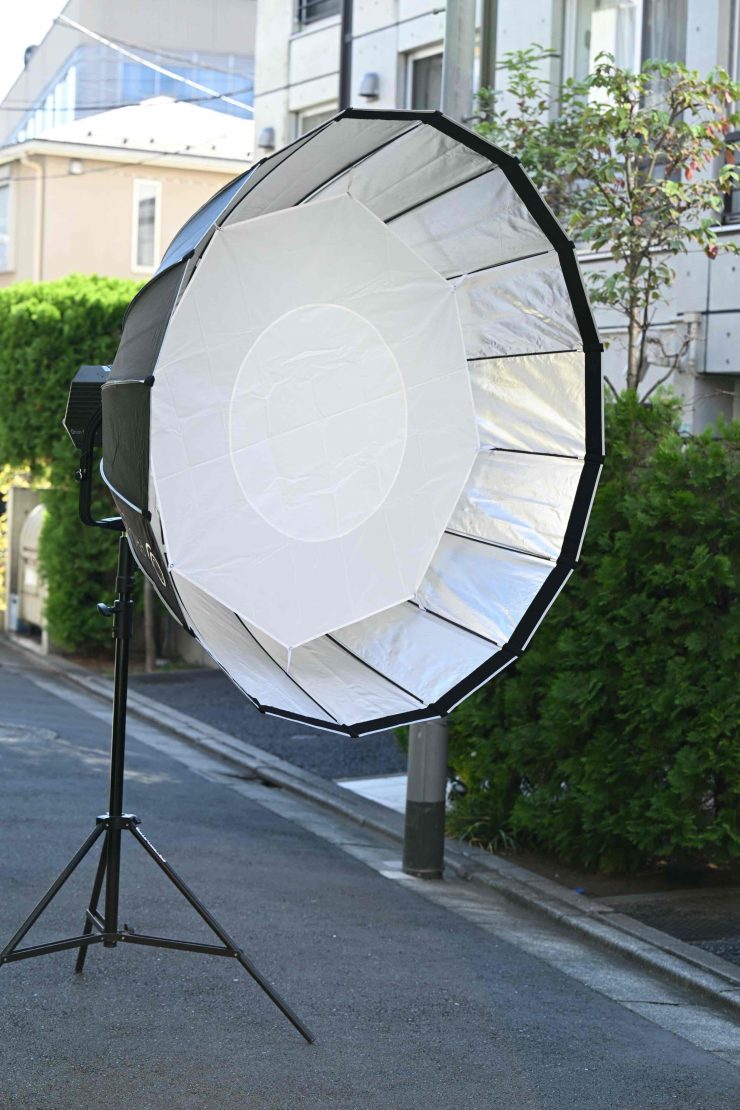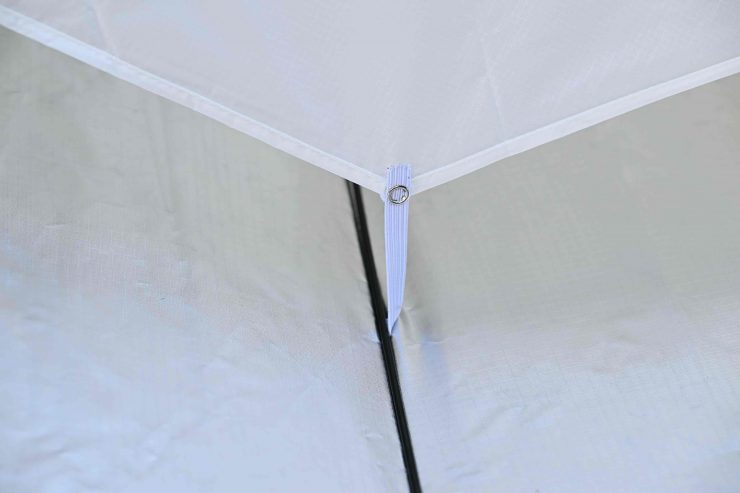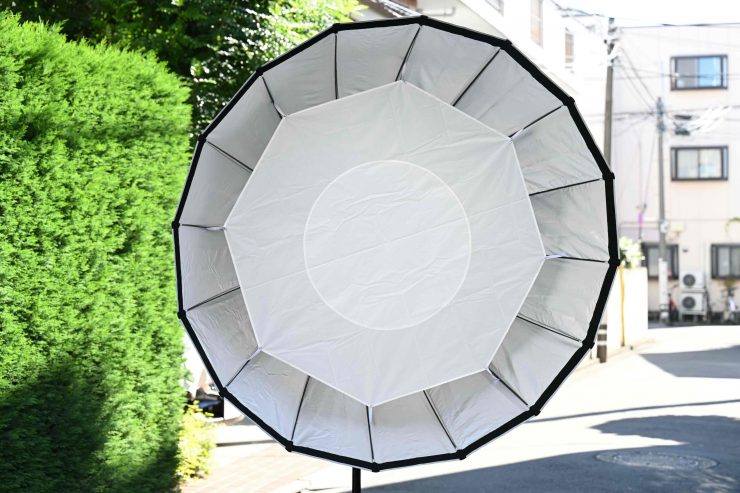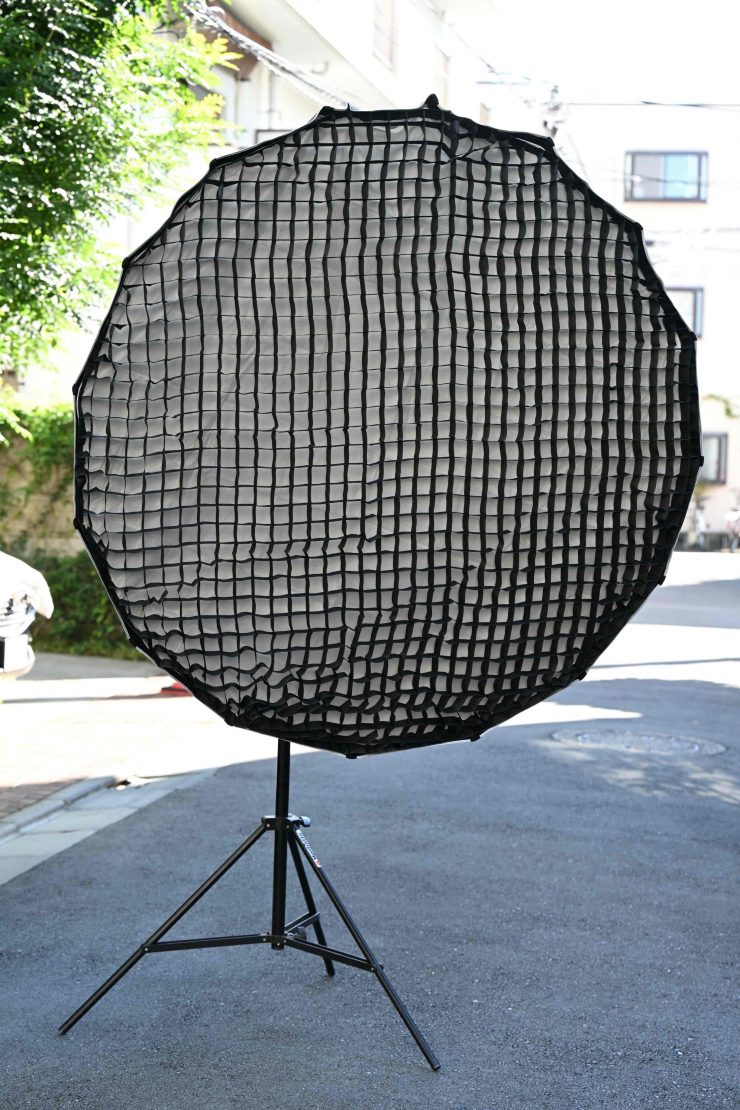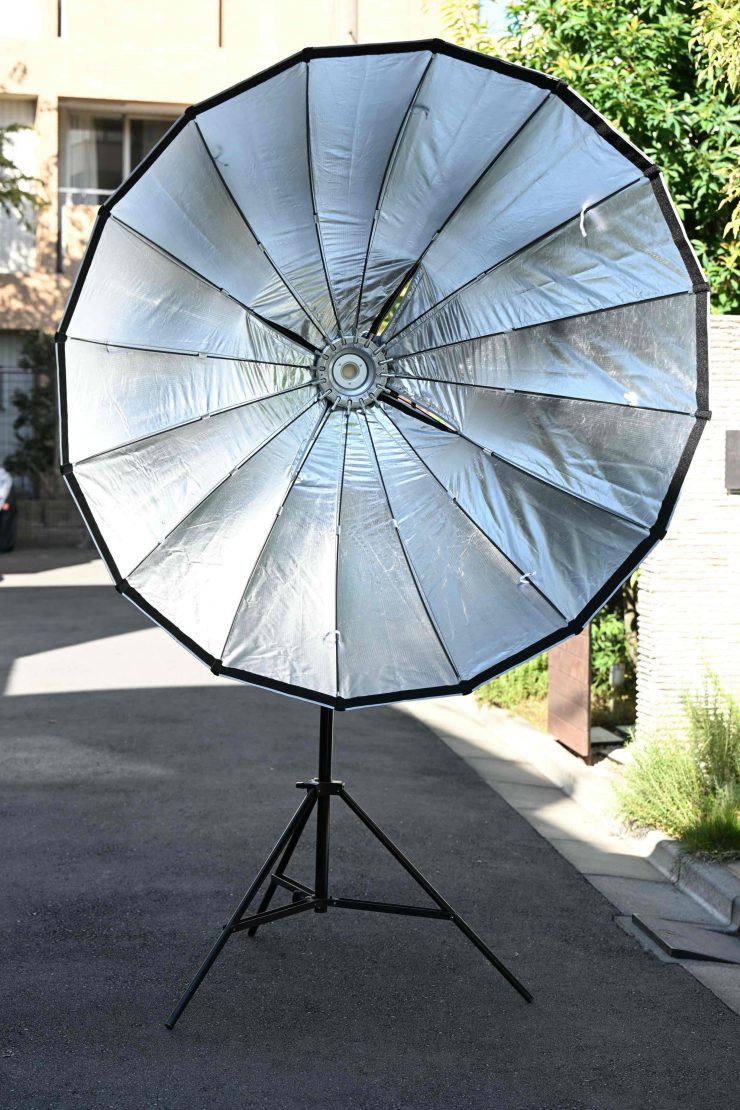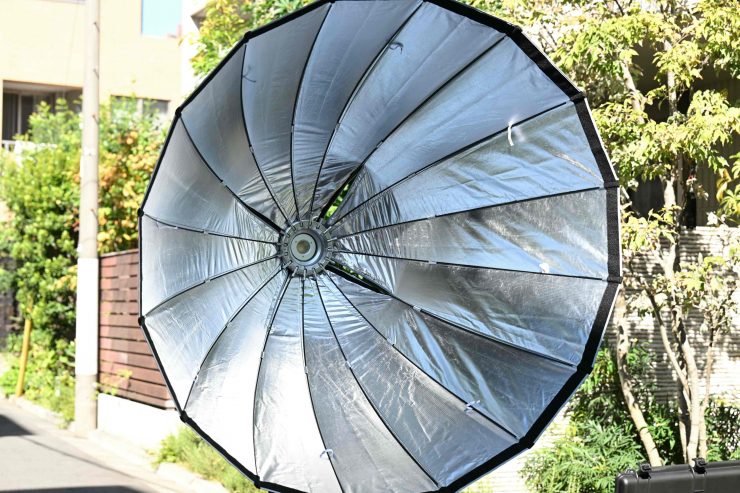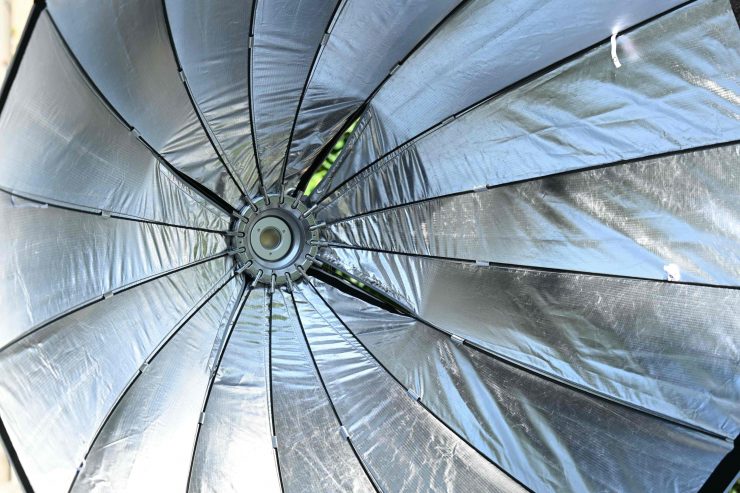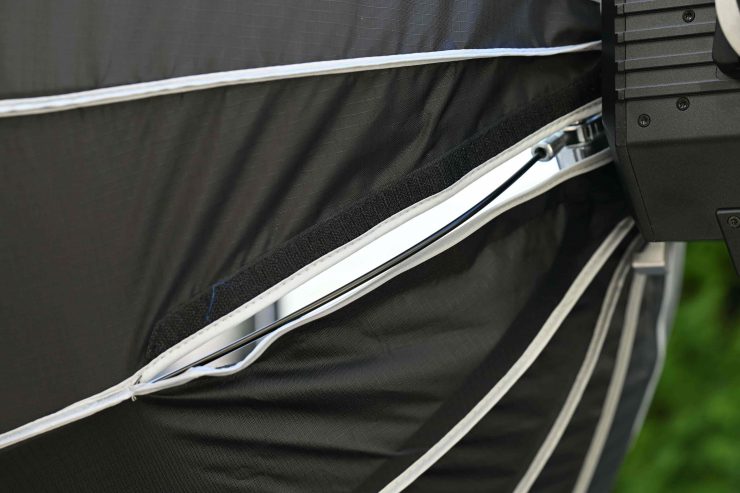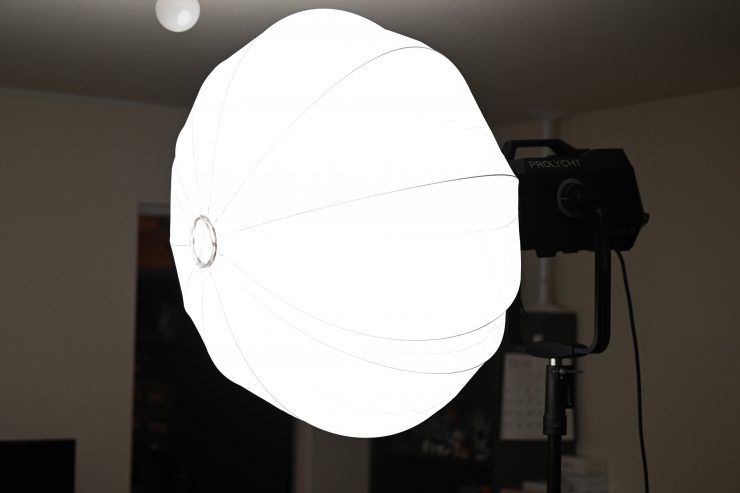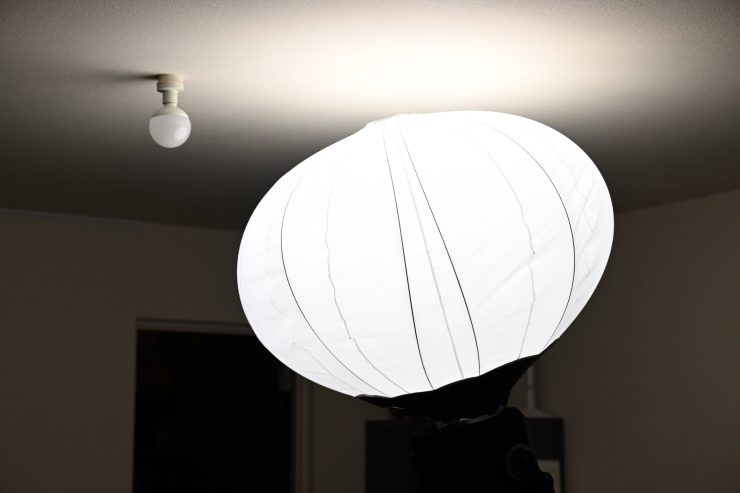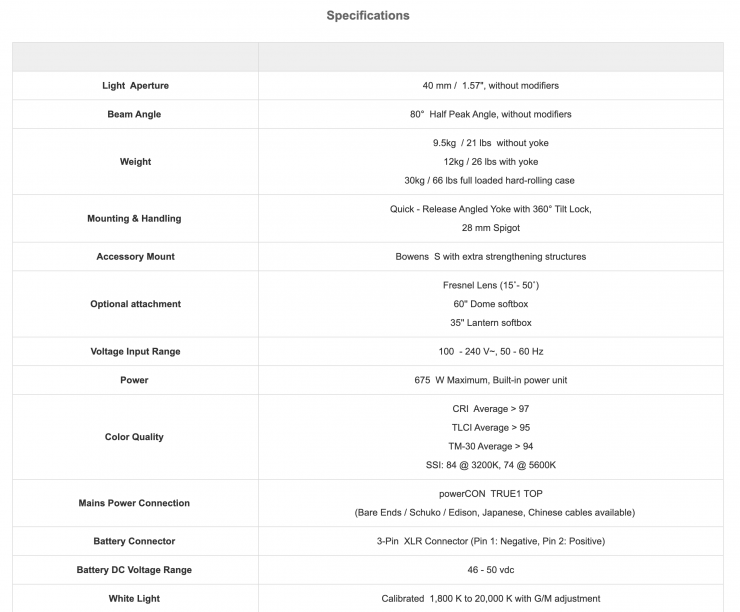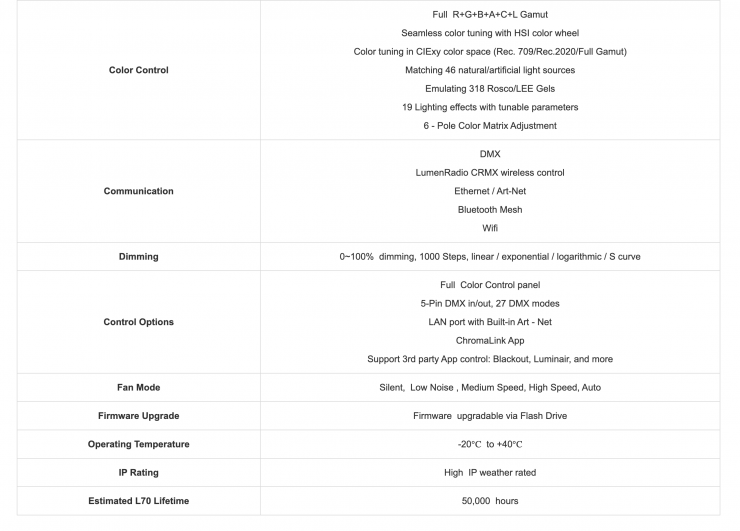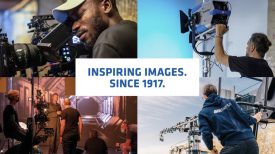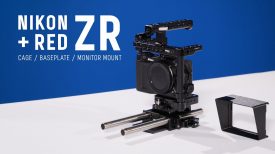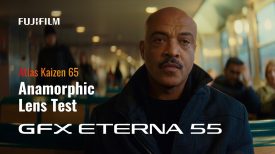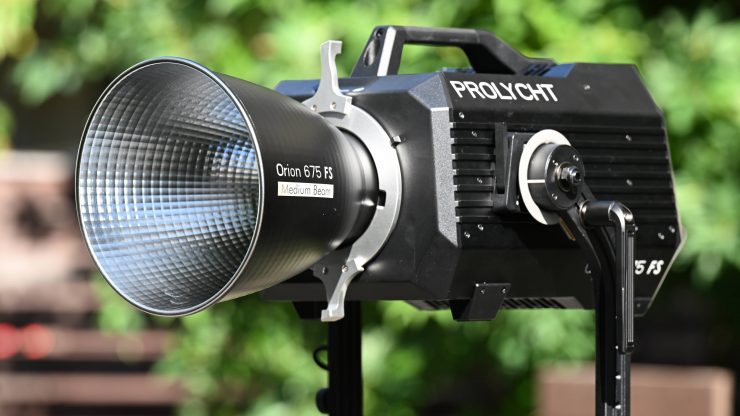
The Prolycht Orion 675 FS was announced way back in April and since that time it has gone through some refinements, and just recently the first orders started to ship out to some customers.
The Prolycht Orion 675 FS is a high-powered full spectrum RGBACL color spotlight.
The Orion 675 FS utilizes a 6-color LED Hyperlight Color engine mixing Red, Green, Blue, Amber, Cyan, and Lime to create a wider color gamut. Prolycht claims that this RGBACL technology used in the Orion 675 FS gives it the ability to outperform rival RGBWW-based spotlights.
Lights in this form factor are becoming increasingly popular because of their versatility, and we are now starting to see more full-color options coming to market. So, let’s get on with the review and see how the Prolycht Orion 675 FS stacks up.
Key features
- Full Color Tuning RGBACL
- 675W power draw
- 6-color LED Hyperlight Color engine
- 1800-20,000K
- HSI Mode
- CCT Mode
- GEL Mode
- X/Y Mode
- Source Mode
- Effects Mode
- 97 CRI Rating
- Supports DMX, Art-Net, LumenRadio
- Ethernet, Wi-Fi, and Bluetooth Mesh
- Supports ChromaLink, Luminaire & More
From the first prototype we saw to now there have been some significant improvements and changes:
- New Yoke design- Angled and a single clutch lock. The mount point has been moved on the head so that it’s well-balanced when using the Fresnel. It can also be installed in a reverse direction which helps when you need to balance heavy mount accessories.
- Prolycht ProLock- This is a new PL-mount style clamping Bowens accessory mount. It is very strong and there is no wobble.
- New Menu features:
* Graphical interface
* Added a calibrated RGBW mode for video RGB signal input.
* Added a “Color Correction” sublevel in several modes that allow the user to adjust the bias of the light, in the metrics of six colors/CCT/saturation.
* Added x,y coordinate references in other modes so you can easily replicate a color accurately. (To do this you move the cursor to the xy coordinates, and press the button, you will see the color shown in a CIE-xy 1931 color space). The adjusted colors can be further saved to presets, both for color correction and xy correction. - The ChromaLink App now supports group control of multiple devices via Bluetooth, for all Prolycht products including Thunder panel lights, Orion 300 FS, and Orion 675 FS.
- On the top right of the control panel, you will find two unused ports. They are reserved for future usages such as Genlock signal synchronization and cable connection to a hand-held control panel. They are not for antennas as some customers suspected.
- Lastly, the variation of reflector will affect the color accuracy. In the production model, the color calibration is dedicated to the wide beam reflector, instead of the medium beam reflector or fresnel, although the difference is minor.
Concept
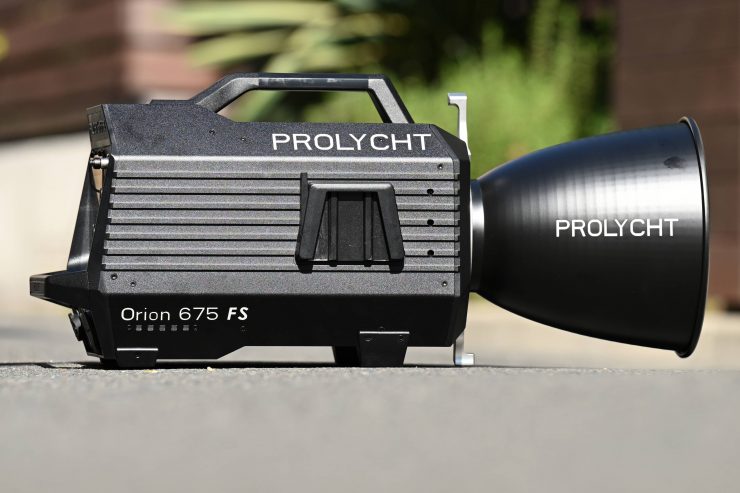
The concept behind the Prolycht Orion 675 FS was to follow the same principles that made the Orion 300 FS so popular. Give users a very flexible, fully-featured, well-made, and high-performing lighting source.
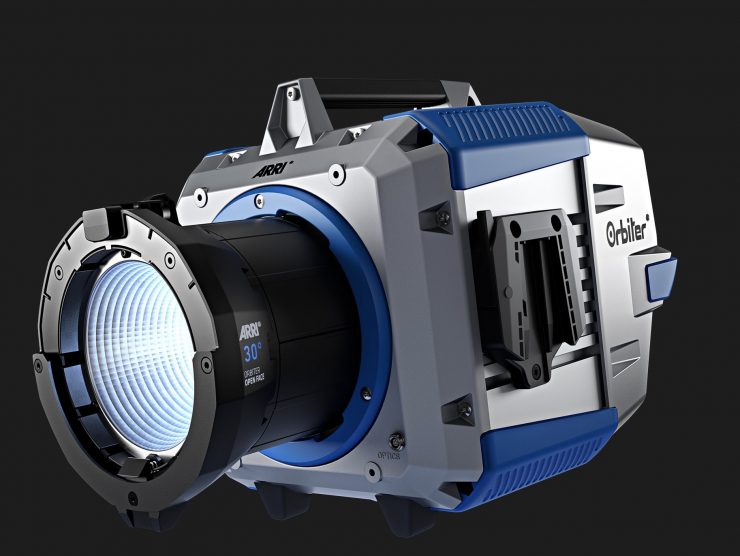
The Prolycht Orion 675 FS Pro, at least design-wise, shares some similarities with the ARRI Orbiter. Both have detachable quick-release yoke frames, both use interchangeable optics, and both have built-in power supplies and controllers.
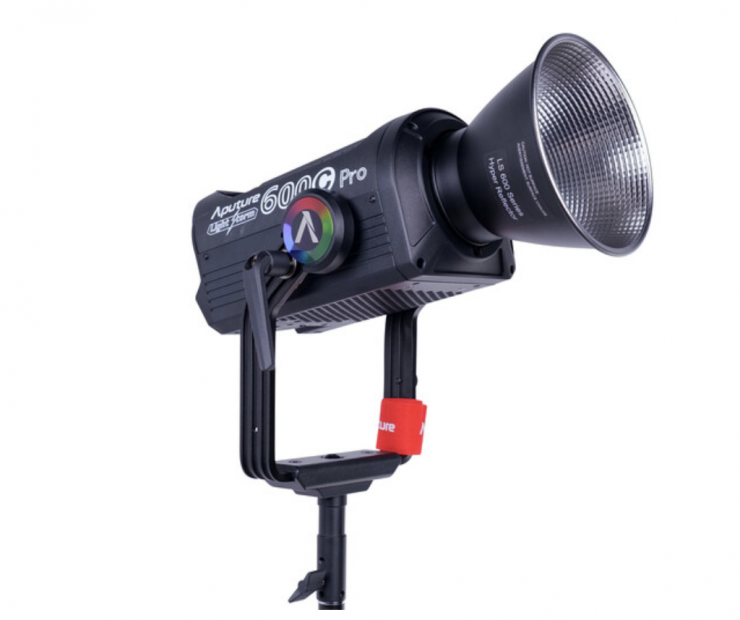
The Orion 675 FS does look a little different from other competing lights such as the Aputure LS 600c Pro.
Who is Prolycht?
In case you haven’t heard of Prolycht before they are still a relatively new lighting company, that just like quite a lot of other lighting companies, has its roots in China. Their founder, Anqing Liu is a lighting research scientist who graduated from Rensselaer Polytechnic Institute Smart Lighting Research Center and worked at Philips Lighting Research Center in Boston. He also serves on the CIE standards board (as in the CIE1931 color chart that everyone references) and he wrote the original paper on mixing multiple LEDs of different colors to create a full rich color spectrum.
Prolycht has also gotten practical input from Rodney Charters ASC and Mitch Gross also serves as a technical consultant.
The Orion 675 FS is not the company’s first light, they also make the Orion 300 FS, Thunderlite, and Thunderlite ONE.
RGBACL
The Orion 675 FS uses RGBACL, just like the ARRI Orbiter. The Orion 675FS and Oribiter don’t use any white LEDs, instead, they mix all of those different color LEDs to produce white light. Hive Lighting has also been using 7 LED-chip blending. Instead of the traditional 3 colors, Hive uses red, amber, lime, cyan, green, blue, and sapphire. The advantage RGBACL has over RGBWW is that it is capable of giving you a larger CCT range and it can produce more saturated colors with more output. RGBWW lights tend to struggle to create saturated colors like yellow and they don’t always have as much output when generating saturated colors. They can also have a large drop-off in output at different CCT settings.
There is a lot of debate and argument over what is better. Prolycht will tell you that RGBACL is better, while Aputure will tell you that RGBWW is better. I don’t have any horses in this race, so I am not influenced by what lighting companies say. All my reviews are based on data and facts, and every light gets the same unbiased treatment regardless of who makes it or how much it costs.
I am not a Prolycht or Aputure fanboy who is going to give you a biased assessment of a light. I have seen, used, and reviewed hundreds of lights over the years so I think I have a pretty solid background in giving you a professional opinion that isn’t influenced by marketing hype.
Build Quality
The build quality of the Orion 675 FS is very industrial. The entire casing of the light is made out of aluminum and there is no plastic to be seen. While I don’t particularly think the light looks elegant or pretty, it’s not how it looks, that matters.
It certainly feels like it was designed to stand up to the rigors of fieldwork and the day-to-day punishment of being in a rental house.
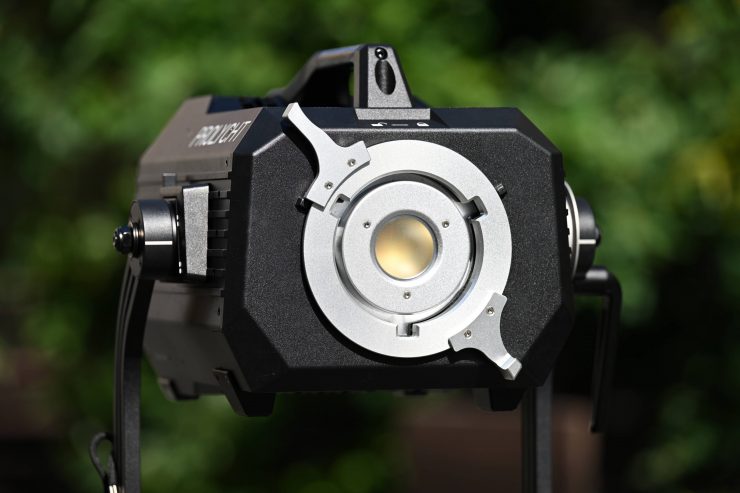
What I like about Prolycht is that they continue to evolve as a company. Instead of just making a bigger version of the Orion 300 FS with the same form factor and separate controller/power supply, they went back to the drawing board. It is far easier to just make a larger version of an existing light while keeping the same form factor and type of design than it is to come up with something completely new.
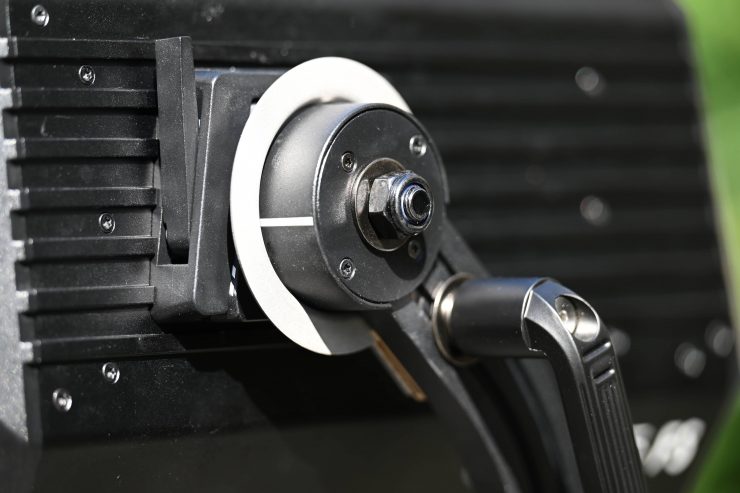
The light features a single locking mechanism on the yoke frame that is well made and it solidly locks the light down.
Prolycht gives you a nice long, thick, and robust power connection cable that allows you to place the light up very high. It is always nice to see a long cable included with a light as standard.
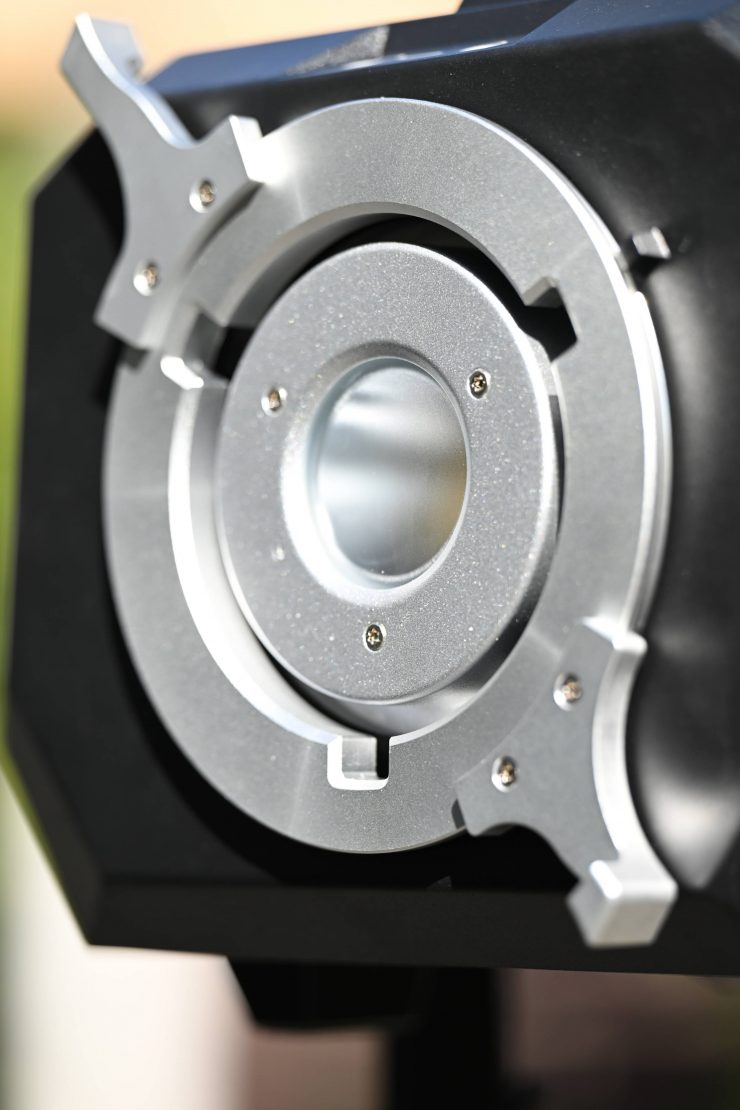
The Prolycht ProLock is very strong and robust and it is a lot more solid than what you will find on the competing Aputure LS 600c Pro. I will talk more about the Prolycht ProLock further down in the review.
Design
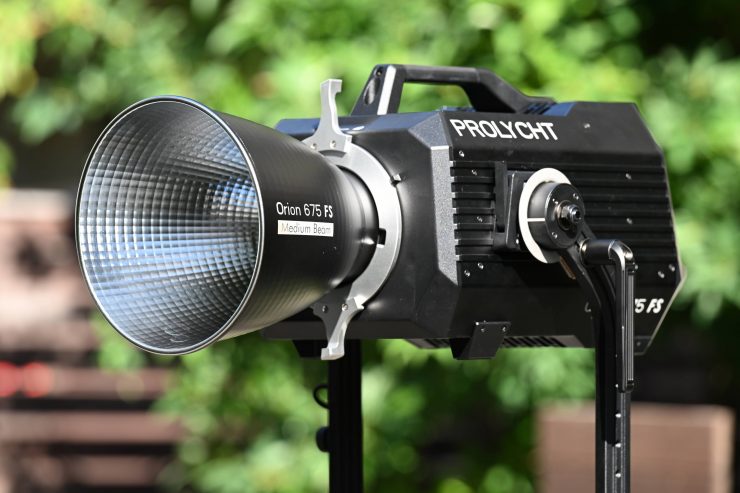
The Orion 675 FS is quite different from competing lights like the Aputure LS 600c Pro as it features an all-in-one design. There is no separate power supply/controller.
This isn’t common with high-powered LED spotlights such as these. Having multiple components can be a pain, but on the flip side, having a separate light head allows you to use slightly smaller-sized light stands.
With the all-in-one design of the Orion 675 FS, you do need to use it with an appropriately sized stand. I personally like having an all-in-one design, however, there are times when it makes sense to have the ability to separate components.
At least, in my opinion, the design of the Orion 675 FS has a lot more in common with a light like the ARRI Orbiter than an Aputure LS 600c Pro.
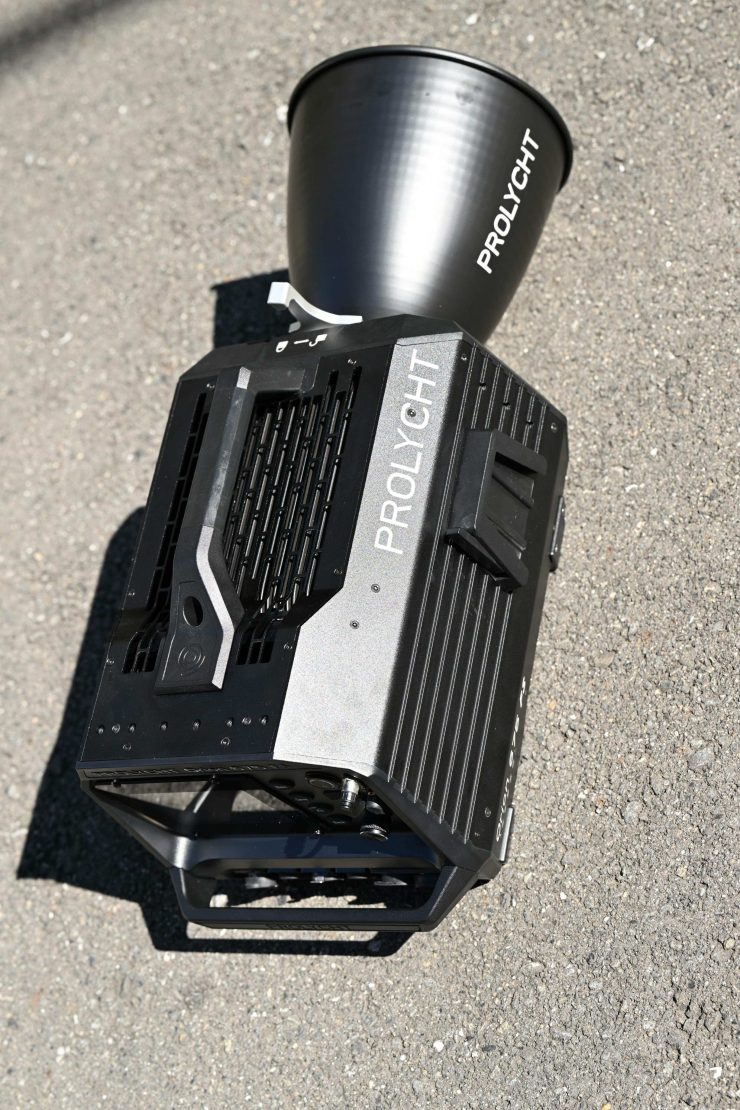
What I also like about the design, is that you can put the Orion 675 FS on the ground or a flat surface because it has feet on the bottom. This is something you can’t do with a lot of other competing fixtures.
A lot of today’s modern lights are now a seamless blend of hardware and software. With software playing such a big role, lighting companies could continue to improve and update fixtures over time via firmware updates, however, you don’t actually see too many firmware updates getting released for lights. To their credit, Prolycht has already released a firmware update for the Orion 675 FS.
COB
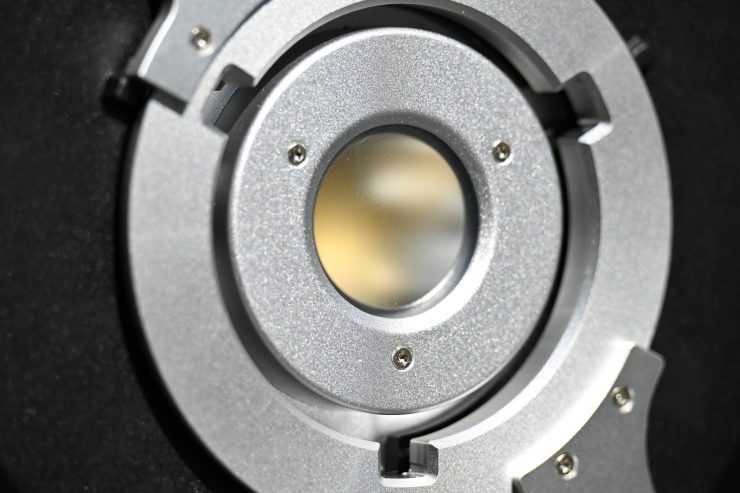
Quite a few LED lights on the market, including the Orion 675 FS, are using COB technology. COB stands for “Chip On Board” where multiple LED chips are packaged together as one lighting module. The advantage of COB LEDs being multi-chip packaged is that the light-emitting area of a COB LED can contain many times more light sources in the same area that standard LEDs could occupy. This results in a greatly increased lumen output per square inch.
The Orion 675 FS RGBACL multicolor COB utilizes an all-new internal geometric structure, creating a front surface that is just over 1.5″ across. This design is claimed to create sharp shadows with a wide, even beam spread, and allows you to use a variety of Bowens mount accessories.
I did find from using that fixture that it does create sharp shadows without any of that multiple shadow effect that you tend to see with a lot of COB lights.
The first caveat with COB LEDs is that they produce a ton of heat and that heat needs to be effectively dispersed. The second caveat is that you will usually need to diffuse them as they are very bright to look at and unsuitable for directly lighting talent. The trouble is if you use them with diffusion, such as a softbox, you are going to lose a ton of output because that output is coming from a small-sized source. With a lot larger source, say a 2×1 panel, you don’t lose as much output.
Weight & Size
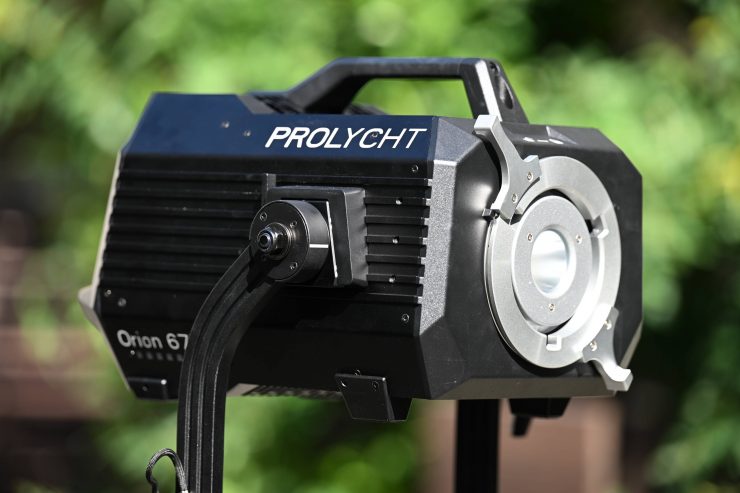
The Orion 675 FS weighs in at 21 lb / 9.5 kg without the yoke frame. With the yoke frame, the total weight goes up to 26 lb / 12kg. This does make the light pretty heavy and you need to be aware of this. This is certainly not a fixture you can use with a run-of-the-mill light stand.
Because of the all-in-one design, you end up with one heavy item, instead of two individual pieces. There are pros and cons to having a single light head instead of a light head and a separate power supply/controller.
So how does this weight compare to other COB spotlights such as the ARRI Orbiter, Aputure LS 600c Pro, Aputure LS 600x Pro, Aputure LS 600d, and Nanlite Forza 720 and 720B? Below you can see:
| TOTAL WEIGHT | |
| Prolycht Orion 675 FS | 26 lb / 12kg |
| Aputure LS 600c Pro | 24.4 lb / 11.07 kg |
| ARRI Orbiter | 25.8 lbs / 11.7 kg* |
| Aputure LS 600x Pro | 22.62 lb / 10.26 kg |
| Aputure LS 600d Pro | 22.62 lb / 10.26 kg |
| Nanlite Forza 720 | 21 lb / 9.45 kg |
| Nanlite Forza 720B | 21 lb / 9.45 kg |
* Doesn’t include the weight of the yoke frame
Essentially if you look at the weight comparison above, there isn’t a massive difference between the weight of any of these fixtures, however, the Prolycht is heavier than fixtures from Aputure and Nanlite.
Just to be crystal clear, some of these lights listed above don’t have RGBWW capabilities. I am simply giving you a reference as to how it compares weight-wise to other similar-styled fixtures.
Mounting
The Orion 675 FS comes with a beautifully made angled yoke that allows you to have a greater tilt range when light modifiers such as softboxes are attached.
It is also reversible which is handy if you need to create a better stand balance if heavy accessories are used. The yoke frame has been really well thought out and Prolycht has paid a lot of attention to detail.
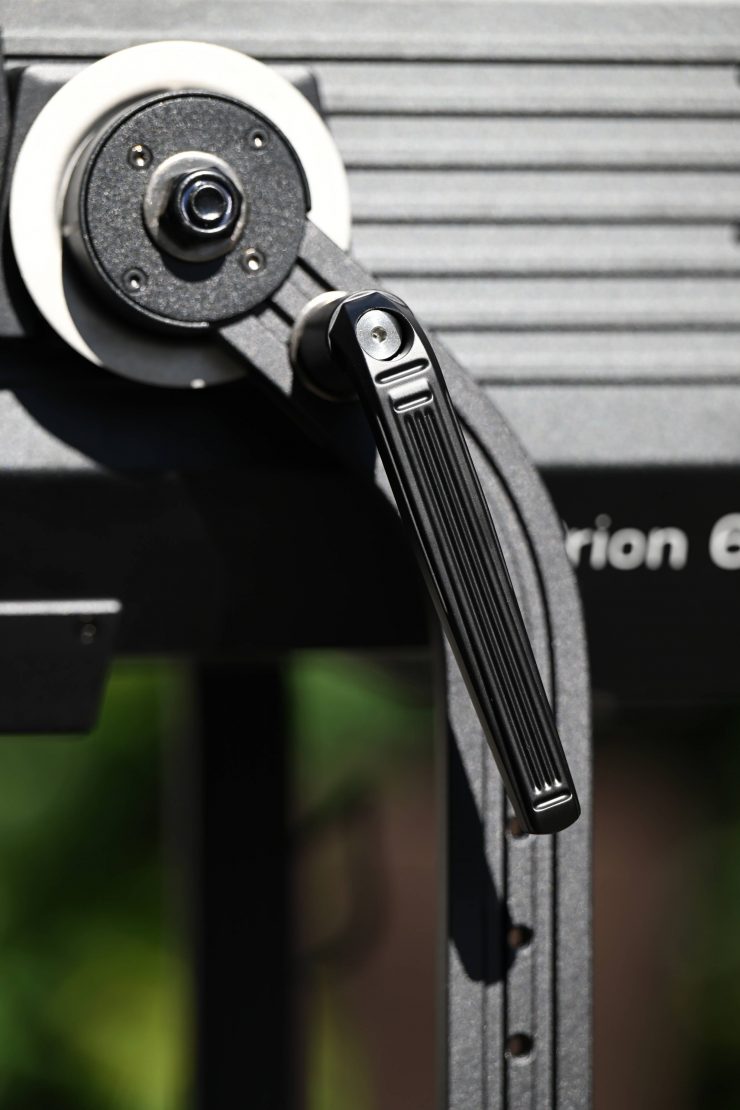
The single clutch lock works really well and once you tighten it down the light will not move no matter how much force you put on it.
The yoke also features quick-release mounts that attach to the Orion 675 FS. This is nice as it allows you to separate the light from the yoke quickly. This is also handy when storing or transporting the light as well. The system being used is very similar to what ARRI uses on the Orbiter.
So is it easy to use? In short, yes. All you need to do is pull back the two locking mechanisms at the same time and then lift the fixture away from the frame. I actually found that the easiest way to do this was to place the Orion 675 FS on the ground. That way you can easily release both locking mechanisms at once. If you have the light up high on a stand I wouldn’t recommend you try doing this by yourself. If it is on a stand, you really need two people, because it’s not easy for a single person to release both locking mechanisms, and it’s a heavy light.
It is also easy to place the Orion 675 FS back on the yoke frame. Again I would recommend doing this when you have the light on the ground.
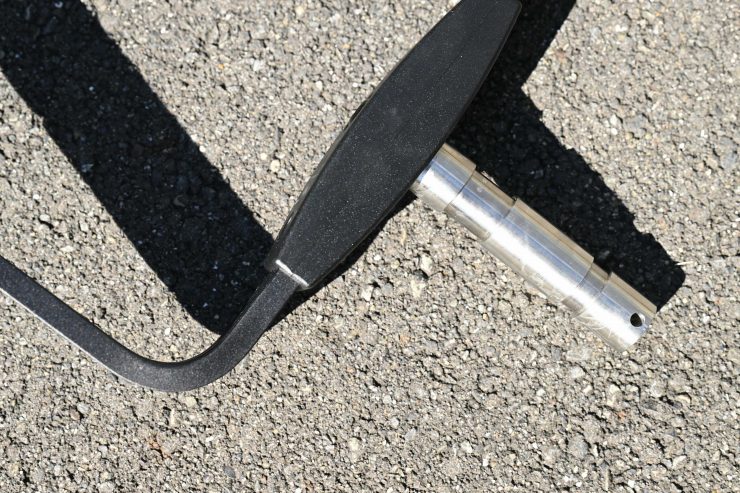
The yoke frame utilizes a junior pin mount so you can only use it with compatible light stands.
The yoke frame is easily strong enough to hold the Orion 675 FS and the Fresnel, or a large lighting modifier.
Prolycht Prolock
The Orion 675 FS features a positive locking clamp on the Bowens mount. This is a smart idea because a lot of standard Bowens mounts on competing fixtures leave a lot to be desired. The Bowens S-mount was never designed to take large and heavy Fresnels or the types of lighting modifiers that are now available.
Essentially the Prolycht Prolock is like a PL mount for your light. It works in exactly the same way as a PL camera mount. It is made out of metal and it is very strong. This allows you to put heavy lighting modifiers or the Fresnel on the Orion 675 FS without fear of anything breaking. Every time I put the F10 Fresnel on the Aputure LS 600c Pro I am worried that I am going to break the mount.
Once you lock in an accessory it doesn’t move or wobble around like it would if you were using a standard Bowens mount. On the competing Aputure LS 600c Pro, every accessory that you attach to the light wobbles around. Having the Prolycht Prolock also makes it far easier to attach and remove lighting modifiers.
I was extremely impressed by the Prolycht Prolock. Again, the attention to detail stands out as the company has thought a lot about the user experience.
Power Draw
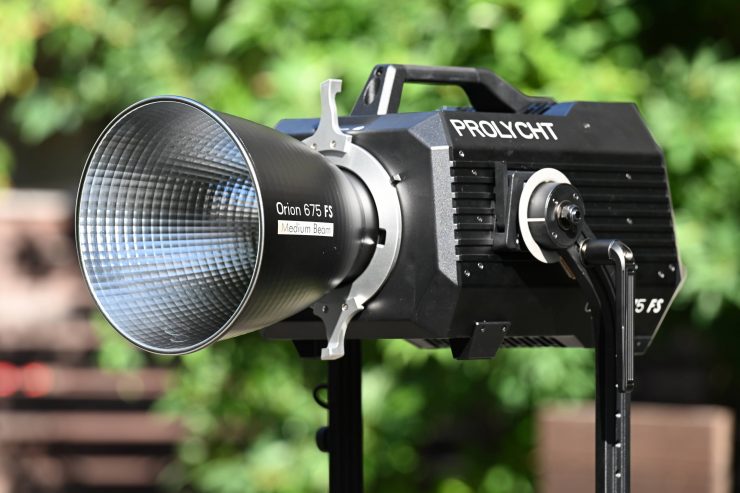
The Orion 675 FS draws 675W. Below you can see how that compares against the ARRI Orbiter, Aputure LS 600c Pro, Aputure LS 600x Pro, Aputure LS 600d, and Nanlite Forza 720 and 720B. Please remember that some of these lights don’t feature RGBWW capabilities.
| POWER DRAW | |
| Prolycht Orion 675 FS | 675W |
| Aputure LS 600c Pro | 720W |
| ARRI Orbiter | 500W |
| Aputure LS 600x Pro | 720W |
| Aputure LS 600d Pro | 720W |
| Nanlite Forza 720 | 800W |
| Nanlite Forza 720B | 800W |
As you can see, the Prolycht draws 45W less than the Aputure LS 600c Pro.
The Orion 675 FS can be powered via 100 to 240V AC power or a 48V battery. The light’s AC power is supplied through a powerCON TRUE1 TOP connector, which provides a good level of water resistance. The light features both an AC in and an AC out connector. A 3-pin XLR connector accepts 46 to 50 VDC allowing it to be powered via external battery power stations or block batteries. The light has an IPX4 rating as well as pass-through power.
What I like is that Prolycht gives you a 32.8′ / 10 m long power cable.
What you clearly need to be aware of with high-power draw lights such as this one is that you are not going to be able to power it from flight-safe camera batteries. This can be a disadvantage for traveling shooters and you need to factor this in when deciding what to buy.
How does it stay cool?
Large, high-powered COB lights get very hot, and keeping them cool is not an easy task. Using fans is the best solution, but the caveat with fans is that they can create noise.
The Orion 675 FS Pro has two large fans and some heatsinks to deal with the heat. You can see straight through the light.
The light gives you the option of changing the fan speed. You can set it to:
- Auto (the fan speed varies depending on the temperature of the light)
- Silent Mode (the fan is automatically turned off and the output is limited to 30%)
- Low Noise (when the ambient temperature is less than 30 C / 86 F)
- Medium Speed (recommended when the ambient temperature is higher than 35 C / 95 F)
- High Speed (recommended when the ambient temperature is higher than 40 C / 104 F)
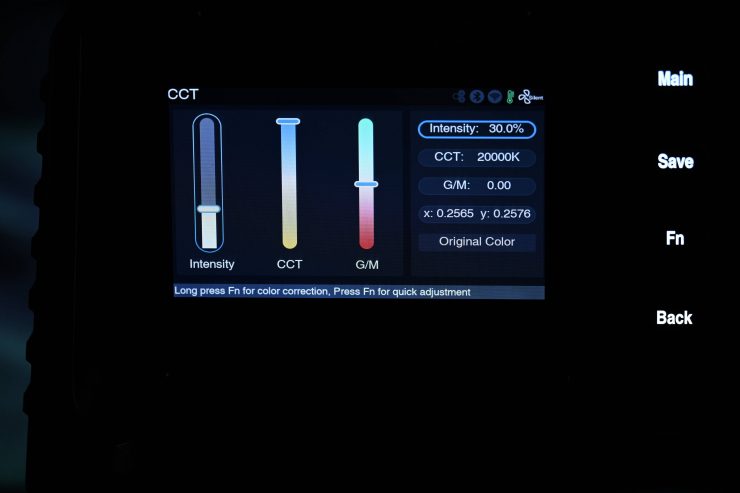
If you choose Silent mode the output is limited to 30%. I measured the output in Silent mode and I will put that information down in the photometric section of the review.
The fan in the Orion 675 FS is very quiet, even when used at 100% output for long periods of time in Auto mode. I didn’t encounter any issues when I needed to record audio close by. In a lot of scenarios, you are unlikely to have a high-powered light like this too close to the talent. The Orion 675 FS is a lot quieter than the Aputure LS 600c Pro, and that alone is a big reason to consider it.
Beam Angle
The Orion 675 FS has the following beam angles:
- 80° (Unmodified)
- 55° (with Wide Beam Reflector)
- 30° (with Medium Beam Reflector)
80° is fairly narrow compared to most other similar high-powered COB fixtures that have beam angles that are around 100-120° when used open face.
I like that Prolycht gives you two different reflectors with the light and it is nice that they also fit inside the optional flight case.
As a comparison, the Aputure LS 600c Pro that comes standard with an LS 600 Series Hyper Reflector has a beam angle of 62° and not 55° like the ones found on the LS 600d/600x Pro. You can also purchase optional BM12°, 15°, 30°, and 45° Hyper Reflectors.
Controls & Menu System
The Orion 675 FS has a nice, large LCD screen that clearly shows you information about the light. While it is not a touchscreen, it is still pretty quick to access all of the available lighting modes and make changes. It is an easy interface to use.
The screen is angled down slightly which does make it easier to see when it s on a light stand, however, if you have the light up reasonably high on a light stand you will need to use the app to control the light.
Again, I like that Prolycht just hasn’t used the same interface as is found on the Orion 300 FS. Redesigning and improving on previous products is what lighting companies should be doing. The design of the interface isn’t a massive departure away from the operating system on the Orion FS 300, so if you have previously used that light you will be right at home.
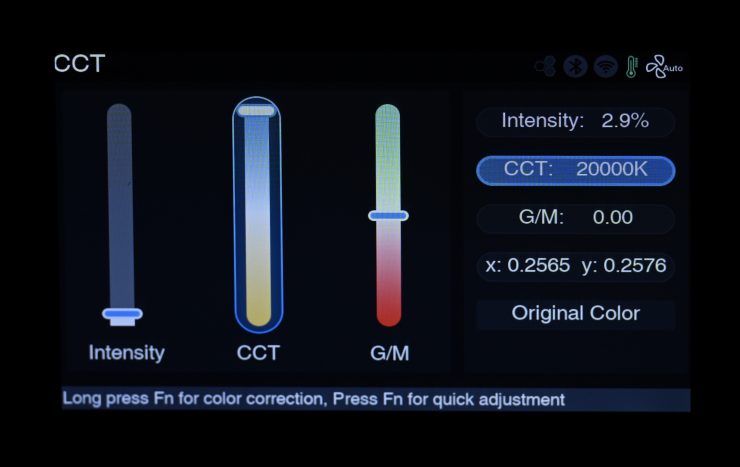
Instead of having two dials like the Orion 300 FS, the 675 FS has one dial. You use this dial to select an item you want to change and then you press on it once. Once you do this the item you have highlighted turns blue and you can make your adjustments.
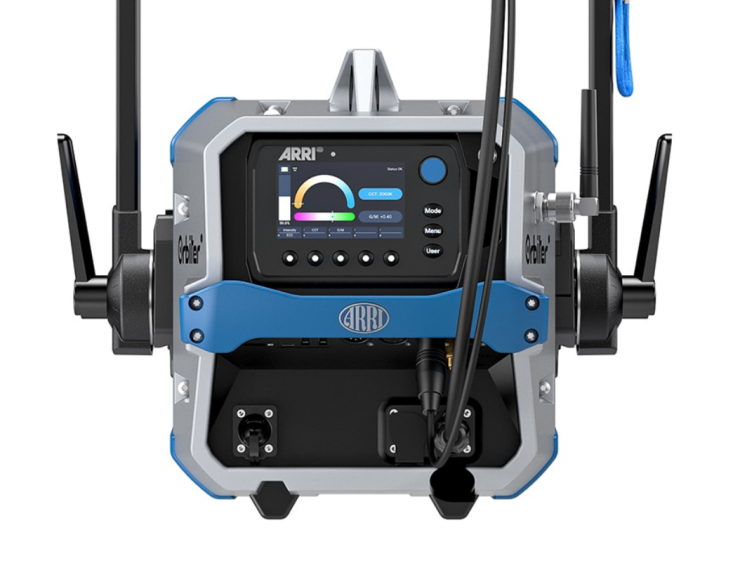
The design and look of the screen clearly take inspiration from the ARRI Orbiter. I guess imitation is the sincerest form of flattery.
With a good light, you shouldn’t have to read a manual to work out how to operate it. You should be able to turn it on and use it straight away. You won’t find any deep sub-menus or complicated way of making changes on the Orion 675 FS. It was designed to be simplistic and easy to operate.
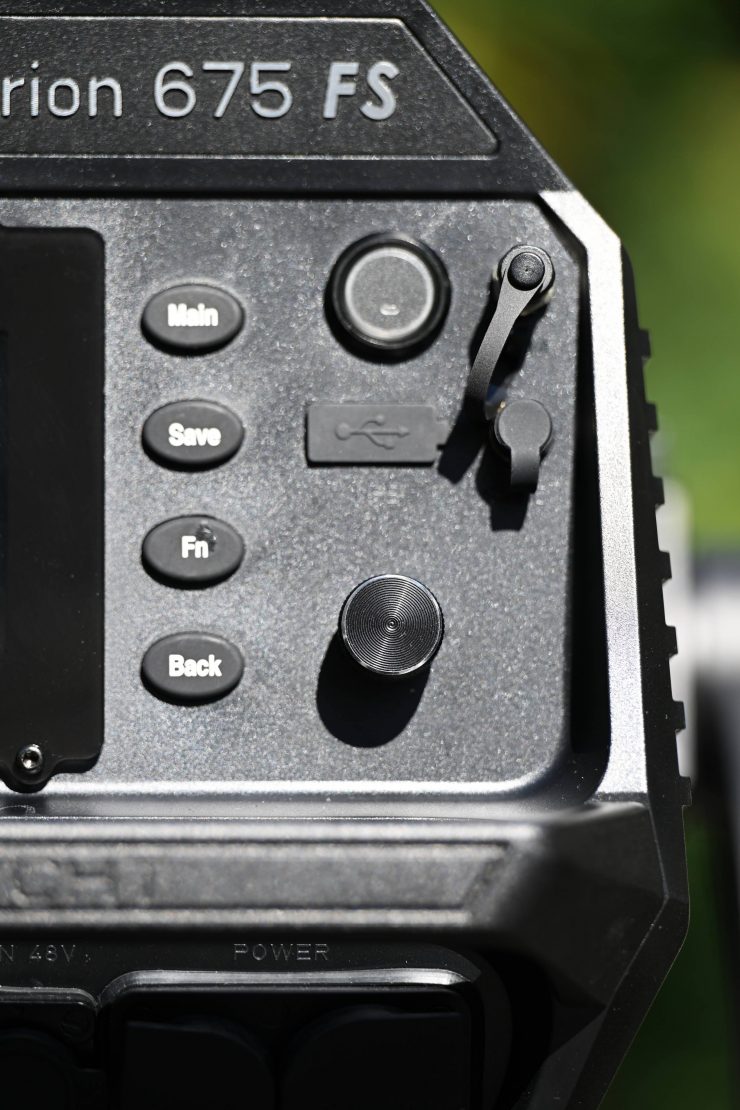
The dial that you use to control the light is very tactile and this allows you to make precise adjustments.
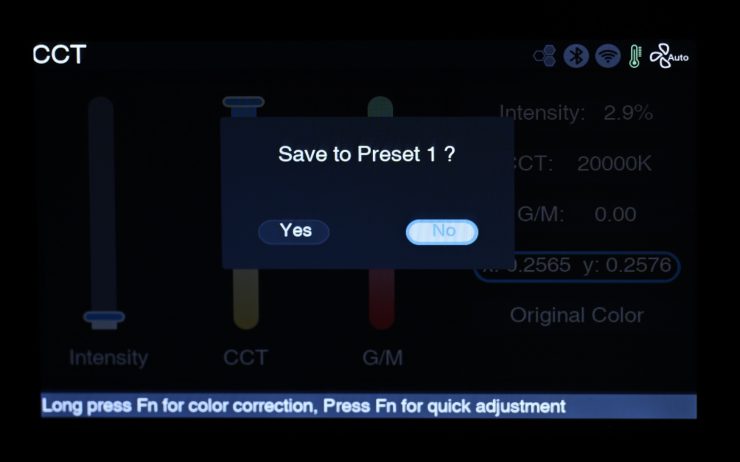
Prolycht has a very easy way to save and recall presets. This is really well implemented and it allows you to jump between saved settings very quickly. All you need to do is to press the Save button on the back of the light and a screen appears asking you if you want to save it to a preset.
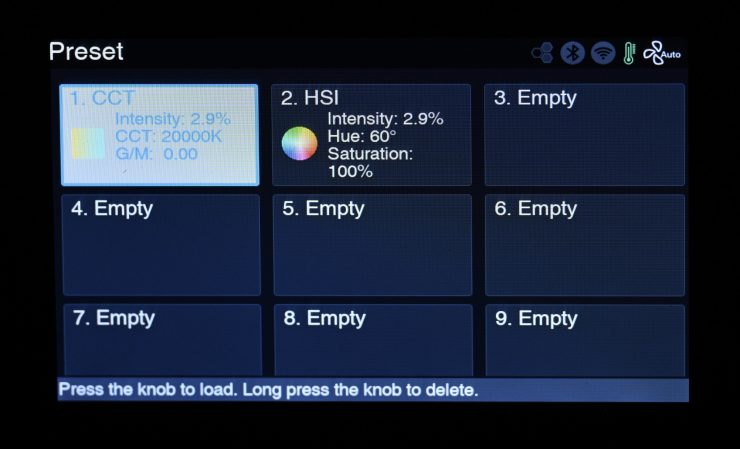
To recall a preset you simply toggle through the menu to Preset and you will see all of your saved settings. What is nice is that each preset tells you exactly what it is so you can recall them quickly and easily. The preset will actually even save the exact intensity you had the light set at. For repeat lighting scenarios this is extremely handy.
The menu also gives you the ability to adjust the dimming curves, and the fan speed, check the operating temperature of the fixture, update firmware, etc.
Operating Modes
The light has 8 key lighting modes:
- CCT
- HSI
- xy
- Gel
- Source Matching
- Fx
- RGBACL
- Calibrated RGBW
Correlated Color Temperature (CCT)
This is the mode most people are going to use the light in. In the CCT Mode, you have full access to making CCT adjustments between 1,800-20,000K.
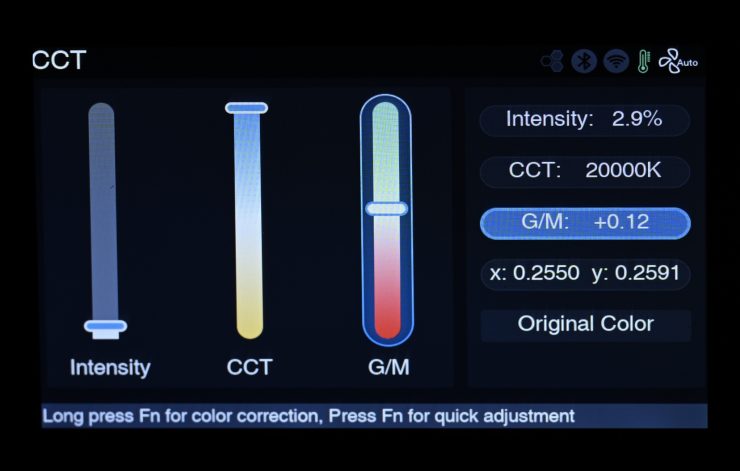
The fixture also has continuous variable (full minus green to full plus green) correction.
Being able to dial in more or reduce the amount of green coming from your lighting source can make a huge difference. Different camera companies use different sensors in their cameras and they all react differently to light. Some camera sensors may lean towards magenta, and some, more towards green. By making CCT adjustments you can dial in the light so that it looks better for whatever camera system you are using. CCT adjustment also helps when you are trying to match lights from different manufacturers.
The CCT range is very impressive and it should suit most people’s needs.
HSI
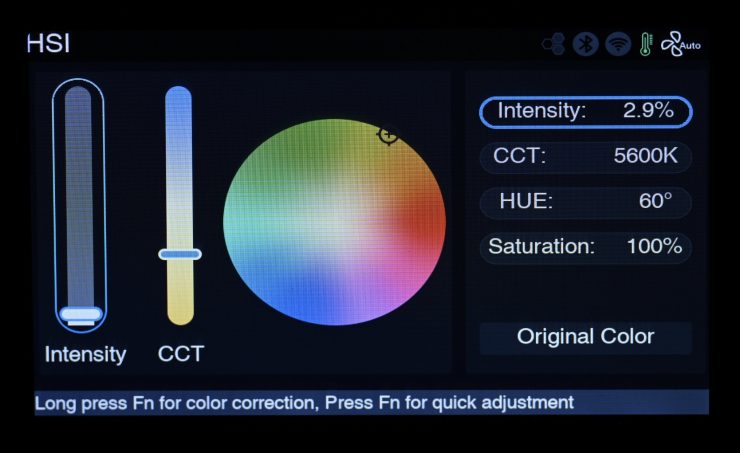
The HSI mode lets you create just about any color you can think of. It gives you full hue and saturation control as well as intensity. By manipulating, the hue and saturation you can create some really interesting colors that depending on the project you are working on can really add some creative flair. I quite like using this mode to create a lot of color separation between the foreground and background, or for recreating a really cold or warm-looking image.
The colors are represented as degrees from 0-360.
Because the interface has really good visual aids it is so much easier to dial in the exact color you want to create. On some lights, you have to use dials with no visual reference.
In HSI mode you can also adjust the CCT.
xy
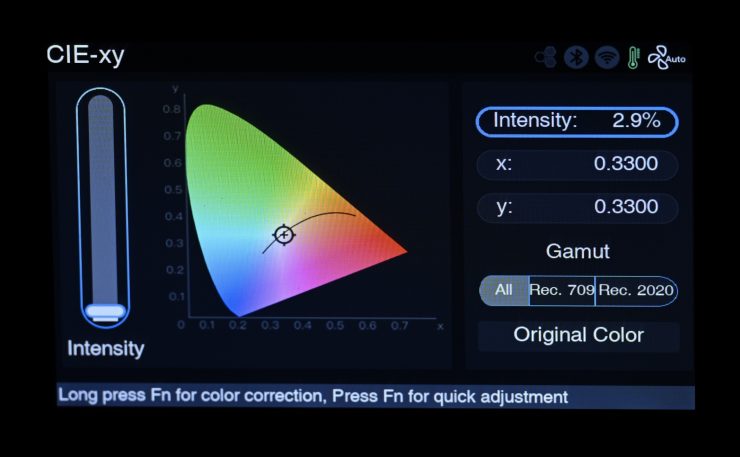
In xy mode, you can dial in exact xy coordinates. You can even change the Gamut from All to Rec.709 or Rec.2020. Dialing in xy coordinates is a fairly easy way to get a light to match other lighting sources, or at least get it in the ballpark.
There are also added x,y coordinate references in other modes so you can easily replicate a color accurately. To do this you move the cursor to the xy coordinates and press the button, you will see the color shown in a CIE-xy 1931 color space. The adjusted colors can be further saved to presets both for color correction and xy correction
Gel
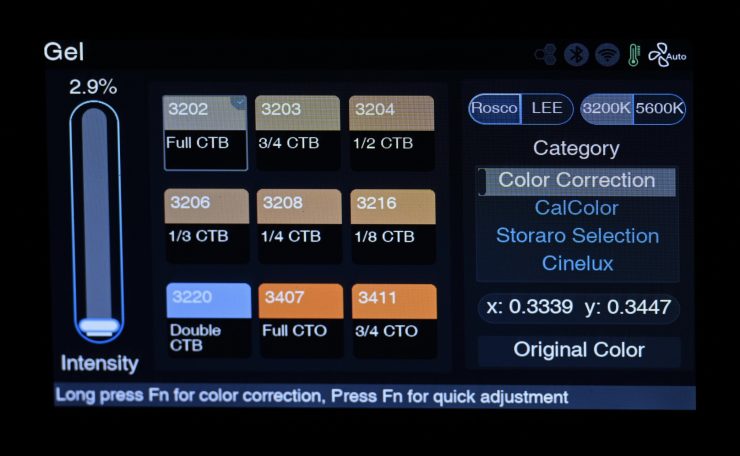
Inside the fixture, there is a huge assortment of industry-standard gels from both Lee and Rosco. In fact, you can choose from 330 Rosco/LEE Gels.
Having built-in Digital Gels not only means that you don’t have to physically carry gels around, but you can also quickly and easily replicate popular gels. Using the gel mode can help you match other lighting sources, especially if you are working with other lights with physical gels.
You can even make adjustments to the preset gels which is very impressive, including using any CCT value you want or dialing in exact xy coordinates. Again, the attention to detail is clear to see.
Source Matching
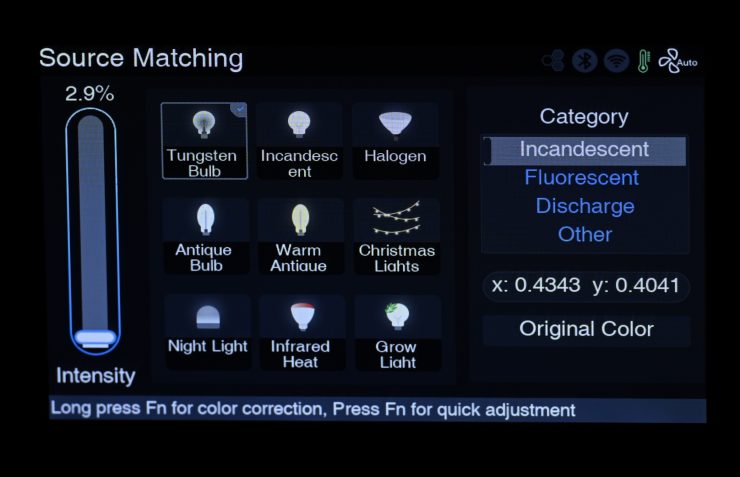
Source mode builds on the Gel mode, and it gives you access to a huge range of pre-mapped lighting sources.
Whether you want to replicate a computer monitor, a green traffic light, a mercury vapor bulb, or a warm antique bulb, this light has you covered.
There are 40 natural/artificial light sources you can choose from. These are incredibly handy when trying to match other ambient lighting sources.
Again, just like in Gel mode, you can make adjustments to the preset gels, including using any CCT value you want or dialing in exact xy coordinates.
Fx
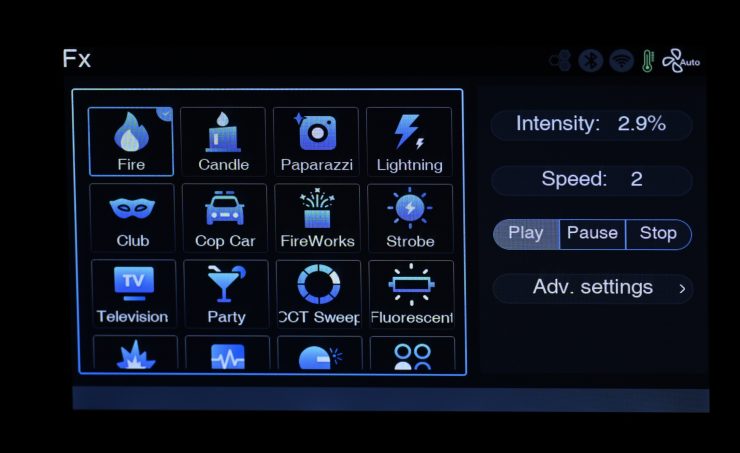
The 6D light engine allows the fixture to deliver a lot of very realistic full-color lighting effects.
Effects mode lets you recreate a wide range of lighting effects that can be handy for certain scenarios. The effects include:
- Fire
- Candle
- Paparazzi
- Lightning
- Club Light
- Cop Car
- Fireworks
- Light Strobe
- Television
- Party
- Skin Tone
- CCT Sweep
- Fluorescent Flicker
- Explosion
- Pulsing
- Welding
- Color Chase
- Clouds Passing
- Breathing
All the effects modes can be individually adjusted and tailored to your lighting needs.
RGBACL
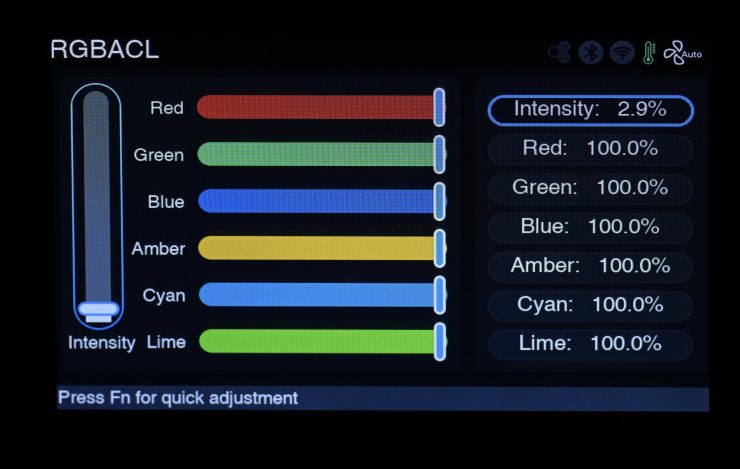
In this mode, you can individually adjust the colors of the 6 LEDs being used by the Orion 675 FS.
Calibrated RGBW
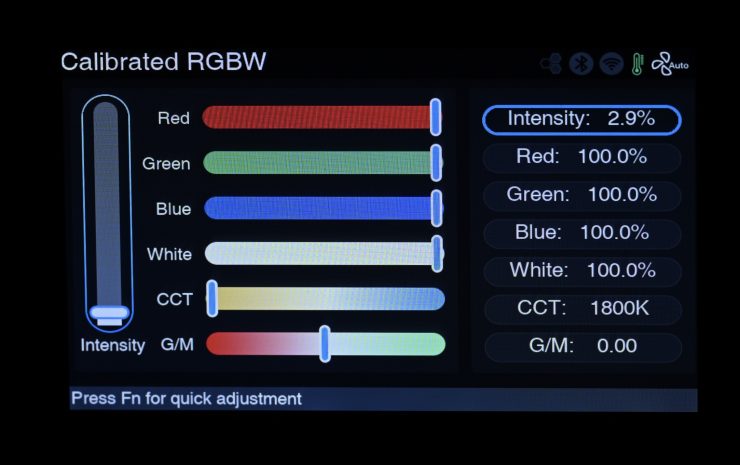
You might be thinking what on earth is a Calibrated RGBW mode? Well, I will tell you.
For many traditional control board applications, the colors are in the format of RGB or RGBW. In virtual productions, people have requested that they would like the ability to directly feed an RGB video signal into a light. This works well with many stage lights since they are RGB or RGBW lights, however, an RGBACL light doesn’t have a physical white channel, because the extra ACL channels are not directly called RGB signals. So to overcome this Prolycht has come up with a Calibrated RGBW mode, where they calibrate the Orion 675 FS to emit the same color that an RGB or RGBW signal is expecting. They do this by matching the same color coordinates of different RGB or RGBW inputs while using all of the six RGBACL channels. As a result, the spectra are richer than traditional RGBW sources while maintaining the same color coordinates.
In the Calibrated RGBW mode you will find six color parameters: R, G, B, W, CCT, and G/M. The RGB channels are for the direct input of RGB signals. When they are all 100% (i.e. full RGB), they will emit a white light whose CCT and G/M are defined by the CCT and G/M, channel. The W channel is optional, as this is for adding more whites to create a certain RGB combination. The color of the W channel is also defined by CCT and G/M channels. In the DMX control, you can adjust the weighting of RGB vs. W via a separate Crossfade channel.
These features were developed during Prolycht’s communication with customers who previously used the Orion 300 FS, especially those who feed video RGB signals via MadMapper and expect the same color as in the display. Prolycht is now developing a Rec.709 DMX mode which further calibrates the colors to be consistent with the Rec.709 gamut, which will be available in the near future.
Bluetooth App
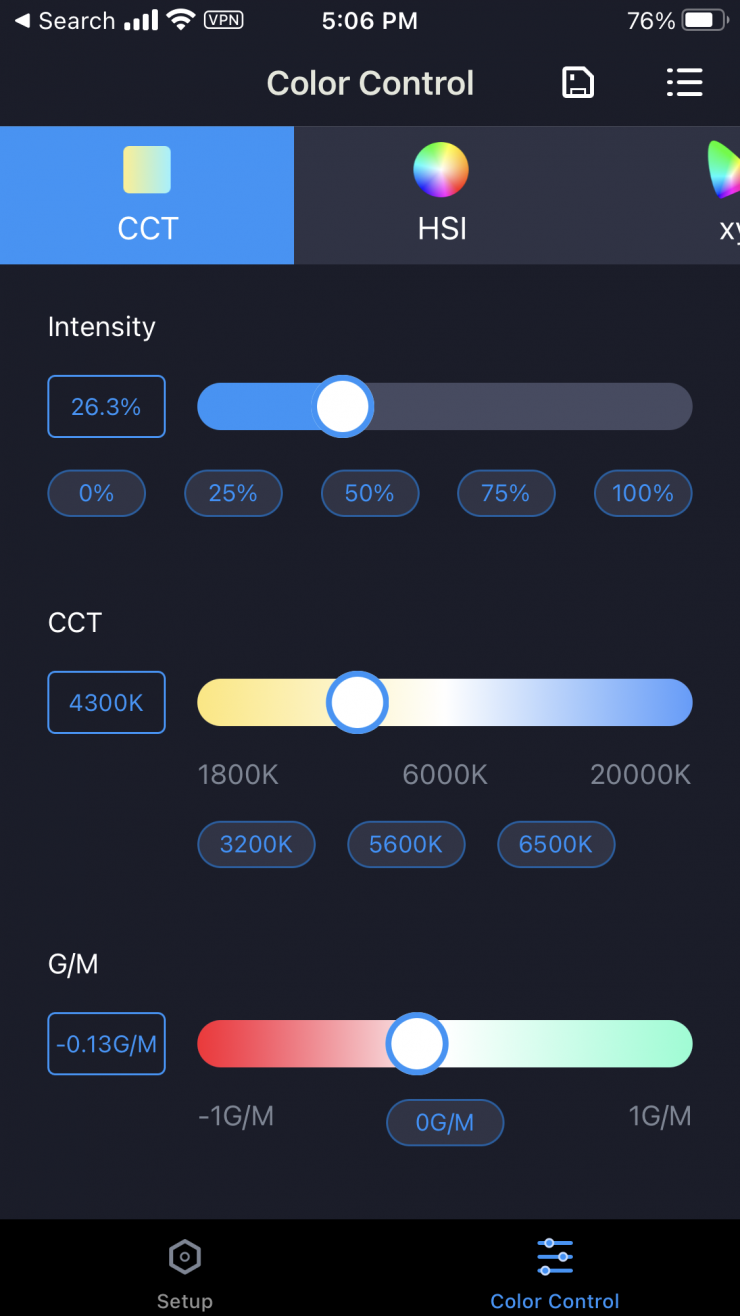
The light can be controlled via Bluetooth using the Chromalink App.
There is a range of parameters that you can adjust using the Chroma Link app. Essentially, it replicates the controls on the back of the Orion 675 FS.
I also like that you can save favorites and then also bring them back up very quickly.
The color picker function can only be accessed and utilized within the app. This allows you to use your camera to capture certain colors that the Orion 675 FS will then attempt to replicate. Prolycht even gives you the added ability to alter the colors that you have selected.
What is also nice is that Prolycht gives you the ability to do real-time tracking. Essentially, this gives you the ability to use your phone to capture a scene and the light will mimic it in real-time.
The app is straightforward and easy to use. I like how they have made it intuitive and visually appealing. Lighting control shouldn’t be overly complicated.
It is certainly one of the better lighting control apps I have seen or used.
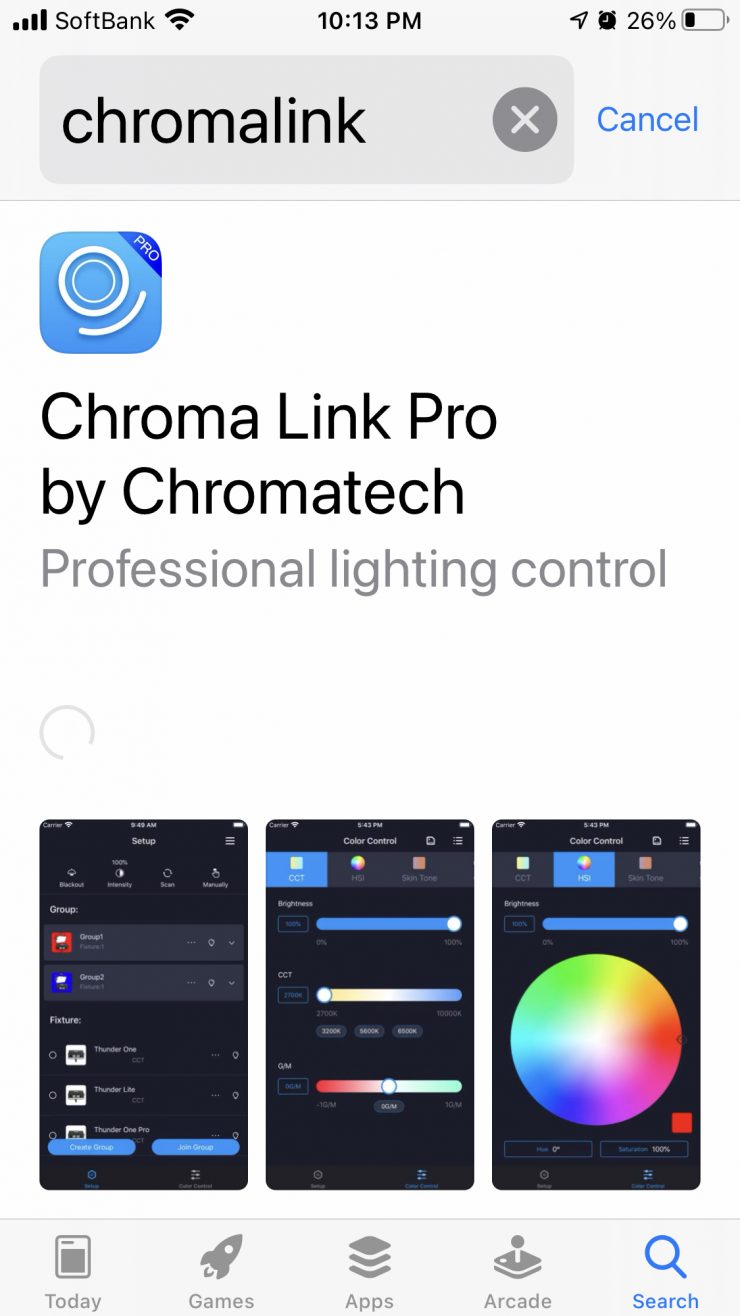
If you need further control and you want to adjust multiple Prolycht fixtures as well as other lighting fixtures from a wide array of companies you need the Chroma Link Pro app as well as an ArtNet system.
Connectivity
The fixture can communicate using DMX, LumenRadio CRMX wireless control, Ethernet / Art-Net, Bluetooth Mesh, and Wifi.
The Orion 675 FS has the following connectivity on the back of the fixture:
- powerCON TRUE1 TOP AC input
- 3-Pin XLR Connector (Pin 1: Negative, Pin 2: Positive) for a battery connector
- 5-Pin DMX in/out (27 DMX modes)
- LAN port with Built-in Art-Net
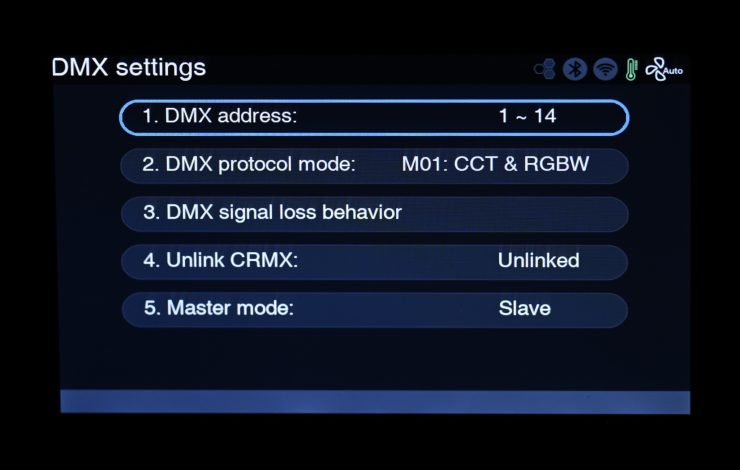
Above you can see the DMX settings menu.
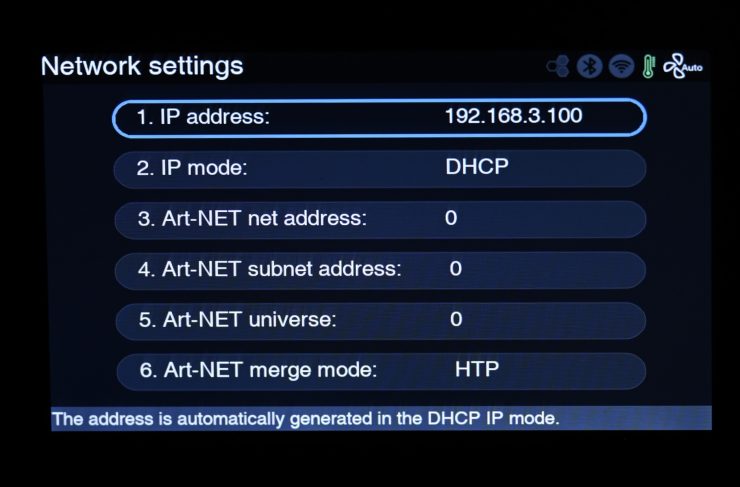
Above you can see the Network Settings menu page.
Fresnel
The optional Fresnel Kit is beautifully made and designed. It is also extremely compact as far as Fresnels go for lights of the size.
It utilizes a 10″ Fresnel lens and it has a 15 to 50° flood-spot adjustment. Above you can see how easy it is to attach and use the Orion 675 FS.
The Fresnel weighs 2.6kg / 5.73 lb.
In its included case with the barndoors it weighs 7.2kg / 15.87 lb.
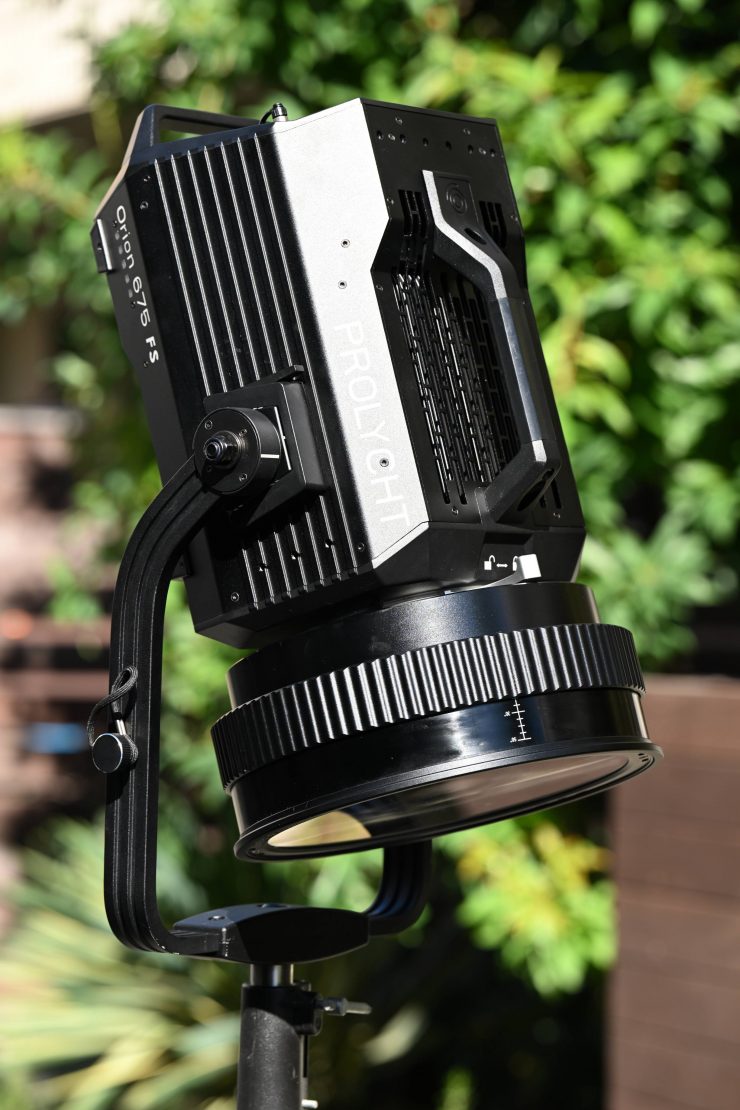
Because of the compact design of the Fresnel, you can angle it straight down without anything hitting the yoke frame.
The Fresnel Kit also includes a nice set of barndoors.
Above you can see how these attach to the Orion 675 FS.
I will show you how the barndoors actually perform later in the review.
How does the Prolycht Orion 675 FS compare to the Aputure LS 600c Pro?
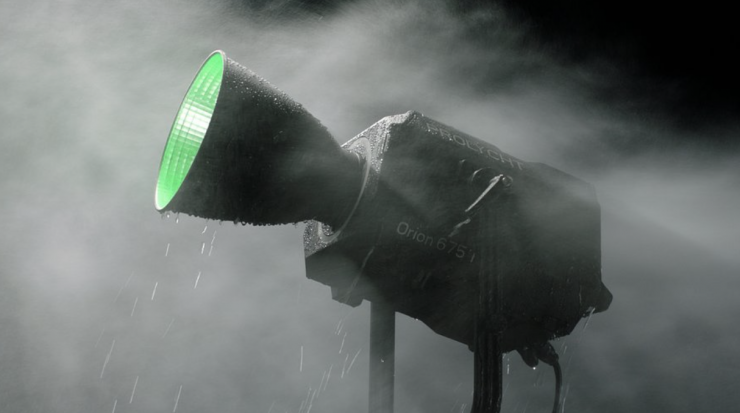
Comparing products based on specification sheets never tells you the full story. Below you can see how they compare on paper, but I will let you give you my honest opinion at the end of this review after we have looked at all of the data and the various feature sets, etc.
| Prolycht Orion 675 FS | Aputure LS 600c Pro | |
| CCT Range | 1800-20,000K | 2300-10,000K |
| +/- GM | Yes | Yes |
| HSI | Yes | Yes |
| Gels | Yes | Yes |
| Source Mode | Yes | Yes |
| Effects | Yes | Yes |
| Mount | Prolycht Prolock Bowens-S Mount | Bowens-S Mount |
| Power Draw | 675W | 720W |
| App Control | Yes | Yes |
| Battery Plate | No | Yes, 2x V-Lock (or AB Gold Mount) |
| Weight | 26 lb / 12kg | 24.4 lb / 11.07 kg |
On paper, there is not a huge difference between the two fixtures in terms of the feature set, power, physical size, and weight.
Photometrics
So now let’s get to the photometric results. I always test lights in this way so that I get a reference to how they compare to other fixtures. Results only tell part of the story and should never be used alone to judge a light. I have found from extensive testing over the years that certain lights that have good photometric results don’t always look good, and lights that have worse photometric scores can sometimes look better than their results indicate.
You can’t judge a light from one set of photometric results. You have to look at all of the different results to be able to come to a conclusion. Judging alight on one set of results is like reading one chapter in a book and thinking you know the whole story.
Different lights can also look different depending on what camera you happen to be using.
I have also included data from the Aputure LS 600c Pro so you can see how the Orion 675 FS compares.
Output & Color Temperature Accuracy
I tested the Prolycht Orion 675 FS at a variety of CCT settings with a Sekonic C-800 Spectrometer to find out how much output the light had and how accurate the CCT reproduction was. All readings are taken at a distance of 1m (3.28ft) in a controlled environment. The readings were all taken directly from the lighting source. In the case of using the light with a Reflector or Fresnel, the readings were taken from the edge of those attachments. This is how I test all lights.
Prolycht claims that the Orion 675 FS is significantly brighter than a 1200W HMI fixture. In fact, they go as far as to claim that it is currently the most powerful fully color-tunable spotlight in the world. That isn’t necessarily a big claim to make as there aren’t actually that many high-powered fully color-tunable spotlights on the market.
Prolychyt goes on to claim that at 3200K the Orion 675 FS is equal in output to a classic 5000W tungsten fixture. They also state that compared to LED spotlights, the Orion 675 FS is brighter than a 600W daylight-only light and is three times brighter than any other manufacturer’s RGBACL spotlight.
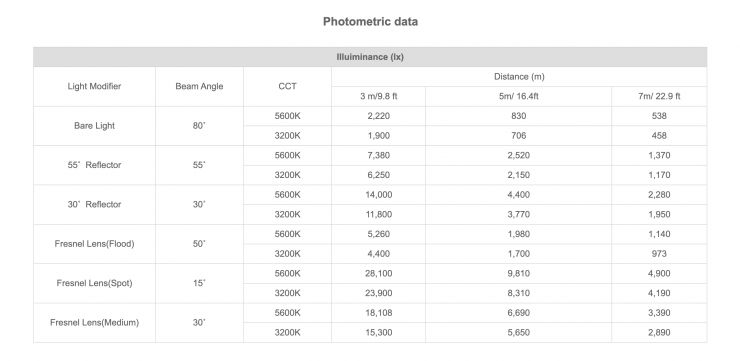
Above you can see Prolycht’s published claimed outputs for the Orion 675 FS.
So just how much output does it have and how does that compare to other high-power spotlights on the market? Well, let’s find out.
Prolycht Orion 675 FS 5600K (open face)
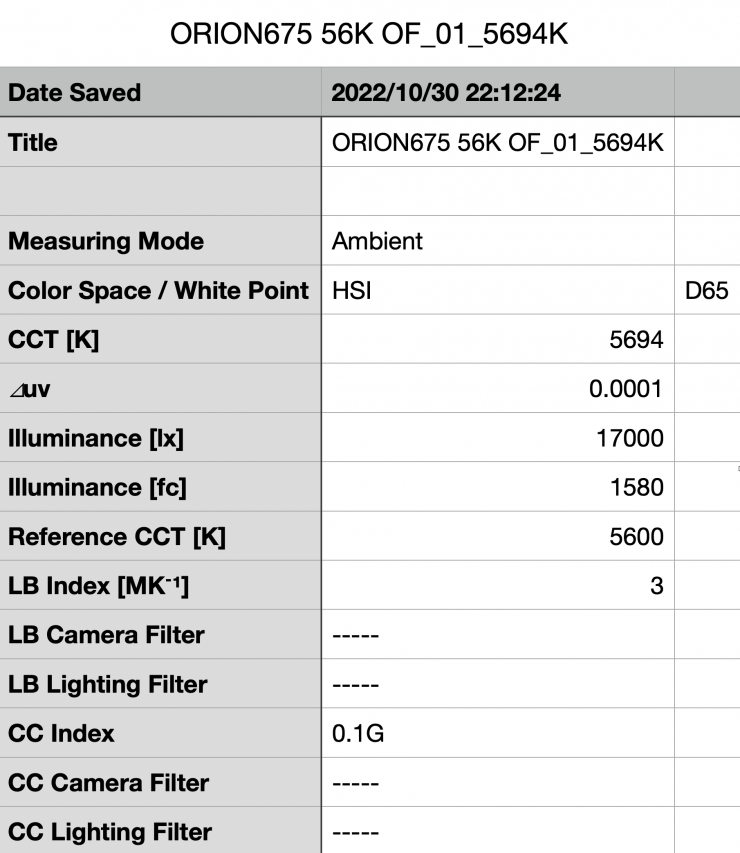
Above you can see the Orion 675 FS recorded an output of 17000 lx (1580 fc) when set at 5600K and used open face.
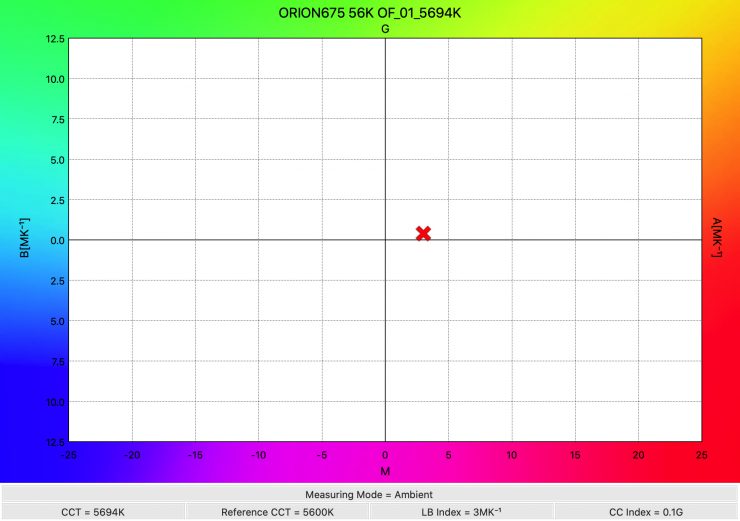
The light recorded a CCT reading of 5694K which was very accurate for a high-powered spotlight.
Aputure LS 600c Pro 5600K (open face)
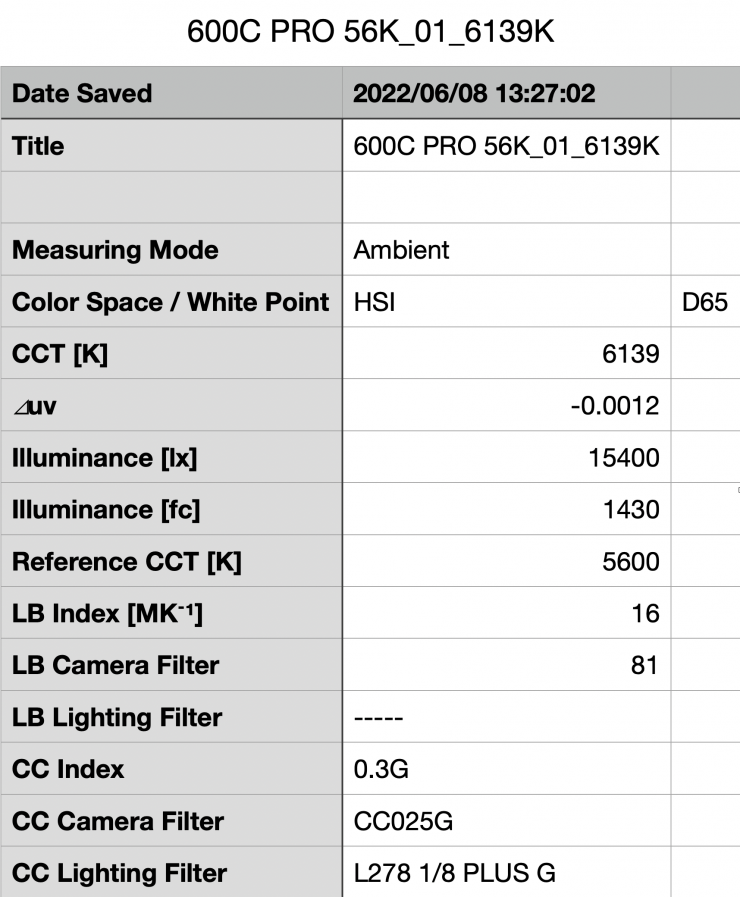
Above you can see the Aputure LS 600c Pro recorded an output of 15,400 lx (1430 fc) when set at 5600K and used open face. Please note that these tests were done in the max. output mode. What you need to take into account is that the Aputure has a wider beam angle (listed as being 92 degrees) when used open face, while the Prolycht is 80 degrees. From my testing, I think that the beam angle of the Aputure is wider than what they list in their specifications.
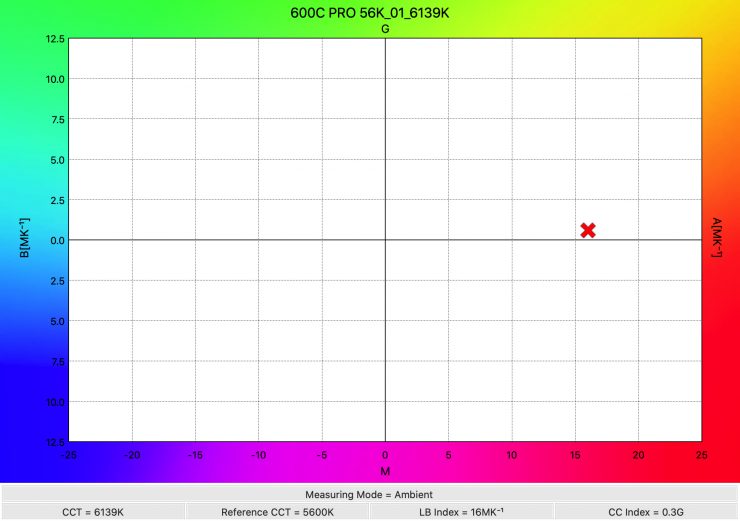
The light recorded a CCT reading of 6134K which was more than 500K off being correct.
Prolycht Orion 675 FS 3200K (open face)
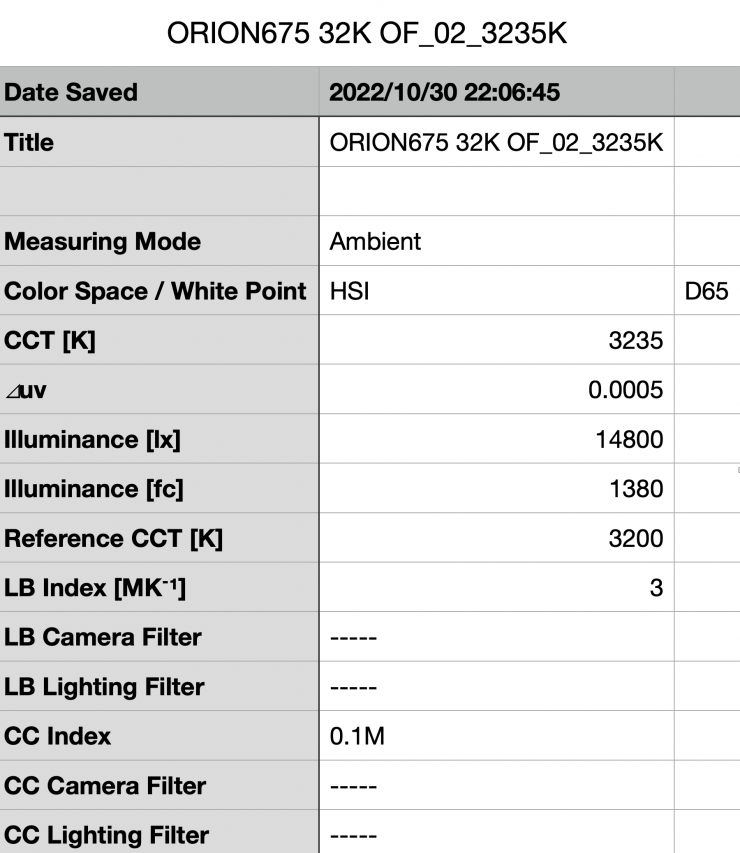
Above you can see the light’s output when it was set at 3200K in the open face configuration was 14800 lx (1380 fc), which is 12.9% less than the 17000 lx it produced at 5600K.
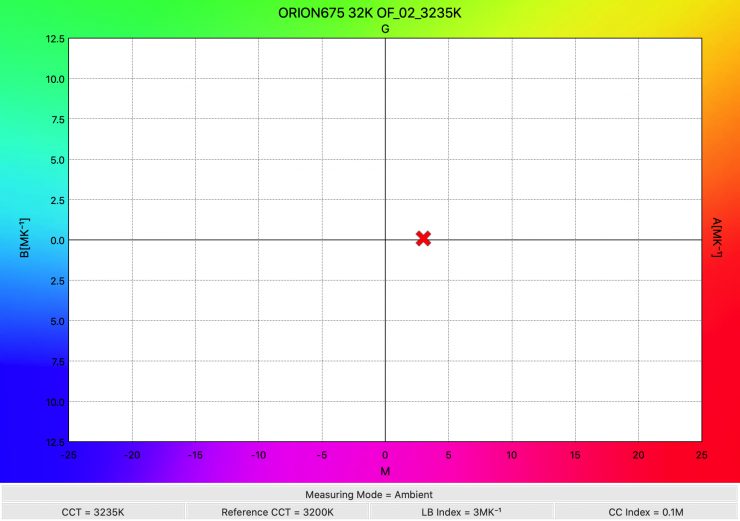
As far as CCT accuracy goes, it recorded a very accurate reading of 3235K.
Aputure LS 600c Pro 3200K (open face)
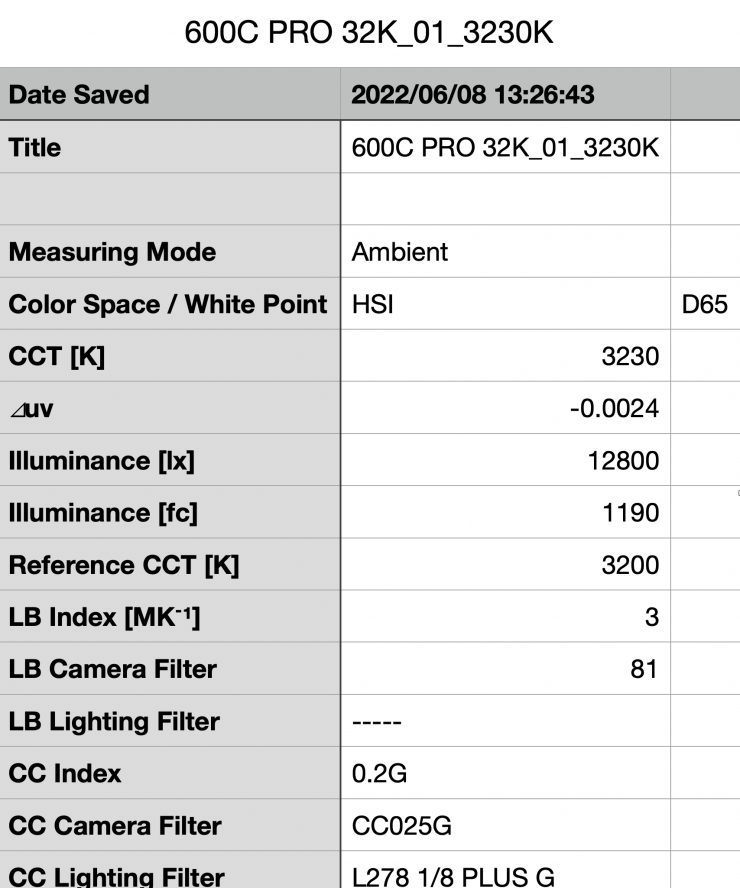
Above you can see the light’s output when it was set at 3200K in the open face configuration was 12800 lx (1190 fc), which is 16.88% less than the 15400 lx it produced at 5600K. Please note that these tests were done in the max. output mode. Aputure lists a figure of 13,250 lx, so the result I got was fairly close to their claimed figure.
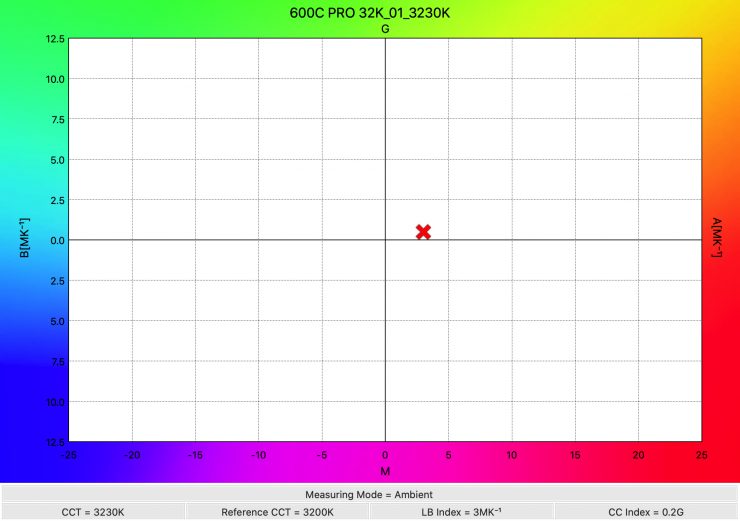
As far as CCT accuracy goes, it recorded a very accurate reading of 3230K.
Wide Beam Reflector 55°
So, now let’s see how much output the light has when used with its wide beam 55° reflector.
Prolycht Orion 675 FS 5600K (Wide reflector 55°)
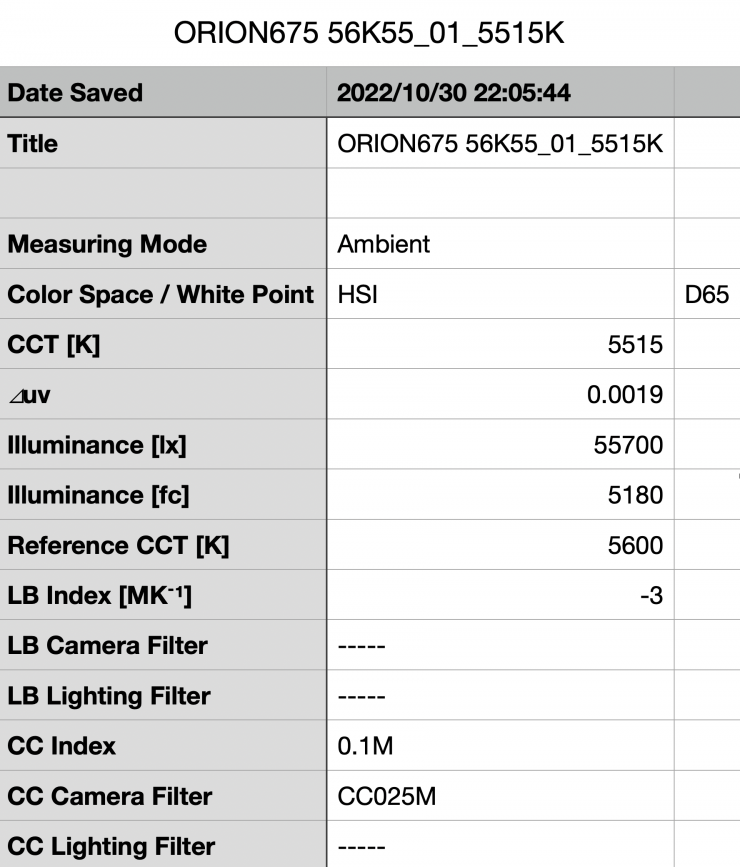
Above you can see the light’s output when it was set at 5600K with the wide reflector was 55700 lx (5180 fc). This was 227.6% more than the 17000 lx it produced at 5600K when used open face. It is important to note that this measurement was made from the edge of the reflector.
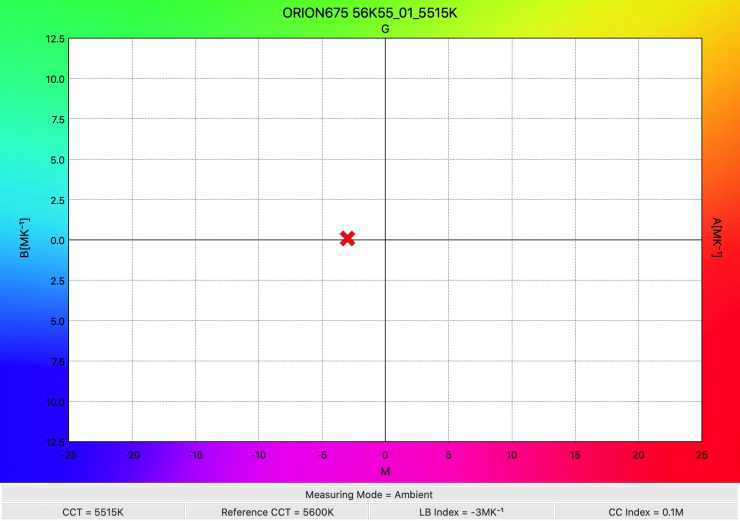
As far as CCT accuracy goes, it recorded a reasonably accurate reading of 5515K. The CCT accuracy when using the wide reflector wasn’t as good as when the light is used open face.
Aputure LS 600c Pro 5600K (Hyper reflector 62°)
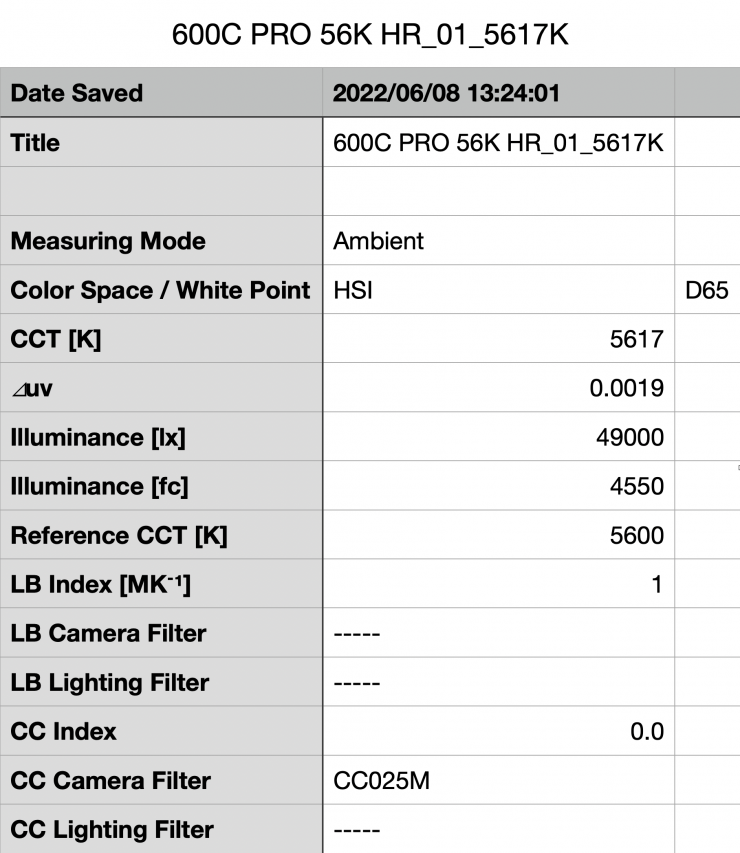
Above you can see the Aputure’s output when it was set at 5600K with the Hyper reflector was 49000 lx (4550 fc). This was 218.2% more than the 15400 lx it produced at 5600K when used open face. It is important to note that this measurement was made from the edge of the reflector. Aputure claims an output of 49995 lx on its website, so my result was very close to that figure.
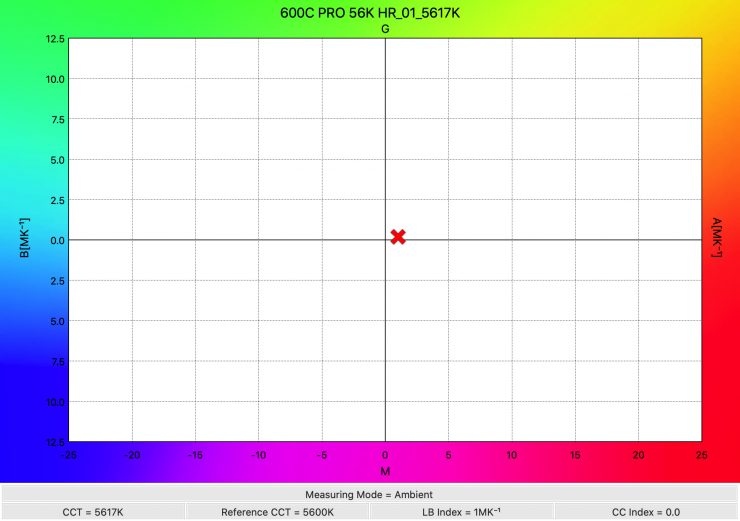
As far as CCT accuracy goes, it recorded a very accurate reading of 5616K. The CCT accuracy when using the Hyper reflector was a lot better than when the light is used open face. In some ways, this is a little odd, because you would expect with a light like this that it would be optimized more for open-face use.
Prolycht Orion 675 FS 3200K (Wide reflector 55°)
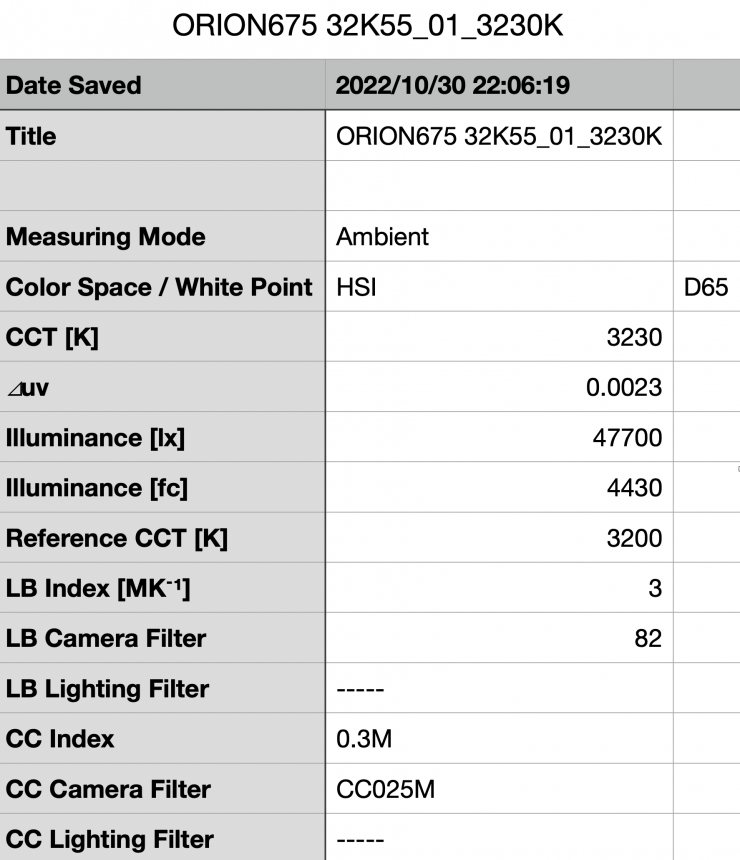
Above you can see the light’s output when it was set at 3200K with the wide reflector was 47700 lx (4430 fc), which was 14.36% less than what it output at 5600K.
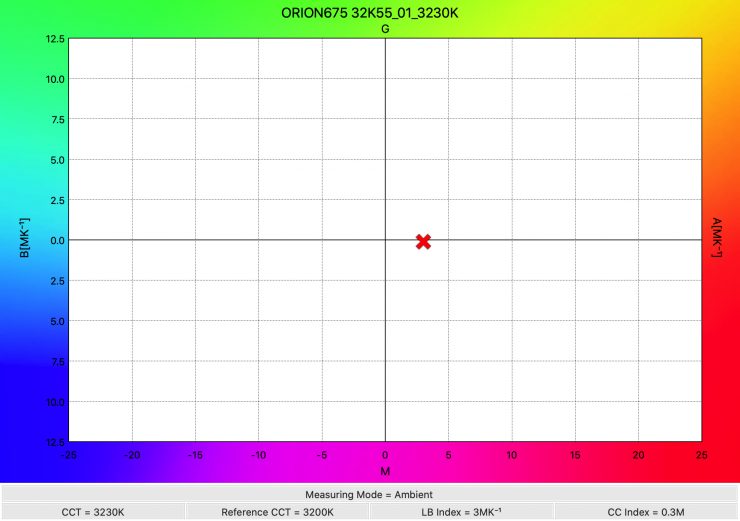
As far as CCT accuracy goes, it recorded a very good reading of 3230K, which was almost identical to the figure when used open face.
Aputure LS 600c Pro 3200K (Hyper reflector 62°)
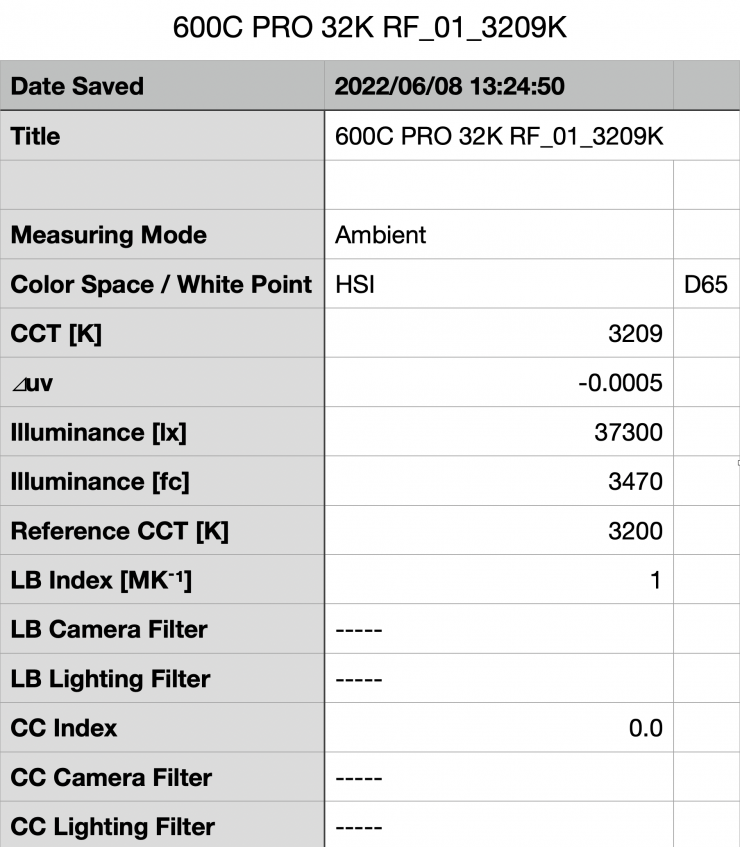
Above you can see the light’s output when it was set at 3200K with the standard reflector was 37,300 lx (3470 fc), which was 23.87% less than what it output at 5600K. Aputure quotes a figure of 38,600 lx on their website, so my result was pretty close to the claimed amount.
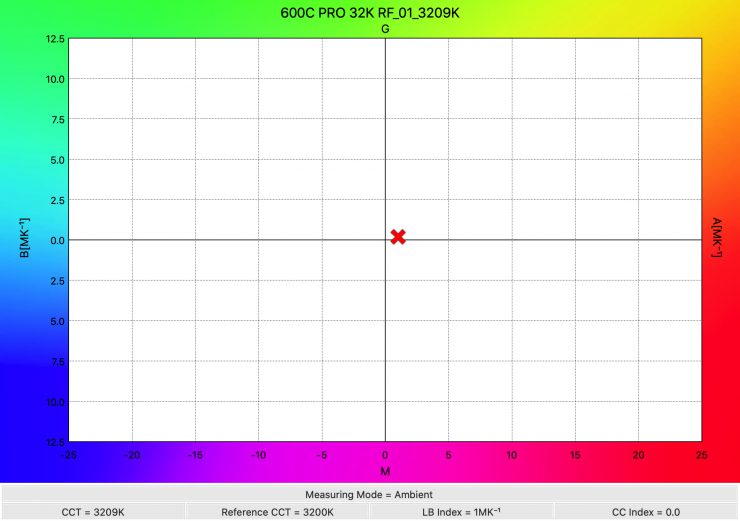
As far as CCT accuracy goes, it recorded an exceptionally good reading of 3209K which was a very good score. It is a little strange that the CCT accuracy when using the light at 3200K with and without the Hyper Reflector is almost identical, yet, there is a large discrepancy when using the light at 5600K. However, in saying that, this was also the case with the Prolycht.
So let’s look at the head-to-head data between the Prolycht Orion 675 FS and the Aputure LS 600c Pro. As I have now tested both fixtures I can provide you with independent figures.
Open Face
| Output at 5600K | CCT (K) | |
| Aputure LS 600c Pro | 15,400 lx (Open Face) | 6139K |
| Prolycht Orion 675 FS | 17,000 lx (Open Face) | 5694K |
| Output at 3200K | CCT (K) | |
| Aputure LS 600c Pro | 12,800 lx (Open Face) | 3230K |
| Prolycht Orion 675 FS | 14,800 lx Open Face) | 3235K |
Reflectors
| Output at 5600K | CCT (K) | |
| Aputure LS 600c Pro | 49,000 lx (Hyper reflector 62°) | 5617K |
| Prolycht Orion 675 FS | 55,700 lx (wide reflector 55°) | 5515K |
| Output at 3200K | CCT (K) | |
| Aputure LS 600c Pro | 37,300 lx (Hyper reflector 62°) | 3209K |
| Prolycht Orion 675 FS | 47,700 lx (wide reflector 55°) | 3230K |
These lights were tested under the exact same conditions so you get a real-world, honest assessment of how the lights compare when used open face and when used with reflectors that have a similar beam angle. Now, you need to factor in that the power draws are different, and when used open face, the Orion 675 FS has a narrower 80° beam angle compared to the Aputure.
If you want to see how it compares to other similar COB fixtures when used at 5600K, below you can see:
| OUTPUT | |
| Aputure LS 600c Pro (62°) | 49,000 lx* |
| Prolycht Orion 675 FS (55°) | 55,700 lx* |
| ARRI Orbiter (60° Optic) | 18,800 lx* |
| Aputure LS 600x Pro (55°) | 68,400 lx* |
| Aputure LS 600d Pro (55°) | 97,100 lx* |
| Nanlite Forza 720 (55°) | 91,800 lx** |
| Nanlite Forza 720B (55°) | 73,000 lx* |
* Independently tested
** Not tested (claimed output)
Output using 30° Medium Reflector
So now let’s look at how much output the Prolycht Orion 675 FS puts out when using the 30° Medium Reflector.
5600K
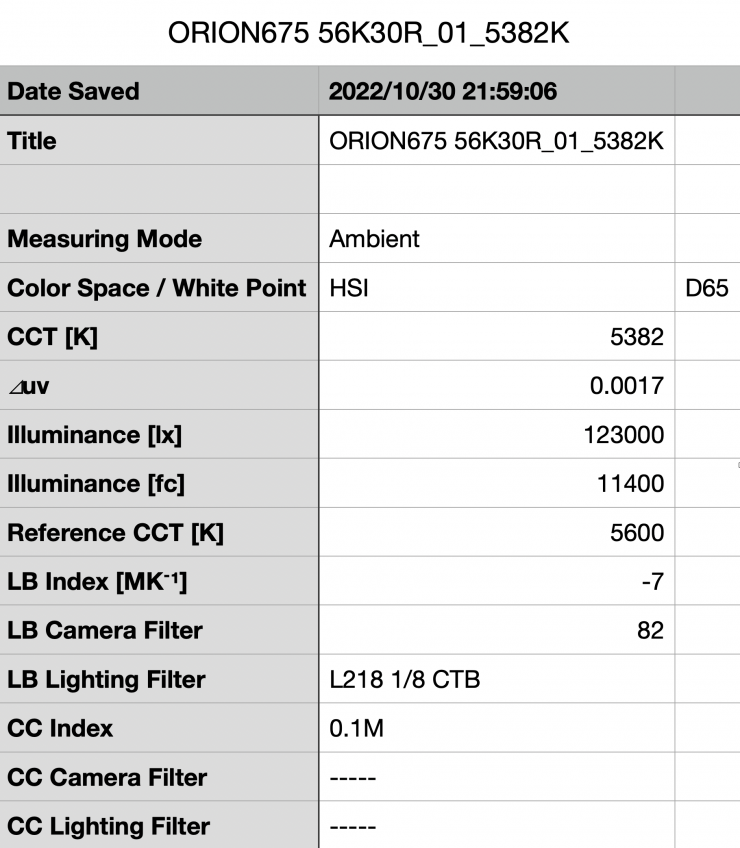
Above you can see the light’s output when it was set at 5600K with the Medium reflector was 123000 lx (11400 fc), which was 120.82% more than the 55700lx output at 5600K using the Wide reflector.
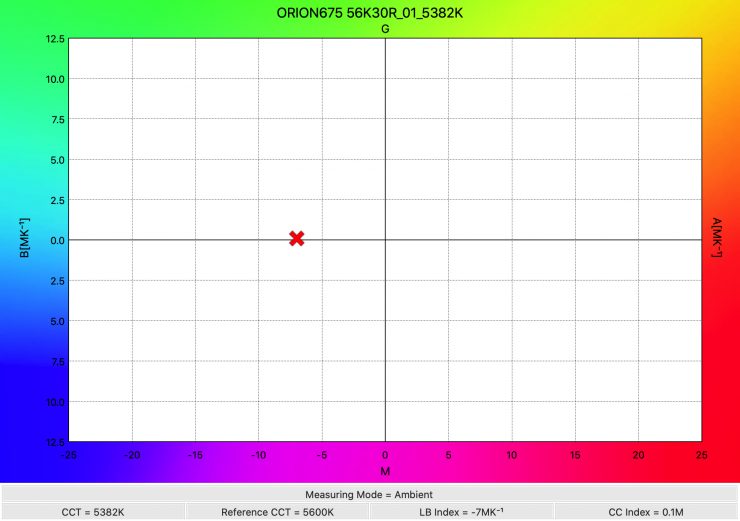
As far as CCT accuracy goes, it recorded a reading of 5382K, which was a lot worse than the 5515K it recorded when used with the Wide reflector. This tells me that the Medium reflector is altering the CCT.
3200K
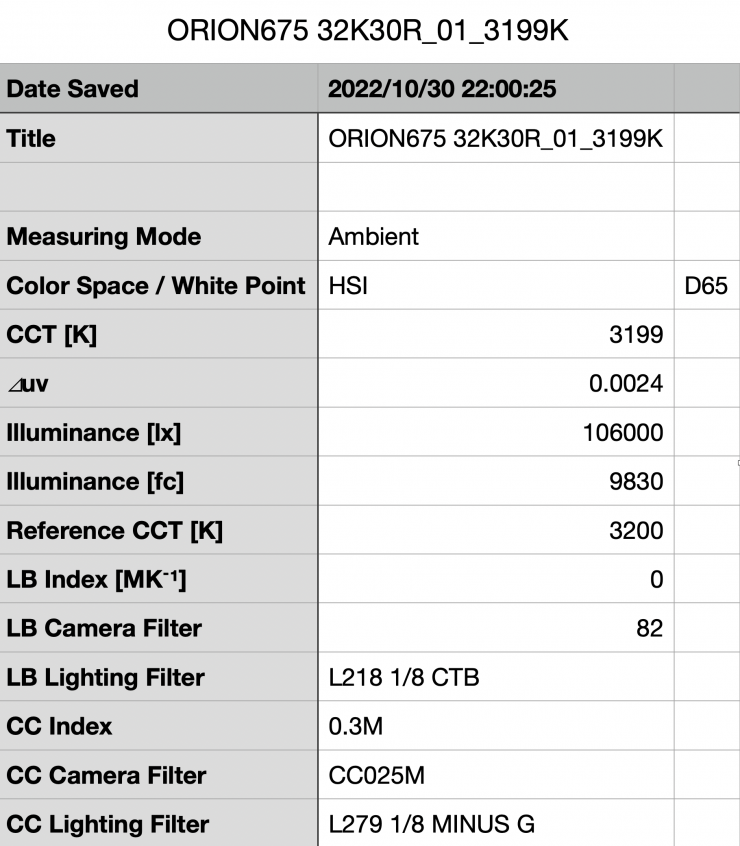
Above you can see the light’s output when it was set at 3200K with the Medium reflector was 106000 lx (9830 fc), which was 122.22% more than the 47700lx it output at 3200K using the Wide reflector.
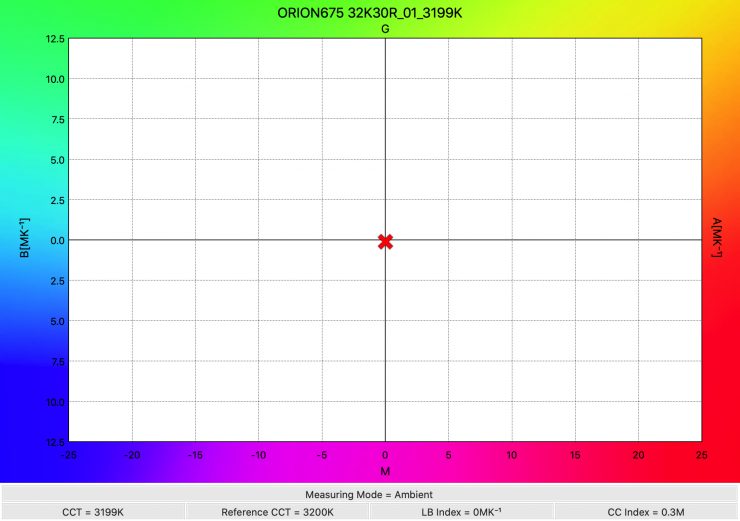
As far as CCT accuracy goes, it recorded an almost perfect reading of 3199K, This tells me that the Medium reflector provides far better CCT accuracy when you use the light at 3200K, as opposed to 5600K.
Output when using the 30° Medium reflector with the fan set to Silent Mode
As I mentioned earlier in the review, you can operate the Orion 675 FS without the fan, but the output is limited to 30%.
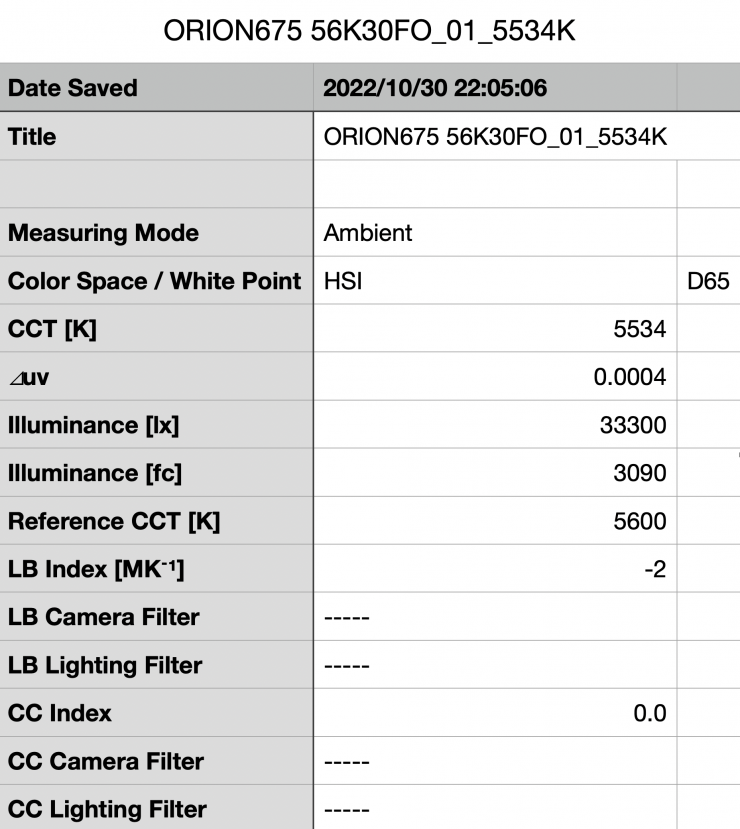
Above you can see the light’s output when it was set at 5600K with the Medium reflector and the fan set to Silent mode was 33300 lx (3090 fc). This is still a ton of output and it essentially means that you can run the light with zero fan noise if need be and still have enough output for a lot of scenarios.
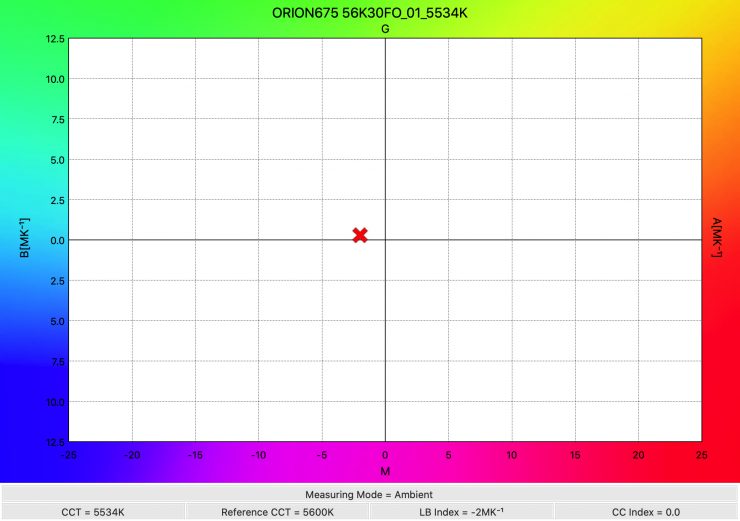
As far as CCT accuracy goes, it recorded a reading of 5534K. This tells me that the CCT accuracy when you use the light at 30% was better than when it was set at 100%.
How does it perform at various CCT Settings?
Summary of results (30° Medium reflector)
| SETTING | OUTPUT | CCT READING |
| 2500K | 87,300 lx | 2535K |
| 3200K | 106,000 lx | 3199K |
| 4500K | 115,000 lx | 4490K |
| 5600K | 123,000 lx | 5382K |
| 6500K | 109,000 lx | 6295K |
| 8000K | 109,000 lx | 7613K |
| 10000K | 104,000 lx | 9859K |
These results show me that the light’s output varies by 40.89% depending on what CCT temperature you are using. This is a pretty large difference that you need to be aware of.
The CCT accuracy across the range is exceptionally good from 2500K to 4500K. However, above 4500K it starts to fall off and the results weren’t nearly as good.
CCT consistency & linear output when dimming the light
Now, what you should always do when testing lights is to see if the CCT remains consistent when dimming the light. Just because you set a light at say 5600K, that doesn’t mean that the CCT will remain stable as you start dimming the fixture down. I also wanted to see how linear the dimming curve was.
I decided to do a series of tests at 100%/75%/50%/25%10% to see if the CCT being recorded changed. This was done at a distance of 1m using a Sekonic C-800. These tests were done at 5600K with the 30° Medium reflector and the light set in its Linear dimming mode.
| CCT READING | OUTPUT | INTENSITY % |
| 5382K | 123,000 lx | 100 |
| 5599K | 84,900 lx | 75 |
| 5571K | 64,700 lx | 50 |
| 5307K | 32,400 lx | 25 |
| 5594K | 12,300 lx | 10 |
The Orion 675 FS had very strange CCT consistency as you start dimming the fixture. My testing showed that the CCT readings varied by 292K. These were puzzling results and the CCT readings were going up and down. At 75% and 10%, it had almost perfect CCT readings, but at other levels, it seemed to be all over the place.
As far as how linear the output is when you start dimming the light, at 50% output it had 47.89% less output than when used at 100%. At 25% it had 73.65% less output than when used at 100%. At 10% output, it had 90% less output than when used at 100%. This shows me that the light’s dimming curve is very linear.
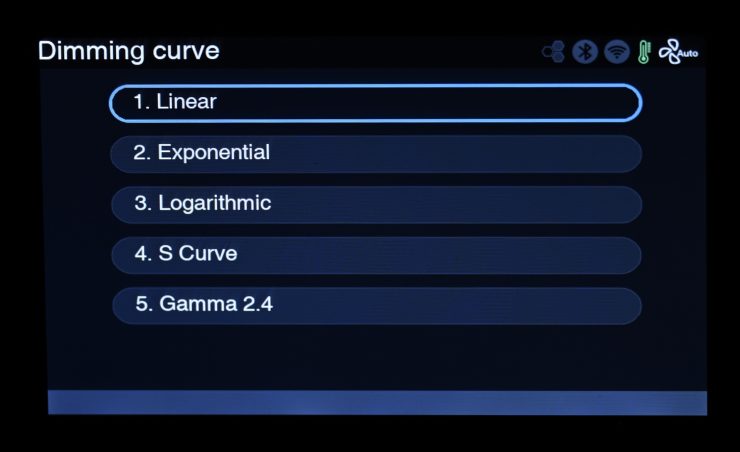
Above you can see the various dimming curve options that are available.
| CCT READING | OUTPUT | INTENSITY % |
| 5617K | 49,000 lx | 100 |
| 5708K | 31,800 lx | 75 |
| 5701K | 21,500 lx | 50 |
| 5660K | 11,100 lx | 25 |
| 5614K | 5,130 lx | 10 |
As a comparison, above you can see the results for the Aputure LS 600c Pro when it was using its Hyper Reflector (62°).
The Aputure 600c Pro is able to maintain very good Kelvin color consistency as you start dimming the fixture. My testing showed that the Kelvin color temperature only varied by 94K. These are good results and it shows me that you can dim this fixture down without having to worry about big changes in Kelvin color temperature.
As far as how linear the output is when you start dimming the light, at 50% output it had 56.12% less output than when used at 100%. At 25% it had 77.36% less output than when used at 100%. At 10% output, it had 99.98% less output than when used at 100%. This shows me that the light’s dimming curve is very linear.
Output & accuracy when creating saturated colors
I also wanted to test the light to see how it performed when creating super-saturated colors.
0° – RED
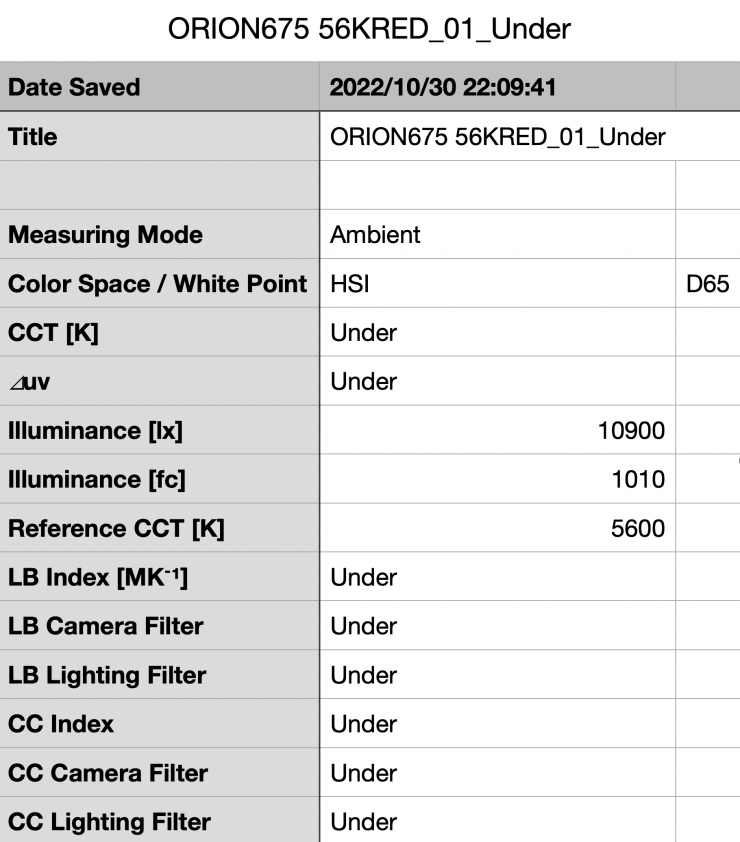
Above you can see that the light when using its Medium reflector recorded an output of 10900 lx (1010 fc). What you clearly need to know when using RGBWACL lights like this is that the output levels you can produce when creating super saturated colors are a lot less than when using the light in a CCT mode. However, 10900 lx is still a ton of output.

As far as creating an accurate 0° RED, the Orion 675 FS was spot on with a 0° reading and 100% saturation.
120° – GREEN
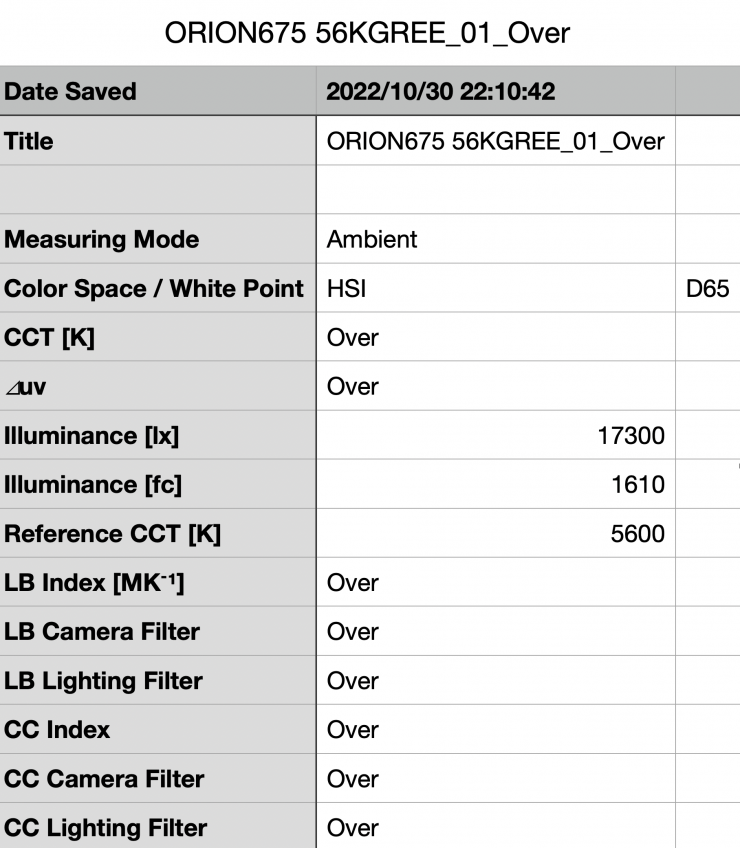
Above you can see that the light when using its Medium reflector recorded an output of 17300 lx (1610 fc).

As far as creating an accurate 120° GREEN, the Orion 675 FS was spot on with a 120° reading and 100% saturation.
240° – BLUE
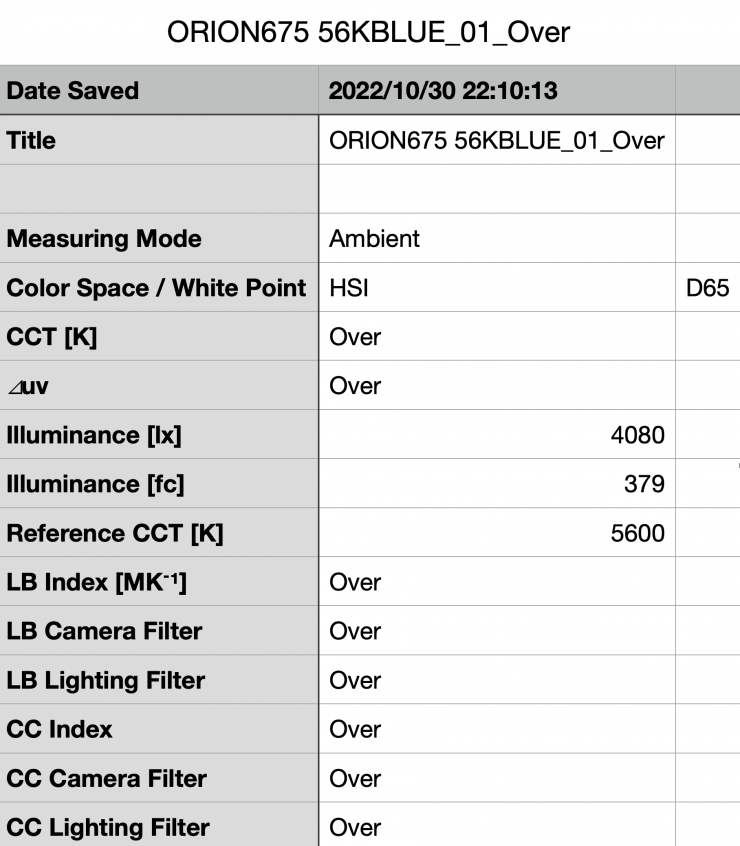
Above you can see that the light when using its Medium reflector recorded an output of 4080 lx (379 fc).

As far as creating an accurate 240° BLUE, the Orion 675 FS was 1° off with a reading of 241°, but it did have 100% saturation.
60° – YELLOW

Above you can see that the light when using its Medium reflector recorded an output of 4080 lx (379 fc).

As far as creating an accurate 240° BLUE, the Orion 675 FS was 1° off with a reading of 241°, but it did have 100% saturation.
Output when using the Fresnel
I also wanted to test the light when using the optional Fresnel at 5600K to see how much output it had, and if the CCT gets altered in any way.
Because I am thorough, I have also included some results for the Aputure LS 600c Pro and F10 Fresnel as a comparison.
Prolycht Orion 675 FS 5600K (Fresnel 50°)
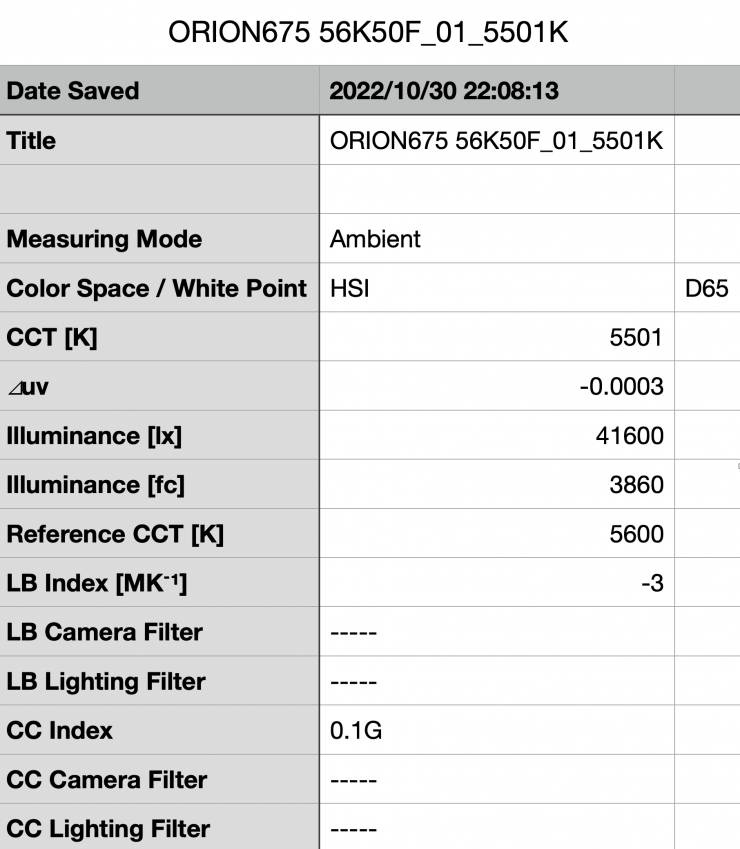
Above you can see the light’s output when it was set at 5600K with the Fresnel set at 50° was 41,600 lx (3860 fc). This was 25.3% less than the 55,700 lx it produced when using the Wide 55° Reflector. It is important to note that this measurement was made from the edge of the Fresnel.
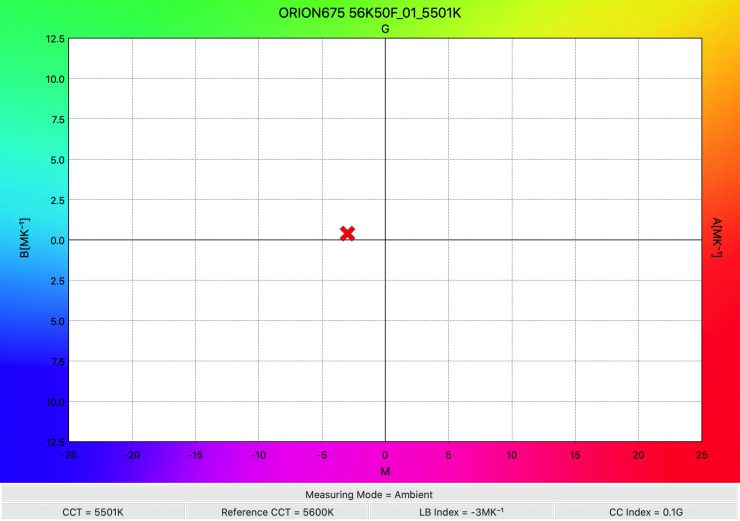
As far as CCT accuracy goes, it recorded a reading of 5501K which was almost identical to the reading of 5515K that it recorded when using the Wide 55° reflector.
Aputure LS 600c Pro 5600K (Fresnel 45°)
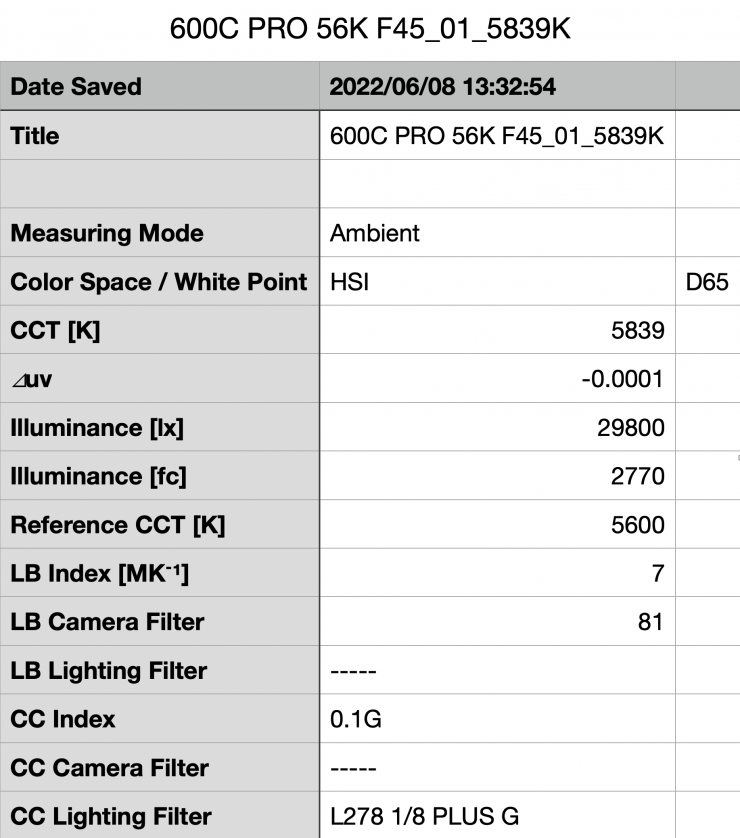
Above you can see the light’s output when it was set at 5600K with the F10 Fresnel set at 45° was 29,800 lx (2770 fc). This was 95.3% more than the 15,400 lx it produced at 5600K when used open face and 32.27% less than the 44,000 lx it produced when using the Hyper Reflector. It is important to note that this measurement was made from the edge of the Fresnel.
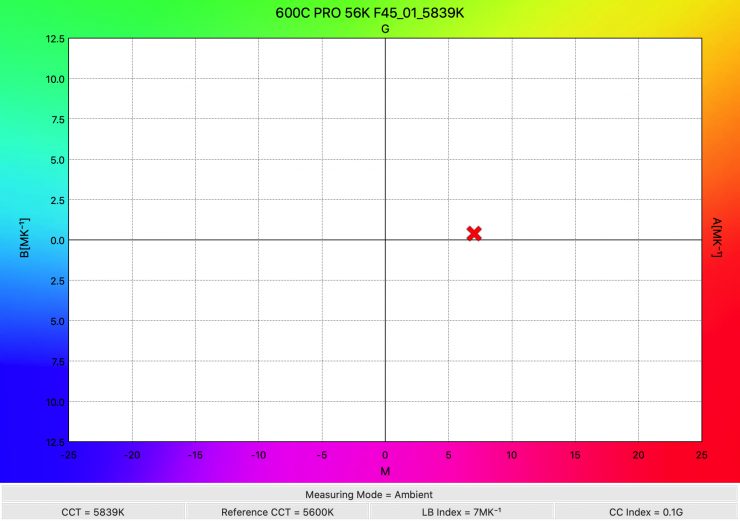
As far as CCT accuracy goes, it recorded a reading of 5839K which was not nearly as good as the reading of 5616K that it recorded when using the Hyper reflector. The CCT accuracy when using the F10 Fresnel is slightly better than when using the light open face.
Prolycht Orion 675 FS 5600K (Fresnel 30°)
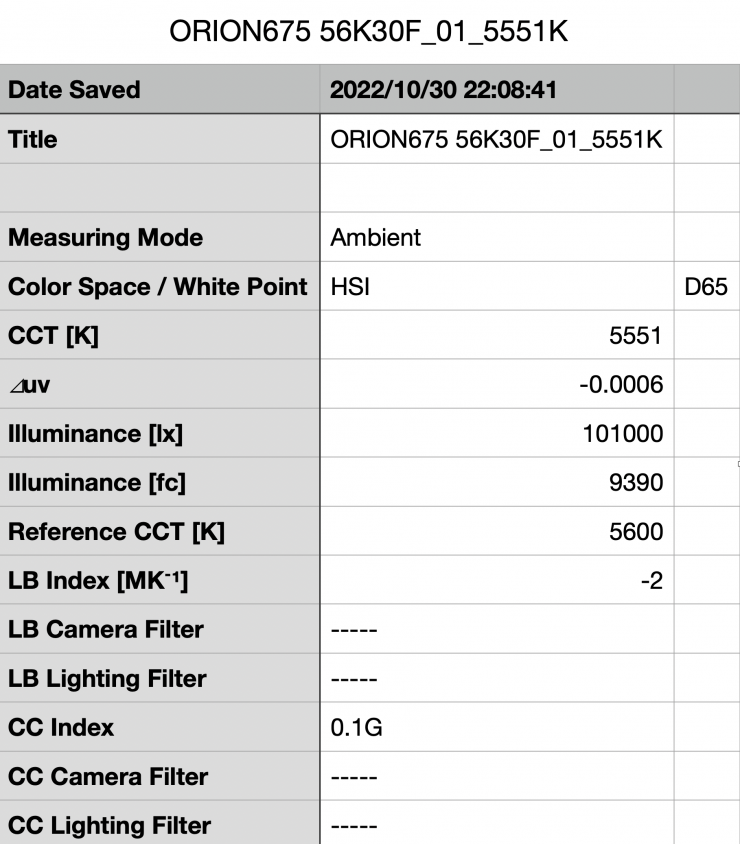
Above you can see the light’s output when it was set at 5600K with the Fresnel set at 30° was 101,000 lx (9390 fc). This was 17.88% less than the 123,000 lx it produced when using the Medium 30° Reflector. It is important to note that this measurement was made from the edge of the Fresnel.
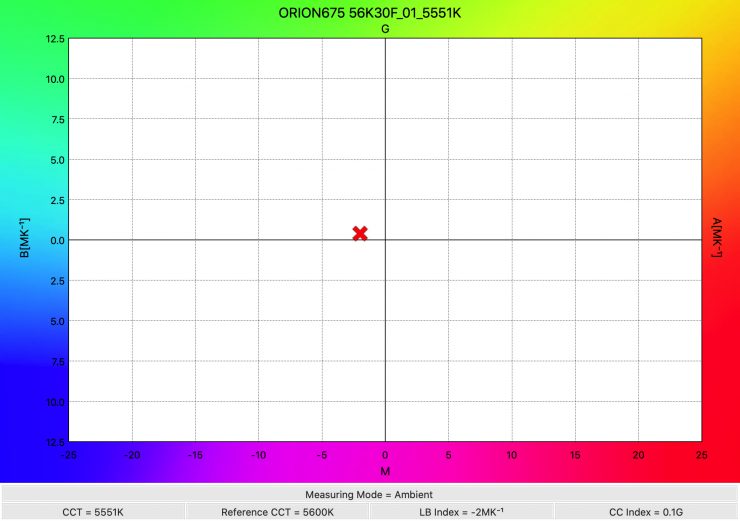
As far as CCT accuracy goes, it recorded a reading of 5551K which was a lot better than the reading of 5382K that it recorded when using the Medium reflector.
Prolycht Orion 675 FS 5600K (Fresnel 15°)
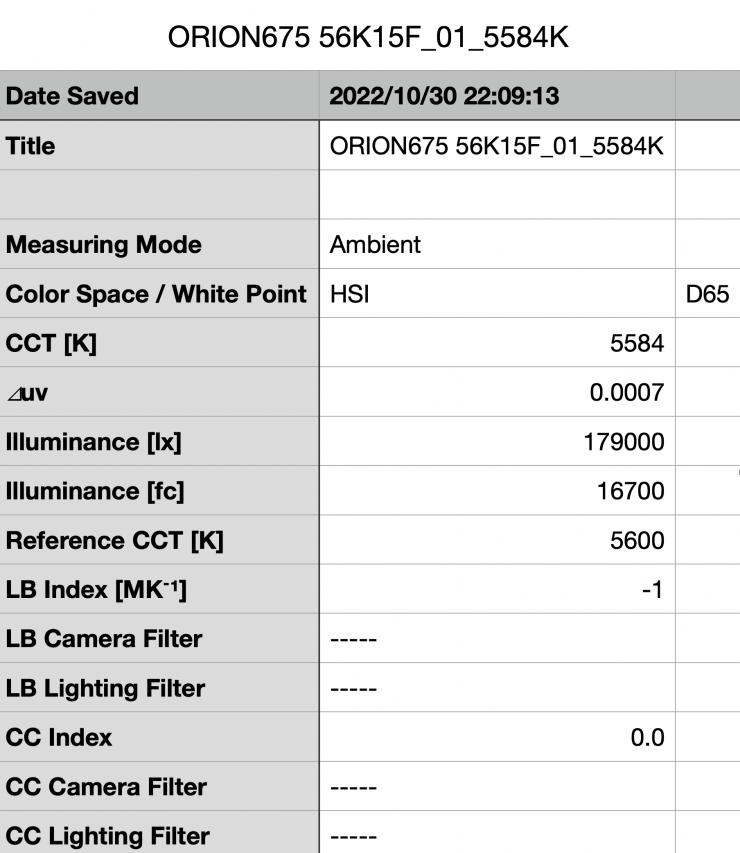
Above you can see the light’s output when it was set at 5600K with the Fresnel set at 15° was 179,000 lx (16700 fc). This is a ton of output. It is important to note that this measurement was made from the edge of the Fresnel.
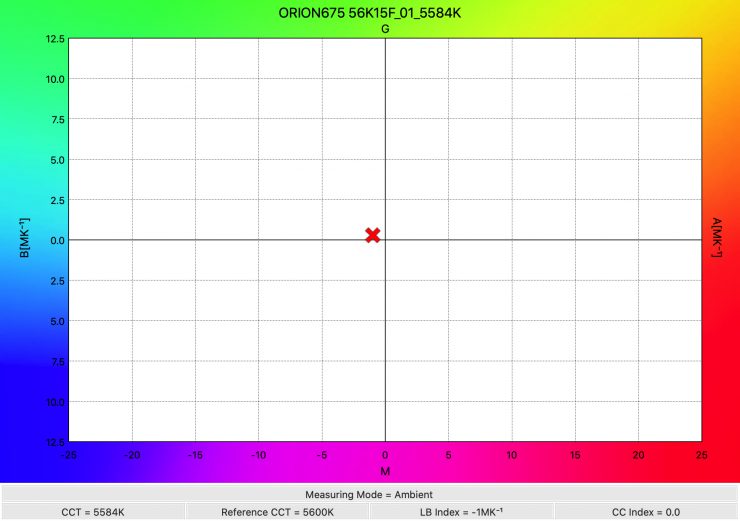
As far as Kelvin color temperature accuracy goes, it recorded a reading of 5584K which was very accurate.
Aputure LS 600c PRO 5600K (F10 Fresnel 15°)
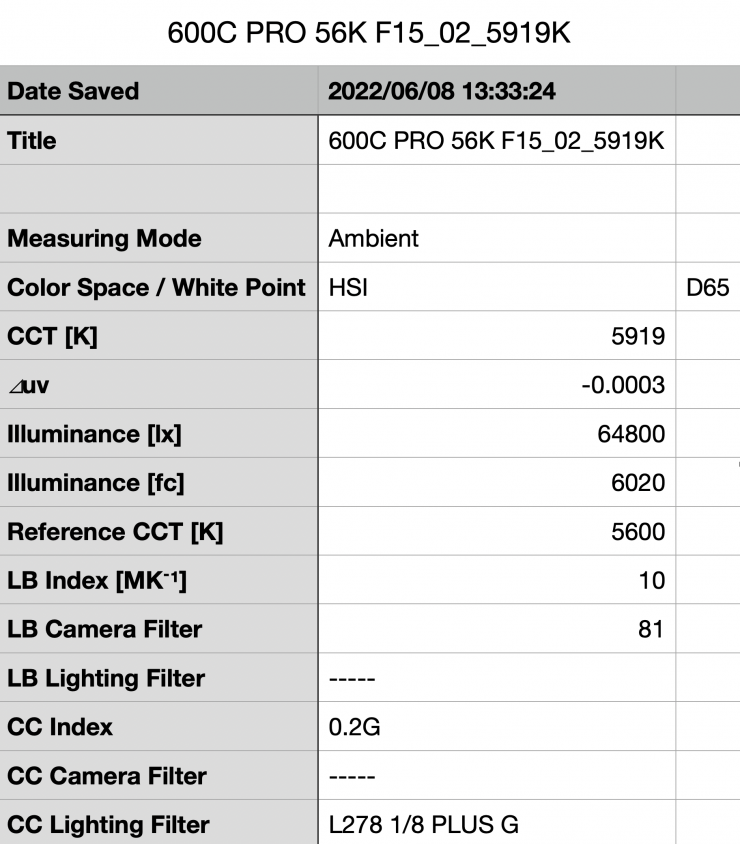
Above you can see the light’s output when it was set at 5600K with the F10 Fresnel set at 15° was 64,800 lx (6020 fc). This was 320.79% more than the 15,400 lx it produced at 5600K when used open face and 47.27% more than the 44,000 lx it produced when using the Hyper Reflector. It is important to note that this measurement was made from the edge of the Fresnel.
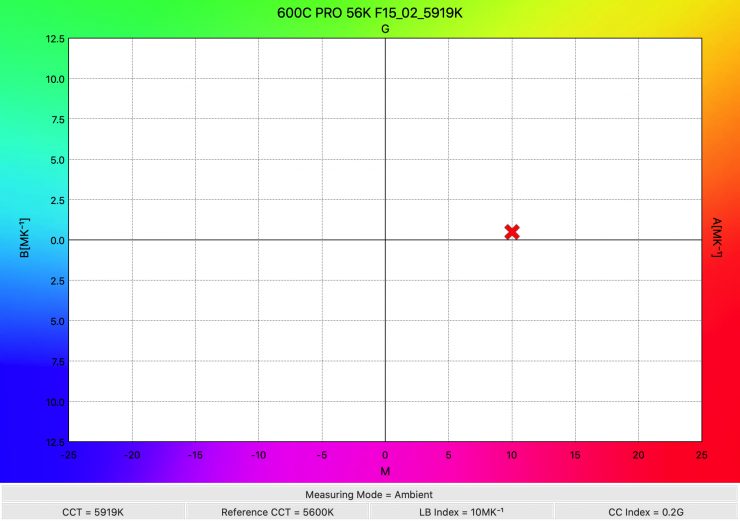
As far as Kelvin color temperature accuracy goes, it recorded a reading of 5919K which was not nearly as good as the reading of 5616K that it recorded when using the Hyper reflector. The Kelvin color temperature accuracy when using the F10 Fresnel is similar to when using the light open face.
The Prolycht Fresnel is extremely impressive. Not only is it well made, but it is also nice and compact.
So, let’s compare some of the data between the Orion 675 FS and its Fresnel and the Aputure with its F10 Fresnel when both lights are set at 5600K.
| OUTPUT | ||
| Aputure LS 600c Pro | Fresnel set at 45° | 29,800lx |
| Prolycht Orion 675 FS | Fresnel set at 50° | 41,600lx |
| OUTPUT | ||
| Aputure LS 600c Pro | Fresnel set at 15° | 64,800lx |
| Prolycht Orion 675 FS | Fresnel set at 15° | 179,000lx |
As you can see, the Orion 675 FS and its Fresnel have a far greater output than the Aputure LS 600c Pro and the F10 Fresnel.
Color Rendering
So now that we have seen how much output the Orion 675 FS produces, how does it perform when it comes to replicating accurate colors?
Prolycht Orion 675 FS 5600K (Wide reflector 55°)
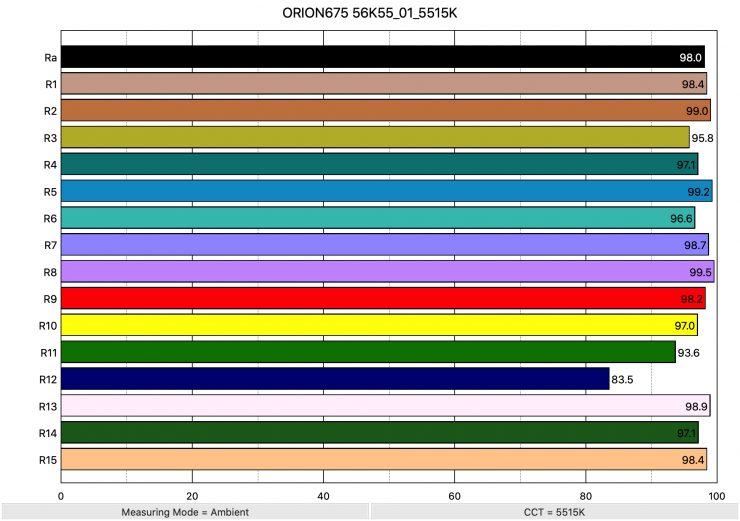
Above you can see that when the light was set at 5600K using the Wide reflector it recorded an average CRI (R1-R8) of 98.0 and an extended CRI (R1-R15) of 96.73. For replicating accurate skin tones it recorded for R9 98.2 (red), 98.9 for R13 (closest to caucasian skin tones), and 98.4 for R15 (closest to Asian skin tones). These are good results, and only R12 (Blue) was under 90.
| CRI | EXTENDED CRI | R9 | R13 | R15 | |
| Aputure LS 600c Pro | 96.5 | 95.32 | 98.9 | 99.0 | 96.2 |
| Prolycht Orion 675 FS | 98.0 | 96.73 | 98.2 | 98.9 | 98.4 |
As a comparison, the 600c Pro recorded an average CRI (R1-R8) of 96.5 and an extended CRI (R1-R15) of 95.32. For replicating accurate skin tones it recorded 93.9 R9 (red), 98.9 for R13 (closest to caucasian skin tones), and 96.2 for R15 (closest to Asian skin tones). The Aputure 600c Pro was tested with its 62° Hyper reflector.
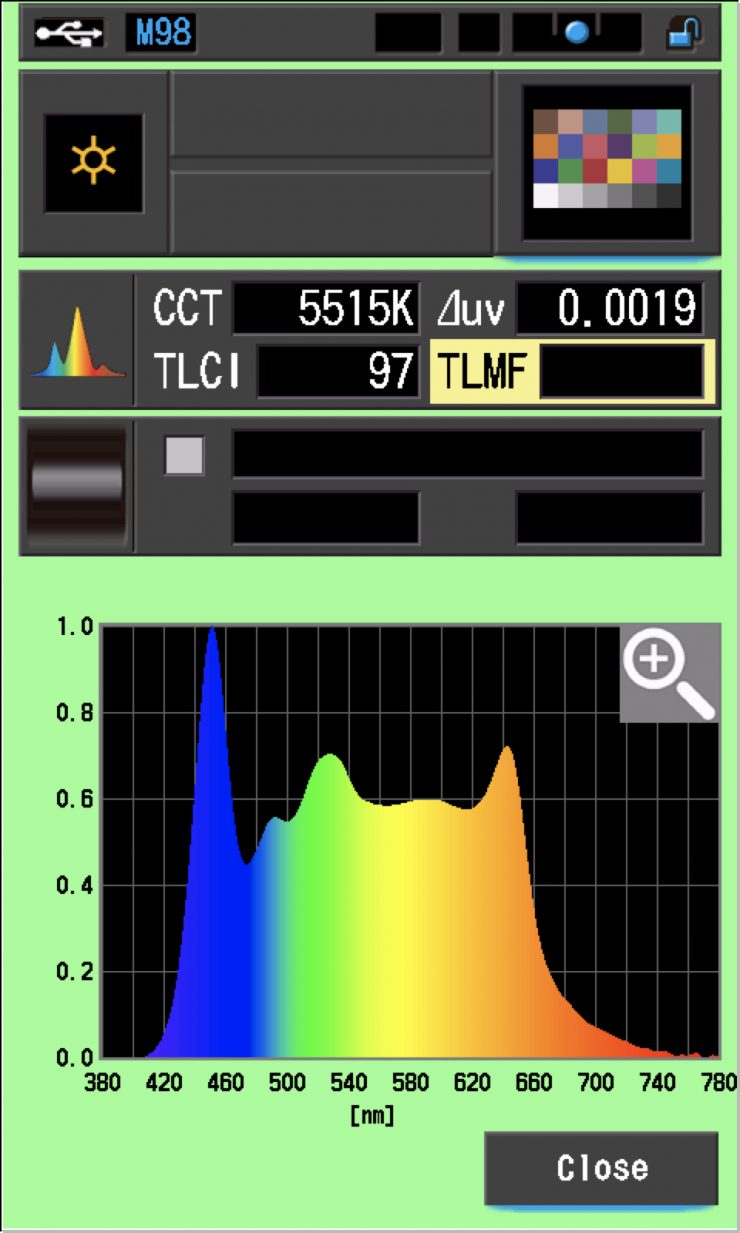
The Prolycht Orion 675 FS, when set at 5600K, recorded a TLCI score of 97.
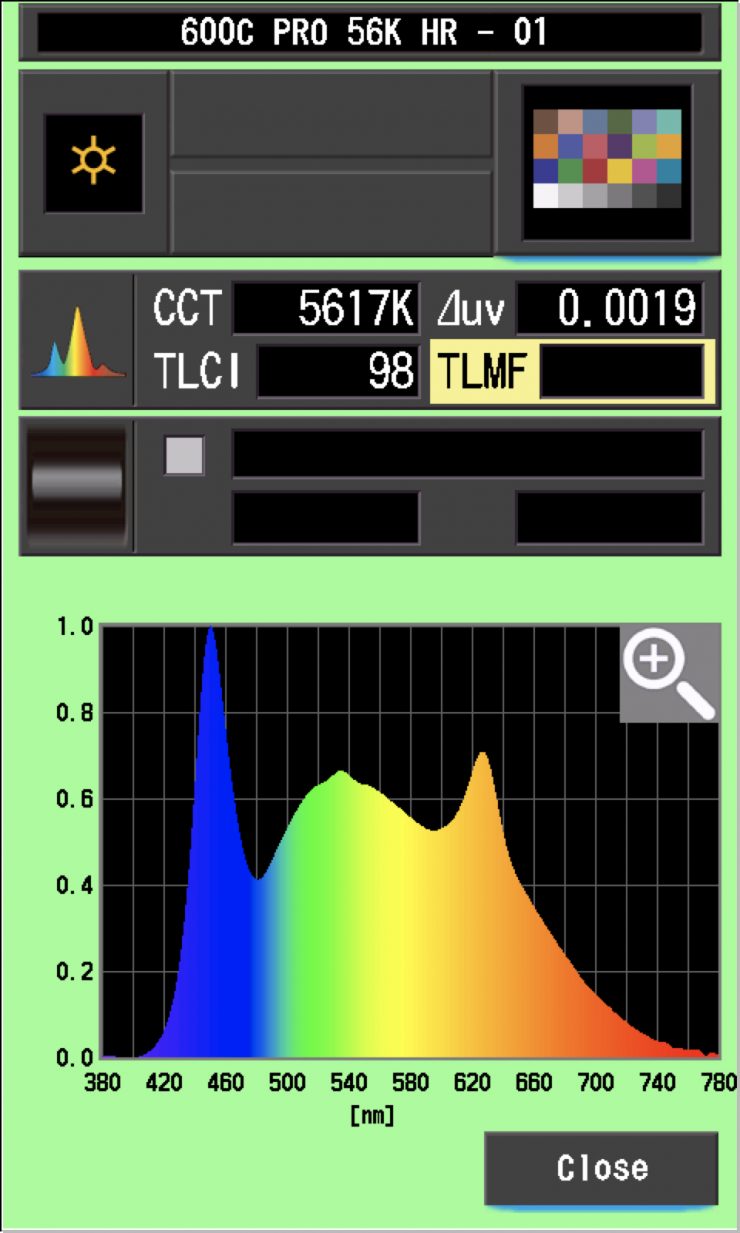
As a comparison, the Aputure LS 600c Pro, when set at 5600K, recorded a TLCI score of 98.
Prolycht Orion 675 FS 3200K (Wide reflector 55°)
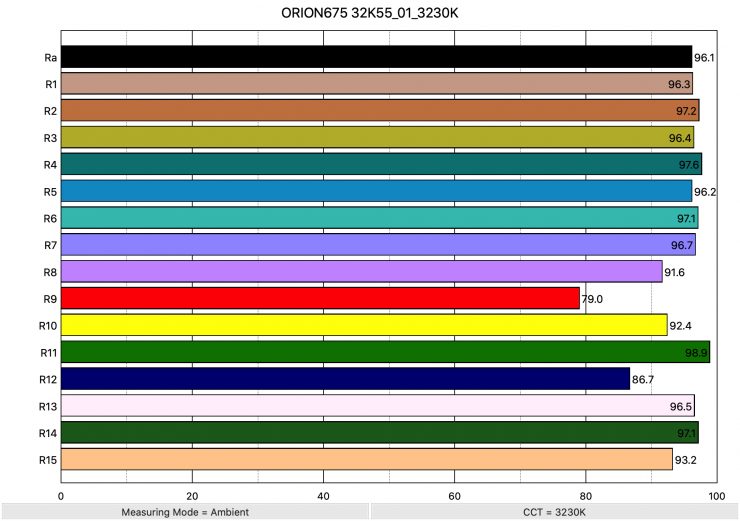
Above you can see the scores for when the light was used at 3200K. It recorded an average CRI (R1-R8) of 96.1 and an extended CRI (R1-R15) of 94.19. For replicating accurate skin tones it recorded 79.0 for R9 (red), 96.5 for R13 (closest to caucasian skin tones), and 93.2 for R15 (closest to Asian skin tones). These were good results, but I expected better.
These results were not as good as when the light is used at 5600K.
| CRI | EXTENDED CRI | R9 | R13 | R15 | |
| Aputure LS 600c Pro | 98.2 | 96.78 | 91.5 | 99.1 | 99.0 |
| Prolycht Orion 675 FS | 96.1 | 94.19 | 79.0 | 96.5 | 93.2 |
As a comparison, the 600c Pro recorded an average CRI (R1-R8) of 98.2 and an extended CRI (R1-R15) of 96.78. For replicating accurate skin tones it recorded 91.5 R9 (red), 99.1 for R13 (closest to caucasian skin tones), and 99.0 for R15 (closest to Asian skin tones). The Aputure 600c Pro was tested with its 62° Hyper reflector.
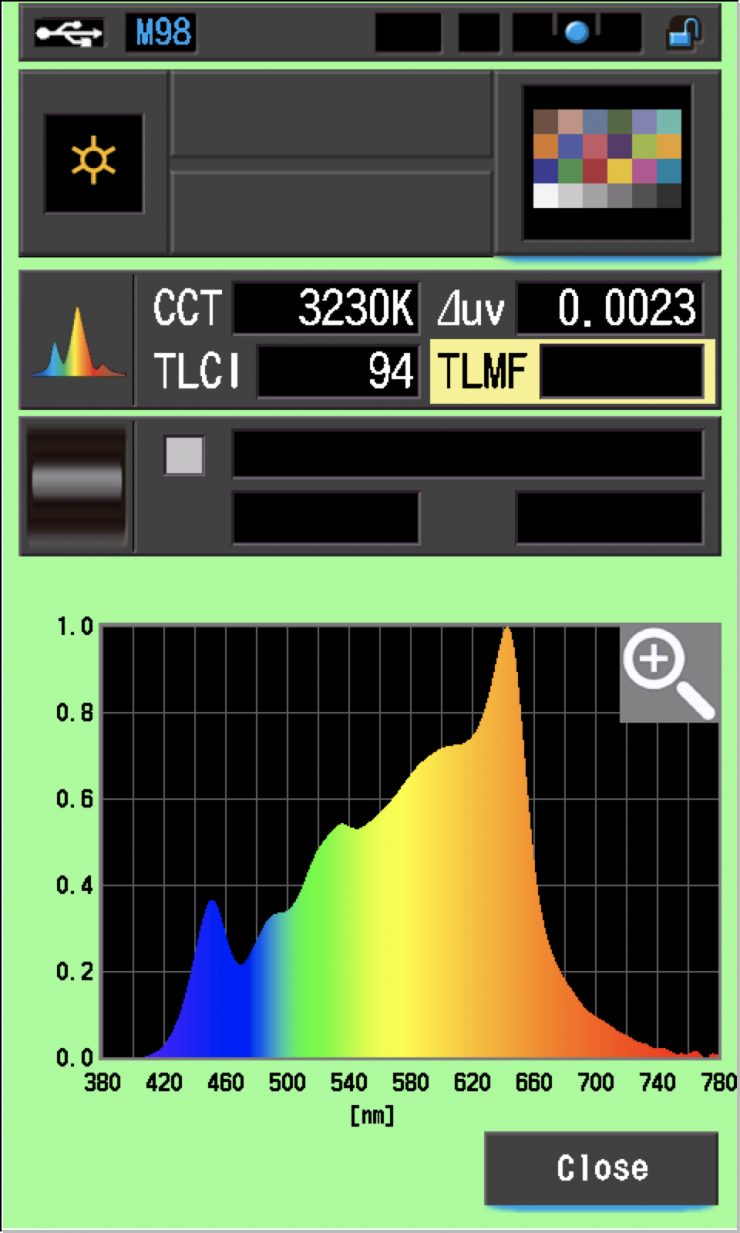
The Prolycht Orion 675 FS, when set at 3200K, recorded a TLCI score of 94.
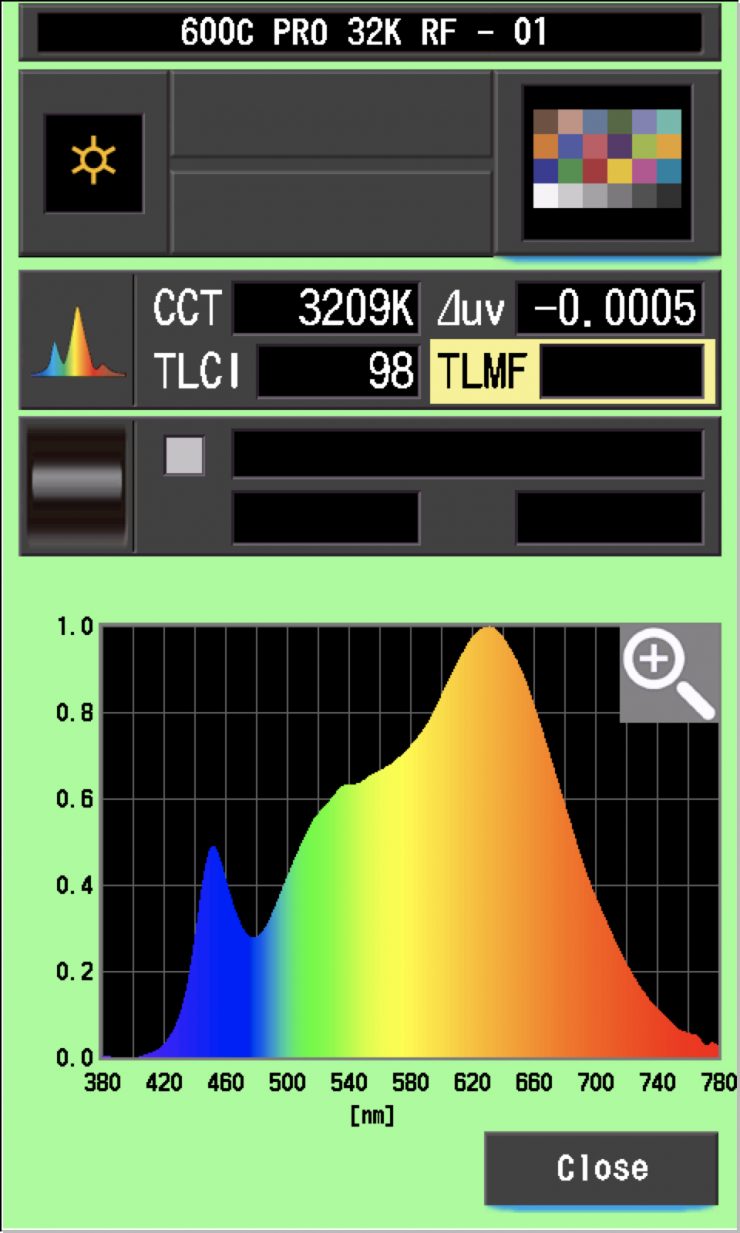
As a comparison, the Aputure LS 600c Pro, when set at 3200K, recorded a TLCI score of 98.
CC Index & ⊿uv
The CC Index displays the CC correction value and whether any magenta or green need to be added or subtracted. 1 CC corresponds to 035 Kodak CC values or 1/8 Rosco filter values. Any reading less than +1.00 or -1.00 and you’re probably not going to need to make any kind of adjustment. The ⊿uv is the value to show how much this light is away from being an ideal light source (black body radiation = incandescent lamp). As with the CC Index you want this number to theoretically be zero. Kelvin is not a linear value, so we need to convert from Kelvin to MK-1 to compare the values of color temperature. To calculate from Kelvin to Mired is MK-1= 1*1000000/Kelvin. While this may sound confusing, it is the only way of measuring if the Kelvin shift is significant enough to warrant having to use a filter for correction. Below are the results for the Orion 675 FS:
Prolycht Orion 675 FS Kelvin Vs MK-1
| Kelvin | Difference in K | MK-1 | Difference in MK-1 | |
| SET VALUE | 2500K | 0 | 400 | 0 |
| ACTUAL READING | 2535K | 35 | 394.47 | 5.53 MK-1 |
| SET VALUE | 3200K | 0 | 312.5 | 0 |
| ACTUAL READING | 3199K | 1 | 312.59 | -0.09 MK-1 |
| SET VALUE | 4500K | 0 | 222.22 | 0 |
| ACTUAL READING | 4490K | 10 | 222.71 | -0.49 MK-1 |
| SET VALUE | 5600K | 0 | 178.57 | 0 |
| ACTUAL READING | 5382K | 218 | 185.80 | -7.23 MK-1 |
| SET VALUE | 6500K | 0 | 153.84 | 0 |
| ACTUAL READING | 6295K | 205 | 158.85 | -5.01 MK-1 |
| SET VALUE | 8000K | 0 | 125 | 0 |
| ACTUAL READING | 7613K | 387 | 131.35 | -6.35 MK-1 |
| SET VALUE | 10000K | 0 | 100 | 0 |
| ACTUAL READING | 9859K | 141 | 101.43 | -1.43 MK-1 |
These figures might look confusing, but what it tells me is that the light is very CCT color-accurate at all temperatures. Any MK-1 score that is under -9/9 means you wouldn’t have to use any color correction gels. The MK-1 scores for this light were excellent at 4500K and below, but only average at 5600K to 8000K. Any MK-1 score that is under -6/6 is a very good result.
As a comparison, below are the scores for the Aputure LS 600c Pro
Aputure LS 600c Pro Kelvin Vs MK-1
| Kelvin | Difference in K | MK-1 | Difference in MK-1 | |
| SET VALUE | 2500K | 0 | 400 | 0 |
| ACTUAL READING | 2533K | 33 | 394.78 | 5.22 MK-1 |
| SET VALUE | 3200K | 0 | 312.5 | 0 |
| ACTUAL READING | 3209K | 9 | 311.62 | 0.88 MK-1 |
| SET VALUE | 4500K | 0 | 222.22 | 0 |
| ACTUAL READING | 4542K | 58 | 220.16 | -2.06 MK-1 |
| SET VALUE | 5600K | 0 | 178.57 | 0 |
| ACTUAL READING | 5617K | 17 | 178.03 | 0.54 MK-1 |
| SET VALUE | 6500K | 0 | 153.84 | 0 |
| ACTUAL READING | 6626K | 46 | 150.92 | 2.92 MK-1 |
| SET VALUE | 8000K | 0 | 125 | 0 |
| ACTUAL READING | 8157K | 157 | 122.59 | 2.41 MK-1 |
| SET VALUE | 10000K | 0 | 100 | 0 |
| ACTUAL READING | 10289K | 289 | 97.19 | 2.81 MK-1 |
The MK-1 scores for this LS 600c Pro were excellent at 3200K and above. Any MK-1 score that is under -6/6 is a very good result.
Ok, now let’s look at the CC INDEX & ⊿uv.
Prolycht Orion 675 FS CC INDEX & ⊿uv
| CC INDEX | ⊿uv | |
| 2500K | 0 | 0.0010 |
| 3200K | 0.3M | 0.0024 |
| 4500K | 0.2M | 0.0011 |
| 5600K | 0.1M | 0.0017 |
| 6500K | 0.1G | 0.0006 |
| 8000K | 0.2G | 0.0023 |
| 10000K | 0.7G | 0.0018 |
These were good results across the board. There was nothing here that anyone should be concerned about.
As a comparison, below you can see the results for the Apture LS 600c Pro.
Aputure LS 600c Pro CC INDEX & ⊿uv
| CC INDEX | ⊿uv | |
| 2500K | 0.1G | 0.0000 |
| 3200K | 0 | -0.0005 |
| 4500K | 0 | -0.0008 |
| 5600K | 0 | 0.0019 |
| 6500K | 0.4G | -0.0007 |
| 8000K | 0.6G | -0.0001 |
| 10000K | 0.9G | 0.0002 |
These were excellent results that the Aputure recorded.
The ⊿uv at 3200K was a perfect 0.0000. There have only been a handful of lights that I have ever reviewed that have had a perfect ⊿uv score at any Kelvin color temperature setting.
TM-30
TM-30 is a relatively new color rendering standard that was developed to deal with the limitations of CRI. TM-30 looks at 99 individual colors. These 99 colors are categorized into seven groups: nature, skin color, textiles, paints, plastics, printed material, and color systems.
TM-30 scores go from 0 – 100. The higher the score, the more accurate a light is at producing colors. Any TM-30 Rf score in the ’90s is considered to be good. What is interesting and something that you need to be very aware of is that two separate light sources with the exact same CRI scores can render colors very differently. A light with a high CRI rating could have a low TM-30 score. Conversely, a light with a good TM-30 score could have a bad CRI score.
Now, there are two measurements associated with TM-30, Rf and Rg.
Rf (Color Fidelity)
Rg (Color Gamut)
With Rf value, ideally, you want a score in the 90’s.
With Rg value, a score below 100 indicates that the light source renders colors with less saturation than the reference source. So ideally you want this score to be above 100.
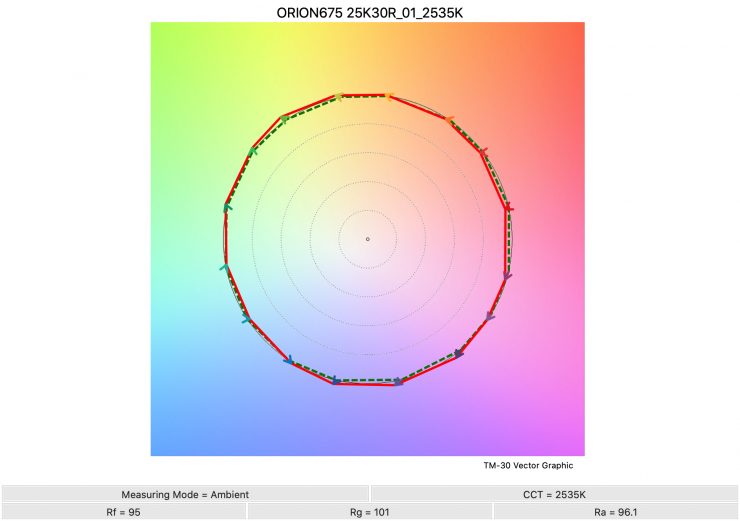
2500K 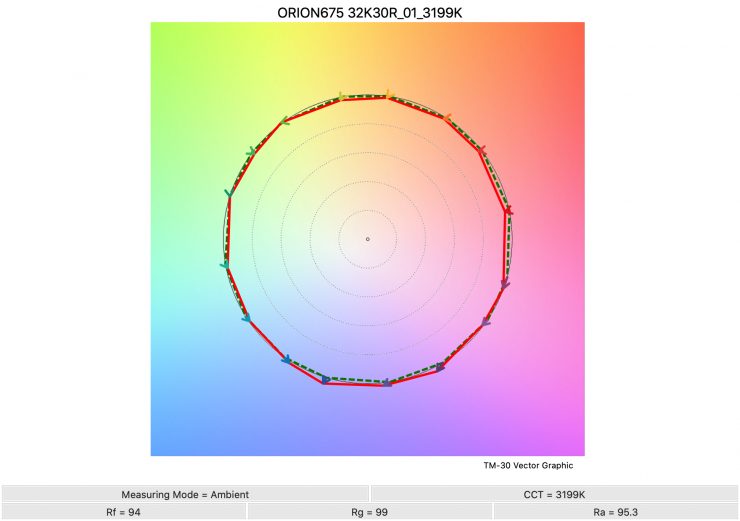
3200K 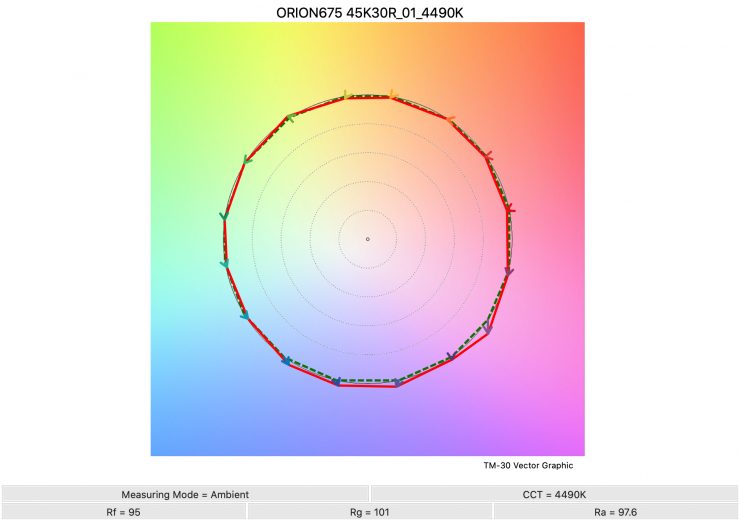
4500K 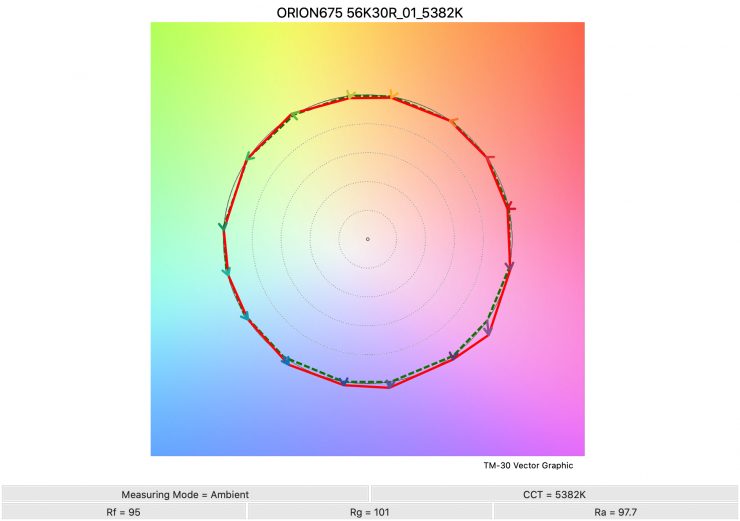
5600K 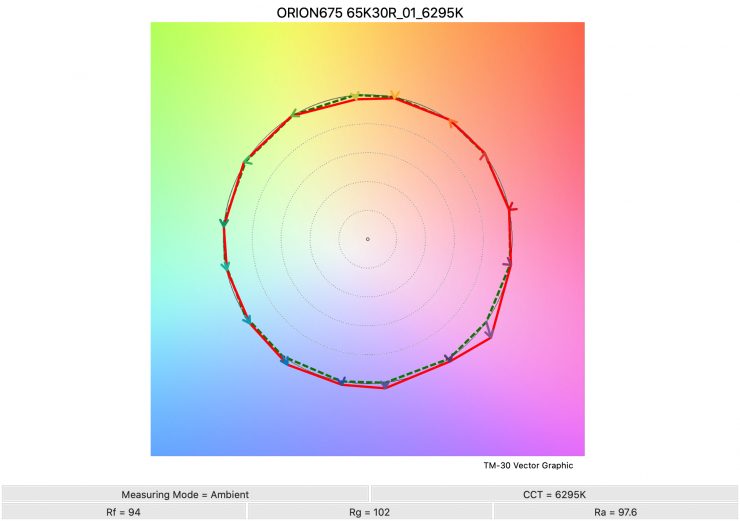
6500K 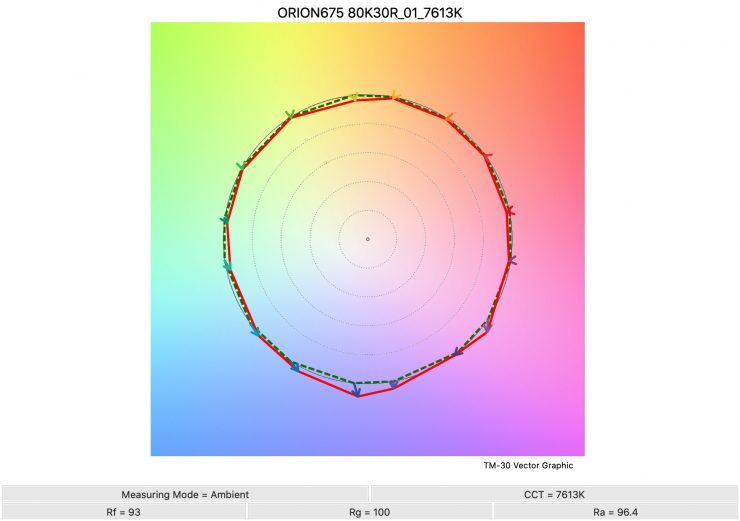
8000K 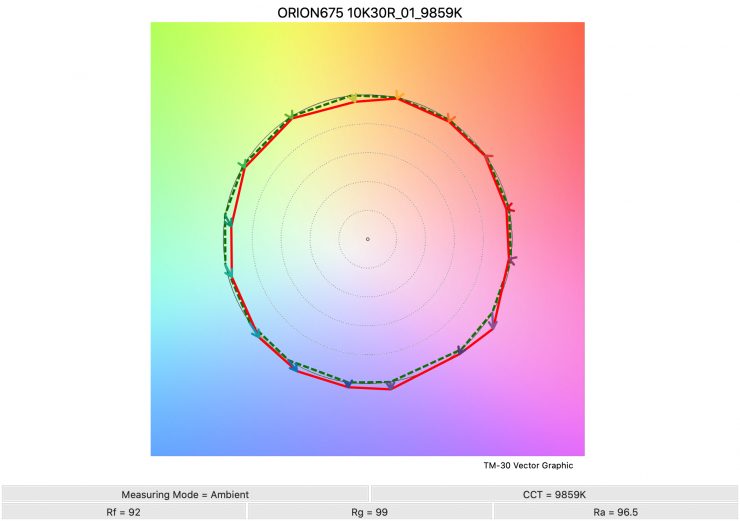
10,000K
Above you can see the scores for the LS 600c Pro at various CCT settings. Below I have listed the figures as well.
Here are the results:
| Rf | Rg | |
| 2500K | 95 | 101 |
| 3200K | 94 | 99 |
| 4500K | 95 | 101 |
| 5600K | 95 | 101 |
| 6500K | 94 | 102 |
| 8000K | 93 | 100 |
| 10000K | 92 | 99 |
The TM-30 scores are all good and it shows me that the light is pretty consistent at replicating accurate colors with full saturation.
Again, as a comparison, I have put the results for the Aputure LS 600c Pro below.
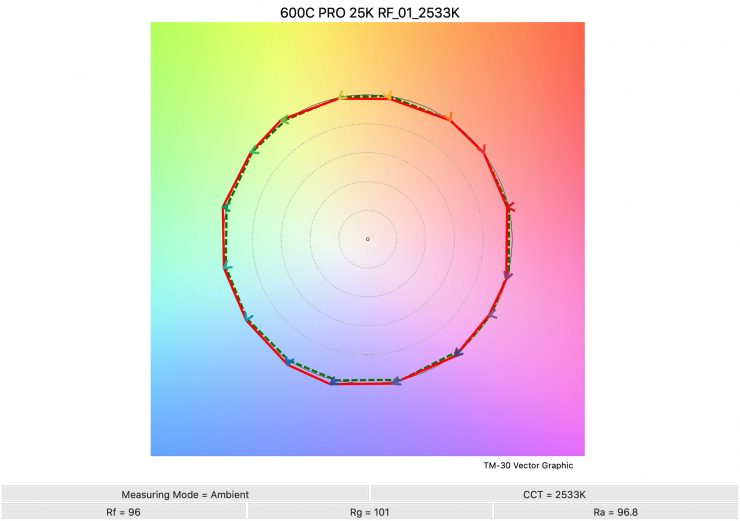
2500K 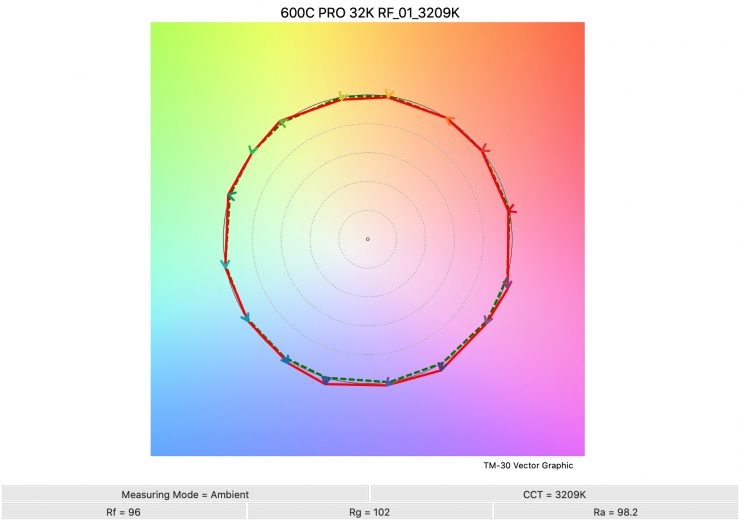
3200K 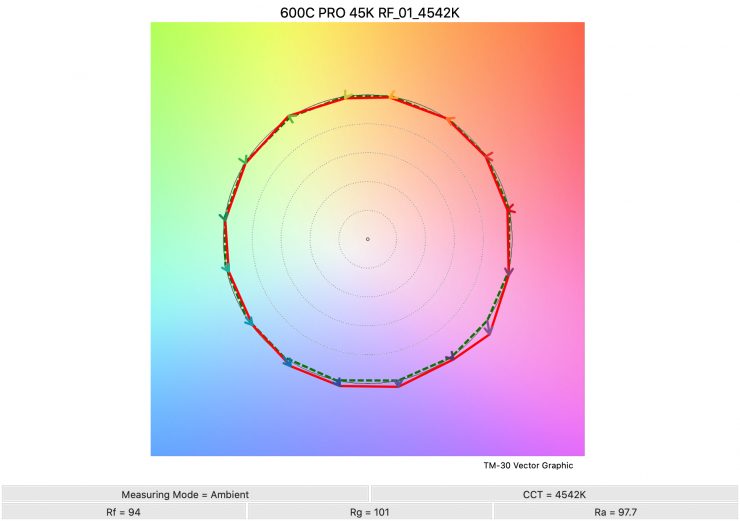
4500K 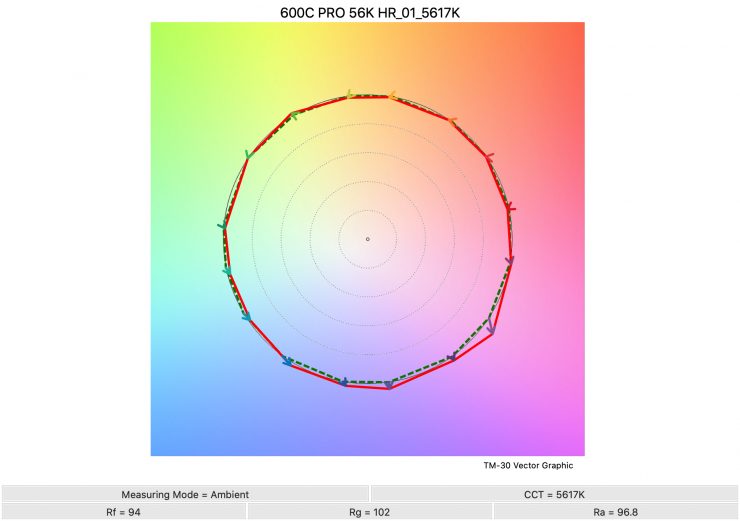
5600K 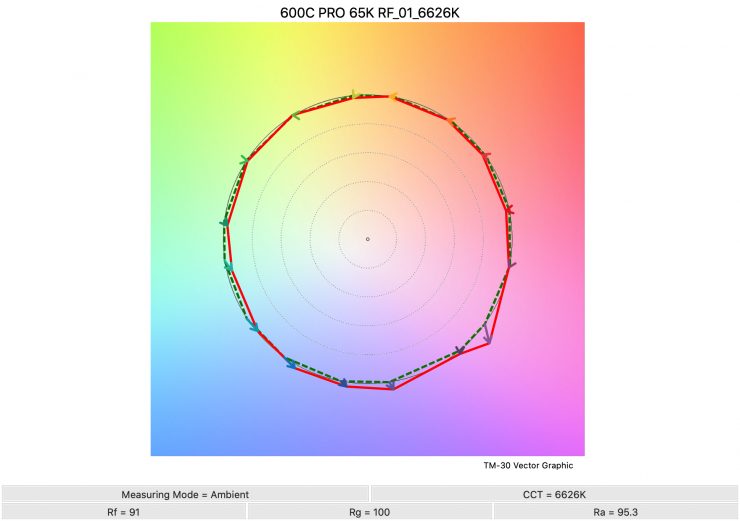
6500K 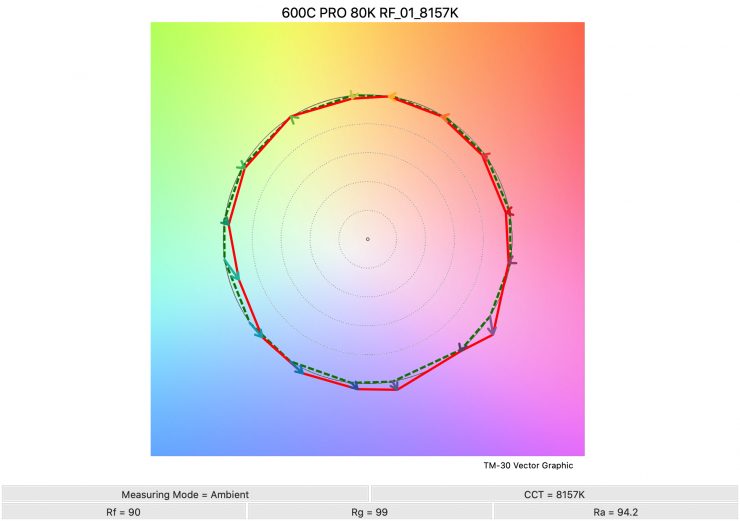
8000K 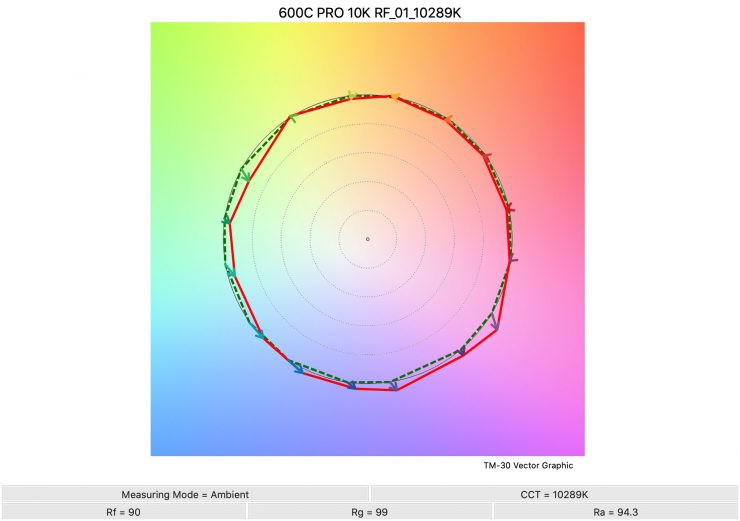
10,000K
Above you can see the scores for the LS 600c Pro at various CCT settings. Below I have listed the figures as well.
Here are the results:
| Rf | Rg | |
| 2500K | 96 | 101 |
| 3200K | 96 | 102 |
| 4500K | 94 | 101 |
| 5600K | 94 | 102 |
| 6500K | 91 | 100 |
| 8000K | 90 | 99 |
| 10000K | 90 | 98 |
The TM-30 scores are all good and it shows me that the light is pretty consistent at replicating accurate colors with full saturation.
SSI
SSI (Spectral Similarity Index) was developed by the Sci-Tech Council of the Academy. SSI gives me the ability to set any light as a standard, or use predefined standards (such as CIE D55), and then give other lights an SSI score based on how well they will match standards such as CIE D55. This way I can measure spectral response and compare it directly against an ideal light source. This is actually a much better test than recording CRI scores.
Prolycht Orion 675 FS 3200K
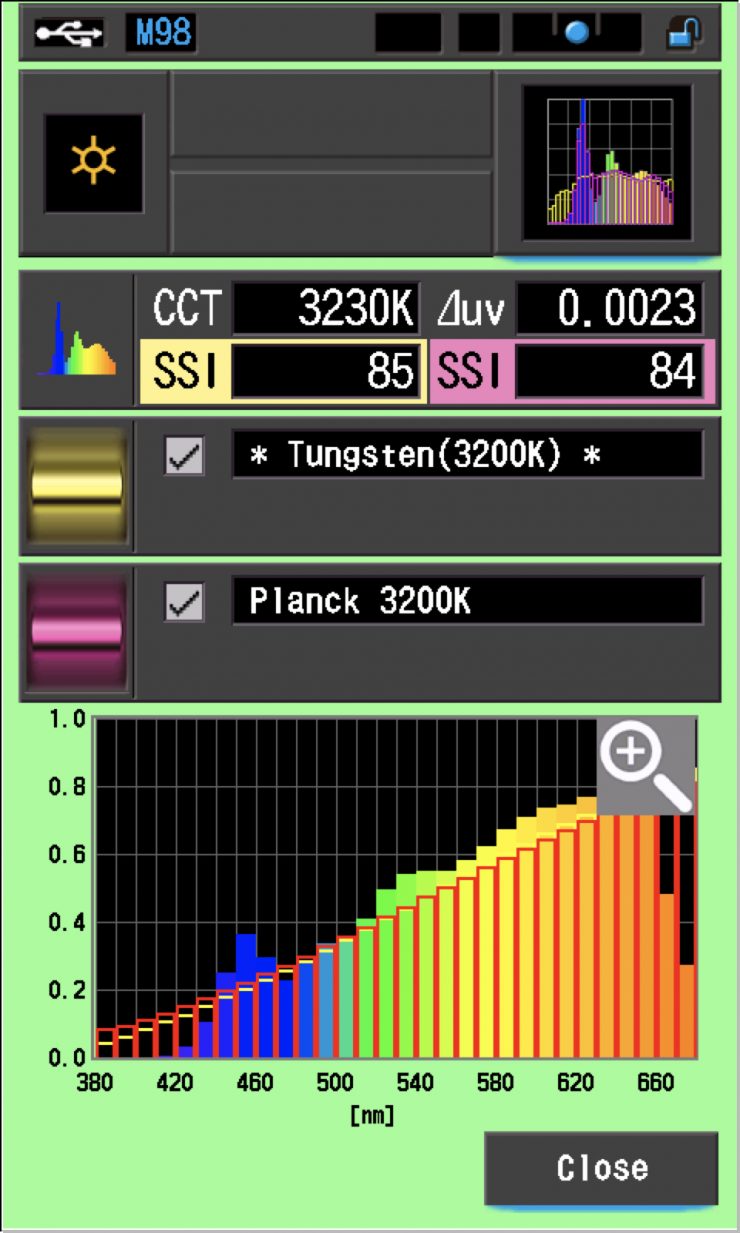
In this graph, the red bars indicate a perfect Planck 3200K source. The gold bars indicate a perfect 3200K Tungsten source. This lets us compare how close to a perfect 3200K lighting source the Orion 675 FS is. Any SSI score in the high 70’s, low ’80s is very good for a 3200K LED light. The results for the Orion 675 FS were excellent when used at 3200K. As you can see, LED lights have a hard time replicating colors below about 450nm.
Aputure LS 600c Pro 3200K
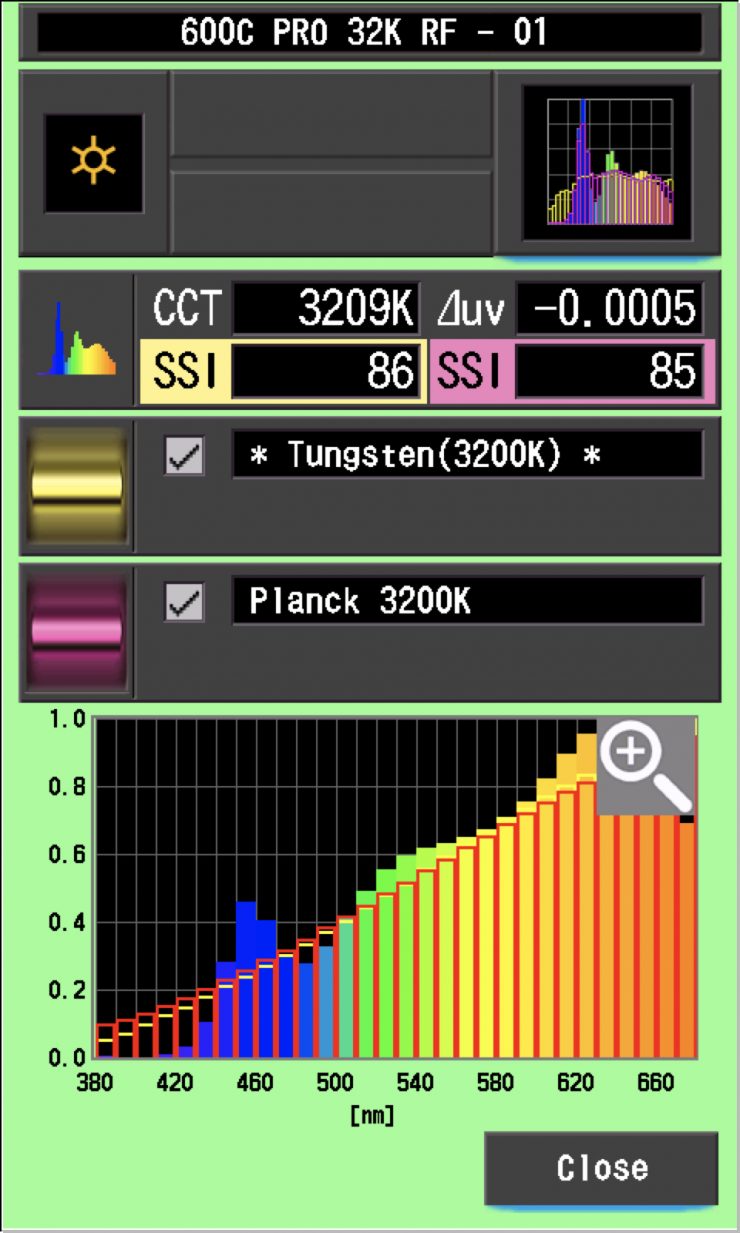
In this graph, the red bars indicate a perfect Planck 3200K source. The gold bars indicate a perfect 3200K Tungsten source. This lets us compare how close to a perfect 3200K lighting source the LS 600c Pro is. Any SSI score in the high 70’s, low ’80s is very good for a 3200K LED light. The results for the 600c Pro were also excellent when used at 3200K. As you can see, LED lights have a hard time replicating colors below about 450nm.
Prolycht Orion 675 FS 5600K
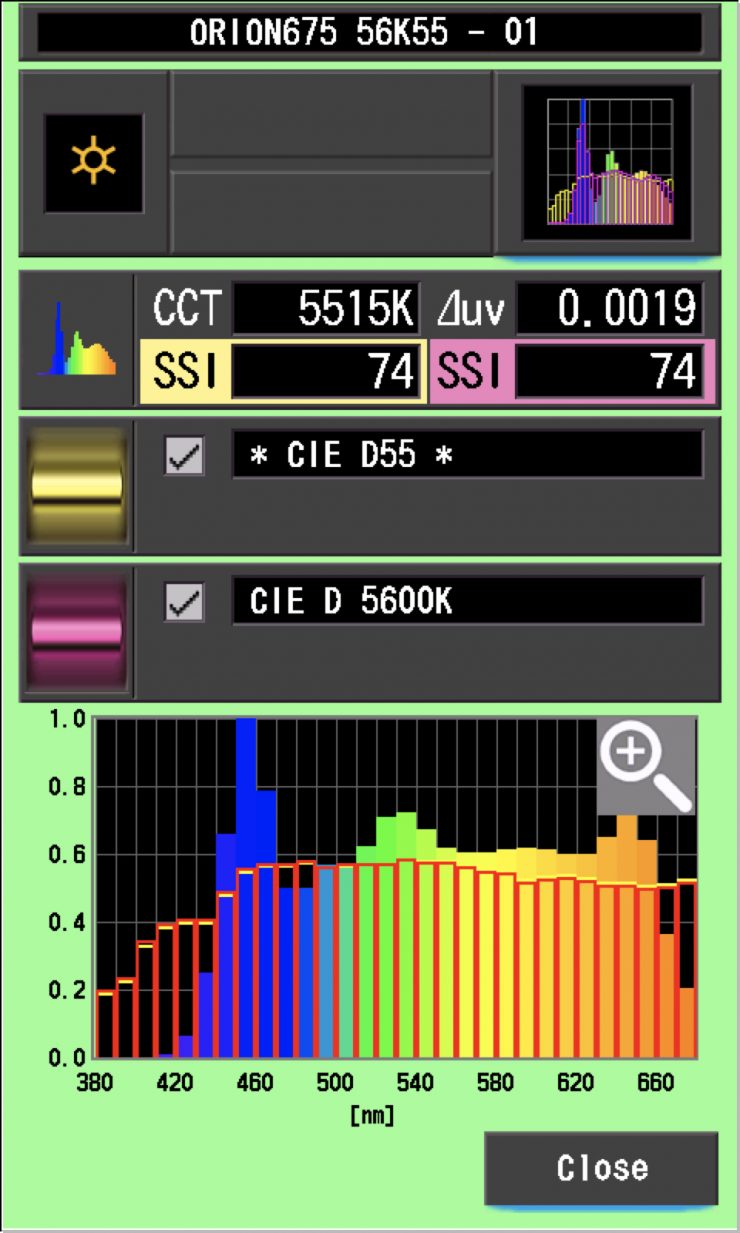
In the graph above the gold bars indicate a perfect CIE D55 source. The red bars indicate a perfect CIE D 5600K source. This lets us compare how close to a perfect 5600K lighting source the Orion 675 FS is. A score in the low 70’s is typical for a 5600K LED source.
Aputure LS 600c Pro 5600K
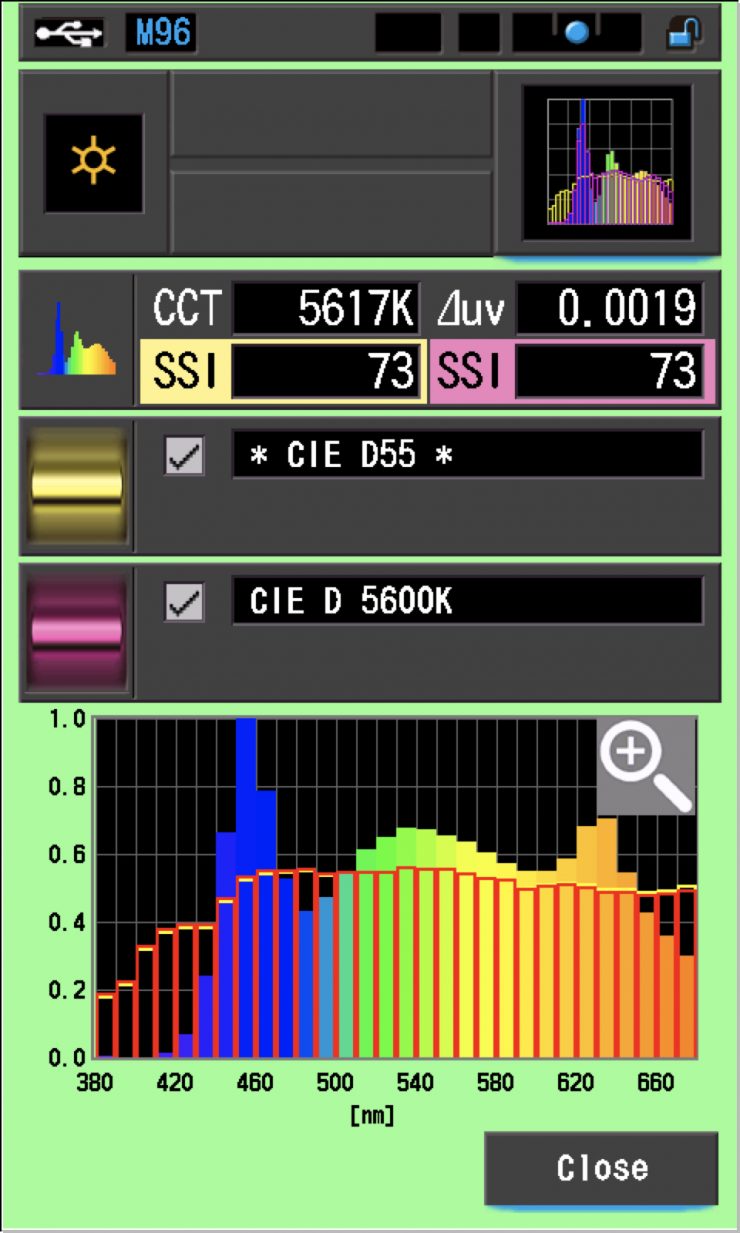
In the graph above the gold bars indicate a perfect CIE D55 source. The red bars indicate a perfect CIE D 5600K source. This lets us compare how close to a perfect 5600K lighting source the LS 600c Pro is. A score in the low 70’s is typical for a 5600K LED source.
The main reason we want to record SSI scores is so we can see how well they match with other lights. As an example, I wanted to see how well the Orion 675 FS matched the Aputure LS 600c Pro and the ARRI Orbiter. Below you can see the results.
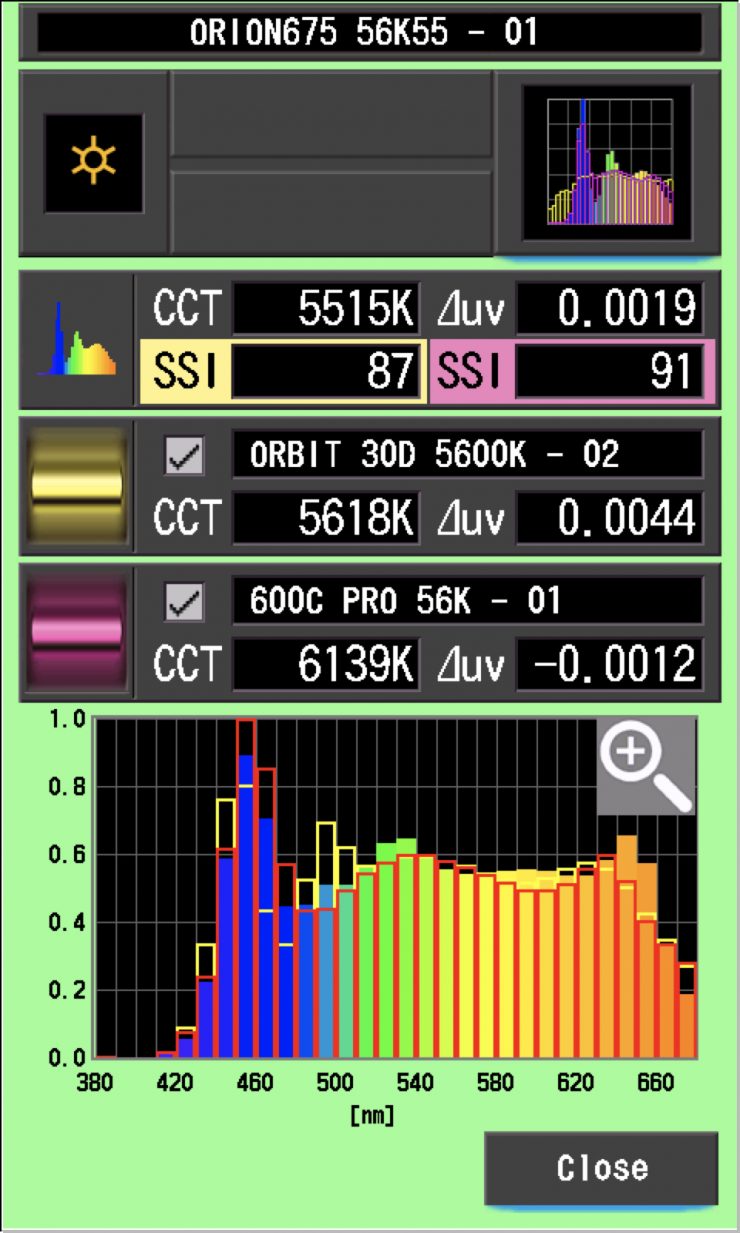
As you can see neither lights are a perfect match to the Orion 675 FS, but they are reasonably close. Any score in the high ’80s and low 90s is still reasonably good and the Prolycht would work well with both of these lights.
As another test, I thought I would compare those same lights against the Orion 675 Pro at 3200K. Below you can see the results.
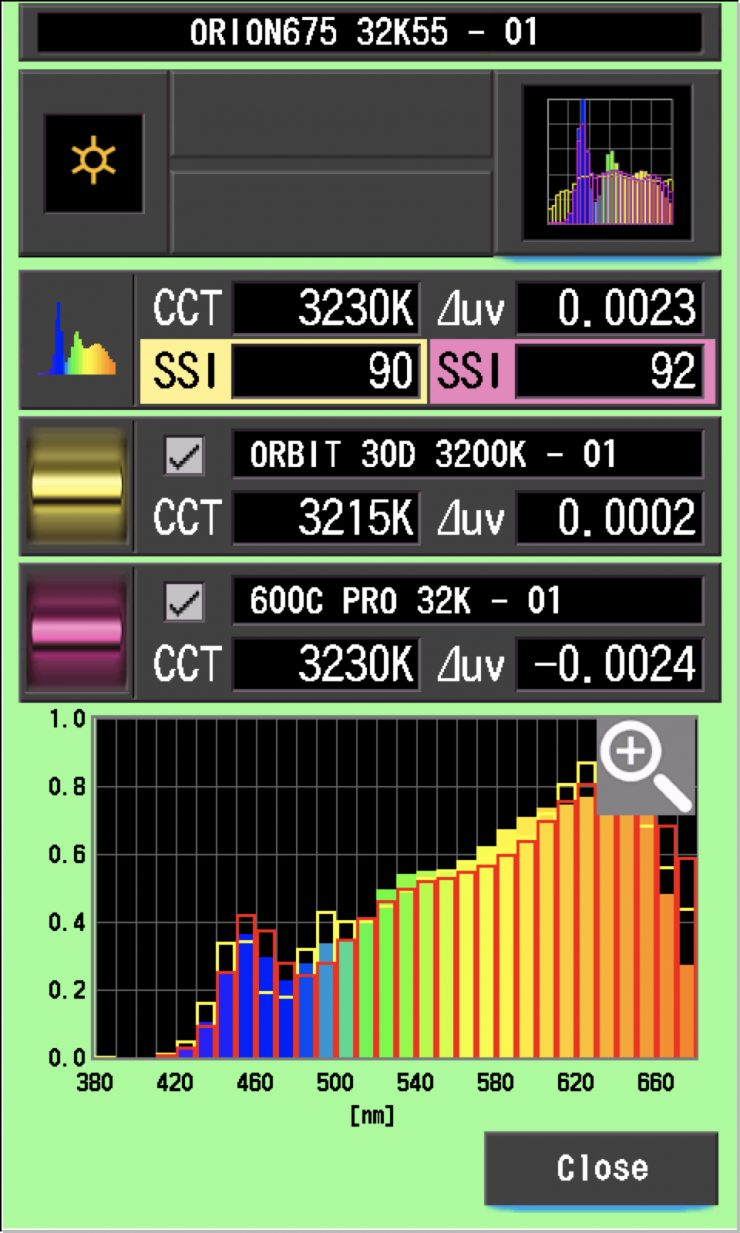
As you can see, just like at 5600K, both the ARRI and the Aputure were still a reasonably close match to the Orion 675 FS. Very few lights from different manufacturers are ever going to be an exact match.
SSI tests are a great way of telling you what lights you own or use will work well together.
Spectral Distribution
5600K
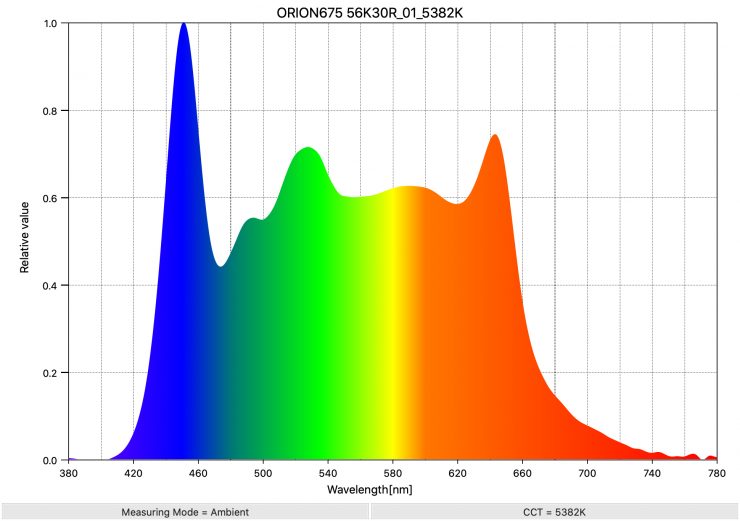
Above you can see the spectral distribution of the Orion 675 FS when it is set at 5600K. The spectral distribution is reasonably full, but you can see a few spikes.
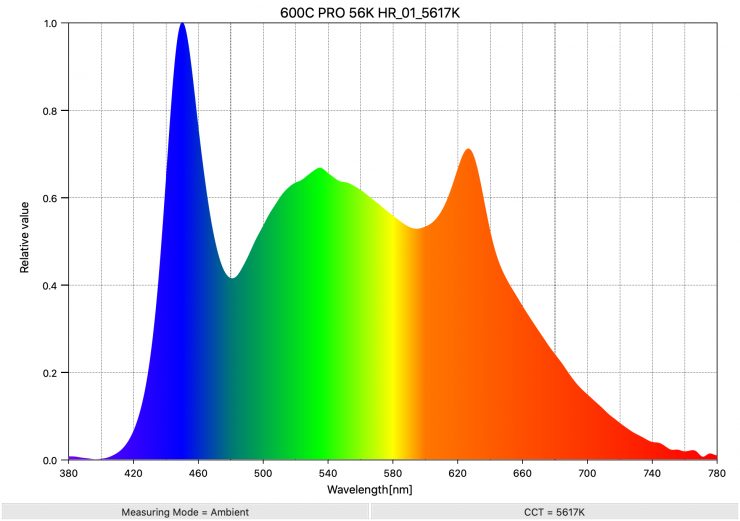
As a comparison, above you can see the spectral distribution of the Aputure LS 600c when it is set at 5600K. The spectral distribution is ok, but you can see an orange spike.
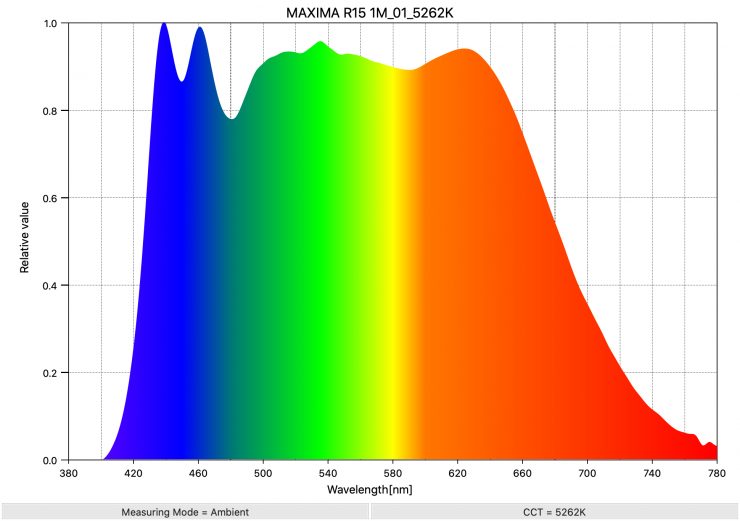
If you want to see what a really good spectral response looks like for a spotlight at 5600K, above is the result for the Maxima 3.
3200K
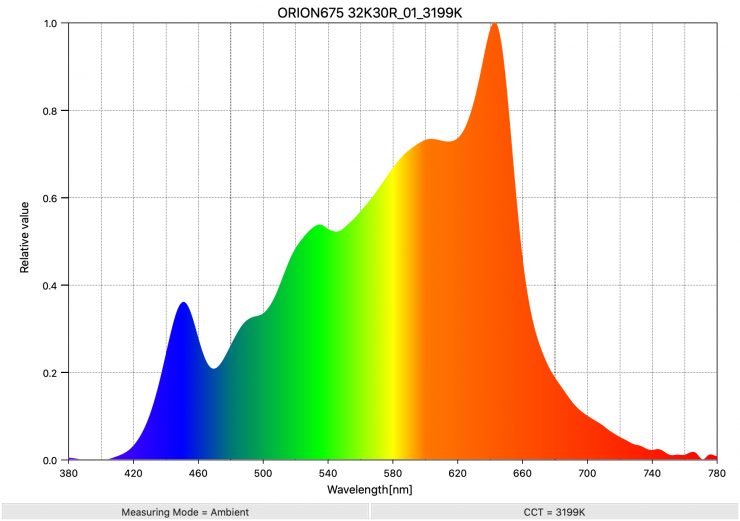
Above you can see the spectral distribution of the Orion 675 FS when it is set at 3200K. The spectral distribution only has a very marginal push towards green, but overall it is reasonably good.
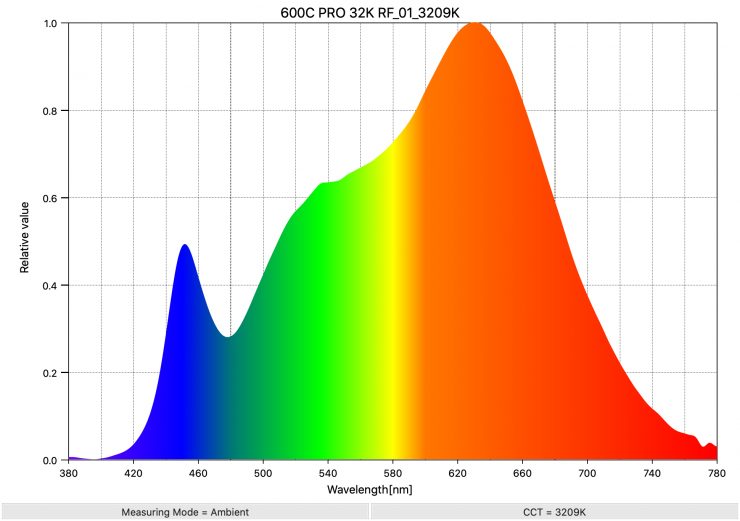
As a comparison, above you can see the spectral distribution of the 600c Pro when it is set at 3200K. The spectral distribution only has a very marginal push towards green, but overall it is very good.
Real-World Performance & Quality of Light
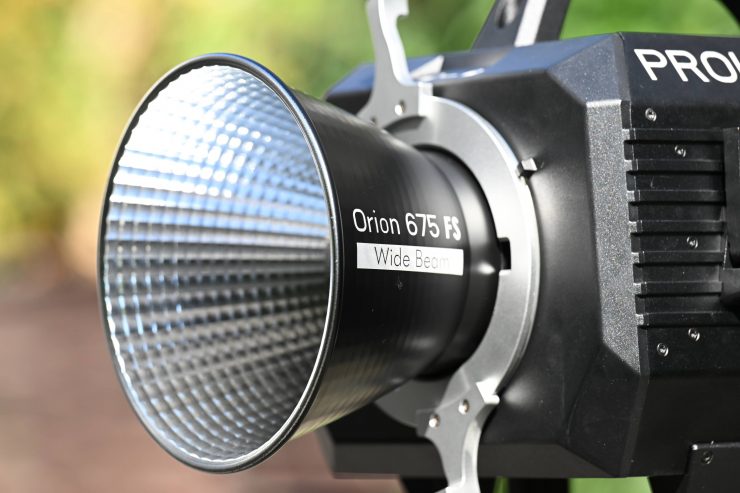
As I always say, photometric scores only tell you part of the story. So let’s find out if the scores from the Orion 675 FS translate into good real-world performance.
The photometric results can only give me scientific data and it is much more important for me to see how the light looks and performs. Contrary to popular belief, if you are in the business of making lights you don’t want to try and achieve perfect scores because perfect scientific scores don’t equate to a light looking good. A good light should look good to a camera because, after all, that is what is capturing the image. Cameras and our eyes see differently and ideally, you want to use a light that looks good to your camera. There’s a bit of alchemy in knowing what to prioritize in order to render colors that appear accurate, natural, and pleasing. It’s not just about hitting certain numbers.
I really liked the results I was able to obtain using this light. Lighting really comes down to how you use the light and having a great light isn’t suddenly going to produce better results for you unless you know what you are doing.
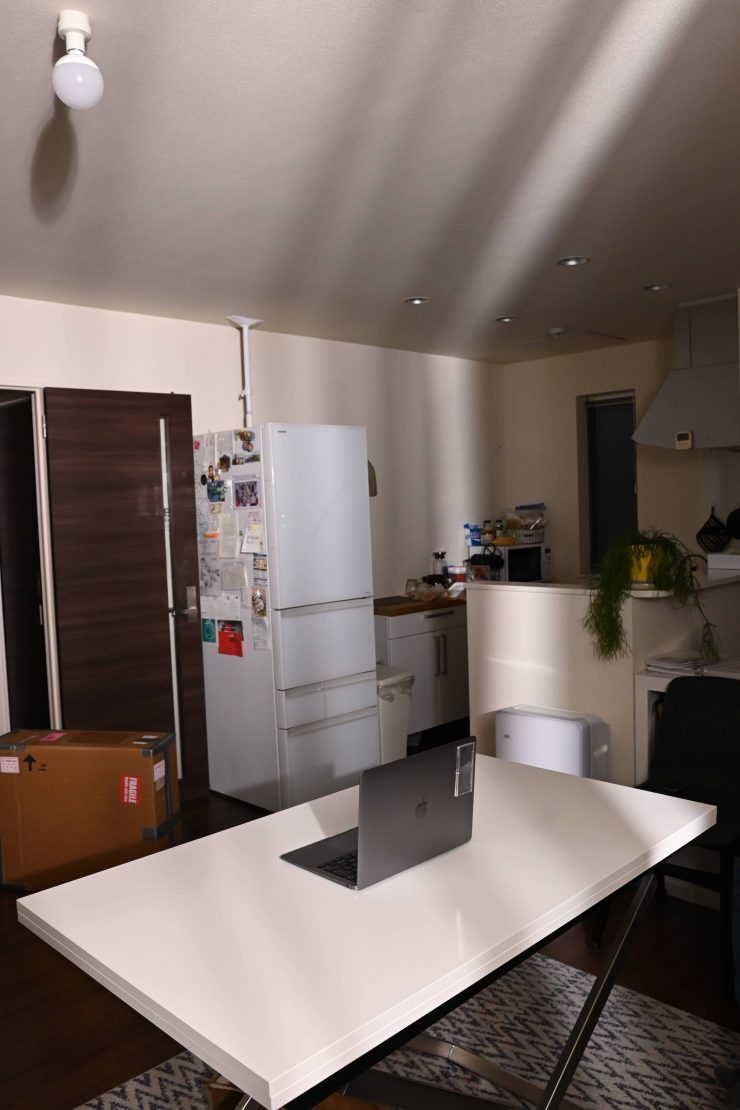
Wide Reflector 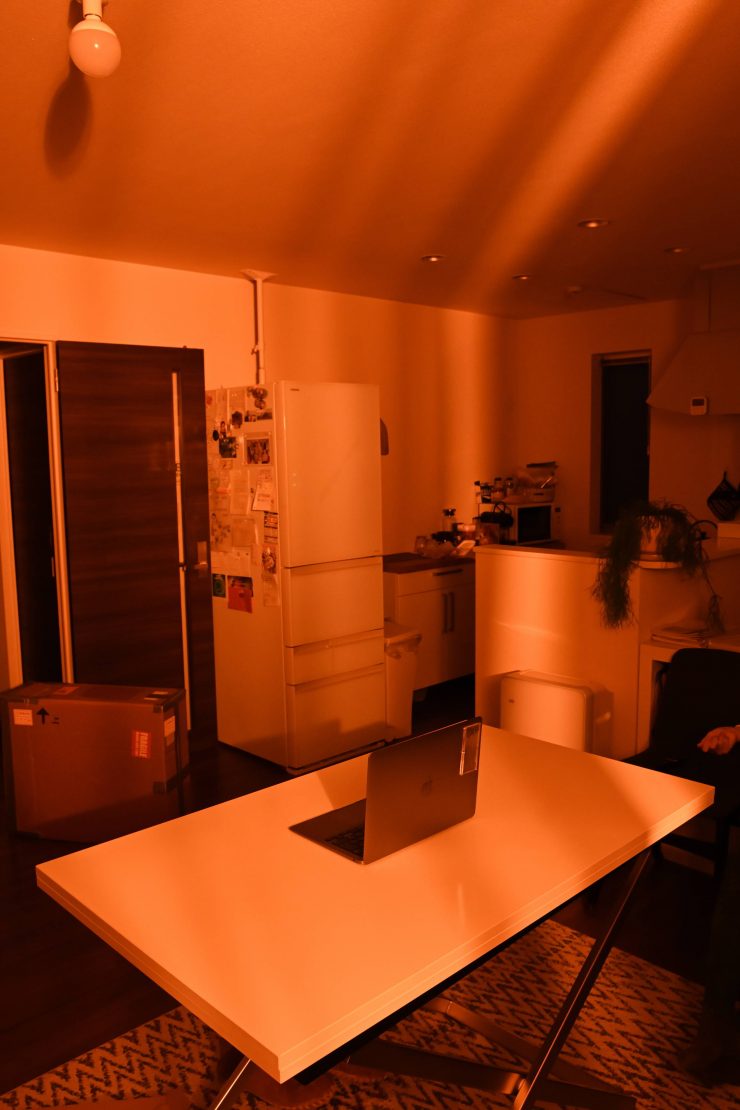
Wide Reflector 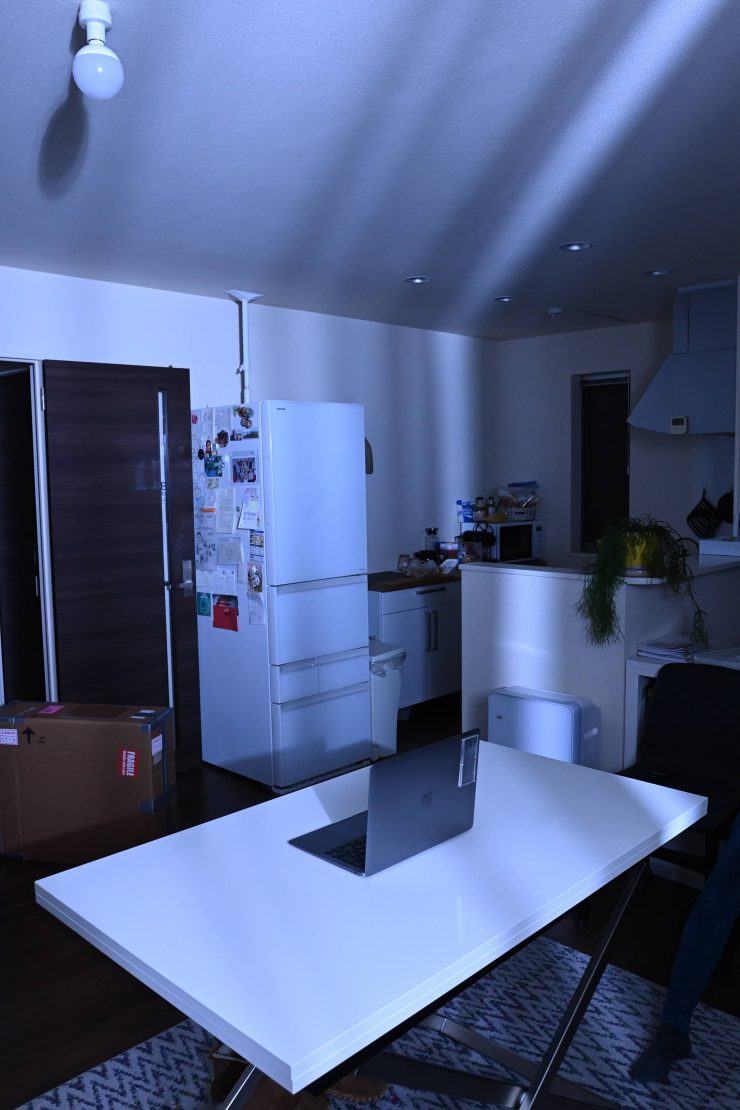
Wide Reflector 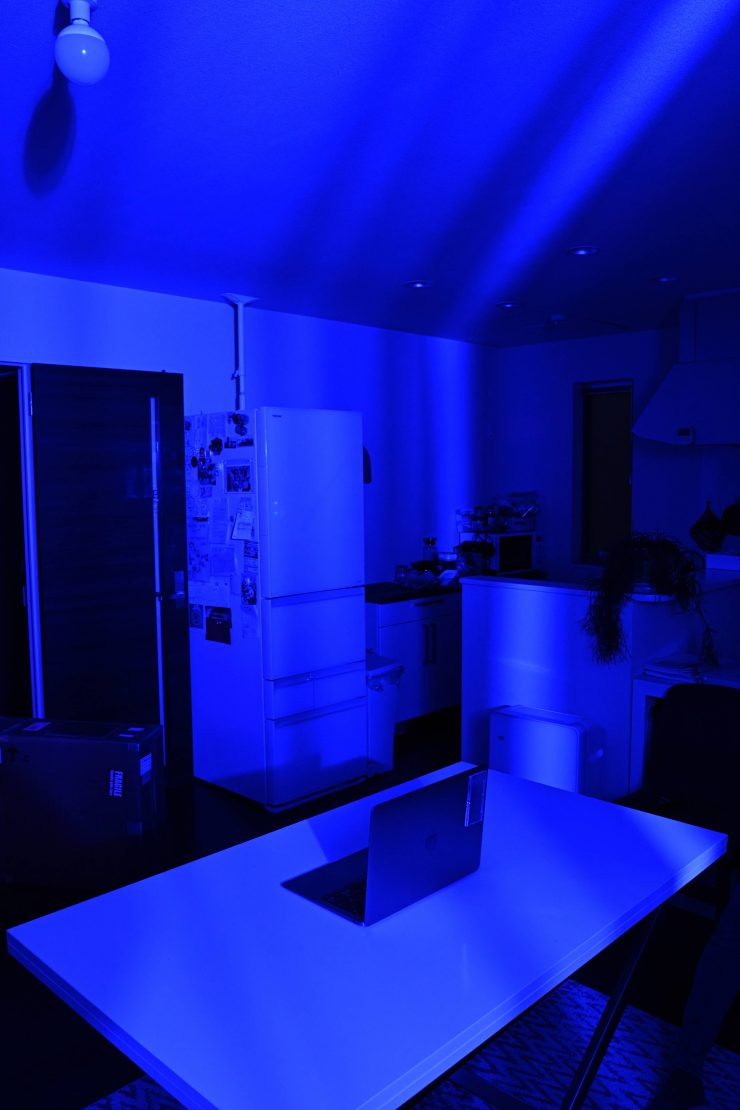
Wide Reflector 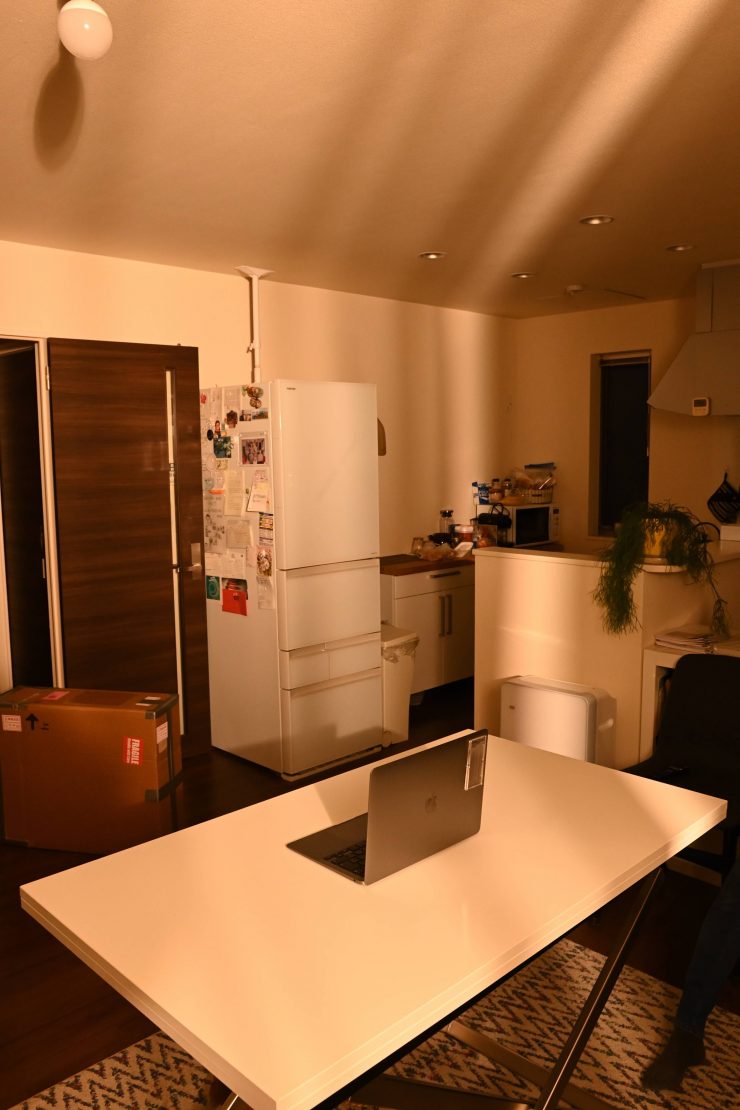
Wide Reflector 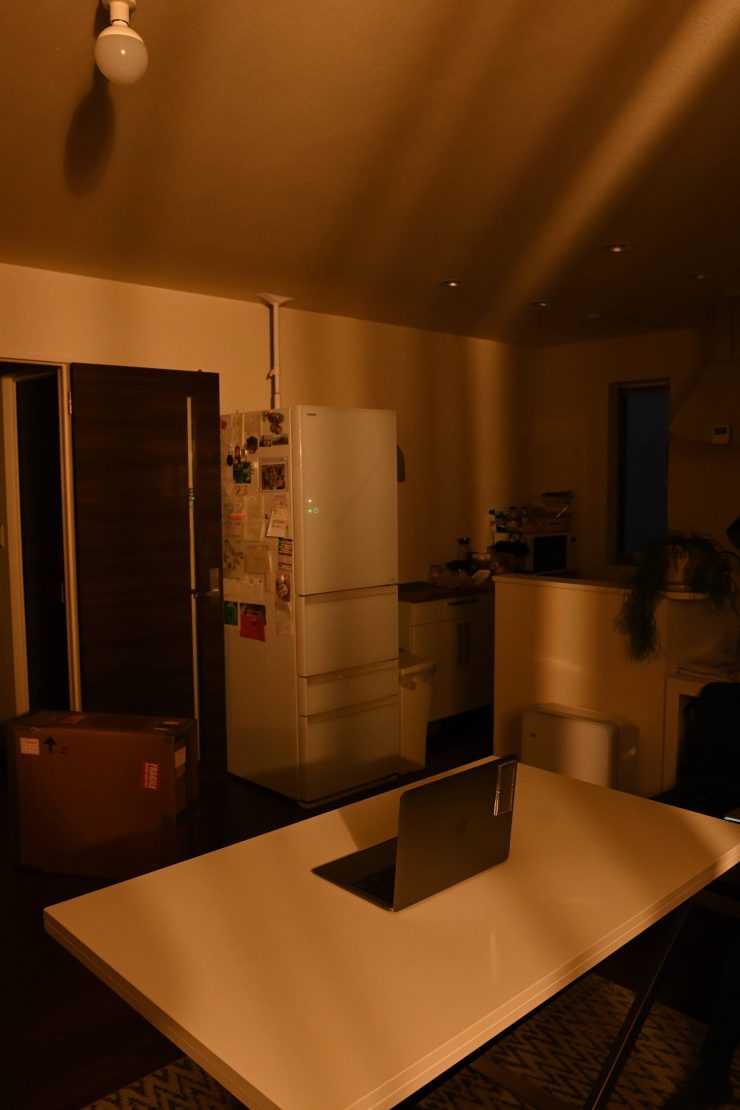
Wide Reflector 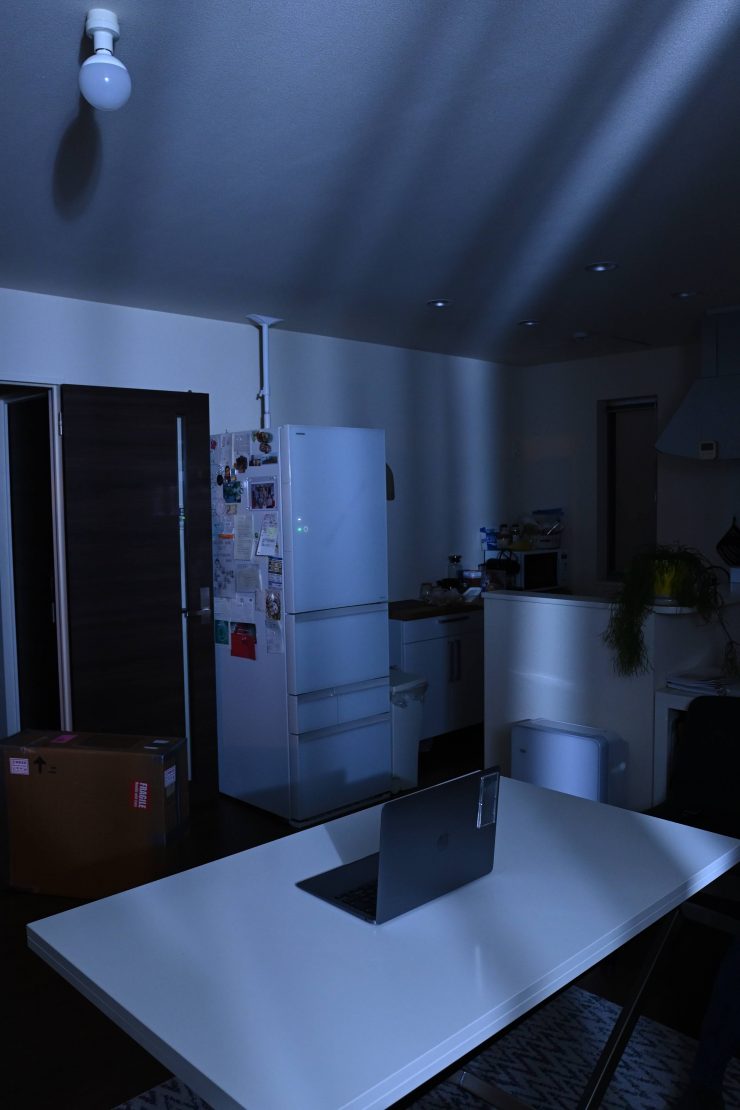
Wide Reflector 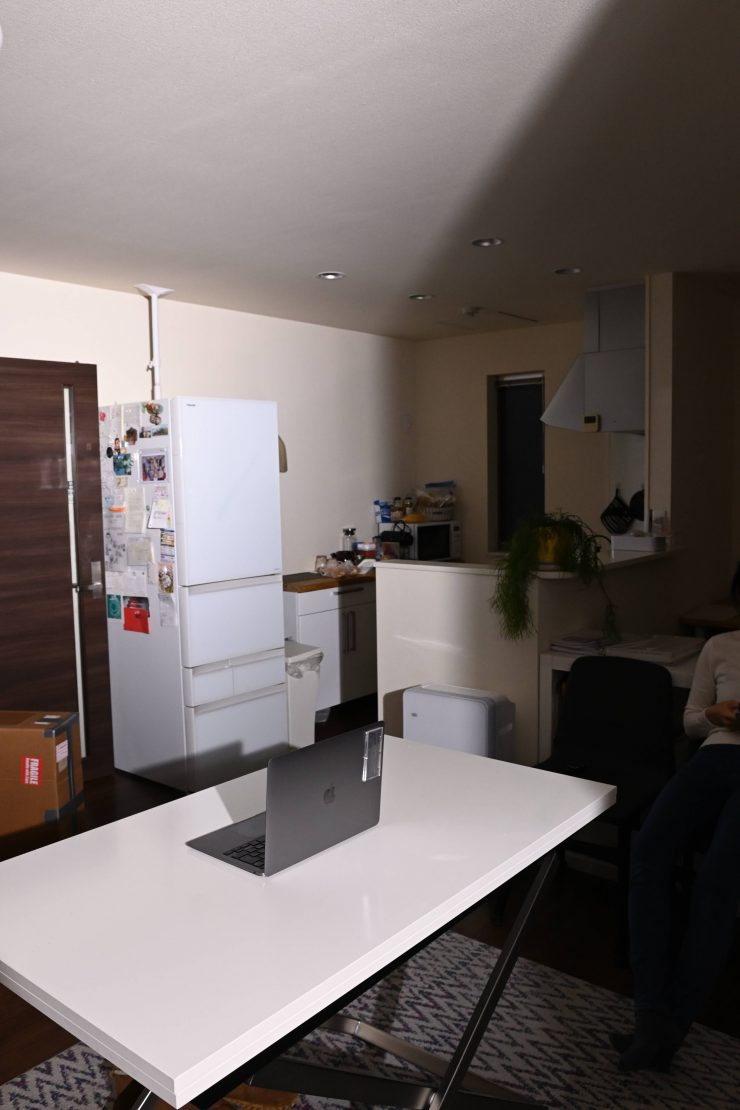
Wide Reflector 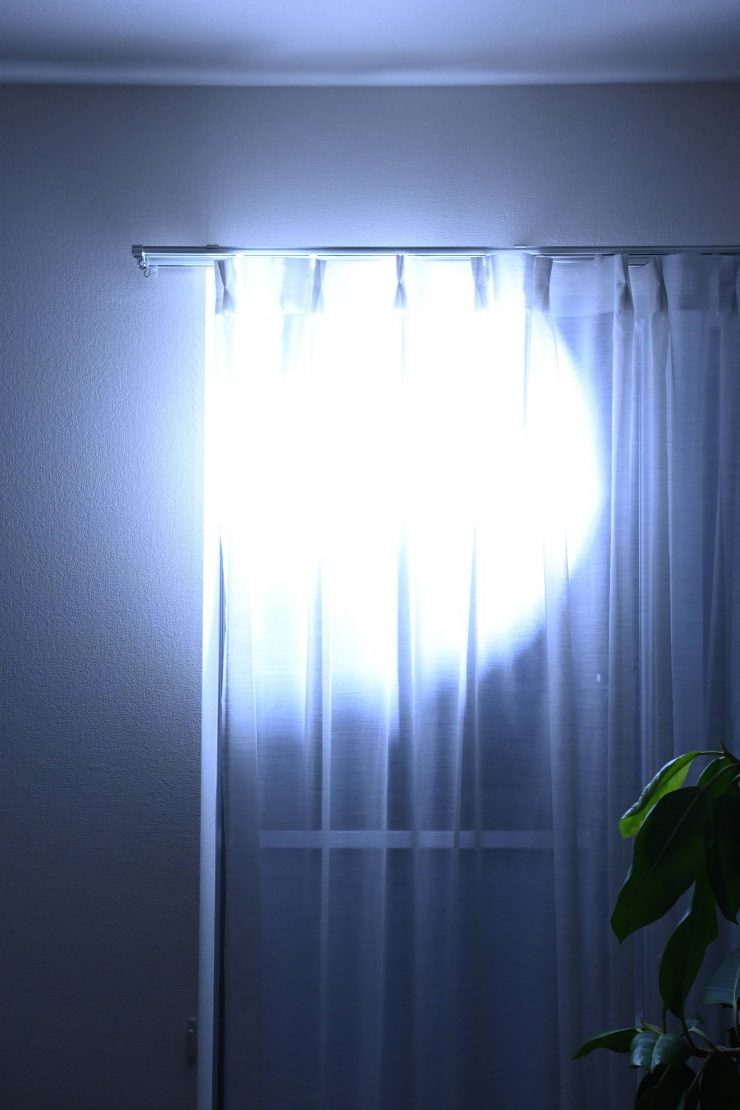
Light position 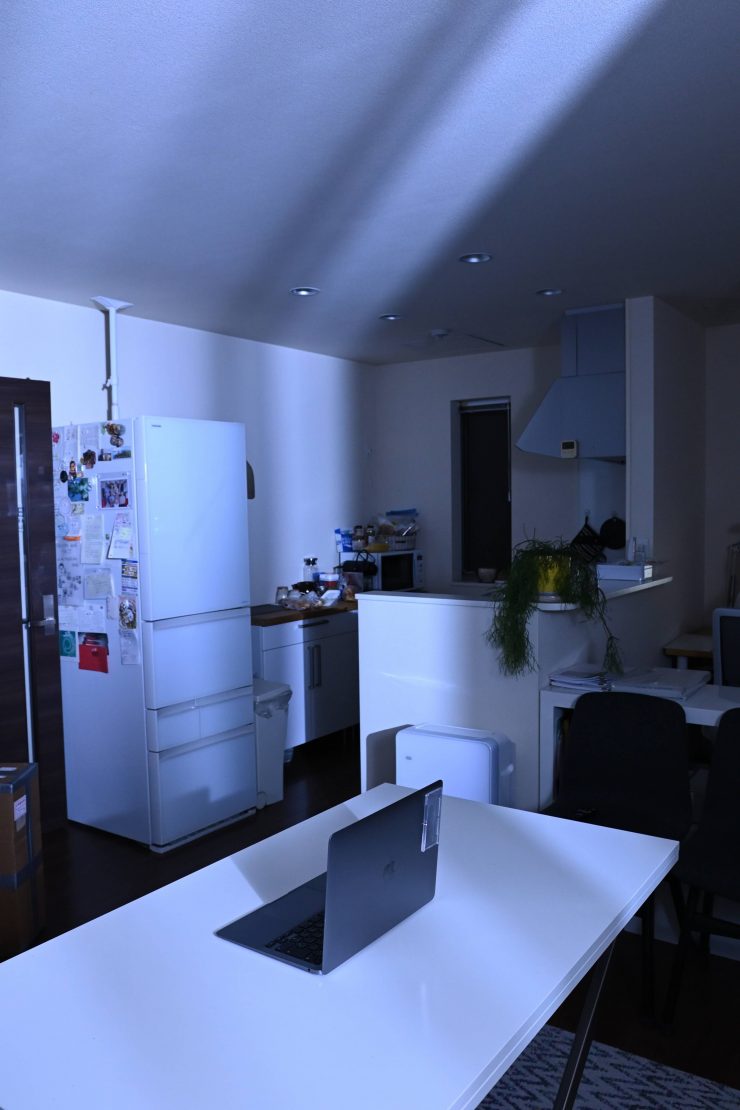
Medium Reflector 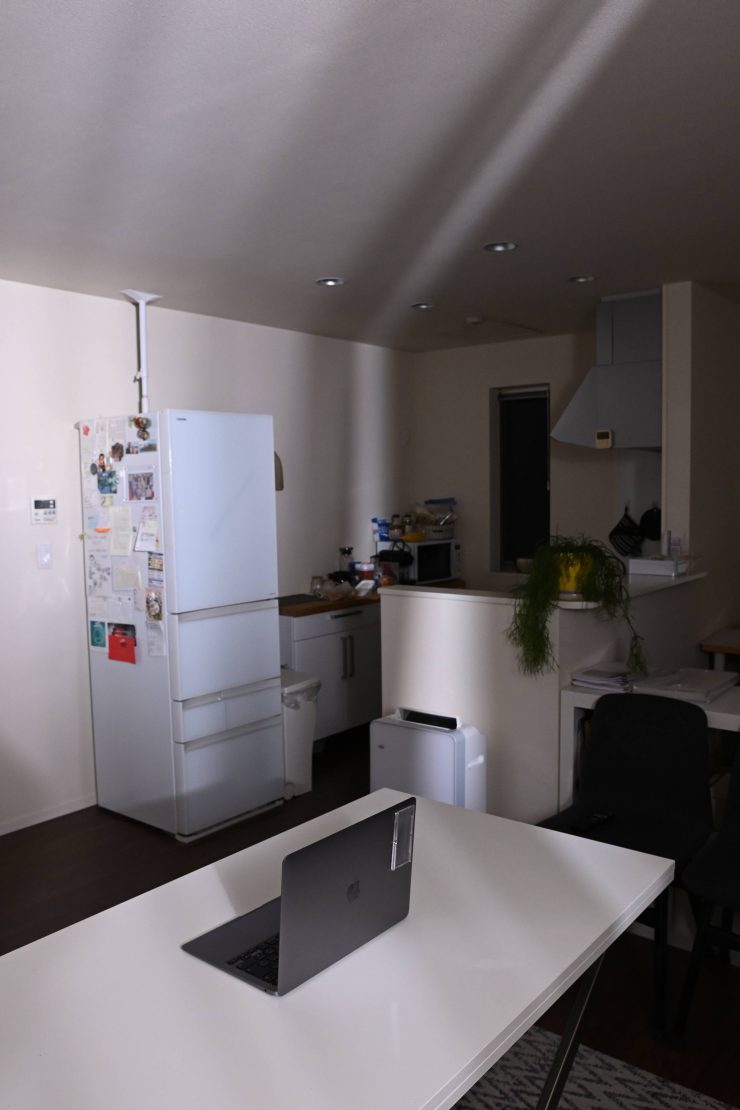
Medium Reflector 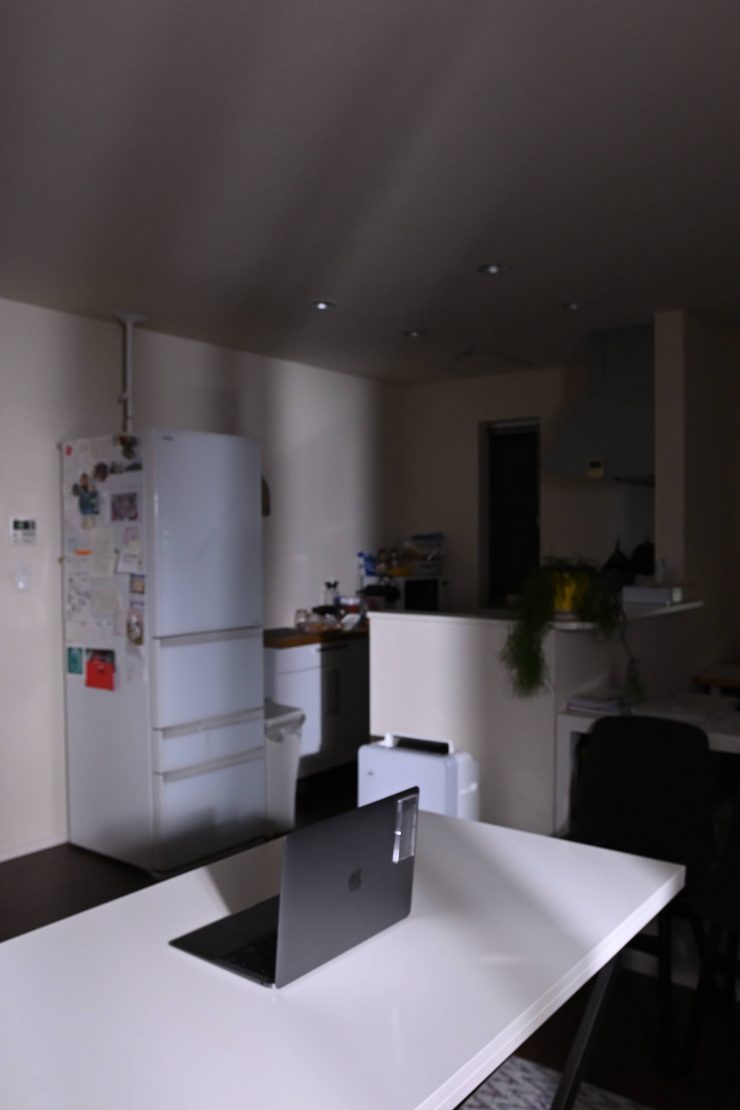
Medium Reflector 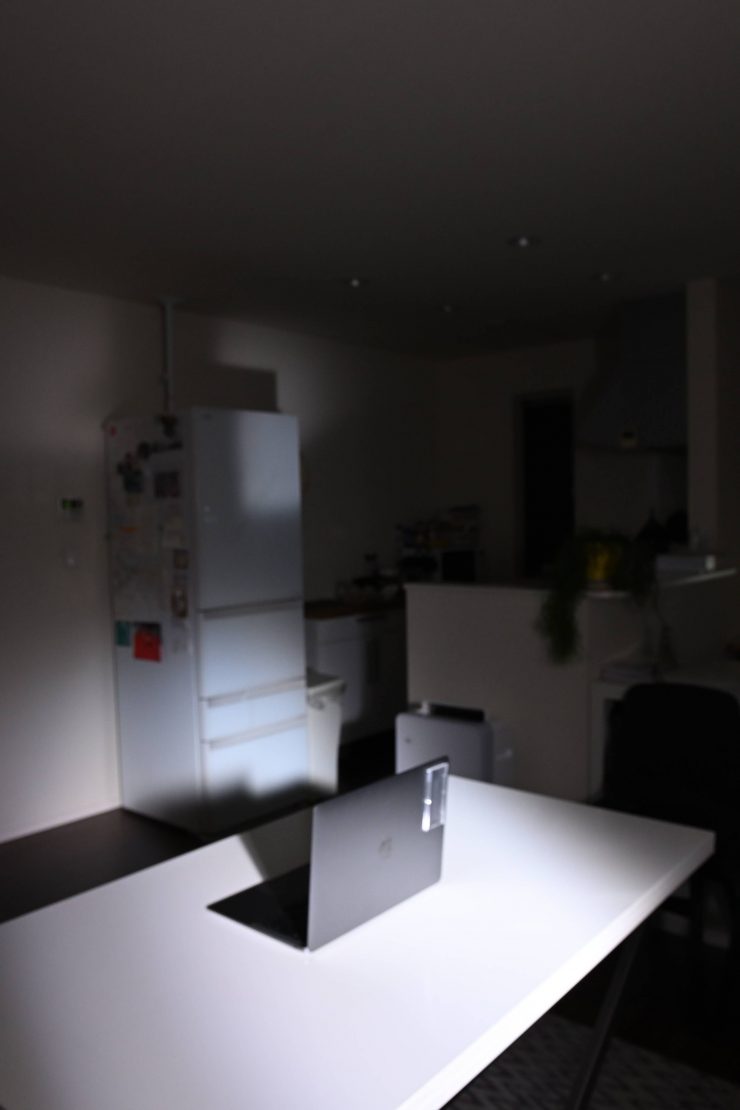
Fresnel 15 degrees 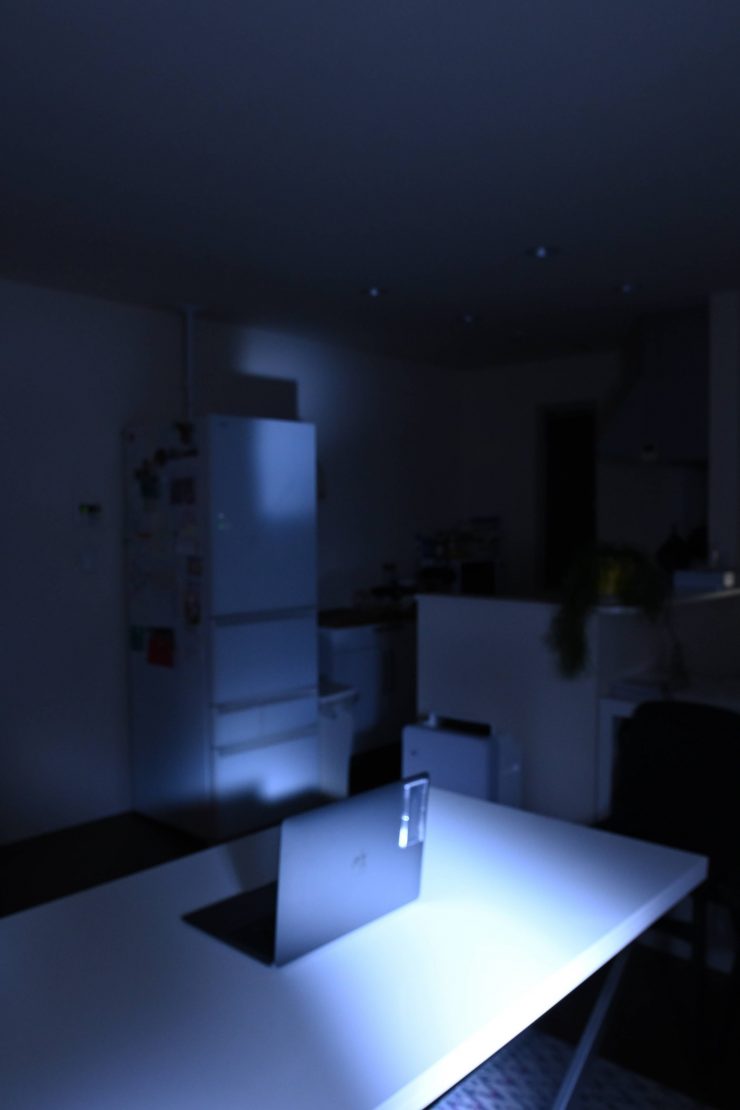
Fresnel 15 degrees 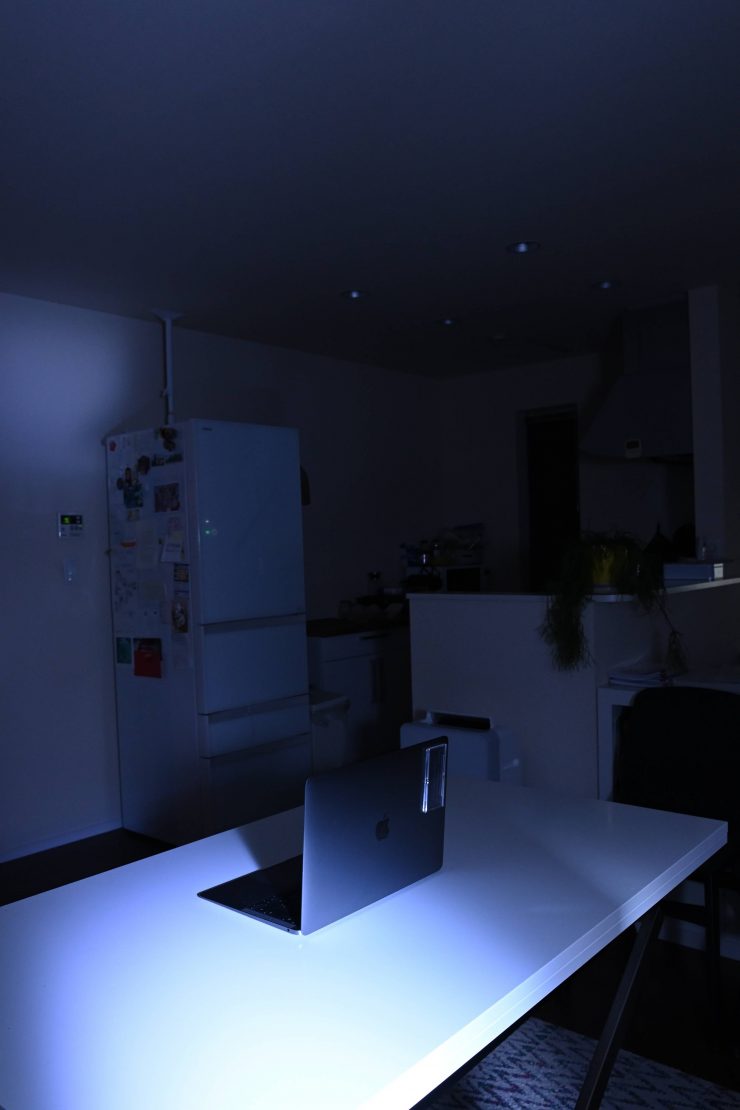
Fresnel 15 degrees 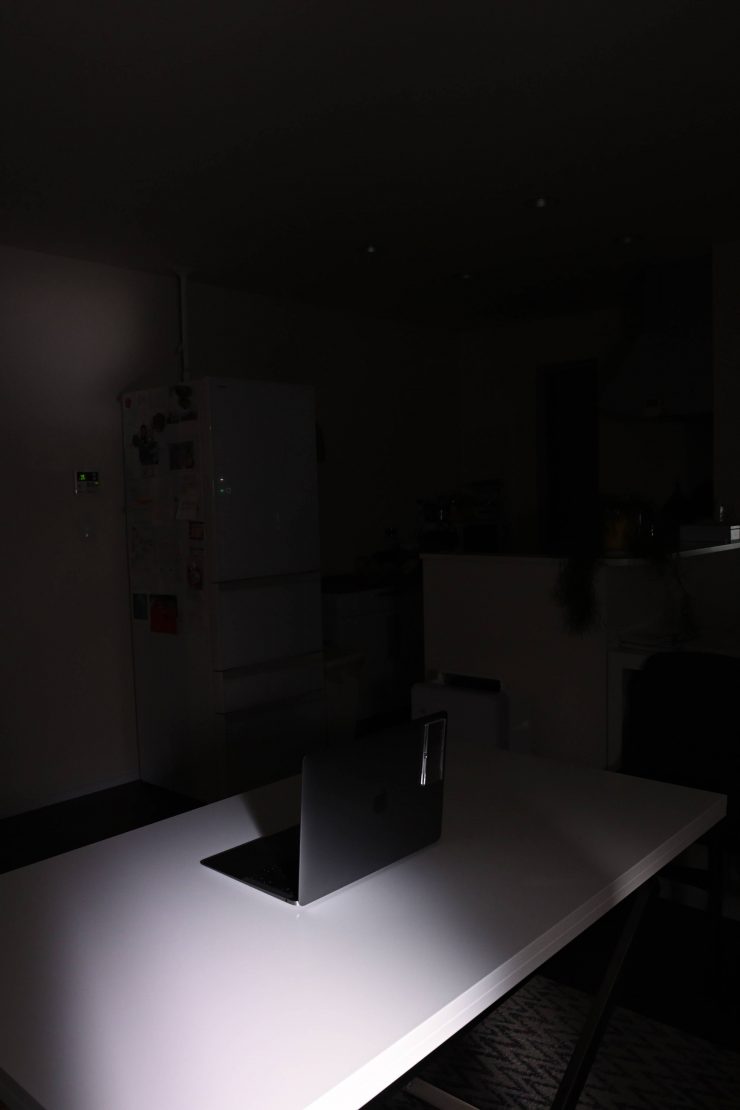
Above you can see some photos I took when placing the light outside and punching it through a sheer curtain into a room. As the light is RGBACL you can create numerous different lighting looks.
Like most modern-day, high-output spotlights, it is very easy to create a very soft, flattering light source using a softbox or other lighting modifier. I found that by using a softbox you could create a very soft lighting source without needing to punch it through a diffusion screen. This makes it a very quick and easy light to use for interview situations or for any scenario where you need soft light. You very rarely need to run these lights at 100% in interview situations in controlled environments, but it is nice to have that extra punch when required. While a 300W spotlight will certainly get the job done in a lot of scenarios, I would personally rather have a higher output light that I can dial down.
Above you can see some examples of the light being used with the Prolycht Soft Lantern.
Above you can see some examples of the light being used with the DoPChoice Rabbit Rounder Octa 3.
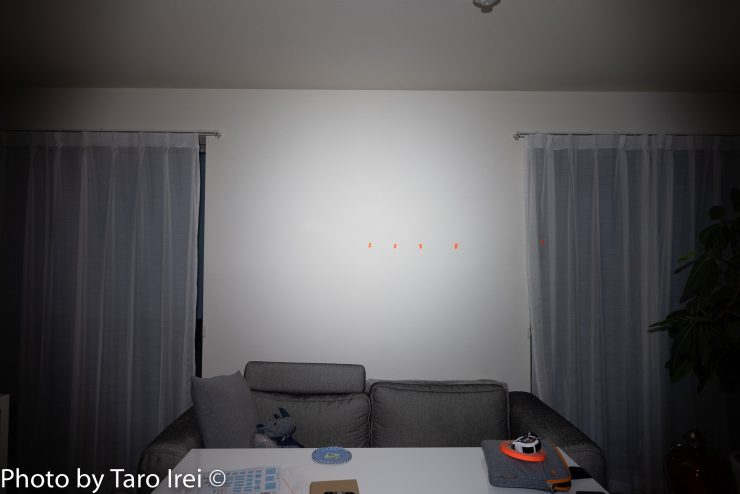
Orion 675 FS Wide reflector 55° 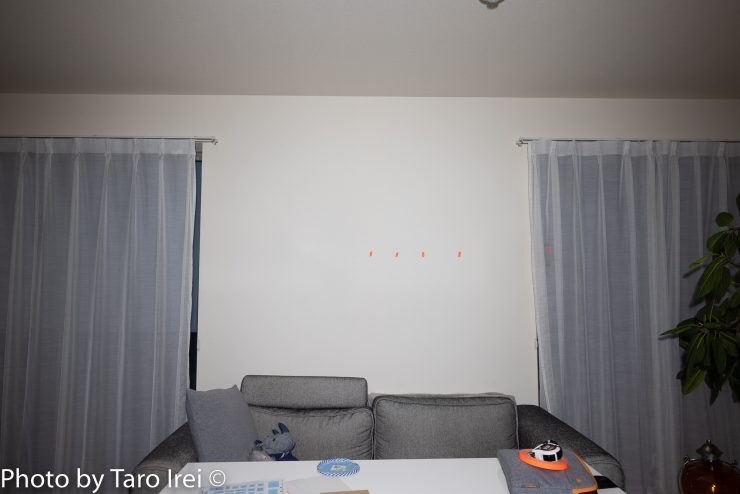
Aputure LS 600c Pro Hyper Reflector 62° 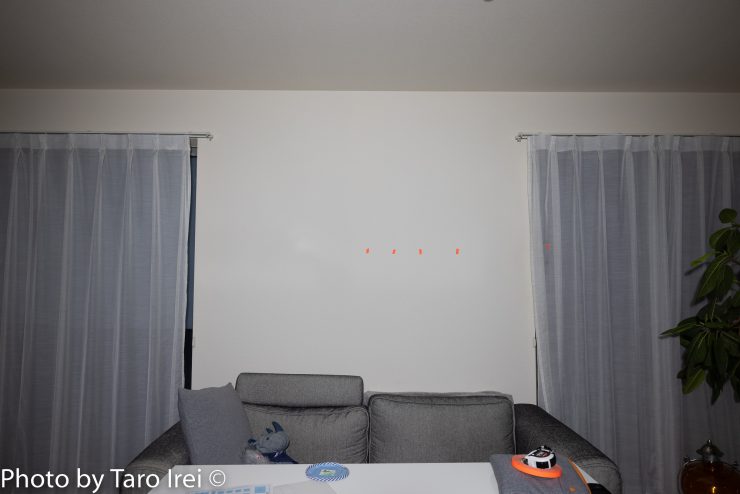
Aputure LS 600c Pro with the Orion’s Wide Reflector 55° 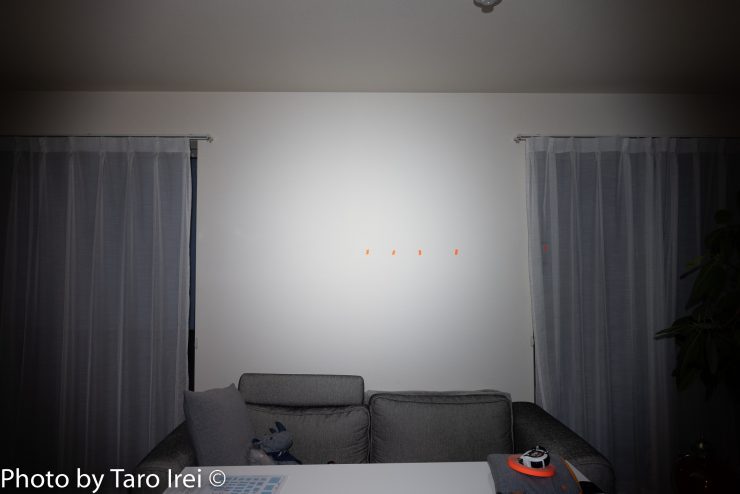
Orion 675 FS with the Aputure Hyper Reflector 62° 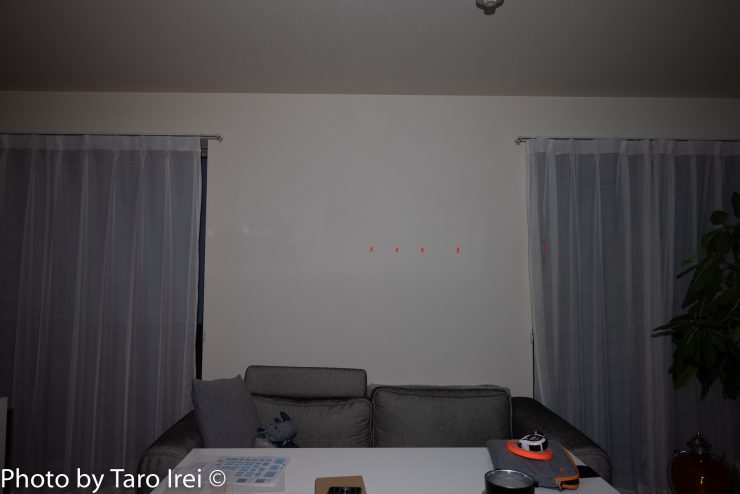
Orion 675 FS Open Face
Above you can see a comparison between the Prolycht 675 FS and the Aputure LS 600c Pro. Both lights were set 3m /9.9′ from the wall and both were using their respective 55° and 62° reflectors. The exact same camera settings were used for all shots so you can see the differences. I was also interested to see what would happen if I swapped the reflectors around.
It was interesting to see that the beam spread of the Aputure was actually wider than the Prolycht in the real world, despite the Hyper reflector having a tighter beam angle. I think the reason why is that the open-face beam angle on the Aputure is a lot wider and this helps when using reflectors. Yes, Aputure lists 93°, but from my testing, it appears wider than that. Because the Prolycht has a lot tighter open-face beam angle of 80° the Wide 55° Reflector isn’t doing as much. This is clearly evident if you place the Aputure’s Hyper reflector onto the Orion 675 FS. The Aputure’s output wasn’t as high if I used it with the Prolycht Reflector. I don’t actually think this is a big deal, because a good proportion of users of spotlights like these are not using them with their reflectors, and instead, are coupling them with a Fresnel or other lighting modifier.
The Orion 675 FS also works well when used with bounce boards or the CRLS reflector system when you combine it with the Fresnel. Speaking of the Fresnel, let’s find out how it performs in the real world.
Fresnel Performance
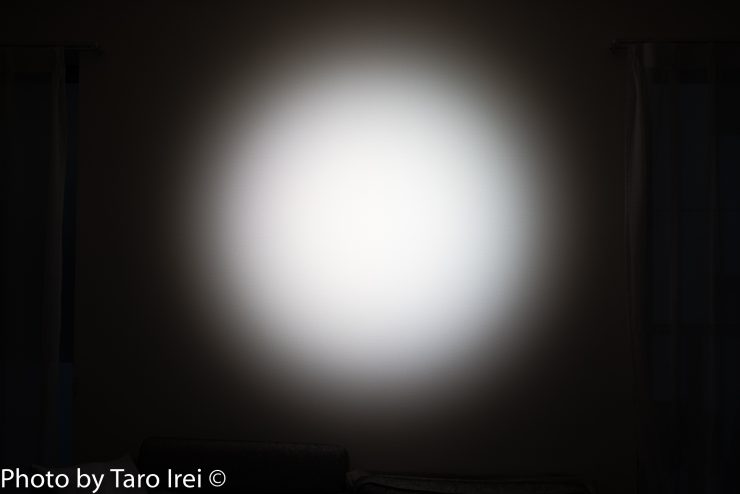
The Fresnel works really well and it has almost no visible color fringing which is rare for a Frsel being used on a COB LED spotlight. Even at 15 degrees, there is not a huge hotspot.
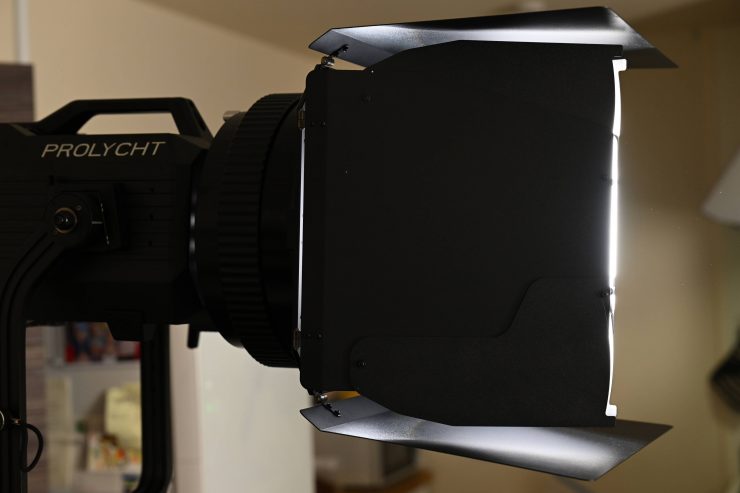
What I also like is that there is absolutely no light leaking out from the sides of the Fresnel.
I wanted to measure the output of the Fresnel when it was used at 15 degrees at a distance of 3m / 9.9′ to see what the fall-off was like from the center out to 1m.
Below are the results I got.
| OUTPUT | ||
| Center | 27,800 lx | |
| 15cm from center | 27,100 lx | |
| 30cm from center | 19.800 lx | |
| 50cm from center | 6,700 lx | |
| 1m from center | 338 lx |
As you can see the output is very consistent in the center and 15cm from the center. 30cm from the center it starts to fall off, and by 50cm the output has dropped massively. This is what I would expect for a Fresnel at 15 degrees. The figure of 27,800 lx recorded in the center was almost identical to the 28,100 lx claimed by the manufacturer.
The included barndoors do a nice job and you can create a reasonable cut when using them in conjunction with the Fresnel at mid to wide beam angles.
Who is the Orion 675 FS aimed at?
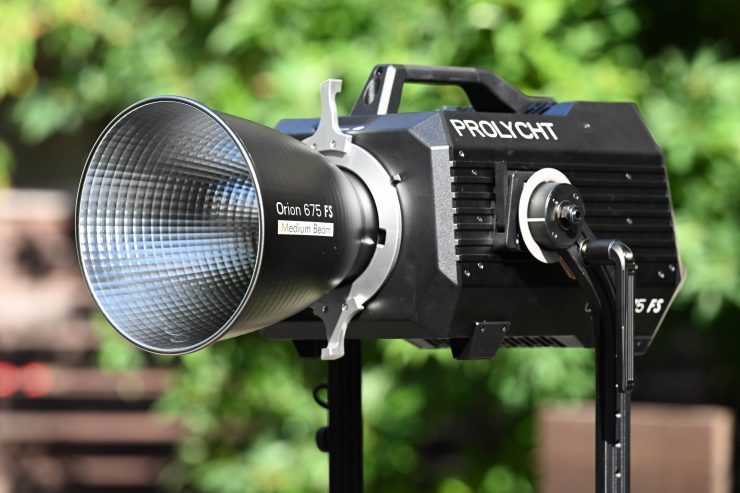
This is certainly a fixture that could be used for lots of different applications, by lots of different people. However, it is pretty clear that it is being targeted at professionals in the TV and film industry.
I think that it is priced to appeal to professional owner-operators who are looking for a jack-of-all-trades lighting solution. The versatility of a light like this allows for it to be used in a wide array of lighting scenarios. The ability to use the light as a soft source, hard source, or anything in between makes it an appealing option.
Price & Availability
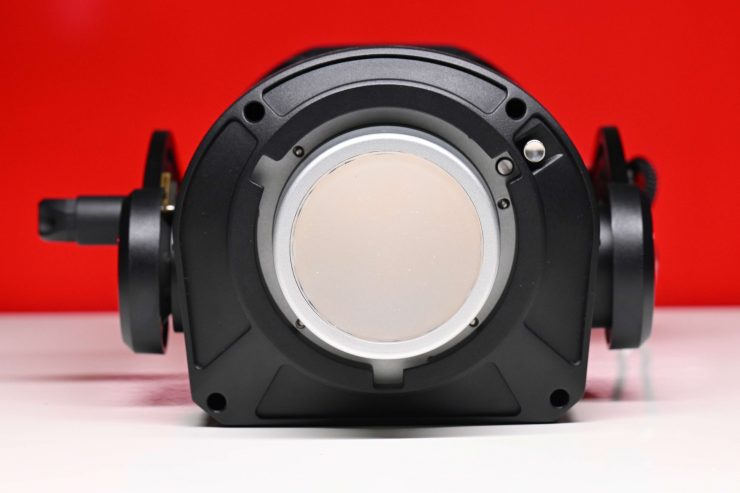
The Prolycht Orion 675 FS retails for $3,495 USD and it is available to pre-order. This does make it quite a bit more than the competing Aputure LS 600c Pro.
The Aputure LS 600c Pro has been on the market for a few months now, while the Orion 675 FS has only just started to ship.
Below you can see how the price compares to some of the competition. I have included some other similar power draw spotlights as there isn’t a lot of competition in this space.
| Price | |
| Aputure LS 600c Pro Light Storm | $2,490 USD |
| Prolycht Orion 675 FS | $3,495 USD |
| Nanlite Forza 720 | $1,649 USD |
| Aputure LS 600d Pro Light Storm | $1,890 USD |
| Aputure LS 600d | $1,390 USD |
| Nanlite Forza 720B | $1,849 USD |
| Aputure LS 600x Pro Light Storm | $1,990 USD |
The only real direct competition comes from the Aputure LS 600c Pro which costs $1,005 USD less.
What do you get?
Below you can see what comes in the basic kit.
- Prolycht Orion 675 FS LED (1800-20,000K)
- Switched Power Cord (32′)
- 30° Reflector/Intensifier
- 55° Reflector/Intensifier
- Limited 1-Year Warranty
You can also purchase the light with a very nice rolling flight case for $3,795 USD. I would recommend this for anyone who travels because finding another case or bag that you could transport this fixture in could end up being a difficult task.
Optional Extras
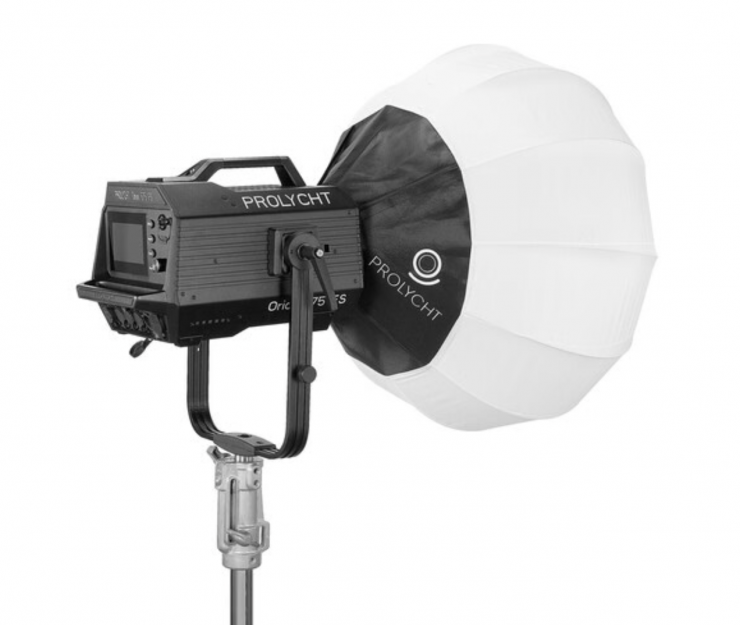
The Orion 657 FS can be used with a ton of affordable accessories due to having a Bowens-S mount. However, Prolycht also makes its own accessories. Below you can see how much they cost:
- Prolycht Fresnel Kit with Barndoors and Soft Bag for Orion 675 FS LED $580 USD
- Prolycht Soft Lantern for Orion 675 FS LED (36″) $150 USD
- Prolycht Soft Dome for Orion 675 FS LED (60″) $250 USD
Both the Prolycht Soft Lantern for Orion 675 FS LED (36″) and the Prolycht Soft Dome for Orion 675 FS LED (60″) work really well, and they are both very reasonably priced.
The Prolycht Soft Dome for Orion 675 FS LED (60″) is nice and deep and it comes with an inner baffle and a honeycomb grid.
The only small caveat I found when using the Prolycht Soft Dome for Orion 675 FS LED (60″) was that I couldn’t get it to close up fully around the back. Maybe this was just because it was new and it needs to stretch a bit.
The caveat with the Prolycht Soft Lantern for Orion 675 FS LED (36″) is that it doesn’t come with any skirts.
Conclusion
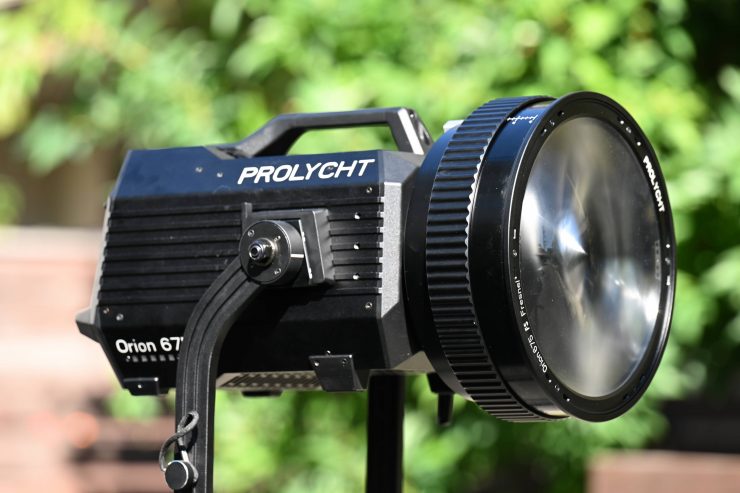
It has been quite a long wait for the Orion 675 FS, but the wait was worth it. The light is extremely well made and Prolycht has paid a lot of attention to the small details. The feature set is impressive, it doesn’t make much noise even when used at full output, it is color-accurate, and it has a ton of output.
The optional Fresnel is really well made and it is a nice compact size. I also really like the Prolycht Prolock. It is nice to have a solid, locking mount for once and not one that rattles around or feels like it may break when attaching a Fresnel or heavy lighting modifiers.
Speaking of lighting modifiers, Prolycht’s partnership with dedolight is bound to bring some interesting options for the Orion 675 FS going forward. This is one of the most exciting aspects of the Orion 675 FS and one that is bound to make it a popular fixture.
The output is very good given its power draw, but in saying that, the competing Aputure LS 600c Pro is also no slouch in that department. Where you do notice a huge difference over the Aputure is if you are using the optional Fresnel. The Prolycht has a far greater output when used with its Fresnel than the Aputure LS 600c Pro does with its F10 Fresnel. Personally, this is a big deal for me. The problem with the F10 Fresnel is that it wasn’t designed to work on the 600c because it has a different-sized COB than the other 600 series lights. According to Aputure, they are in the process of making a projection mount that will be optimized to work on the 600c and 1200d. With the Orion 675 FS, the Fresnel was purpose-built for that fixture.
The huge deal for me personally is that the Orion 675 FS runs really quietly no matter how long you have had it on and no matter what output you set it at. This allows it to be used when recording audio in just about any situation.
It is nice to have an RGBACL fixture even if you have no intention of using features such as HSI. The ability to dial in a very wide array of CCT settings and have +/- G/M adjustments are features I personally look for. There are also numerous features that you will find in the Orion 657 FS that you won’t find on other competing fixtures.
The interface and operating system are extremely easy to use, as is the app. I also like the all-in-one design and not having to worry about connecting up a separate power supply/controller.
The caveats are that because it does feature an all-in-one design, the light head is heavy and you can only use it with large-sized stands. Also, unlike the Aputure, it doesn’t come with any way of powering it remotely, at any output.
At least, in my opinion, the light is well-priced given its feature set, output, build quality, and performance.
The Prolycht Orion 675 FS ticks a lot of boxes and it does a lot of things really well. As I already mentioned, the attention to detail and the build quality set it apart from its competition. It does face stiff competition from the Aputure LS 600c which is also a very solid offering.
Technical Specifications
Like what we do and want to support Newsshooter? Consider becoming a Patreon supporter and help us to continue being the best source of news and reviews for professional tools for the independent filmmaker.

